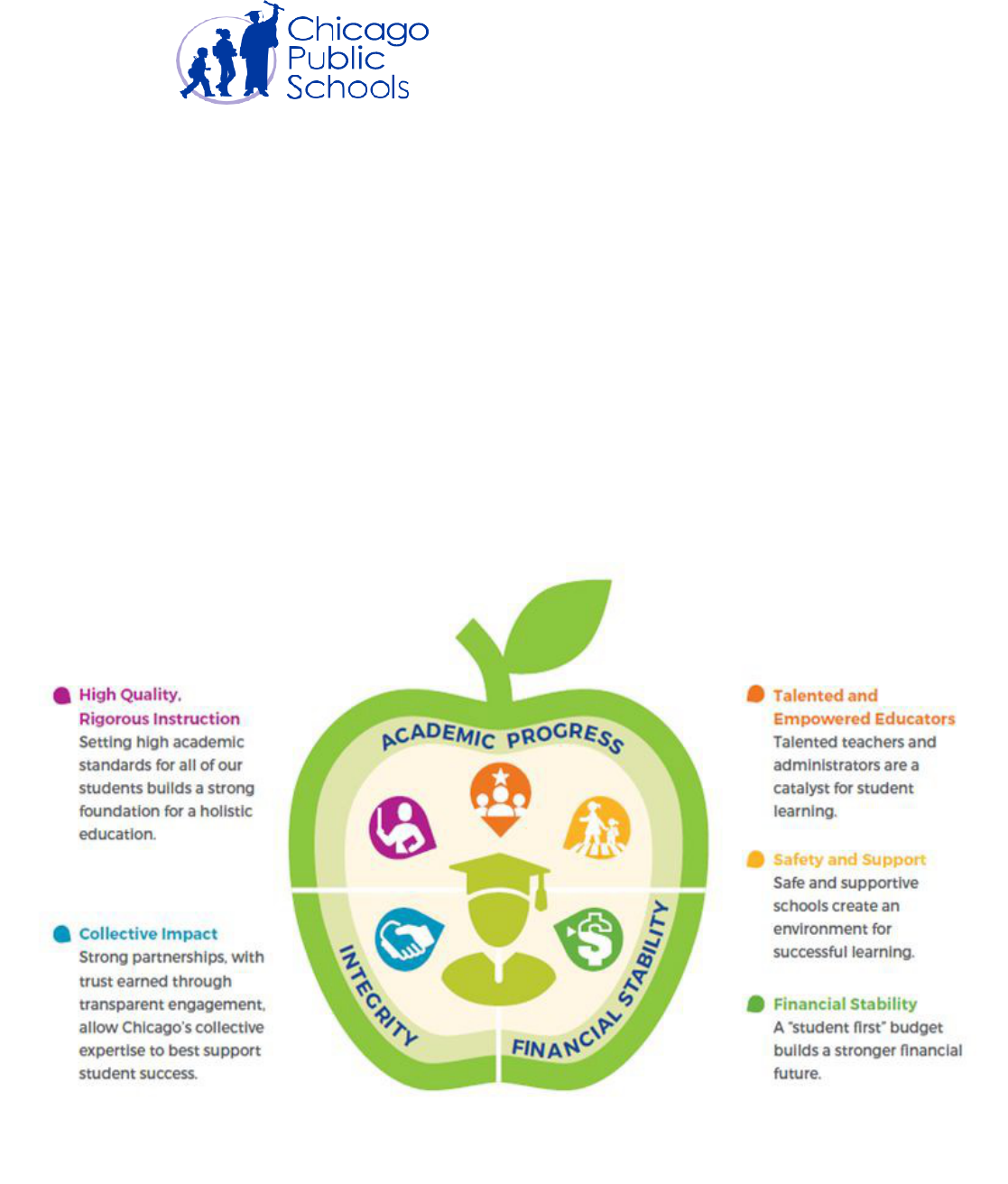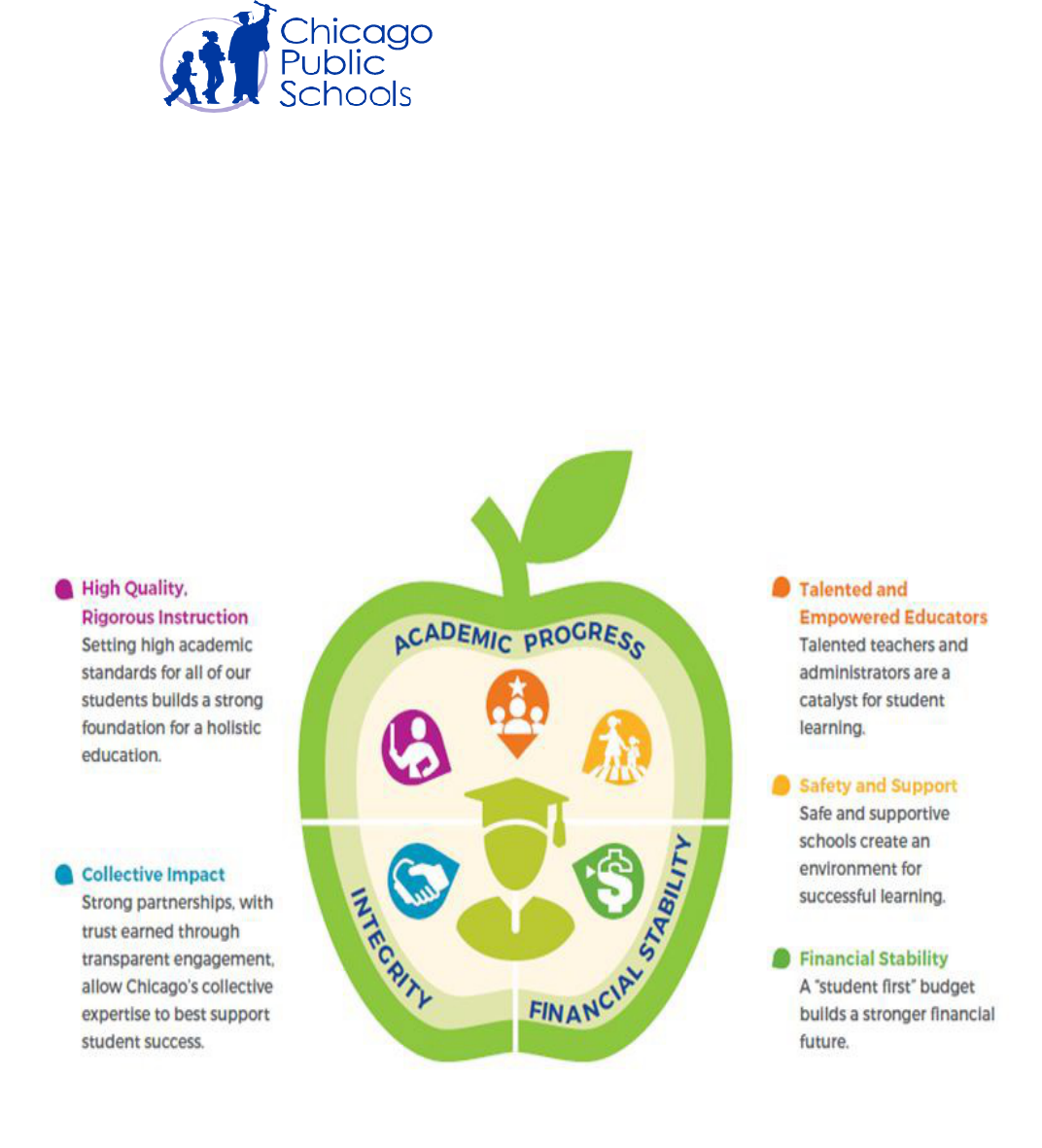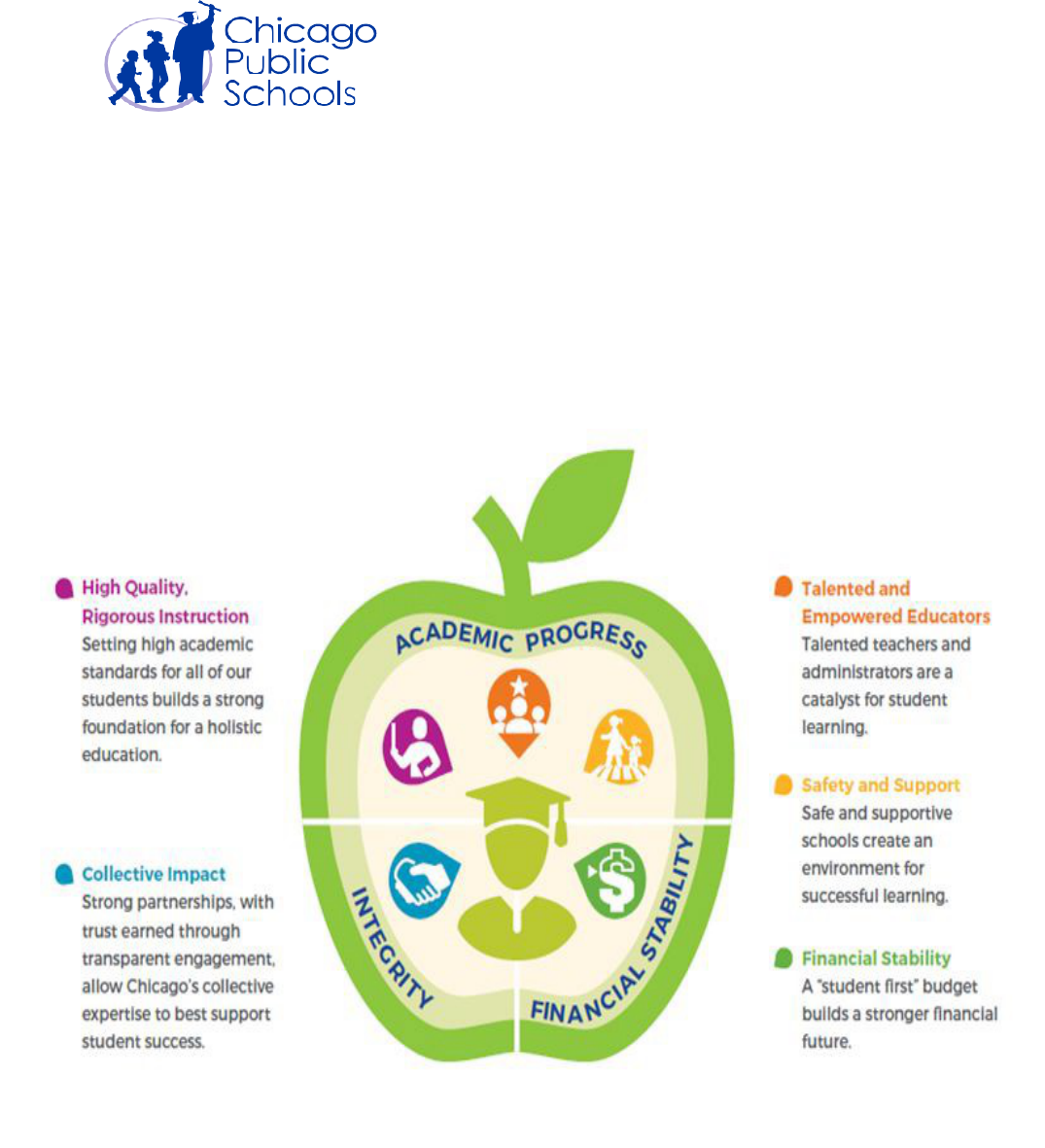2
2018-2020 Local School Council Resource Guide
Lori Lightfoot
Mayor of the City of Chicago
CHICAGO BOARD OF EDUCATION
Miguel del Valle, President
Sendhil Revuluri, Vice-President
Luisiana Melendez
Amy Rome
Lucino Sotelo
Elizabeth Todd-Breland
Dwayne Truss
CHICAGO PUBLIC SCHOOLS
Dr. Janice Jackson
Chief Executive Officer
LaTanya D. McDade
Chief Education Officer
Francis Bilecki
Chief of Public Policy
Herald Chip Johnson
Chief of Family and Community Engagement in Education
Dr. Guillermo “Willy” Montes de Oca
Director, Office of Local School Council Relations
© Copyright 2019 by the Board of Education of the City of Chicago
All rights reserved. Printed in the United States of America.
It is the policy of the Chicago Board of Education not to discriminate on the basis of race, color, creed,
religion, national origin, age, disability or sex. Inquiries concerning the application of Title IX of the
Education Amendments of 1972 and the regulations promulgated thereunder concerning sex
discrimination should be referred to the Title IX Officer, Chicago Public Schools, 42 W. Madison
Street, Chicago IL 773.553.2688 [TTY 773.553.2699].
3
Contents
Part 1. Roles and Responsibilities
p. 4
Part 2. Meetings p. 63
Part 3. Advancing School Progress-- p. 96
The CIWP and the SQRP
Part 4. Budgeting to Support School Progress p. 131
Part 5. Principal Evaluation p. 185
Part 6. Principal Selection p. 229
Each item in the Contents is linked to the page listed for that section. Click
on the title and you will get directly to that section.
The Contents page in each Part also has links to the listed pages so that you
can click on any item in the contents lists and go directly to that topic's page.
5
Introduction
The Local School Council charge from the state legislature. “… Achieving Goals. To
achieve these priority goals, the general assembly intends to make the individual local
school the essential unit for educational governance and improvement and to
establish a process for placing the primary responsibility for school governance and
improvement in furtherance of such goals in the hands of parents, community
residents, teachers and the school principal at the school level.”
105 ILCS 5/34-1.01.B.
Contents
The Local School Council Membership p. 6
Powers and Duties of Traditional Local School Councils p. 8
Powers and Duties of Appointed Local School Councils p. 10
Powers and Duties of Principals p. 12
LSC Calendar p. 13
LSC Officers p. 14
Other Committees p. 16
Length of Terms and Methods of Selection p. 17
Eligibility Rules p. 19
Whistle-Blower Protection p. 22
Chicago Board of Education Ethics Code p. 23
Statement of Economic Interests p. 24
Criminal Conviction Disclosure p. 25
Removal from Office p. 26
Resources
Fast Facts p. 28
Important Considerations Regarding Diverse Learners p. 31
Model Bylaws for a Traditional LSC p. 32
Board Rules p. 41
CPS Policy on Governance of Alternative and Small Schools p. 54
Each item in the Contents is linked to the page listed for that topic.
Click on the title and you will get directly to that page.
6
THE LOCAL SCHOOL COUNCIL MEMBERSHIP
Local School Councils are composed largely of parents and community representatives
elected by parents and community residents. The school staff and high school student
members are appointed by the Board after staff and students vote in an advisory poll. In
some schools, the Board appoints LSCs that have different membership compositions.
COMPOSITION OF MOST LOCAL SCHOOL COUNCILS OF SCHOOLS NOT
DESIGNATED AS AN ALTERNATIVE OR SMALL SCHOOL
ELEMENTARY SCHOOL LSCS INCLUDE 12 VOTING MEMBERS
Principal
6 Parent Representatives
2 Community Representatives
2 Teacher Representatives
1 Non-Teacher Staff Representative
HIGH SCHOOL LSCS INCLUDE 13 VOTING MEMBERS
Principal
6 Parent Representatives
2 Community Representatives
2 Teacher Representatives
1 Non-Teacher Staff
Representative 1 Student
Representative
COMPOSITION OF MOST LOCAL SCHOOL COUNCILS OF SCHOOLS DESIGNATED
AS AN ALTERNATIVE OR SMALL SCHOOL
MOST ALTERNATIVE OR SMALL SCHOOL ELEMENTARY SCHOOL LSCS INCLUDE 13 VOTING
MEMBERS
Principal
6 Parent Representatives
2 Community Representatives
2 Teacher Representatives
2 Advocates
MOST ALTERNATIVE OR SMALL SCHOOL HIGH SCHOOL LSCS INCLUDE 14 VOTING MEMBERS
Principal
6 Parent Representatives
2 Community Representatives
2 Teacher Representatives
2 Advocates
1 Student Representative

7
ALTERNATIVE LSCS WITH UNIQUE COMPOSITIONS
The ALSCs of the schools listed below have compositions differing from the standard
ALSC compositions for elementary or high schools. In addition to the Principal, they
consist of:
Nancy B. Jefferson Alternative High School
2 Community; 2 Teachers; 6 Advocates; The Presiding Judge of the Cook County
Juvenile Court (or designee); The Superintendent of the Cook County Juvenile
Temporary Detention Center (or designee)
Al Raby High School
7 Parents; 1 Community; 2 Advocates; 2 Teachers; 1 Student
Simpson High School for Young Women
2 Parents; 2 Community; 2 Teachers; 4 Advocates; 1 Student
Telpochcalli Elementary School
4 Parents; 4 Teachers; 2 Advocates
Vick Early Childhood and Parent Center*
4 Parents; 2 Community; 2 Teachers; 2 Advocates
York Alternative High School
3 Community; 2 Teachers; 4 Advocates; The Director of the Cook County Department
of Corrections (or designee)
Military Academy high schools have a Board of Governors that serves as the LSC.
They have a Commandant of the School and a JROTC Instructor as well as the
members of an appointed LSC for a total of sixteen(16) members
The ALSCs of the following seven (7) schools are appointed based on
recommendations by the Chief Executive Officer (no non-binding advisory polls are
conducted).
• Chicago Academy Elementary School
• Chicago Academy High School
• Collins High School
• National Teachers Academy Elementary School
• Orr High School
• Solorio High School
• Tarkington Elementary School
2 Parents; 2 Teachers; 2 Community; 2 Educational Experts; the Chief Education
Officer (or designee)
* The ALSCs of Vick Early Childhood Parent Center and DeVry Advantage Academy
High School are appointed to two-year terms beginning December 1 of every even-
numbered year (Board Report 08-0227-EX31).
8
POWERS AND DUTIES OF
T
RADITIONAL LOCAL SCHOOL COUNCILS
The powers and duties of Local School Councils of schools not designated as
alternative or small schools include the following:
Compliance
•
Comply with the Open Meetings Act and all State and Federal laws, all applicable
collective bargaining agreements, court orders and Board rules and policies.
Continuous Improvement Work Plan (CIWP)
•
Approve the CIWP and any amendments to the CIWP if the school is not on
probation.
•
Hold two well-publicized public meetings annually to present the CIWP,
proposed budget, and the annual report accounting for LSC activities both
programmatically and financially.
•
Hold two more well-publicized public meetings annually to report on progress and
problems with implementing the CIWP.
•
Monitor the implementation of the CIWP.
•
May request that the principal close positions and open new ones consistent
with the provisions of the CIWP provided the decisions are consistent with
applicable law and collective bargaining agreements.
More information on the CIWP is provided in a separate section of the LSC Resource Guide.
Conduct Meetings
•
Post meeting notice and agenda 48 hours prior to LSC meetings or LSC committee
meetings.
•
Notify the school community of all meetings.
•
Prepare minutes/reports on meetings and maintain a record of the reports.
•
Include public participation in LSC meetings.
More information on LSC meetings is provided in a separate section of the LSC Resource Guide.
Advise the Principal
•
Advise the principal concerning the school’s attendance and disciplinary policies
and school fees.
•
Make recommendations to the principal on new teacher hires.
•
Make recommendations to the principal on textbook selection and the curriculum
that are consistent with the curriculum objectives of the Board and the State and in
conformity with the Chicago Teachers’ Union Contract.
•
Evaluate the school’s allocation of teaching resources and other certificated and
uncertificated staff and, based on that evaluation, make recommendations
concerning the reallocation of staff if it is determined the existing allocation does
not adequately support instructional objectives or school programs.
9
Powers and Duties of Traditional LSCs (continued)
Budget and Fundraising Responsibilities
•
Monitor the Budget and make sure it is reflective of plans in the CIWP.
•
Approve the school’s budget and approve all budget transfers within funds if the
school is not on probation.
•
Pre-approve all expenditures from the school’s internal accounts that exceed the
limits set by the Board for expenditures not requiring LSC approval (currently
$1,000.00 in elementary schools and $2,500.00 in high schools). Splitting
purchases to avoid the limit is prohibited.
•
Approve increasing the expenditure limits for internal accounts above the
$1,000.000 (for elementary schools) and $2,500.00 (for high schools) limits
(limits cannot be lowered).
•
Approve, in accordance with Board policy, all internal accounts receipts and
expenditures
•
Pre-approve all fundraising activities to be conducted by non-school organizations
in or with the school.
More information on the budget is provided in a separate section of the LSC Resource Guide.
School Facilities
•
Grant the use of assembly halls and classrooms, when not otherwise needed,
for public lectures, concerts and other educational and social activities, in
compliance with Board rules.
School Policies
•
Adopt and revise a school uniform or dress code policy.
Responsibilities for Principal Selection and Evaluation
•
Select a principal for the school to serve under a four-year contract.
•
Evaluate a contract principal’s performance on an annual basis.
•
Evaluate, no less than 150 days prior to the end of the contract, a contract
principal’s performance during the entire duration of the current contract
(called a “cumulative” evaluation).
•
Determine whether the principal’s contract shall be renewed (based on the
cumulative evaluation).
•
Select a new contract principal to fill an existing or impending contract principal
vacancy
•
May direct the Chief Executive Officer to approve written charges against the
principal on behalf of the LSC with a vote of seven (7) members. 105 ILCS
5/34-85(a)(1).
More information on principal evaluation and selection is provided in
separate sections of the LSC Resource Guide.
10
POWERS AND DUTIES OF
APPOINTED LSCs
The Powers and duties of appointed local school councils designated as alternative or
small schools include:
Compliance
•
Comply with the Open Meetings Act and all State and Federal laws, all
applicable collective bargaining agreements, court orders and Board rules and
policies.
Continuous Improvement Work Plan (CIWP)
•
Approve the Continuous Improvement Work Plan (CIWP) and any amendments to
the CIWP if the school is not on probation.
•
Hold two well-publicized public meetings annually to present the CIWP, proposed
budget, and the annual report accounting for LSC activities both programmatically
and financially.
•
Hold two more well-publicized public meetings annually to report on progress
and problems with implementing the CIWP.
•
Monitor the implementation of the CIWP.
•
May request that the principal close positions and open new ones consistent with
the provisions of the CIWP provided the decisions are consistent with applicable
law and collective bargaining agreements.
Conduct Meetings
•
Post meeting notice and agenda 48 hours prior to LSC meetings or LSC committee
meetings.
•
Notify the school community of all meetings.
•
Prepare minutes/reports on meetings and maintain a record of the reports.
•
Include public participation in LSC meetings.
Budget and Fundraising Responsibilities
•
Monitor the Budget and make sure it is reflective of plans in the CIWP.
•
Approve the school’s budget and approve all budget transfers within funds if the
school is not on probation.
•
Pre-approve all expenditures from the school’s internal accounts that exceed the limits
set by the Board for expenditures not requiring LSC approval (currently $1,000.00 in
elementary schools and $2,500.00 in high schools). Splitting purchases to avoid the
limit is prohibited.
•
Approve, in accordance with Board policy, all internal accounts receipts
and expenditures.
•
Pre-approve fundraising activities conducted by non-school organizations in or with
the school.
School Facilities
•
Advise the principal concerning granting the use of school facilities, such as
assembly halls and classrooms, for social and educational activities, in compliance
with Board rules.
11
Appointed LSC Powers and Duties (continued)
School Policies
•
Adopt and revise a school uniform or dress code policy.
Advise the Principal
•
Advise the principal concerning the school’s attendance and disciplinary
policies and school fees.
•
Make recommendations to the principal on new teacher hires.
•
Make recommendations to the principal on textbook selection and the curriculum
that are consistent with the curriculum objectives of the Board and the State and
in conformity with the Chicago Teachers’ Union Contract.
•
Evaluate the school’s allocation of teaching resources and other certificated
and uncertificated staff and, based on that evaluation, make
recommendations concerning the reallocation of staff if it is determined the
existing allocation does not adequately support instructional objectives or
school programs.
Responsibilities for Principal Selection and Evaluation
•
Complete the principal selection training provided by the Office of Local
School Council Relations prior to undertaking the process of selecting
principal candidates to recommend to the CEO.
•
Work closely with the Network Chief of Schools and the Office of LSC
Relations during the process of selecting principal candidates to recommend
to the CEO.
•
Place a principal vacancy advertisement in the CPS personnel bulletin, review
resumes, conduct interviews of principal candidates and submit to the Network
Chief and CEO a list of one to three candidates for principal in order of
preference.
•
Evaluate a contract principal’s performance every year of the contract.
•
Evaluate, in the fourth year of the contract, a contract principal’s performance
during the entire duration of the current contract (called a “cumulative”
evaluation).
•
Submit to the Network Chief of Schools and the CEO a recommendation,
based on the cumulative evaluation, regarding the renewal or non-renewal of
the principal’s contract.
12
POWERS AND DUTIES OF PRINCIPALS
All school principals have the power to:
●
Supervise the school’s educational program, including developing and
implementing the CIWP and the School Budget in consultation with the LSC and
the Professional Personnel Leadership Committee (PPLC).
●
Supervise the daily operations of the school.
●
Direct, supervise, evaluate, and discipline employees assigned to the school.
●
Direct the work of non-Board employees assigned to the school pursuant to third-
party contracts.
●
Make recommendations to the Board concerning the employment, discharge or
layoff of any employee assigned to the school.
●
Enter contracts binding on the Board for no more than $10,000 if the LSC
approves the contract.
●
Unless prohibited by law or Board rule, provide LSC members with all
information necessary for them to perform their powers and duties.
●
Unless prohibited by law or Board rule, provide LSC members with copies of
all internal audits and other pertinent information generated by audits or
reviews of programs or operations of the school.
●
Direct the hours that the school shall be open and available for use, including for
LSC regular and special meetings and other LSC-related functions.
●
Send copies of LSC meeting minutes to the Network Office within 10 days of
approval.
Information the Principal Shares with the LSC
At the beginning of each school year, the principal provides each LSC member with a copy
of the following:
●
Current CIWP
●
Current School Budget and the CPS Budget Codes
●
Current Internal Account Reports
●
Current School ESEA/NCLB Title I Parental Involvement Policy and School-
Parent Compact (if applicable)
●
School Report Card
●
Current Position Report
●
School Organizational Chart (with names and duties of staff and contact information)
●
School Calendar
●
List of Council members and their contact information (LSC members must consent
to disclosure of their telephone numbers and e-mail addresses)
●
Copy of the current LSC Bylaws (if any)
During the school year, the principal provides LSC members with a copy of the following:
●
Monthly Internal Account Reports
●
School Budget Updates
●
Attendance and Discipline Policies and Summaries
●
Internal audits and audits or reviews of school programs or operations
●
Drafts of the new CIWP, including amendments, and the School Budget (well
in advance of the meetings at which the LSC will be asked to review and/or
approve them)
●
Any reports reasonably necessary for the LSC to perform its duties
13
LSC CALENDAR
July 1 New LSC term begins in even-numbered years.
July 1-14 LSC conducts Annual Organizational Meeting to elect Chairperson and Secretary for
one-
year terms and to set schedule of the regular meetings for the school year.
October If the school has a bilingual education program, form a Bilingual Advisory Committee
(BAC)
by the first week of October and send the names of officers to the Office of
Language and Cultural Education and to the Network Office.
LSC issues the LSC annual report on the LSC activities and conducts the first Biannual
Progress Report to the school community on the CIWP and budget.
Establish Professional Personnel Leadership Committee (PPLC) by 5th week of
school.
If a school receives Title I funds, a Parent Advisory Council must be formed.
Complete the summative portion of the prior year’s principal evaluation.
November 1 Deadline for the LSC to add additional evaluation criteria to the principal’s
performance
evaluation with the principal’s agreement
Deadline for the LSC to enter the prior year’s principal evaluation into PEOT
November 30 Deadline to revise the prior year’s principal evaluation if there was a feedback
session
February 1* Deadline for the LSC to: complete cumulative evaluation and provide current principal
written notice of its decision regarding the renewal of his/her four-year performance
contract (traditional LSCs) or its recommendation to the CEO on the renewal of the
contract (appointed LSCs).
Student non-binding poll conducted during 22
nd
week of school in non-election year.
April Parent/Community Election and School Staff and High School Student Polls (for
traditional
LSCs) and Parent, School Staff and High School Student Polls (for
appointed LSCs) conducted on Report Card Pick-Up Day in even-numbered years.
Appointed LSCs also forward candidate recommendations for community and
advocate positions to the Board.
April/May LSC conducts public meetings to present the proposed CIWP and budget for the next
year
to the public with an opportunity for public comment.
Submit approved budget and CIWP to the Network Office.
LSC provides second Biannual Progress Report to the school community.
May 1 LSC submits Professional Practice component of Principal Evaluation to contract
principal.
May 15* If a traditional LSC does not renew the current principal’s contract, the LSC must
select a
new principal not later than 45 days before expiration of the contract. If
unable to select a new contract principal, the LSC shall forward the names of 3
candidates for the position of principal to the Chief Executive Officer by May 30.
If LSC does not select a new principal by contract expiration date (June 30 for most
principal contracts) or submit a list of 3 candidates to the CEO, the CEO appoints and
interim principal. The interim principal shall serve until LSC selects a new contract
principal with at least seven affirmative votes.
May 30 Deliver the revised Professional Practice component of the Principal Evaluation if there
was a feedback session to the principal
June File the Statements of Economic Interests with Principal by the due date.
*These dates apply to contracts that begin on July 1. All other contract deadlines should observe the
following timeline: (1) Notify the current principal in writing at least 150 days before the contract expires
regarding the renewal or nonrenewal of his/her four-year performance contract; (2) Sign contract at
least 45 days before the current contract expires, and; (3) If necessary, send the list of three names to
the CEO at least 30 days before the contract expiration date.
14
LSC OFFICERS
The LSC is required to elect a Chairperson (who must be a LSC parent member)
and a Secretary at the annual organizational meeting to serve one-year terms. In
addition, the LSC must designate a Freedom of Information Act / Open Meetings Act
Officer (or Officers) and may elect other officers, including, but not limited to, a Vice-
Chairperson. It is recommended that all additional officers also be designated or
elected at the annual organizational meeting.
Note: Unless the LSC limits their terms, the member(s) designated to serve as
the FOIA and OMA Officer(s) may serve from year to year for as long as they
remain on the LSC.
CHAIRPERSON
Who can be the LSC Chairperson?
Only a parent representative may serve as Chair.
How long does each LSC Chair serve?
The Chair is selected at the LSC’s organizational meeting and serves for a one-
year term. During the year, if a vacancy occurs, a new chairperson, who must be
a parent member, is selected by the members of the LSC to serve for the rest of
the term.
Responsibilities of the LSC Chair:
●
Involve LSC members, including the principal, in the preparation of the
agenda.
●
Make sure that meeting notices and agendas are posted in
accordance with the Illinois School Code and the Open Meetings Act.
●
Preside at meetings.
●
Encourage all LSC members to participate.
●
Sign official CPS documents after the LSC has voted to approve the action or
decision reflected in the documents (the Chair’s signature indicates the LSC’s
approval, not the Chair’s personal approval, of the action or decision reflected
in the documents).
●
Call Special LSC meetings.
●
The Chair has the same powers as other LSC members to make and vote on
motions.
VICE CHAIRPERSON
Some LSCs create a Vice Chair position. The responsibilities of the Vice Chair may
be set forth in the LSC’s Bylaws. If the LSC decides to elect a Vice-Chair, it is
recommended that the election occur at the annual organizational meeting (see
Chapter 2).
How long does the Vice-Chairperson serve?
The LSC may determine the length of the Vice-Chairperson's term; however it is
recommended that the Vice-Chair also serve a one-year term.

15
Responsibilities of the Vice-Chairperson:
Generally, the Vice-Chair acts in the absence of the Chairperson, including presiding at
meetings and signing official CPS documents to indicate the LSC's approval of the matter
reflected in the documents. The Vice-chair cannot call special meetings. The LSC may set
forth the specific responsibilities of the Vice- Chair in the LSC's By-laws. Some suggestions are
included in the Model By-laws section.
SECRETARY
Who can be the LSC Secretary?
Any member of the LSC can be the secretary.
How long does each LSC Secretary serve?
The secretary is selected at the organizational meeting for a one-year term. If there is a
vacancy a new secretary is selected by the members of the LSC to serve for the remainder
of the term.
Responsibilities of the LSC Secretary:
•
Take minutes at all LSC meetings.
•
In a timely manner, prepare minutes of all meetings in draft form.
•
Distribute the draft minutes to members in sufficient time to review them prior
the meeting at which the LSC will vote on their approval.
•
Make any changes approved by the LSC in the draft minutes.
•
Maintain all approved meeting minutes and other LSC records.
•
Prepare any correspondence authorized by the LSC.
•
Post notices and agendas for LSC meetings if the LSC has delegated
that responsibility to the secretary.
FREEDOM OF INFORMATION ACT/ OPEN MEETINGS ACT OFFICER(S)
Who can be Freedom of Information Act (FOIA) / Open Meetings Act (OMA) Officer(s)?
Any member may serve as the Open Meetings FOIA/OMA Officer(s).
How long does or do the FOIA/OMA Officer(s) serve?
The member(s) designated to serve as the FOIA/OMA Officer(s) serve(s) indefinitely. The LSC
may limit their term(s), for example, to one year to be coterminous with the terms of the other
LSC officers, but is not required to do so. If not previously designated, or the member
designated is no longer on the LSC or no longer wishes to serve in that capacity, or if the LSC
has limited the term, the annual organizational meeting affords the LSC a good opportunity to
designate a new member or members to act as the FOIA/OMA Officer(s).
Responsibilities of the FOIA/OMA Officer(s)
•
Complete online training provided by the Illinois Attorney General within 30 days
after being designated by the LSC.
•
Annually complete the online training provided by the Illinois Attorney General.
•
Advise the LSC on Freedom of Information Act (FOIA) requests and the requirements
of the Open Meetings Act (OMA).
To take the online training, the designated member must first
register at https://foia.ilattorneygeneral.net/CreateAccount.aspx.
After compliance with the initial training requirement, the designated member(s) must
complete the online training annually. Whenever the LSC designates a new FOIA/OMA
Officer, they must complete the online training within 30 days of designation.
16
OTHER
COMMITTEES
In addition to local school councils, other committees must be established by either
the LSC or by parents with assistance of the principal in accordance with the funding
the school receives for particular programs.
Bilingual Advisory Committee (BAC)
The LSC of schools providing a bilingual education program must recognize or
establish a Bilingual Advisory Committee (BAC). Schools receiving bilingual funds
must have a BAC that advises the principal and the LSC on plans for the bilingual
program and the use of bilingual funds. The Chair and the majority of the BAC
members must be parents of students in the bilingual program.
Elementary and Secondary Education/No Child Left Behind
(ESEA/NCLB) Parent Advisory Council (PAC)*
Schools receiving federal Title I funds must have an ESEA/NCLB Parent Advisory
Council (PAC) that advises the principal and the LSC on plans for the Title I program,
the use of Title I funds and parental involvement activities.
The ESEA/NCLB Title I Parent Advisory Council (PAC) is not a formal committee of
the LSC, but a separate body open to all Title I parents at the school that must work
closely with the principal. The ESEA/NCLB Title I PAC is advisory only; the PAC’s
role is to ensure that Title I parents have input in the NCLB programming of the
school and that the school provides parental involvement activities if it receives Title I
funding. All programming and budgets proposed by the ESEA/NCLB Title I PAC
must be consistent with and included in the school’s CIWP and be approved by the
LSC. For instance, any budgets prepared by the PAC must be approved by the LSC,
which has the final authority over school funds.
Professional Personnel Leadership Committee (PPLC)*
All schools must have a Professional Personnel Leadership Committee (PPLC)
made up of certified teachers and other certified personnel who work at the school,
to advise the principal and the LSC on the educational program and
curriculum, and on development and implementation of the Continuous
Improvement Work Plan.
Additional Committees
The LSC may decide to establish committees for school priorities such as
attendance or LSC responsibilities such as principal evaluation. The LSC can
organize committees at the first meeting or at later meetings.
*The PAC and PPLC are not committees established by the Local School Council. It
is the principal's responsibility to ensure their establishment. It is recommended that
the LSC recognize these and receive reports from them on a regular basis.
17
LENGTH OF TERMS AND METHODS OF SELECTION
All LSC terms of office are two years except for the terms of office of high school student
members, which are one year. Persons selected or appointed to fill mid-term vacancies
serve the remainder of the term of the member whose position they fill.
Parent Members
Parent and community voters elect the parent members of the traditional Local School
Councils in an election held every even-numbered year. Thereafter, the LSC fills mid-
term vacancies in the parent member positions by majority vote of the serving members.
The Board appoints the parent members of the Appointed Local School Council (ALSC)
after a non-binding advisory poll held every even-numbered year in which the parents
indicate their preferences for the candidates for appointment to the ALSC as parent
members. The Board appoints parents to fill mid-term vacancies in the parent member
positions on the basis of recommendations of candidates to fill the vacancies by the
ALSC, the Network Chief of Schools and the Chief Executive Officer. The Board
exercises absolute discretion in the appointment of the parent members of the ALSC.
This means that the Board may appoint any candidate recommended or any other
candidate it selects to fill the parent offices on the ALSC.
Death of a Student
If the child of a parent member of the LSC dies during the member’s term in office, the
member may continue to serve on the LSC for the balance of his or her term.
105 ILCS 5/34-2.1 ( r ) (1)
Community Members
Parent and community voters elect the community members of the traditional Local
School Councils in the election held every even-numbered year. Thereafter, the LSC
fills mid-term vacancies in the community member positions by majority vote of the
serving members.
The Board appoints the community members of the Appointed Local School Councils
on the basis of recommendations of candidates to fill those positions by the ALSC, the
Network Chief of Schools and the Chief Executive Officer. The Board fills mid-term
vacancies in the community member positions also on the basis of recommendations
of candidates to fill those positions by the ALSC and the Network Chief of Schools, and
the Chief Executive Officer. The Board also exercises absolute discretion in the
appointment of the community members of the ALSC.
School Staff Members
The Board appoints the teacher members of all Local School Councils after a non-
binding advisory poll held every even-numbered year in which the school staff members
indicate their preferences for the candidates for appointment to the LSC and ALSC as
teacher members. The Board also appoints teachers to fill mid-term vacancies in the
teacher member positions after a non-binding advisory staff preference poll.
18
The Board appoints the non-teacher staff members of the traditional Local School
Councils after a non-binding advisory poll held every even-numbered year in which the
school staff members indicate their preferences for the candidates for appointment to
the LSC as the non- teacher staff member. The Board also appoints non-teacher staff
members to fill mid-term vacancies in the non-teacher staff member position after a non-
binding advisory staff preference poll.
The Board appoints the JROTC Instructor member of the appointed Boards of Governors of
alternative high schools designated as military academies after a non-binding advisory poll
held every even-numbered year in which the school staff members indicate their preferences for
the candidates for appointment to the BOG as the JROTC Instructor member. The Board also
appoints JROTC Instructors to fill mid-term vacancies in the JROTC Instructor member position
on a BOG after a non-binding advisory staff preference poll.
The Board exercises absolute discretion in the appointment of all school staff members
of all LSCs, ALSCs and Board of Governors (BOG). This means that the Board may
appoint any candidate in a staff poll regardless of the staff's preferences for the
candidate(s) to be appointed as indicated by the number of votes that the candidates
received.
Advocate Members
The Board appoints the advocate members of the Appointed Local School Councils on
the basis of recommendations of candidates to fill those positions by the ALSC, the
Network Chief of Schools and the Chief Executive Officer. The Board appoints persons
to fill mid-term vacancies in the advocate member positions also on the basis of
recommendations of candidates to fill those positions by the ALSC, the Network Chief
of Schools and the Chief Executive Officer. The Board also exercises absolute discretion
in the appointment of the advocate members of the ALSC.
High School Student Members
The Board appoints the student members of all high school Local School Councils
except the Board of Governors of the military academies after a non-binding advisory
poll held every year in which the students indicate their preferences for the candidates
for appointment to the LSC as the student member. The Board also appoints students
to fill mid-term vacancies in the student member position after a non-binding advisory
student preference poll. The Board appoints the high school student member of the
Boards of Governors of the military academies based on military rank. The Board
exercises absolute discretion in the appointment of the student members of the LSC,
ALSC or BOG.
19
ELIGIBILITY RULES
Parent Members
A parent is eligible to serve on the Local School Council, if he/she is:
●
The biological or adoptive parent, step-parent* or legal guardian** of a child
enrolled in the school; and
●
Not an employee of the Board or a vendor providing services at the school
(employees must resign from the Board before taking office to be eligible to
serve on the LSC).
*To qualify as a step-parent, a person must either:
●
Be married to the biological or adoptive parent; or
●
Be the domestic partner of the biological or adoptive parent; or
●
Be a party to a civil union with the biological or adoptive parent; (domestic
partners are of the same sex; parties to a civil union may be of the same or
opposite sex).
**Legal guardianship is conferred by a court of competent jurisdiction. Therefore,
temporary guardianship or custody conferred by a parent does not suffice.
Voluntary Student Transfers
The LSC membership of a parent member terminates automatically when the
member's only or last child enrolled in the school is voluntarily transferred from
the school. The termination is effective the date of the transfer.
Involuntary Student Transfers
These transfers must follow all Board policies and guidelines. The eligibility of an
LSC parent member whose child is involuntarily transferred from the school may
be challenged. In such cases, a hearing will be conducted under Board Rule 6-28
to determine the parent member’s eligibility to remain on the LSC based on
whether or not the involuntary transfer complied with Board Rules and Policies.
Student Graduation
The LSC membership of a parent member terminates automatically when the
member's only or last child enrolled in the school graduates. The termination is
effective as of the last day of the school year (as determined by the Chicago Board
of Education), not the date of the graduation ceremony.
If, in an election year, a parent will no longer have a child enrolled in the school
due to graduation, that parent may choose to run as a community representative
for the council. If the child fails to graduate prior to June 30, the parent elected as
an LSC community member will not be seated and that community position will
be declared vacant.
20
Community Members
A community resident is eligible to serve on the Local School Council if he/she:
•
Resides in the school attendance area or voting district (for "multi-area"
schools);
•
Is not the parent, step-parent or legal guardian of a child enrolled in the school;
•
Is not an employee of the Board or a vendor providing services at the school
(employees must resign from the Board before taking office to be eligible to serve
on the LSC);
•
Is at least 17 years old.
Community Members Moving out of the School's Attendance Area or Voting
District
If a community member moves out of the school's attendance area or voting district,
their eligibility to continue serving may be challenged pursuant to Board Rule 6-28.
In such cases, the Law Department will conduct a hearing to determine the
community member's eligibility to remain on the LSC depending on whether they
continue to reside in the school's attendance area or voting district.
Advocate Members
A person may serve as an advocate if he or she is not a parent, step-parent, or legal
guardian of a student enrolled in the school; is at least 18 years old; is not a Board
employee; is not related to the principal; possesses skills, expertise, or experience
that can contribute to the school’s progress. The Board appoints the advocate
members of the appointed Local School Councils on the basis of recommendations
of candidates to fill those positions by the ALSC, the Network Chief of Schools and
the Chief Executive Officer. The Board exercises absolute discretion in the
appointment of the advocate members of the ALSC.
Teacher Member
A teacher is eligible to serve on the Local School Council, Appointed Local School
Council or Boards of Governors, if he or she is:
•
Employed and assigned to perform a majority of his/her employment duties at
that attendance center.
Assistant principals are not eligible to be LSC teacher members.
Non-Teacher Staff Member
A non-teacher staff member is eligible to serve on the Local School Council if he or
she is:
•
Employed and assigned to perform a majority of his/her employment duties in a
position not requiring certification at that attendance center.
Voluntary Transfers
The LSC membership of a school staff member who voluntarily transfers to another
school or voluntarily leaves their school or Board employment, ends automatically as
of the last day that they are assigned to the school. Immediately thereafter, the school
may conduct a non-binding staff poll to ascertain the staff’s preferences for a staff
member to be appointed to fill the vacancy by the Board.

21
Involuntary Transfers
A school staff member who is involuntarily transferred to another school or who
otherwise involuntarily loses his or her position at the school remains on the LSC. In
order to create a vacancy in their position to be filled by another staff member employed
at the school, their eligibility to continue serving on the LSC must be challenged and a
hearing must be conducted pursuant to Board Rule 6-28. Their position on the LSC
may be filled if the hearing results in a finding that they are ineligible to continue serving
on the LSC and their LSC office is declared vacant. Alternatively, the staff member
may resign from the LSC.
After either occurs, a non-binding staff poll must be conducted at the school to ascertain
the staff’s preferences for the staff member assigned to the school to be appointed by
the Board to fill the vacancy. A staff poll is required even if there is only one school staff
member candidate to fill the position.
Student Members
A student representative is eligible to serve on the Local School Council if he/she is a
full-time student at the school. If a student representative voluntarily transfers from
the school, the student's LSC membership terminates automatically as of the date of
the transfer. Thereafter, a non-binding poll of the students must be conducted at the
school to ascertain the students’ preferences for the student to be appointed by the
Board to fill the vacancy.
If a member of the LSC leaves that position, then that position should be filled
as soon as possible.
22
WHISTLE-BLOWER PROTECTION
Is there any protection for whistle blowing?
●
Yes. The identity of any Board employee or LSC member who has disclosed
information he/she reasonably believes is evidence of (1) a violation of any law,
rule, regulation, or policy; (2) waste, fraud or mismanagement; (3) an abuse of
authority; or (4) a danger to the health or safety of students or the public, may
not be disclosed during any investigation of the information or related matters
without the written consent of the employee or LSC member.
●
Furthermore, no disciplinary action may be taken against such an employee or
LSC member for the disclosure of such information. For the purposes of this
section, disciplinary action means any retaliatory action taken against an
employee or LSC member by the Board, Board employees, LSCs, or exclusive
bargaining representatives of employees. Such action includes, but is not
limited to, reprimand, suspension, discharge, demotion, involuntary transfer,
harassment, or denial or voluntary transfer.

23
CHICAGO BOARD OF EDUCATION ETHICS CODE
The Board’s Ethics Policy is found at https://policy.cps.edu/download.aspx?ID=32, and should
be reviewed by all LSC members.
You can review the policies, guidelines, questions and answers on the CPS ethics page
https://cps.edu/ethics.
Here is a summary of important parts of this policy.
Section of the
Code
Overview of Key Ethics Code Provisions for LSC Members
Nepotism
Section VI
● The definition of Relative can be found in Section II of the Code, Part DD.
● LSC members cannot hire or appoint their Relatives.
● LSC members cannot influence others to hire or appoint their Relatives.
● LSC members cannot advocate any employment actions involving their Relatives.
● LSC members cannot advocate for a contract agreement with a Relative or a
Relative’s place of business.
● LSC members with Relatives employed at the school must abstain from voting on
the entire budget, entire school improvement plan, and any transfer of funds that
may affect the Relative.
Economic
Interest and
Conflicts of
Interest
Section IX
● The definition of Economic Interest can be found in Section II of the Code, Part P.
● LSC members cannot have an Economic Interest in a contract or business of the
school.
● LSC members cannot have an Economic Interest in the buying, selling, or leasing of
an item for which their LSC or school paid.
● LSC members cannot be paid by another employer for their position/work as an LSC
member.
● LSC members cannot receive money from the school except for particular
reimbursements.
● LSC members cannot vote on the current Principal’s contract if they intend to apply
to be Principal.
o If he or she votes, and the LSC votes not to renew the contract they are
ineligible to apply.
o If the LSC member does not resign before the Principal selection begins, he
or she is ineligible to apply.
● LSC members cannot vote or discuss proposals of Not-For-Profits which donate
funds or services to the school when the LSC’s life partner sits on the board of the
organization.
Gifts, Loans,
and Favors
Section XII
● LSC members cannot accept anything of value if there is an understanding that the
member’s actions are to be influenced because of that gift.
Use or
Disclosure of
Confidential
Information
Section XIV
● LSC members cannot share Confidential Information that was learned as part of the
LSC member’s membership.

24
Overview of Key Ethics Code Provisions for LSC Members (continued)
Post-membership
Restrictions
Section XV
● Former LSC members are not eligible for employment at the school where they
served until one year after their LSC membership ends.
● Former LSC members cannot have an Economic Interest in a contract involving
the school until one year after their LSC membership ends.
Political Activities
Section XVIII
● LSC members cannot use their position to engage in Political Activity or endorse
a Candidate for Elective office.
● LSC members cannot use Board resources to perform any Political Activity.
Rights and
Responsibilities
Section XIX
● LSC members must follow the Code of Ethics.
● LSC members must report any violations or potential violations of the Code to
the Ethics Advisor.
● LSC members must cooperate with the Ethics Advisor regarding ethics violations.
This includes supplying witness testimony, documents, and other requested
information.
Penalties
Section XXI
● LSC members who violate the Code may be disqualified or removed from office.
STATEMENT OF ECONOMIC INTERESTS
The Board of Education requires each LSC member (including teachers, non-
teacher staff, the principal and students) to file a Statement of Economic Interests.
Council members will have 45 days from the date that the statement is sent to the
principal to complete and submit the statement. If selected or appointed to fill a
vacancy, the statement must be submitted within 7 days of appointment. (Board
Rule 6-29)
Responding “yes” to any question does not necessarily make a person ineligible.
Responses will inform the Board of the following:
●
Any business entity in which such person has an ownership interest
●
Any contract with the Board, any Local School Council
●
Any contract with any public school in the school district
All questions require answers as of the date of filing and are applicable to the
previous twelve (12) months.
Consequences If Statement Is Not Filed
Failure of an LSC member to complete the form shall automatically disqualify him
or her from serving on the LSC for the remainder of the LSC term of office.
Due Process
LSC members who do not file a Statement by the applicable deadline will receive a
letter informing them of the intent to disqualify them for failure to file. LSC members
who wish to continue serving must file a Statement of Economic Interests within thirty
(30)
days of the date of the letter. If the LSC member fails to meet the filing
requirements within 30 days from the date of the letter, the LSC member will be
automatically disqualified from serving on the Local School Council and removed.
The LSC or the Board, as appropriate, will appoint an eligible person to serve the
remainder of the term. LSC members who fail to comply with the filing requirements
do not have the right to appeal. However, if an error has been made, LSC members
are instructed to notify the Board immediately.
25
CRIMINAL CONVICTION DISCLOSURE
Persons who have been elected to serve on an LSC may serve provided they:
●
File a complete Criminal Conviction Disclosure Form pursuant to Section 34-
2.1 (f-5) of the Illinois School Code (105ILCS 5/34-2.1[f-5]), and
●
Have cleared a criminal background investigation which indicates they have
not been convicted of crimes enumerated in Section 34-2.1(f-5) of the Illinois
School Code which would render them ineligible to serve.
Board Rule (6-30) requires that each LSC member (whether newly-elected or appointed)
file a complete Criminal Conviction Disclosure form with the principal, who is responsible
for:
●
Collecting the form;
●
Maintaining a copy on file in the school;
●
Notifying the Office of Local School Council Relations of refusals by Council
members to file a Criminal Conviction Disclosure Form;
●
Submitting the completed original form to the Office of Local School Council
Relations.
The Code further provides that any candidate for an LSC who does not complete and
file a Criminal Conviction Disclosure Form shall be ineligible for election, selection or
appointment to an LSC. Therefore, traditional LSCs may not select a candidate who
has not completed a Criminal Conviction Disclosure Form to fill a parent or community
member vacancy on the LSC. Similarly, appointed LSCs may not recommend a
candidate who has not completed a Criminal Conviction Disclosure Form to fill a parent,
community or advocate member vacancy on the ALSC.
26
REMOVAL FROM OFFICE
An LSC member may be removed from the LSC by a majority vote of the LSC
if the LSC member:
●
Has missed three (3) consecutive regular meetings, or
●
Has missed five (5) regular meetings within a 12-month period (emergency,
special or committee meetings do not count).
Due Process
An LSC’s vote to remove a member is valid only if the LSC member:
●
Is notified of the LSC’s intent to remove him/her at least seven (7) days prior to the vote;
●
Is notified personally or by certified mail to his/her last known address; and
●
Is given an opportunity to explain his/her actions and to vote on the question of
his/her removal from the LSC.
Removal by the Chicago Board of Education Due To Noncompliance with Board
Rules and Policies
An LSC member may be removed if the LSC member:
●
Becomes ineligible to serve and a challenge to his/her eligibility is filed
and found to be valid:
•
If an LSC member becomes ineligible to serve and does not voluntarily resign
or is not automatically removed, the member may be challenged.
•
Any person may challenge a member’s eligibility to serve at any time.
The challenge must be based on the eligibility criteria.
•
All challenges shall be filed according to the procedures prescribed in the
applicable Board Rule or Policy.
●
Fails to complete the required 3-day LSC training program within six (6)
months of taking office.
●
Fails to file the required Statement of Economic Interests form.
●
Is found to have violated the Board’s Code of Ethics Policy, such as by voting on
the CIWP or School Budget although relatives work at the school where the
member serves.
●
Fails to disclose a criminal conviction on the Criminal Conviction Disclosure Form; or
●
Refuses to submit fingerprints for the purpose of completing the criminal
background investigation.
The Board may also suspend or remove members of appointed LSCs for unbecoming conduct,
which is any type of action that disrupts the educational process at the school at which he/she
serves.
Unbecoming conduct includes, but is not limited to, the following:
●
Refusing to attend council meetings or to remain in attendance for the duration of
meetings with the intent of terminating quorum or walking out of meetings before a
vote is taken without reasonable justification.
●
Refusing to resolve disputes with the principal or other LSC members to
structure programs conducive to learning.
●
Using or attempting to use his/her office to influence disciplinary actions against
school personnel or students or the improper closing of school staff positions or
programs.
27
Resources
Fast Facts p. 28
Important Considerations Regarding Diverse Learners p. 31
Model Bylaws for a Traditional LSC p. 32
Board Rules
LSC Member Eligibility p. 41
Audit of Records p. 42
Local School Council Removal Procedures p. 43
Loss of LSC Eligibility Due to Ethics Violations p. 47
Statement of Economic Interests Filing Requirements p. 49
Appointment to Vacancy p. 50
Removal of LSC Member for Criminal Convictions p. 51
CPS Policy on Governance of Alternative and Small Schools p. 54

28
FAST FACTS
The different sections of the LSC Resource Guide provide information about the LSC’s
role and responsibilities. The following table provides an alphabetical reference to
many of the terms used in the guide. Page numbers are noted for items that are
included in this section of the LSC guide.
Board of Education Policies English and Spanish https://policy.cps.edu
Board of Education Rules English and Spanish http://www.cpsboe.org/rules
Advocate (Member of the
Appointed LSC)
An individual who is at least 18 years of age and possesses skills or
expertise in a field that is the educational focus of or will contribute to
the fulfillment of the educational mission of an alternative school or
small school.
May not be related to the principal or academy superintendent; may
not be parent/legal guardian of a current student; may not be an
employee of the Board.
Alternative School
A school created by the Board that has a specialized student
population, educational focus, curriculum, or school design, with an
appointed body to involve parents, community members, and school
staff in the activities of the school. The requirements and powers for
traditional LSCs do not apply to these schools. The CEO develops the
specifications for the school’s advisory body.
Bilingual Advisory
Committee (BAC)
If the school has a Bilingual Education program, the LSC must have a
BAC whose members are parents of students in that program. The
BAC advises the principal and LSC on the bilingual program plans and
use of Bilingual Education funds.
Budget Transfer
Moving money from one category within a fund to another category
within that fund, which must be approved by the LSC.
Bylaws
Rules for how the LSC works. An example is included in the
Resources for this section of the LSC Guide.
Charter School
An attendance center authorized pursuant to the Illinois Charter
Schools Law.
Closed or Executive
Session
A non-public part of an LSC meeting.
Code of Ethics
Standards of conduct that apply of all CPS Board Members, LSC
Members, and Employees.
http://policy.cps.k12.il.us/download.aspx?ID=32
Community Resident
Community Resident members of the LSC must be at least 17 years
old and live within the school’s attendance area or voting district
boundary or District 299 if the school does not have attendance or
voting boundaries.

29
FAST FACTS (Continued)
Continuous Improvement
Work Plan -- CIWP
See LSC Guide section on
CIWP and SQRP.
A two-year plan for school progress developed by the principal with
input from members of the school community. It is used when making
budget decisions.
It is revised after one year.
The LSC must present the proposed CIWP to the school community
before it is approved.
The LSC uses the plan to keep track of progress.
After one year, the school updates the plan.
Contract School
An attendance center managed and operated by an organization
retained by the Board to provide instruction and other services.
Discretionary Funds
Funds that can be used for multiple purposes as determined by the
principal and LSC
Elementary Local School
Council
Includes 12 members: Principal, six parents, two teachers, two
community residents, one non-teacher staff member
Freedom of Information Act
(FOIA)
See Meetings chapter.
LSCs must meet the requirements of this Act. The LSC designates a
member or members to complete training on the FOIA and act as
Freedom of Information Act Officer for the LSC.
High School Local School
Council
Includes 13 members: Principal, six parents, two teachers, two
community residents, one non-teacher staff member, one full-time
student
Local School Council
An elected or appointed Council or a Board of Governors.
Majority Vote
The number of votes needed to pass a general motion is the majority
of the members currently serving on the LSC. Does not apply to votes
on selecting a new principal for a contract, transfers of funds or for the
CEO to approve written charges against the principal.
Military Academy
One type of alternative school created by the Board that has a military
science curriculum and an appointed Board of Governors to involve
parents, community members, and school staff in the activities of the
school.
Officers of the LSC
The LSC officers include the chairperson, who must be a parent
member, and secretary, who may be any LSC member. The LSC may
also select other officers, including a Vice-chairperson and an Open
Meeting Act and Freedom of Information Act Officer or Officers.
Open Meetings Act (OMA)
LSCs must meet the requirements of this Act in conducting their
business. The LSC members must take the OMA training. The LSC
identifies a member or members to complete online training on the
OMA annually.
Organizational Meeting
The first meeting of the LSC each school year, to be held between
July 1-14.
Parent Eligibility for LSC
Each parent candidate must be the parent or legal guardian of a
student currently enrolled at the school, not related to the principal, not
an employee of CPS.
Principal Contract
A principal receives a four-year contract. A Traditional LSC may vote
to offer the principal another four-year contract. An appointed LSC
may vote to recommend to the CEO that the current principal receive
another four year contract.

30
FAST FACTS (Continued)
Principal Evaluation
The Local School Council evaluates the principal based on the
evaluation requirements in the School Code using the Board-approved
evaluation form.
The CEO or designee evaluates the principal based on the evaluation
requirements in the School Code using the Board-approved evaluation
form.
Probation
A school that is identified as needing improvement to correct
deficiencies. The CEO or Network Chief develops and the Board
approves the CIWP and budget for schools on probation. The LSC
and school staffs must follow that plan.
Professional Personnel
Leadership Committee
(PPLC)
The PPLC advises the principal and LSC on the educational program.
The committee is not part of the LSC but provides advice on the
curriculum and instruction of the school.
Public Participation
Each LSC open meeting must include public participation. The LSC
may set rules for that participation.
Quorum
The number of LSC members needed to have an official meeting: 7
members for both elementary and for high schools. For appointed
LSCs, one-half of the full membership plus one. If a quorum is not
present, the LSC cannot vote on motions.
Rollover Funds
SGSA funds that are left after the previous year’s expenses have been
paid.
School Quality Rating
Policy
See the Resource Guide
section on SQRP.
The requirements for school quality that decide a school’s status.
Each year every school’s progress is evaluated based on criteria in the
SQRP.
http://www.cps.edu/Performance/Documents/SQRPHandbook.pdf
Small School
A school created by the Board that has a specialized educational
focus, curriculum or school design and an enrollment of approximately
600 students if a high school or 350 students if an elementary school,
with an appointed body to involve parents, community members, and
school staff in the activities of the school.
Special Meeting
The Chair or four LSC members may call a special meeting, which is
additional to the regular LSC meeting.
Student Eligibility for LSC
or Board
Must be full-time high school students attending the school and in
appointed councils or boards they must be in good academic standing.
In a Military Academy, the student representative is the Cadet
Battalion Commander or other senior cadet.
Teacher Eligibility for LSC
Membership
Must be employed and in a position at the school where a majority of
the teacher’s duties are performed, a position that requires teacher
qualifications; cannot be an assistant principal.
Title I Parent Advisory
Council (PAC)
Schools receiving Federal Title I funds must have a PAC, which works
with the LSC to make sure that NCLB Title I parents provide
recommendations for NCLB programs and that the school provides
parent involvement programs. All programs and budget proposals by
the PAC must be consistent with and part of the CIWP.

31
IMPORTANT CONSIDERATIONS REGARDING DIVERSE
LEARNERS
It is essential that all stakeholders support accelerating achievement for students with
diverse learning needs. Key foci that serve to drive this important work include:
• Ensuring grade level access to the Common Core State Standards (CCSS)
for diverse learners by leveraging existing technologies and reexamining the
ways in which teachers differentiate instruction to meet the needs of students
with varying learner profiles.
• Leveraging Multi -Tiered Systems of Support (MTSS) to ensure that data-
based instructional planning is at the forefront when considering unit and
lesson planning that meets the needs of all students.
• Embedding progress monitoring as a common practice among teachers and
staff to inform instructional planning and delivery.
• Adopting data collection and data analysis on the mastery of key constructs
for all students at regular intervals to determine which key shifts in instruction, if
any, need to be made to accelerate skill attainment.
• Utilizing evidence based practices and instructional supports that serve to
accelerate outcomes and address student academic, functional, social-
emotional, behavioral, communication and/or physical needs.
• Planning intentionally for student progress to post-secondary opportunities by
ensuring that transition planning is both relevant and meaningful.
Though these foci are not inclusive of all the work that can and should be done to accelerate
outcomes for students with diverse learning needs, they are an important starting point when
thinking through how to improve outcomes for students with diverse learning needs. Schools
must ensure that all students are provided multiple ways to access learning, multiple ways to
demonstrate their knowledge as well as a myriad of ways to engage with content. In doing so,
a school can cr
eate learning environments that serve to benefit all students, especially
diverse learners.
What should the LSC know to help diverse learners?
Every principal must provide the LSC with a brief report that includes the following information:
• The academic growth of students with disabilities as measured by district, state
and local assessments.
• Progress monitoring data aligned to the implementation of tiered interventions
for students with diverse learning needs, including students with disabilities.
• Suggestions for changing or modifying current instructional models so that
students with disabilities may be educated with their general education peers
to a greater extent (to the maximum extent appropriate to their individual
needs).
LSC members should be included in the school’s disability awareness training.

32
MODEL BYLAWS FOR A TRADITIONAL LSC
Bylaws of the _____________ School Local School Council
Article I – Name and Authority
Section 1. Name. The name of this Local School Council shall be the
__________ School Local School Council (hereinafter “LSC”).
Section 2. Offices. The LSC shall maintain its offices and records at __Address
of School__, with the agreement and cooperation of the principal.
Section 3. Authority. The LSC is a Local School Council organized under the
authority of the Illinois School Code.
Article II – Governance
These Bylaws, the applicable rules and regulations of the Chicago Board of Education
and the Illinois School Code shall govern the operation of this LSC.
Article III – Purpose
The purpose of the LSC shall be to carry out its responsibilities pursuant to the Illinois
School Code and Board Rules and to improve the quality of education at the
attendance center.
Article IV – Basic Policies
The following are basic policies of the LSC:
a. The LSC shall be noncommercial, nonsectarian, nonpartisan, and nonpolitical.
b. The name of the LSC shall not be used in any manner to suggest LSC approval or
endorsement except in those instances where the LSC has considered a matter
over which they have been granted authority to act and affirmatively approved by
a majority vote of its membership. Nothing in this Article shall prohibit an LSC
member from giving his or her independent endorsement. Any LSC member using
his or her name for an independent endorsement shall so indicate in the
endorsement. Nothing in this Article shall be construed to restrict the constitutional
rights of an individual who is a member of the LSC.
c. The LSC will not devote or allow the use of its resources for the publication and
distribution of statements or campaign material, in any political campaign on behalf
of or in opposition to any candidate for public office.
d. Neither the LSC nor any of its members acting in their official capacity as members
of the LSC shall directly or indirectly use or allow the use of any of its resources in
any campaign for Local School Councils on behalf of or in opposition to any
candidate for a Local School Council.
33
Model Bylaws (Continued)
e. No member of the LSC or of an LSC committee shall take or receive either directly
or indirectly, any money, or thing of value that is to serve as a means of influencing
his or her action in his or her capacity as a member of the LSC or an LSC
committee. No member shall solicit, accept, or agree to accept for personal gain
any direct or indirect favor, gift, loan, free service, gratuity, entertainment, or other
items of economic value if the donor has or is seeking to obtain contractual or other
business or financial relations with the Board or with the LSC; has interests that
may be substantially affected by the performance or nonperformance or the
member’s duties on the LSC; or is attempting to reward or influence the member’s
impartiality or give that appearance.
These prohibitions do not preclude: (a) acceptance of unsolicited advertising or
promotional material of nominal value; or (b) acceptance of food, entertainment,
and refreshments of nominal value of infrequent occasions in the ordinary course
of a meeting, inspection tour, or training session in which the member is properly
in attendance.
f. The LSC shall, to the maximum extent allowed by the law, participate in the
decision-making process to improve the quality of education for the students of the
school.
Article V – Membership
Section 1. General Powers. The affairs of the LSC shall be managed by its
members.
Section 2. Number, Tenure and Qualifications. The LSC shall be composed of
eight (8) elected members, three (3) members in elementary schools or four (4)
members in high schools appointed by the Board of Education, plus the principal of the
attendance center. The elected members of the LSC shall consist of six (6) parents of
students currently enrolled at the attendance center who are not employees of the
Board of Education and two (2) community residents residing within the attendance
area or voting district of the attendance center who are not employees of the Board of
Education and who have no children attending the school. The appointed members of
the LSC shall consist of two (2) teachers and one (1) non-teacher staff member and, in
a high school, one (1) student. The appointed members shall be appointed by the
Board of Education following non-binding advisory preference polls of the school staff
and, in high school, the students. Each member shall hold office until the end of his or
her term of office, until his or her death or resignation, or until his or her removal in
accordance with the Illinois School Code.
Section 3. Nomination and Election. The LSC shall assist and cooperate with
the Board of Education in conducting elections for LSC membership at the attendance
center in accordance with the provisions of the Illinois School Code and the guidelines
and procedures adopted by the Board of Education to ensure fair and equitable
elections. The LSC shall not adopt or use any other election guidelines or procedures.
34
Section 4. Term. All members shall serve a term of two (2) years except the
student member in a high school, who shall serve a term of one (1) year. Any LSC
member who decides to resign from the LSC during his or her term may submit a
written resignation to the LSC Chairperson, LSC Secretary or Principal, who shall
forward the written resignation to the entire LSC. Any LSC member who fails to meet
the eligibility requirements for their office will be subject to removal from office in
accordance with Board of Education Rules 6-28, 6-29 or 6-30. Any such member may
resign from office in lieu of removal.
Section 5. Dues. There shall be no obligation for any member of the LSC to pay
dues or any type of membership fee.
Section 6. Compensation. Members of the LSC shall serve without compensation
and without reimbursement of any expenses incurred in the performance of their duties,
except as may otherwise be provided by the Board of Education.
Section 7. Vacancies. In the event a vacancy occurs during a parent or
community member’s term for whatever reason, the LSC shall appoint a person
otherwise eligible for election to the vacant position to serve on the LSC for the
remainder of that member’s term. In the event that less than the minimum number of
parent or community persons eligible are elected to the LSC at a regular LSC election,
the LSC shall appoint eligible persons to serve as members of the LSC for terms
consistent with the terms held by the elected members of the LSC.
Section 8. Removal of Members. The LSC may remove members by a majority
vote for missing three (3) consecutive regular meetings or five (5) regular meetings in a
twelve (12) month period. The regular meetings that may be considered in removing a
member are the regular meetings scheduled at the Annual Organizational Meeting. The
LSC must notify the member by personal delivery or certified mail directed to the
member’s last known address of its intent to vote on his or her removal at least seven
(7) days prior to the vote. At the meeting at which the LSC will vote on removal, the
member shall have the right to explain the reasons for his or her absence and to vote
on the question of his or her removal.
Pursuant to Board Rules, the Board of Education may also remove members for any of
the following reasons:
● Failure to meet the eligibility requirements for their office
● Failure to complete a Criminal Disclosure Form to disclose criminal convictions
subject to disclosure on the Form
● Failure to pass a criminal background investigation
● Failure to provide fingerprints for completion of the criminal background
investigation
● Failure to comply with the Ethics Code
● Failure to comply with the training requirements for LSC members
● Failure to file an Annual Statement of Economic Interests
35
Article VI – Meetings
Section 1. Annual Organizational Meeting. The LSC will hold an Annual
Organizational Meeting no sooner than July 1 and no later than July 14 of each year at
the school where it serves. At the organizational meeting, the LSC shall elect, at
minimum, a Chairperson (must be a parent member) and a Secretary (may be any
member) to each serve a term of one (1) year and shall set a schedule of regular
meetings for the school year.
Section 2. Regular Meetings. The schedule of regular meetings shall be made
available to the public. Regular meetings may be held on legal holidays. The time and
place of regular meetings shall be convenient to the public.
Section 3. Special Meetings. The Chairperson or any four (4) members may call
special meetings by giving the other LSC members notice in writing specifying the time,
place, and purpose of the meeting. Notice of special meetings shall also be given to the
public in accordance with the provisions of Article VI, section 5 of these Bylaws and the
Open Meetings Act. The time and place of such special meetings shall be convenient to
the public. Special meetings may not be held on a legal holiday. The LSC may only take
action at special meetings on items specifically listed on the agenda.
Section 4. Public Participation. All LSC meetings shall be open to the public
except meetings or sessions that are closed to the public as allowed by the Open
Meetings Act (OMA). The public shall be afforded an opportunity to address the LSC at
all open meetings.
Section 5. Notice and Agenda. A notice and agenda for all meetings, regular or
special, must be posted at the school and meeting location, if other than the school, at
least forty-eight (48) hours before the scheduled starting time of the meeting. The notice
must inform the public of the date, time and location of the meeting and the agenda must
specifically identify all items the LSC proposes to act on at the meeting. Items not
specifically identified in the agenda of a regular meeting may only be discussed at the
meeting. Items not specifically identified in the agenda of a special meeting may not be
discussed at the meeting.
If the LSC changes the date, time or location of more than one (1) regular meeting at a
time, the LSC must give at least 10 days notice of the changes by publication in a
newspaper of general circulation in the school community that the LSC serves. Notice of
such change must also be posted at the school. If there is a change to only a single
meeting, the 10-day notice and publication requirement does not apply.
The LSC must also give public notice of any rescheduled or reconvened meeting at
least 48 hours before that meeting is held. The agenda of the rescheduled or
reconvened meeting must be included in the public notice. The notice requirements do
not apply to reconvened meetings if the original meeting was open to the public and
either the reconvened meeting is held within 24 hours after the original meeting or an
announcement of the reconvened meeting is made at the original meeting and there is
no change in the agenda.
In addition to the public meeting notice requirements, written notice of the time, place
and purpose of special meetings must also be given to all LSC members before the
meeting.
36
Section 6. Quorum and Manner of Acting.
a. A quorum of seven (7) members must be physically present at a meeting for the
LSC to formally conduct any business.
b. The principal and the student member in a high school shall not be counted for
purposes of determining whether there is a quorum present and shall have no
vote when the LSC is considering any of the following matters:
● Evaluation of the principal’s performance
● Renewal of the principal’s contract or the addition of any additional
terms (addenda) to a new or renewed principal’s contract
● The direct selection of a new principal
● The determination of names of candidates to submit to the Chief
Executive Officer for the position of principal
In addition, the student member in a high school may not vote on other
personnel matters, including the allocation of teaching and staff resources.
c. Generally, except as noted in subsections d and e below, whenever a vote is
taken on any measure before the LSC, a quorum being present, the affirmative
vote of a majority of the members then serving shall determine the outcome of
that measure.
d. At least seven (7) affirmative votes are required, regardless of the number of
vacancies on the LSC, for the LSC to take the following actions:
● Selecting a new contract principal
● Directing the Chief Executive Officer to approve written dismissal
charges against the principal on behalf of the LSC
e. Regardless of the number of vacancies on the LSC, at least seven (7) affirmative
votes in elementary schools and eight (8) affirmative votes in high schools are
required to approve school budget transfers within funds.
Article VII – Officers
Section 1. Enumeration and Qualifications. The officers of the LSC, as required
by law, shall be a Chairperson, a Secretary and a Freedom of Information/Open Meetings
Act Officer or Officers. The LSC may elect such other officers from among its members
as it deems necessary for the efficient operation of the LSC. The Chairperson shall be a
parent member of the LSC. Any member may serve in the remaining offices.
Section 2. Election of Office. The LSC shall, at a minimum, select the
Chairperson and Secretary at the Annual Organizational Meeting and may select other
officers at the Annual Organizational Meeting.
Section 3. Term of Office of Chairperson and Secretary. The term of office of
the Chairperson and Secretary shall be one year except that a new Chairperson or
Secretary selected to fill an unexpired term of office shall serve only the remainder of
the unexpired term.
Section 4. Vacancies. In the event a vacancy occurs during an officer’s term for
any reason, such vacancy shall be filled in the same manner as the original selection of
the officer.
37
Officers (Continued)
Section 5. Chairperson. The Chairperson shall preside at all meetings of the
LSC. He or she shall have the authority to call special meetings of the LSC by giving
notice to the other members of the LSC in writing, specifying the time, place, and
purpose of the meetings and by giving public notice in the manner provided in Article VI,
section 5. Subject to the direction and control of the entire LSC, the Chairperson shall
have general supervision, direction, and control of the business and affairs of the LSC
and shall perform all duties incident to the office of Chairperson including signing any
official records or documents to reflect the LSC’s approval of the matter(s) reflected in
such records or documents and such other duties as may be assigned to him or her by
the LSC.
Section 6. Secretary. The Secretary shall conduct the official correspondence,
preserve all documents and communications, record and maintain an accurate record
of the proceedings of the LSC in the minute books (maintain one minute book in the
school office and duplicate minute book kept by the Secretary), issue and post notices
of regular and special meetings as required by these Bylaws and perform all duties
incident to the Office of the Secretary and such other duties as may be assigned to him
or her from time to time by the LSC. Minutes shall contain, at minimum, the time, date
and place of each meeting (open or closed), the names of all LSC members recorded
as physically present, or present by means of video or audio conference and absent
and a record of all matters discussed and all votes taken. The LSC shall approve all
open meeting minutes no later than the second regular meeting or 30 days after the
meeting for which the minutes were taken, whichever is later and shall make such
minutes available for public inspection within ten (10) days of approval. Upon the
expiration of his or her term, the Secretary shall deliver to the LSC the books, records,
papers, minute books, and other property of the LSC.
Section 7. FOIA/OMA Officer(s). The FOIA/OMA officer(s) shall advise the LSC
concerning the requirements of the Freedom of Information Act and Open Meetings Act.
Section 8. Other Officers. The LSC may elect such other officers as it determines
are necessary for the efficient operation of the LSC. In the event that such officers are
elected, their terms may expire at the same time that the terms of the Chairperson and
the Secretary expire.
Section 9. Vice-Chairperson. If elected, the Vice Chairperson presides at the
LSC meetings in the absence of the Chairperson. In the absence of the Chairperson or
the position of the Chairperson, the Vice Chairperson shall conduct all duties of the
Chairperson, including signing any official records or documents to reflect the LSC’s
approval of the matter(s) reflected in such records or documents.
Section 10. Sergeant-At-Arms. If elected, the Sergeant-At-Arms shall maintain
order at LSC meetings and perform such other duties as delegated by the LSC or the
Chairperson, including setting up for meetings, signing in visitors and speakers, making
copies of the meeting notices and agendas and advising the LSC and Chairperson on
meeting procedures.
38
Article VIII – Committees
Section 1. Committees. The LSC may create such standing committees and
special committees from time to time as it determines are necessary for its efficient
operation, provided that if standing committees are created, the LSC shall amend these
Bylaws to describe the membership, duties, and responsibilities of such committees.
Section 2. Committee Powers Limited. The committees shall have the power to
make recommendations to the LSC and such other powers as provided in these
Bylaws. The committees shall not have the power to make final decisions concerning
the exercise of the powers of the LSC or binding the LSC. All committees created by
the LSC are subject to the requirements of the Illinois Open Meetings Act.
Article IX – Powers and Duties
The powers and duties of the LSC include:
a. Conducting an annual evaluation of the current contract principal’s performance,
taking into consideration his or her annual evaluation by the Chief Executive
Officer or designee.
b. Conducting a cumulative evaluation of the current contract principal’s
performance in the fourth year of the contract, taking into consideration the
annual evaluation of the principal’s performance during the term of the contract
by the LSC and the Chief Executive Officer or designee.
c. After such cumulative evaluation, determining whether the principal’s current
contract shall be renewed.
d. Directly selecting, with at least seven (7) votes, a new principal to serve under a
four-year performance contract in the event that the current principal’s contract is
not renewed or in the event of a vacancy in the principal’s position.
e. Submitting the names of three (3) candidates to the CEO to select the school’s
new contract principal in the event that the LSC is unable to directly select the
new principal with at least seven (7) votes.
f. Adding additional terms to a principal's contract. Such terms shall not discriminate
on the basis of race, sex, creed, color, disability unrelated to ability to perform or
sexual orientation. Such terms shall be consistent with the Board of Education’s
Uniform Principal's Performance Contract and shall be submitted to the Board's
Law Department for approval prior to a vote to award the principal's contract.
g. Approving the School Expenditure Plan developed by the principal with respect to
funds allocated and distributed to the attendance center by the Board of Education
and exercising such other powers and duties as enumerated in the Illinois School
Code concerning the expenditure of Supplemental General State Aid (SGSA),
formerly State Chapter I, funds, and student-based budgeting.
39
h. Approving the Continuous Improvement Work Plan (CIWP) developed by the
principal in consultation with the LSC and the PPLC.
i. Requesting that the principal close positions and open new ones consistent with
the provisions of the CIWP provided the decisions are consistent with applicable
law and collective bargaining agreements
j. Convening two meetings with the school community to present the CIWP and
Expenditure Plan developed by the principal, and the annual report, and to
receive public comment thereon.
k. Reporting at least twice a year to the school community on progress and
problems with respect to implementation of the CIWP.
l. Evaluating the allocation of teaching and non-teaching staff resources to
determine if such allocation is consistent with instructional objectives and school
programs as reflected in the CIWP.
m. Making recommendations to the principal concerning respective appointments of
persons to fill any vacant, additional, or newly created positions for teachers at
the attendance center.
n. Making recommendations to the principal concerning textbook selection.
o. Advising the principal concerning the attendance and disciplinary policies of the
attendance center and school fees.
p. Directing the Chief Executive Officer to approve written charges against its
principal on behalf of the council with a vote of seven (7) members.
q. Complying with the training requirements established for LSC members by the
Illinois School Code.
r. Filing an Annual Statement of Economic Interests.
Article X – General Provisions
Section 1. Conflicts. Any provision of these Bylaws that conflict with the Illinois
School Code, as amended from time to time, shall be null and void.
Section 2. Amendment of Bylaws. These Bylaws may be amended at any
regular meeting of the LSC by a two-thirds vote of the LSC, provided that notice and the
language of the proposed amendment shall have been given to all members and to the
public at least seven (7) days before the regular meeting at which such amendment is to
be considered. Prior to the final approval of any amendments to these Bylaws, the
proposed amendments must be submitted to and approved by the Office of Local
School Council Relations.
40
Section 3. Parliamentary Authority. The rules contained in the current edition of
Robert’s Rules of Order shall govern the meetings of the LSC in all cases in which the
rules are applicable and not in conflict with these Bylaws or the Illinois School Code.
Section 4. Contracts. No Board of Education employee, LSC member, or LSC
may bind the Board of Education to a contract without the approval of the Board of
Education. However, the principal may approve contracts, not to exceed $10,000.00, for
non-biddable items if the contract is endorsed by the LSC.
Section 5. Participation by Video or Audio Means. (See note below). Provided a
quorum is physically present, an LSC member may attend a meeting by video or audio
conference if he or she is prevented from physically attending because of: (1) personal
illness or disability, (2) personal employment purposes, (3) LSC business, or (4) a family
or other emergency. If a member wishes to attend a meeting by video or audio means,
he or she must notify the Chairperson in advance of the meeting unless advance notice
is impractical. The Chairperson will inform the Principal in order to make appropriate
arrangements. The member’s participation by video or audio conference must be
approved by a majority of the serving members.
Video or audio conference must be clearly audible to LSC members and the public in
attendance. The meeting minutes shall indicate whether the members of the LSC were
physically present for the meeting or present by means of video or audio conference.
An LSC member, who attends a meeting by audio or video means, as provided in this
bylaw, may participate in all aspects of the meeting including voting.
__________________________ __________________________
LSC Chairperson LSC Secretary
__________________________ School
These Bylaws were adopted/amended on:
___________________________________
Date
by a vote of ________ in favor and ________ opposed.
Note: The provisions of Article X, Section 5, are the minimum statutory requirements other than the
length of notification that is given the Chairperson, the audibility requirement and the process for
accommodating the request. Alternatively, an LSC may prohibit members from participating by video or
audio means altogether by not adopting this rule as part of the bylaws. Also, an LSC may modify the
sample bylaw to (1) include additional requirements such as mandating that a member attending by
phone participate for the entirety of the meeting until adjournment; (2) alter the advance notification period
to identify a specific notice period, and/or (3) identify a different LSC member, other than the Chairperson,
to receive the advance notice (e.g., the Secretary).
41
BOARD RULES
Board Rule 6-28. LSC Member Eligibility.
A. Definitions
Wherever used in this Section, the following words and phrases shall have the following
meaning:
Parent: Means a (a) biological or adoptive parent, (b) stepparent or (c) legal guardian of
an enrolled student of an attendance center.
Stepparent: means a person who is (a) married to the child’s parent, a party to a civil
union with the child’s parent or the domestic partner of the child’s parent, (b) resides
with the child and (c) exercises care and custody of the child. In order to establish that
he/she exercises care and custody of a child, the stepparent must provide: (i) a
marriage certificate, civil union certificate or domestic partner documentation, and (ii) a
sworn affidavit by the biological or adoptive parent attesting that the stepparent, in
conjunction with the parent, does exercise care and custody of the child. Other evidence
that may demonstrate care and custody includes but is not limited to the following: (iii)
the child is declared as a dependent on the stepparent’s most recent income tax return;
(iv) the child is covered under the stepparent’s health insurance; or (v) the child is listed
as the stepparent’s child for Medicare, Social Security, Medicaid or other public aid
programs. This Board Rule shall not be construed
to give stepparents any right of access to student records except as provided in the
Illinois School Student Records Act (105 ILCS 10/1 et seq.).
Legal guardian: means a person who has been formally appointed guardian of a child
by a court of competent jurisdiction.
Local School Council or LSC: means an elected Local School Council or an appointed
Local School Council or Board of Governors, except when otherwise noted.
Employed at the School: Means to receive compensation and act under the direction
and supervision of a principal or his/her designee who oversees the detail of the
person’s work. An employee of a third party may not serve on a Local School Council at
a school at which he or she is employed, however, he or she may be eligible to serve at
another school.
Employed by the Board of Education: Means to be in the employ of the Board of
Education whether or not employed at the school.
Enrolled in a School: means that the student is currently attending the school at which
the parent or legal guardian serves. Graduation is on the last day of the academic
school year or semester and not on the date of a graduation ceremony or
commencement exercise. Pursuant to the Illinois School Code, the last day of the
academic year or semester is determined by the Board of Education.
42
B. Eligibility
Persons who have been elected to serve on a Local School Council may serve and
continue to serve for the length of their term provided they meet and continue to meet
the eligibility requirements set forth below.
1. A person may serve and continue to serve as a parent representative as long as
he/she:
(i) Has a child enrolled in the school in which he/she serves;
(ii) Is not employed at the school in which he/she serves; and
(iii) Is not employed by the Board of Education.
If a parent representative of a Local School Council ceases or fails to have a child
enrolled in the school at which membership on the Local School Council at which
he/she serves, for reasons other than graduation or voluntary transfer of the child, or
becomes an employee of the Board of Education, the parent’s membership on the Local
School Council and all voting rights shall be terminated immediately upon the written
determination of ineligibility by the General Counsel following the challenge procedures
set forth below. In cases where the parent representative’s membership ends due to
graduation of his or her child, he or she serves until the end of the school year or
semester in which his or her child graduates. In cases where the parent representative’s
membership ends due to the voluntary transfer of the child, the parent’s membership
and voting rights shall be terminated as of the date of the transfer.
2. A person may serve and continue to serve as a community representative as long as
he/she:
i. Resides in the attendance area served by the school;
ii. Is not employed at the school in which he/she serves;
iii. Is not employed by the Board of Education; and
iv. Is not a parent of a student enrolled at the school.
If a community representative ceases to reside within the attendance area or voting
boundaries of, or has a child enrolled in, the school at which he/she serves, or becomes
an employee of the school or Board of Education, his or her membership on the Local
School Council and all voting rights are terminated immediately upon the written
determination of ineligibility by the Chief Executive Officer or designee following the
challenge procedures set forth below.
3. A teacher representative may continue to serve as long as he or she is employed
and assigned to perform a majority of his or her duties at the school, provided that if a
teacher representative resigns from employment with the Board of Education, or resigns
from the Local School Council or voluntarily transfers to another attendance center, the
teacher’s membership on the Local School Council and all voting rights are terminated
immediately as of the date the teacher’s resignation is received by the Board of
Education, or as of the date the teacher’s Local School Council resignation is received
by the Local School Council or the effective date of the teacher’s voluntary transfer to
another attendance center.
If a teacher representative resigns from employment with the Board, or resigns from the
Local School Council or voluntarily transfers to another attendance center or is absent
from employment at the school for an extended and defined period of time due to
43
illness, disability, leave of absence, the initiation of dismissal proceedings, or any other
reason, the principal shall notify the Office of the Chief Executive Officer or designee of
a teacher representative’s permanent or temporary absence. The Office of the Chief
Executive Officer or designee shall certify, as appropriate, that a vacancy exists in such
teacher representative’s position. When a vacancy is certified, the Office of the Chief
Executive Officer or designee shall issue written notification to the principal and the
Local School Council advising the school to initiate a non-binding staff advisory poll.
The school shall forward the results of the poll to the Office the Chief Executive Officer
or designee in a timely manner. After receipt of the results, the Board will declare the
existence of a permanent or temporary vacancy in the teacher representative’s position
and will appoint a replacement teacher representative until such time as the absent
teacher resumes service at the attendance center or for the remainder of the term,
whichever occurs first.
4. A non-teacher staff representative may continue to serve as long as he or she is
employed and assigned to perform a majority of his or her duties at the school, provided
that if a non-teacher staff representative resigns from employment with the Board of
Education, or resigns from the Local School Council or voluntarily transfers to another
attendance center, the non-teacher staff representative’s membership on the Local
School Council and all voting rights are terminated immediately as of the date the non-
teacher staff representative’s resignation is received by the Board of Education, or as of
the date the non-teacher staff representative’s Local School Council resignation is
received by the Local School Council or the effective date of the non-teacher staff
representative’s voluntary transfer to another attendance center.
If a non-teacher staff representative resigns from employment with the Board, or resigns
from the Local School Council or voluntarily transfers to another attendance center or is
absent from employment at the school for an extended and defined period of time due
to illness, disability, leave of absence, the initiation of dismissal proceedings, or any
other reason, the principal shall notify the Office of the Chief Executive Officer or
designee of a non-teacher staff representative’s permanent or temporary absence. The
Office of the Chief Executive Officer or designee shall certify, as appropriate, that a
vacancy exists in such non-teacher staff representative’s position. When a vacancy is
certified, the Office of the Chief Executive Officer or designee shall issue written
notification to the principal and the Local School Council advising the school to initiate a
non-binding staff advisory poll. The school shall forward the results of the poll to the
Office the Chief Executive Officer or designee in a timely manner. After receipt of the
results, the Board will declare the existence of a permanent or temporary vacancy in the
non-teacher staff representative’s position and will appoint a replacement non-teacher
staff representative until such time as the absent non-teacher staff member resumes
service at the attendance center or for the remainder of the term, whichever occurs first.
5. A person may serve as a high school student representative for a one-year term
beginning July 1 and ending the following June 30th as long as he/she is and remains
enrolled in the high school in which he/she serves on a full-time basis. For students who
graduate while serving as a student representative of a Local School Council, their term
shall end upon graduation. In cases where the student representative voluntarily
transfers from the school, the student’s membership and voting rights on the Local
School Council shall be terminated as of the date of the transfer. If a high school
student representative of a Local School Council ceases to be enrolled on a full-time
44
basis in the school at he/she serves, for reasons other than graduation or voluntary
transfer, the student’s membership on the Local School Council and all voting rights
shall be terminated immediately upon the written determination of ineligibility by the
Chief Executive Officer or designee following the challenge procedures set forth below.
C. Audit of Records
The Chief Executive Officer or designee may periodically cause to be reviewed
pertinent records relating to individual LSC members in order to discover any relevant
changes in an LSC member’s eligibility. If such a review indicates that an LSC member
does not meet the eligibility criteria in this Board Rule, an investigation shall be
conducted in accordance with the Local School Council member removal procedures
set forth below.
D. Local School Council Removal Procedures
1. Any person may challenge the eligibility of an LSC member based on the eligibility
criteria in this Board Rule. Challenges shall be in writing and shall include:
a. The name, address, and phone number of the person filing the challenge;
b. A statement of facts upon which the challenge is based and any evidence which
supports the challenger’s position.
2. In cases where an allegation of ineligibility under this Board Rule is made by another
LSC member or an employee of the Board, the identity of the LSC member or Board
employee may not be disclosed during any investigation of the allegation without his or
her written consent. 105 ILCS 5/34-2.4(c)(“Whistle Blower Protection”).
3. In addition, the Board, its agents and employees, may act upon anonymous
challenges, personal knowledge or other information of council members’ ineligibility
including, but not limited to, the audit of records described above. A Board employee or
agent with information indicating that an LSC member is not eligible under this Board
Rule may initiate an investigation by submitting a written request for investigation to the
Law Department.
4. Filing of Challenges - Challenges and requests for investigation pursuant to this Rule
shall be filed with the Law Department.
5. Investigation of Ineligibility - The General Counsel shall review challenges and
requests for investigation. If the General Counsel determines that the challenge or
request has merit, the General Counsel may refer the matter for investigation if
additional information is required. The information provided by the challenger(s) and the
results of any investigation shall be reviewed by the General Counsel. If the results of
the investigation indicate that the LSC member may be ineligible, the General Counsel
shall convene a hearing to afford the General Counsel’s representative the opportunity
to present evidence of ineligibility and the concerned council member an opportunity to
personally present statements and evidence on his or her behalf. The concerned
council member shall be notified in writing of the date, time, and place of the hearing, of
his or her right to have a representative at the hearing, and the specific basis for his or
her alleged ineligibility.
45
6. A hearing officer shall conduct a hearing and shall afford the General Counsel’s
representative the opportunity to present evidence of ineligibility and the concerned
council member an opportunity to personally present statements and evidence
substantiating his/her eligibility to serve on the council. The General Counsel shall have
authority to promulgate rules, including, but not limited to, rules of procedure, procedural
manuals and rules of evidence, to govern hearings under this Rule. As soon as possible
after the conclusion of the hearing, the hearing officer shall make a recommended
finding to the Chief Executive Officer or designee regarding the council member’s
eligibility.
7. The Chief Executive Officer or designee shall decide the question of the council
member’s eligibility. If the Chief Executive Officer or designee finds that the concerned
council member is ineligible to serve based on the eligibility criteria in this Board Rule,
the Chief Executive Officer or designee shall declare the member ineligible and a
vacancy on the council which shall be effective on the date the Declaration is issued.
However, the vacancy may be filled only after:
(1) The concerned council member fails to request reconsideration within the
time allowed; or
(2) The concerned council member’s request for reconsideration is denied.
8. Notice of Declaration of Vacancy - The Chief Executive Officer or designee shall
forward the determination to each challenger and challenged LSC member in writing by
regular and certified mail and to the affected LSC by regular mail.
E. Request for Reconsideration
1. Within thirty (30) days of the date of a Declaration of Vacancy by the Chief Executive
Officer or designee, the challenged LSC member may submit a request to reconsider to
the Chief Executive Officer or designee. Failure to request reconsideration within 30
days after the Declaration of the vacancy will render the Declaration of vacancy as final.
The request for reconsideration should state specific reasons or grounds for rescinding
the Chief Executive Officer or designee’s prior determination concerning the council
member’s eligibility.
2. The Chief Executive Officer or designee shall review the determination. New
evidence not readily available at the time that the challenge was filed may be submitted.
The decision of the Chief Executive Officer or designee shall be final and shall be
forwarded to the challenger, the challenged LSC member, and the affected Local
School Council.
F. Appointment to Vacancy
If a challenged parent or community LSC member is found to be ineligible to serve on
the elected Local School Council pursuant to this process and a vacancy is declared,
the LSC shall fill the vacancy by appointment of a qualified person who meets the
eligibility requirements.
If a challenged teacher, non-teacher staff or student LSC member is determined to be
ineligible to serve on the elected Local School Council and a vacancy is declared, the
Board shall fill the vacancy by appointment of a qualified person who meets the
46
applicable eligibility requirements after a non-binding advisory poll of school staff or
students, whichever is appropriate. If a challenged member to an appointed Local
School Council or Board of Governors is determined to be ineligible to serve on the
council or board and a vacancy is declared, the Board shall fill the vacancy by
appointment in accordance with the Board’s Policy on Governance of Alternative and
Small Schools.
47
Board Rule 6-29. Loss of Local School Council Eligibility Due to
Ethics Violations.
For purposes of this Rule, references to Local School Council (“LSC”) shall mean an
elected Local School Council or an appointed Local School Council or Board of
Governors except when otherwise noted herein.
A. Challenges to Local School Council Members’ Eligibility Based on Ethical
Violations
1. Any person may challenge a Local School Council member’s eligibility to serve based
on ethical violations. Filing a false Statement or failure to comply with the Board’s Code
of Ethics Policy may be grounds for disqualification from serving on any Local School
Council for the remainder of the concerned member’s term(s) of office. Challenges shall
be in writing and shall include:
a. the name, address, and phone number of the person filing the challenge;
b. a statement of the facts upon which the challenge is based and any evidence which
supports the challenger’s position.
2. In cases where an allegation of an ethical violation under this Board Rule is made by
another LSC member or an employee of the Board, the identity of the LSC member or
Board employee may not be disclosed during an investigation of the allegation without
his or her written consent. 105 ILCS 5/34-2.4(c) (“Whistle Blower Protection”).
3. In addition, the Board, its agents and employees, may act upon: (i) anonymous
information regarding council members’ ethical violations; or (ii) personal knowledge or
other information of ethical violations by council members obtained by Board agents or
employees. A Board employee or agent with information of an ethical violation by an
LSC member may initiate an investigation by submitting a written request for
investigation to the Law Department.
4. Filing of Challenges – Challenges, requests for investigation and reports of LSC
members’ ethical violations may be filed with the Law Department or the Board’s Ethics
Advisor.
5. Investigation of Ethical Violations. The General Counsel shall review challenges
based on ethical violations, requests for investigation of alleged ethical violations and
reports of such violations received from Board agents or employees or anonymous
sources. If the General Counsel determines that the challenge, request or report has
merit, he/she shall refer the challenge, request or report for investigation. The General
Counsel shall review the results of the investigation. If the results of the investigation
indicate that the LSC member may have committed an ethical violation, the General
Counsel shall convene a hearing to afford the General Counsel’s representative the
opportunity to present evidence of ethical violations and the concerned council member
an opportunity to personally present statements and evidence on his or her behalf. The
concerned council member shall be notified in writing of the date, time, and place of the
hearing, of his or her right to have a representative at the hearing and of the specific
provisions of this Rule or the Board’s Code of Ethics Policy which he or she is alleged to
have violated.
48
6. A hearing officer shall conduct a hearing and shall afford the General Counsel’s
representative the opportunity to present evidence of ethics violation(s) and the
concerned council member an opportunity to personally present statements and
evidence regarding the allegations of ethics violations. The General Counsel shall have
authority to promulgate rules, including, but not limited to, rules of procedure, procedural
manuals and rules of evidence, to govern hearings under this Rule. As soon as possible
after the conclusion of the hearing, the hearing officer shall make a recommended
finding to the Chief Executive Officer or designee regarding the alleged ethical violation.
7. The Chief Executive Officer or designee shall decide the question of whether an
ethics violation occurred. If the Chief Executive Officer or designee finds that an ethical
violation has occurred, the Chief Executive Officer or designee shall declare the
member ineligible effective on the date the Declaration is issued. The vacancy on the
council which shall be effective on the date the Declaration is issued. However, the
vacancy may be filled only after: (1) the concerned council member fails to request
reconsideration within the time allowed, or (2) the concerned council member’s request
for reconsideration is denied.
B. Declaration of Vacancy
When a council member has been afforded a hearing pursuant to this Rule and the
Chief Executive Officer or designee has found that he or she should be disqualified from
the Local School Council based upon a violation of the Code of Ethics or this Rule, the
Secretary of the Board shall forward a Declaration of Ineligibility and a Declaration of
Vacancy to the concerned council member and Local School Council by certified and
regular mail to the council member’s last known address and to the affected LSC by
regular mail. The vacancy shall be effective on the date the Declaration is issued.
However, the vacancy may be filled only after: (1) the concerned council member fails
to request reconsideration within the time allowed; or (2) the concerned council
member’s request for reconsideration is denied.
C. Request for Reconsideration
1. Within thirty (30) days of the date of a Declaration of Vacancy based upon a ruling by
the Chief Executive Officer or designee, the challenged council member may submit a
request to reconsider to the Chief Executive Officer or designee. The request for
reconsideration should state specific reasons or grounds for rescinding the Chief
Executive Officer’s or designee’s prior determination concerning the council member’s
eligibility. New evidence not readily available at the time that the challenge was filed
may be submitted.
2. The Chief Executive Officer or designee shall review the request for reconsideration
and issue a final determination.
3. The Secretary of the Board shall forward the final determination to the challenger, if
any, and the challenged council member by certified and regular mail to the concerned
council member’s last known address and to the affected LSC by regular mail.
49
4. Failure to file a request for reconsideration within the time allowed will render final a
Declaration of Vacancy based upon a ruling by the Chief Executive Officer or designee.
D. Statement of Economic Interests Filing Requirements
Failure to timely file a Statement of Economic Interests (hereinafter “Statement”), or
failure to file a complete Statement, shall result in automatic disqualification from the
Local School Council for the remainder of the concerned member’s term of office. The
Secretary of the Board shall every year, transmit to all schools a sufficient number of
blank Statements of Economic Interests for all Local School Council members. Local
School Council members shall file the Board’s Statement of Economic Interests with the
Secretary of the Board by the deadline specified in the annual Statement. Council
members will have 45 days from the date the Statement is sent to principals to complete
and submit such Statement. Council members appointed after the due date of the
annual Statement shall initially file the Board’s Statement within seven (7) days of their
appointment. Council members shall deliver their completed Statements to the principal
of the school where they serve by the deadline specified in the annual Statement or, if
appointed after the due date of the annual Statement, within seven (7) days of their
appointment. Such delivery shall be considered as the filing of the Statement with the
Secretary of the Board.
Within seven (7) days of the applicable filing date, principals shall forward to the
Secretary of the Board all Statements and/or the names of any council members who
have failed to file Statements as required. Local School Councils shall maintain copies
of their members’ Statements on file at their schools for public inspection.
When a council member has failed to file a complete Statement by the applicable filing
date, the Secretary of the Board shall automatically issue a Declaration of Intent to
Disqualify to the concerned council member by certified and regular mail to the council
member’s last known address and the affected LSC by regular mail. The concerned
council member shall have thirty (30) days from the date of the Declaration of Intent to
Disqualify to file a complete Statement. If the council member does not file a complete
Statement within the time allowed, the Secretary of the Board shall automatically
forward a Declaration of Vacancy to the concerned council member and Local School
Council by certified and regular mail to the council member’s last known address and
the school where he or she serves. The vacancy shall be effective on the date the
Declaration is issued. There shall be no right to request reconsideration of a Declaration
of Vacancy based upon a failure to timely file a complete Statement. Either the
concerned Local School Council or the Board, as appropriate, may immediately proceed
to fill the vacancy by appointment of a qualified person who meets all applicable
eligibility requirements to serve the remainder of the disqualified member’s term.
E. Notice of Declarations
The Secretary of the Board shall forward a Declaration of Intent to Disqualify and
Declaration of Vacancy for failure to timely file a complete Statement to the concerned
council member in writing by certified and regular mail to the concerned council
member’s last known address and the affected LSC by regular mail. The Secretary of
the Board shall forward a Declaration of Vacancy based upon findings by the General
Counsel to the challenger, if any, and the concerned council member in writing by
50
certified and regular mail to the concerned council member’s last known address and
the affected LSC by regular mail.
F. Appointment to Vacancy
If a parent or community Local School Council member is determined to be ineligible to
serve on the elected Local School Council pursuant to this Rule and a vacancy is
declared by the Secretary of the Board, the Local School Council shall fill the vacancy
by appointment of a qualified person who meets the applicable eligibility requirements.
If a teacher, non-teacher staff or student Local School Council member is determined to
be ineligible to serve on the elected Local School Council pursuant to this Rule and a
vacancy is declared by the Secretary of the Board, the Board shall fill the vacancy by
appointment of a qualified person who meets the applicable eligibility requirements after
a non-binding advisory poll of school staff or students, whichever is appropriate.
If a member of an appointed Local School Council or Board of Governors is determined
to be ineligible to serve on the council or board and a vacancy is declared, the Board
shall fill the vacancy by appointment in accordance with the Board’s Policy on
Governance of Alternative and Small Schools.
51
Board Rule 6-30. Removal of Local School Council Members for
Certain Criminal Convictions or Failure to Disclose Criminal
Convictions.
For purposes of this Rule references to Local School Council (“LSC”) shall mean an
elected Local School Council or an appointed Local School Council or Board of
Governors except when otherwise noted herein. Persons who have been elected to
serve on a Local School Council may serve for the length of the term provided that they
file a truthful Criminal Conviction Disclosure Form pursuant to Section 34-2.1(f) of the
Illinois School Code (105 ILCS 5/34-2.1(f)), and have cleared a criminal background
investigation which indicates that they have not been convicted of crimes enumerated in
Section 34-2.1(f-5) of the Illinois School Code for which a person is either permanently
ineligible for election to or service on a Local School Council or ineligible for a period of
ten (10) years after conviction.
A. Criminal Conviction Disclosure
All candidates must file a Criminal Conviction Disclosure Form prior to election. A Board
conducted criminal background investigation must be completed for each Local School
Council member before they take office. Failure to file a Criminal Conviction Disclosure
Form, filing a false or incomplete Criminal Conviction Disclosure Form, or failure to
provide information required by the Illinois State Police which shall include, but is not
limited to, fingerprints or other personal identification information, shall result in the
disqualification from the Local School Council for the remainder of the member’s term of
office.
Each candidate must submit a Criminal Conviction Disclosure Form to the principal.
Principals shall forward Criminal Conviction Disclosure Forms to the Office of Local
School Council Relations.
Principals shall notify the Office of Local School Council Relations of refusals by Council
members to file a Criminal Conviction Disclosure Form.
Principals shall maintain on file at their schools copies of the Councils’ Criminal
Conviction Disclosure Form for public inspection.
B. Ineligibility Due to Criminal Conviction
A person who has been convicted of any of the following offenses at any time shall be
ineligible for election or appointment to a Local School Council:
Indecent Solicitation of a Child, Sexual Exploitation of a Child, Pandering, Keeping a
Place of Juvenile Prostitution, Pimping, Juvenile Pimping, Exploitation of a Child, Child
Pornography, Criminal Sexual Assault, Aggravated Criminal Sexual Assault, Predatory
Criminal Sexual Assault of a Child, Criminal Sexual Abuse, and Aggravated Criminal
Sexual Abuse.
A person who has been convicted of any of the following offenses within the 10 years
prior to the date of nomination or appointment shall be ineligible for election or
appointment to a Local School Council: Controlled Substance Trafficking, Criminal
Drug Conspiracy, and Street Gang Criminal Drug Conspiracy.
52
C. Declaration of Vacancy
The Chief Executive Officer or designee shall declare a vacancy on the Council for (a)
failure to file a Criminal Conviction Disclosure Form, (b) filing a false or incomplete
Criminal Conviction Disclosure Form, (c) failure to provide information required by the
Illinois State Police in order to complete the background investigation, or (d) having
been convicted of a crime for which a person is ineligible to serve on a Local School
Council pursuant to this Board Rule and Section 34-2.1(f-5) of the Illinois School Code.
Upon determination by the General Counsel that a Council member failed to file, or
filed a false or incomplete Criminal Conviction Disclosure Form, has failed to provide
information necessary for the completion of the background check, or has been
convicted of a crime for which a person is ineligible to serve on a Local School Council
pursuant to this Board Rule and Section 34-2.1(f-5) of the Illinois School Code, the
Chief Executive Officer or designee shall notify the Council member by certified mail
and the affected LSC by regular mail. If the Council member does not file a form or file
an amended form within ten (10) days of receiving notice of the determination, the Chief
Executive Officer or designee shall declare a vacancy on the Council.
1. Investigation of Ineligibility - The Law Department shall conduct an investigation of
the facts relating to the LSC member’s criminal history and the veracity of the LSC
member’s Criminal Conviction Disclosure Form. The General Counsel shall review the
results of the investigation. If the results of the investigation indicate that the LSC
member may be ineligible under this Board Rule, the General Counsel shall refer the
matter for a hearing.
2. A hearing officer shall conduct a hearing on the LSC member’s criminal history and
the veracity of the LSC member’s Criminal Conviction Disclosure Form and afford an
opportunity to the challenged LSC member to personally present statements and
evidence substantiating his/her eligibility to serve on the council. The General Counsel
shall have authority to promulgate rules, including, but not limited to, rules of procedure,
procedural manuals and rules of evidence, to govern hearings under this Rule. The
hearing officer shall make a recommended determination to the Chief Executive Officer
or designee regarding eligibility as soon thereafter as possible.
3. Declaration of Vacancy - Any vacancy on the LSC caused by a disqualification
pursuant to this Board Rule shall be declared by the Chief Executive Officer or designee
in those cases where a finding of ineligibility is made.
Any vacancy that is declared by the Chief Executive Officer or designee shall be
effective on the date that the determination is issued; however, the vacancy may be
filled only after: (1) the concerned council member fails to request reconsideration within
the time allowed; or (2) the concerned council member’s request for reconsideration is
denied.
4. Notice of Declaration of Vacancy - The Chief Executive Officer or designee shall
forward the determination to the challenged LSC member in writing by regular and
certified mail to the member’s last known address and the affected LSC by regular mail.
53
D. Request for Reconsideration
1. Within thirty (30) days of a Declaration of Vacancy by the Chief Executive Officer or
designee, the challenged LSC member may submit a request for reconsideration to the
Chief Executive Officer or designee.
New evidence not readily available at the time that the vacancy was declared may be
submitted.
2. The Chief Executive Officer or designee shall review the request for reconsideration.
The decision of the Chief Executive Officer or designee shall be final and shall be
forwarded to the challenged LSC member by certified and regular mail to the member’s
last known address, and the affected Local School Council by regular mail.
E. Appointment to Vacancy
If a challenged parent or community LSC member is found to be ineligible to serve on
the elected Local School Council pursuant to this process and a vacancy is declared,
the LSC shall proceed to fill the vacancy by appointment of a qualified person who
meets the eligibility requirements. If a challenged teacher LSC member or non-teacher
staff LSC member is determined to be ineligible to serve on the elected Local School
Council and a vacancy is declared, the Board shall fill the vacancy by appointment of a
qualified person who meets the applicable eligibility requirements after a non-binding
advisory poll of school staff.
If a member of an appointed Local School Council or Board of Governors is determined
to be ineligible to serve on the council or board and a vacancy is declared, the Board
shall fill the vacancy by appointment in accordance with the Board’s Policy on
Governance of Alternative and Small Schools.

54
Chicago Public Schools Policy Manual
Title: GOVERNANCE OF ALTERNATIVE AND SMALL SCHOOLS
Section: 602.5
Board Report:
07-0124-PO2 Date Adopted: January 24, 2007
Policy:
THE CHIEF EXECUTIVE OFFICER RECOMMENDS:
That the Chicago Board of Education rescind Board Reports 98-0429-EX2, Guidelines and Procedures
for the Operation of Local School Councils at Small Schools, 00-1025-EX2, Guidelines for Alternative
Local School Councils, and 03-0924-EX01, Guidelines for Military Academy Boards of Governors and
adopt a new Policy on the Governance of Alternative and Small Schools.
POLICY TEXT:
I. Purpose, Goals and Applicability
Alternative schools and small schools are attendance centers with: specialized school design, educational
foci or curricula; and/or specialized student populations.
The Illinois General Assembly was aware of the specialized characteristics of alternative and small
schools and limited the application of certain provisions of the Illinois School Code to such schools.
Specifically, the Illinois School Code provides that the provisions with respect to the composition,
organization, operation and powers of Local School Councils do not apply to alternative schools or small
schools created by the Chicago Board of Education (“Board”). Instead, the Board may develop
appropriate alternative methods for involving parents, community members and school staff to the
maximum extent possible in all of the activities of alternative and small schools. 105 ILCS 5/34-2.4(b).
The purpose of this policy is to establish such alternative methods for those Chicago Public Schools
designated by the Board as either small or alternative schools.
This Policy shall not to apply to schools designated by the Board as alternative or small schools in the
following instances:
(a) When the Board enters into a school management agreement or school development agreement with
a third-party for the management of a school. In such instances, the CEO, in consultation with the third-
party, shall develop the composition and duties of the school’s advisory body and such requirements sh
all
be included in the agreement with the third party.
(b)
When the Board approves an alternative method for involving parents, community members and
school staff in the activities of the school pursuant to 105 ILCS 5/34-2.4(b) and the Board’s Policy to
Establish Renaissance School
s.
II. Definitions
Alternative School: A school created by the Board that has a specialized student population, educational
focus, curriculum or school design, with an appointed body created pursuant to 105 ILCS 5/34-2.4(b) to
involve parents, community members and school staff in the activities of the school.
Small School: A school created by the Board that has a specialized educational focus, curriculum or school
design and an enrollment of approximately 600 students if a high school or 350 students if an elementary
school, with an appointed body created pursuant to 105 ILCS 5/34-2.4(b) to involve parents, community
members and school staff in the activities of the school.
Military Academy: One type of alternative school created by the Board that has a military science curriculum
and an appointed Board of Governors created pursuant to 105 ILCS 5/34-2.4(b) to involve parents,
community members and school staff in the activities of the school.
Principal: The lead administrator in a school selected by the Chief Executive Officer who possesses a Type
75 Administrative Certificate issued by the State of Illinois and meets applicable principal qualification
requirements established by the Board.

55
2
Academy Superintendent: The lead administrator in a military academy selected by the Chief Executive
Officer who possesses a Type 75 Administrative Certificate issued by the State of Illinois and meets
applicable principal qualification requirements established by the Board.
Commandant: A retired military officer or non-commissioned officer, certified JROTC instructor and Board
employee who is in charge of the military program and instruction at a military academy. The commandant
shall be under the direct supervision of the principal/academy superintendent and the broad supervision of the
Military Area Officer.
JROTC Instructor: A Board employee who is a retired military officer or non-commissioned officer
certified by one of the U.S. armed services as qualified to teach and train cadets participating in the
JROTC Program.
Teacher: A Board employee possessing an Educational Certification from the State of Illinois assigned to
perform a majority of his or her duties at an alternative school or small school and who is not the
principal/academy superintendent or assistant principal.
Parent: A parent/legal guardian of a student currently enrolled in the school, as defined in Board Rule 6-28,
and who is not related to the principal or academy superintendent and who is not an employee of the Board.
In an alternative school designed to serve students enrolled for one year or less, parents of students who had
been enrolled in the school within eighteen (18) months of the date of their appointment as parent
representatives may serve out the entire term of their appointment.
Community Resident: A person who resides either within the attendance boundaries of a school or within
District 299 if the school does not have attendance boundaries. Community residents may not be: (1) related
to the principal or academy superintendent, (2) employees of the Board, or (3) parents of students currently
enrolled in the school where they serve.
Eligible Student: A pupil currently enrolled full-time in a small or alternative high school who is in good
academic standing (at least a 2.5 grade point average and high school attendance rate of 90% and no history
of incidents of misconduct or violations of the Board’s student discipline policy as a high school student) shall
be eligible to serve on Appointed Local School Councils and Boards of Governors.
Advocate: An individual such as a community activist, business leader, former senior military officer or
other professional who is at least 18 years of age and who possesses skills or expertise in a field which is
the educational focus of or will contribute to the fulfillment of the educational mission of an alternative
school or small school. An Advocate may not be: (1) related to the principal or academy superintendent,
(2) an employee of the Board, or (3) the parent or legal guardian of a student enrolled in the school where
they serve. An Advocate is not required to reside within District 299.
The appointed bodies of military academies shall be known as Boards of Governors (hereinafter
“boards.”) The appointed bodies of alternative schools and small schools shall be known as Appointed
Local School Councils (hereinafter “councils”).
III. Initial Establishment
No sooner than two years from the date a new alternative or small is opened, the Board shall establish a
council or board in accordance with the terms of this policy. Except when otherwise authorized by the Board,
the composition of the council or board established for a new school shall be as described in section IV of this
policy.

56
3
IV. Composition
Unless an alternate composition is otherwise authorized by the Board, the composition of a council
established after the date this Policy is adopted shall be:
•
the Principal,
•
six Parents,
•
two Teachers,
•
two Community Residents
•
two Advocates, and,
•
in high schools, one full-time Eligible Student in good academic standing.
Unless an alternate composition is otherwise authorized by the Board, the composition of a board
established after the date this Policy is adopted shall be:
• the Principal/Academy Superintende
nt,
• Commandant,
•
two Teachers,
•
one JROTC Instructor,
•
six Parents,
•
two Community Residents,
•
two Advocates; and
•
the Cadet Battalion commander or other Senior Cadet.
The members of a council or board may submit a proposal to the Area Instruction Officer (“AIO”) or
Military Area Officer (“MAO”) for a change in its composition, with reasons justifying the proposal, for
approval by the Chief Executive Officer (“CEO”) and Board. If approved, any change in composition will
be effective for the next biennial Local School Council election period, unless otherwise authorized by the
CEO and the Board.
Notwithstanding the foregoing, on or before July 1, 2007, the composition of councils and boards in
existence on the date this Policy is adopted shall be presented to the Board for confirmation or
adjustment as appropriate. Any such adjustments shall, at a minimum, ensure that the composition of
such councils and boards includes at least two Advocate members that support the mission of the school.
To the extent practicable, appointments to councils and boards shall reflect a school’s racial and ethnic
diversity. The Office of Local School Council Relations will be responsible for ensuring that the
composition and operation of councils and boards is consistent with this Policy.
V. Candidate Eligibility Requirements
Each candidate for appointment to a council or board other than those whose appointment is automatic
by virtue of his or her position at the school shall submit the following forms to the principal or academy
superintendent: (1) Nomination Form; (2) Statement of Economic Interests; (3) Criminal Conviction
Disclosure Form; and (4) Candidate Statement of qualifications and plans if elected. In addition, each
teacher candidate and JROTC Instructor candidate must submit a Teacher Candidate Information Form
which describes their professional development credentials, community service and organizational
memberships. Each student candidate must submit a Student Statement. Each Advocate candidate
must submit a resume. The eligibility requirements for each position on a council or board are as follows:
1. Parent Eligibility.
Each Parent candidate mu
st:
• be the parent or legal guardian of a student currently enrolled in the school, as those terms
are defined herein;
• not be related to the principal;
•
not be an employee of the Board; and
• pass a criminal background investigatio
n.
57
4
In an alternative school designed to serve students enrolled for one year or less, parents of
students who had been enrolled in the school within eighteen (18) months of the date of their
appointment as parent representatives may serve out the entire term of their appointment.
2. Teacher Eligibility.
Assistant principals are ineligible to serve on councils or boards. Each Teacher candidate must:
•
b
e employed and assigned as a teacher or in a position for which teacher qualifications ar
e
required; and
•
be employed to perform the majority of his/her employment duties at the school where he/she
is a teacher candida
te.
3.
JROTC Instructor Eligibility.
Each JROTC Instructor candidate must:
•
be employed and assigned as a JROTC Instructor; and
•
be employed to perform the majority of his/her employment duties at the school where he/she
is a JROTC instructor can
didate.
4.
Student Eligibility.
Candidates for the position of Student Representative on a council or board at a high school must
be full-time students in good academic standing.
At a military academy, the student representative shall be the Cadet Battalion Commander or
other senior cadet with the next highest military ranking if the Cadet Battalion Commander does
not meet the requirements to serve as the student representative, unless otherwise determined
by the Board.
5. Community Resident Eligibility.
Each Community Resident candidate must:
• reside within either a school’s attendance area or District 299 if the school does not have
attendance boundaries;
• be at least 18 years of age;
• not be related to the principal or academy superintend
ent;
• not be the parent/legal guardian of a student currently enrolled at the school
•
not be an employee of the Board; and
• pass a criminal background investigatio
n.
6.
Advocate Eligibility.
Each Advocate candidate must:
• be at least 18 years of age;
• not be related to the principal or academy superintend
ent;
• not be the parent/legal guardian of a student currently enrolled at the school;
•
not be an employee of the Board;
•
possess skills, expertise or experience in the field which is the educational focus of the
school at which he or she serves or possess attributes which will contribute to the fulfillment
of the educational mission of the school;
•
pass a criminal background investigation.

58
5
VI.
Appointment
The following process shall apply for the appointment of members to a board or coun
cil:
Category
A
ppointment Process
Principal Automatic appointment by virtue of position.
Academy Superintendent Automatic appointment by virtue of position (military
academy high schools only).
Commandant Automatic appointment by virtue of position (military
academy high schools only).
JROTC Instructor
Appointed by the Board following a non-binding advisory
poll of the school staff (military academy high schools only).
Teacher Appointed by the Board following a non-binding advisory
poll of the school staff.
Student Appointed by the Board following a non-binding advisory
poll of the student body (only on high school Appointed
Local School Councils).
Cadet Battalion Commander or
Highest-ranking Cadet Officer
Appointed by the Board
(military academy high schools only)
Parent/Legal Guardian Appointed by the Board following a non-binding advisory
poll of parents.
Community Resident Appointed by the Board on recommendation of the CEO.
Advocate Appointed by the Board on recommendation of the CEO.
1.
Parent Appointments
All parents/legal guardians of children enrolled in an alternative school or small school are eligible
to participate in a non-binding advisory poll for the purpose of recommending candidates to serve
as parent representatives to the school’s council or board. The poll shall be conducted under the
supervision of the Office of the CEO or designee. The results of the poll shall be reported to the
AIO or MAO and submitted to the Board with a recommendation by the CEO. The CEO may
recommend any of the names from the poll for appointment by the Board or may recommend
other names. The Board will exercise absolute discretion in appointing parent representatives.
In the event of a vacancy, the council or board shall recommend to the AIO or MAO a candidate
for consideration by the CEO for recommendation to the Board for appointment to fill the vacancy
for the remainder of the term. The CEO may recommend any of those names for appointment by
the Board or may recommend other names to fill the vacancy. The new parent representative
shall serve on the council or board until the end of the original two-year term.
2.
Teacher and JROTC Instructor Appointments
All school staff members who are Board employees and perform a majority of their duties at the
school are eligible to participate in non-binding advisory polls for the teacher and JROTC
Instructor representatives to councils and boards. The polls shall be conducted under the
supervision of the Office of the CEO or designee. The results of the polls shall be reported to the
AIO or MAO and submitted to the Board with a recommendation by the CEO. The CEO may
recommend any of those names from the poll for appointment by the Board or may recommend
other names. In addition to the poll results, the Board will consider additional criteria in making
appointments, including, but not limited to, professional development, membership in professional
organizations, and other related experience. The Board will exercise absolute discretion in
appointing teacher and JROTC instructor representatives.

59
6
In the event that a teacher or JROTC instructor representative is unable to perform his/her
employment duties at the school due to illness, disability, leave of absence, or any other reason,
the CEO shall declare a vacancy or temporary vacancy and the Board shall appoint a
replacement representative after considering the preferences of the school staff as ascertained
through a non-binding advisory poll. The CEO may recommend any of those names for
appointment by the Board or may recommend other names to fill the vacancy. The new teacher
or JROTC instructor representative shall serve on the council or board until the end of the prior
representative’s leave or the end of the original two-year term, whichever comes first.
3. Student Appointments
Where appropriate, full-time members of a high school's student body are eligible to participate in
a non-binding advisory poll for the student representative to the council. The results of the poll
shall be reported to the AIO and submitted to the Board with a recommendation by the CEO. The
CEO may recommend any of those names from the poll for appointment by the Board or may
recommend other names. The Board will consider additional criteria, including, but not limited to,
a student’s school service, community service, and other relevant experience. The Board will
exercise absolute discretion in appointing student representatives.
In the event that a student representative is for any reason unable to continue to serve on a
council, the CEO shall declare a vacancy and the Board shall appoint a replacement
representative after considering the results of a non-binding advisory poll. The CEO may
recommend any of those names for appointment by the Board or may recommend other names
to fill the vacancy. The new student representative shall serve on the council until the end of the
original one-year term.
If the Cadet Battalion Commander in a military academy does not meet the eligibility requirements
for appointment to the board as described herein, the Board of Education shall appoint the next
highest-military ranking senior cadet who meets the criteria. In the event a cadet member is for
any reason unable to continue to serve on a board, the CEO shall declare a vacancy and the
Board shall appoint the next highest-military ranking senior cadet who meets the criteria. The new
student cadet representative shall serve on the board until the end of the original one-year term.
4. Community Resident and Advocate Appointments
Both the principal or academy superintendent and council or board may submit lists of candidates
for the Advocate and Community Resident positions to the AIO or MAO. The AIO or MAO shall
then submit to the CEO: (1) the list or lists of candidates submitted to them; (2) lists of any
additional candidates, if desired; and (3) nomination materials for each candidate, including
Nomination Forms, Statements of Economic Interests, Criminal Conviction Disclosure Forms,
resumes of Advocate candidates and Candidate Statements. The CEO may submit any of those
names for appointment by the Board, or may submit other names. The Board will exercise
absolute discretion in the appointment of Community Residents and Advocates.
In the event of a vacancy, the council or board shall recommend a candidate for consideration by
the AIO or MAO and the CEO for recommendation to the Board for appointment to fill the
vacancy for the remainder of the term. The CEO may recommend any of those names for
appointment by the Board or may recommend other names to fill the vacancy. The new
community or advocate representative shall serve on the council or board until the end of the
original two-year term.
VII. Term of Office
The term of office for both council and board members shall be two (2) years. Student members shall
serve for one (1) year.

60
7
VIII. Removal of Members of Appointed Local School Councils or Boards of Governors
1. Subject to notice and a hearing convened pursuant to Board Rules, the Board may
remove members from councils or boards for the reasons stated be
low:
(i) Failure to meet eligibility requirements for their position as stated in Section V,
“Candidate Eligibility Requirements,” throughout their entire term of
office.
(ii)
Failure or Refusal to Complete the Mandatory Training. Incoming council and board
members are required to attend a training program within six months of taking office. Th
e
Board may remove a council or board member for failing or refusing to complete the
mandatory
training.
(iii) Violation of State Law or Board Rules and Policies. The Board may remove council and
board members for violating Illinois law or Board Rules or Policies, including, but not
limited to, the Code of Ethics. In particular, members of councils and boards shall not
engage in any contract, work, business, or sale of any article with or to the school where
they serve. Council and board members may also be removed by the Board for failure to
file the required Statement of Economic Interest
s.
(iv)
Criminal Convictions. The Board may remove council and board members pursuant to
Board Rule 6-30 for failure to disclose criminal convictions listed in the Criminal
Conviction Disclosure Form. The obligation to disclose criminal convictions is ongoing
and the Board shall remove any member convicted of a crime listed on the Criminal
Conviction Disclosure Form that renders the member ineligible to serve.
(v) Unbecoming Conduct. The Board shall have the authority to suspend or remove council
or board members for unbecoming conduct, which involves any type of action th
at
disrupts the educational process at the school in which he/she serves. Such conduct
includes, but is not limited to, the
following:
• member refuses to attend council or board meetings or walks out of meetings
before a vote is taken, without reasonable justificatio
n;
• member refuses to resolve disputes with the principal or academy superintendent
or other council or board members to structure programs conducive to
learning;
• member uses or attempts to use his/her office to influence disciplinary actions
against school personnel or students or the improper closing of school
staff
positions or programs; or
• member refuses to remain in attendance for the duration of council or board
meetings with the intent to terminate quo
rum.
Removal of a council or board member for unbecoming conduct is subject to a hearing. The
CEO's designee shall have the burden of going forward with evidence to substantiate the
allegations against the council or board member in question. The challenged council or board
member shall have the opportunity to personally present statements and evidence to rebut the
charges.
2. A council or board may remove a member for not attending regular meetings. A member
may be removed by a majority vote of the council or board if that member has missed th
ree
consecutive regular meetings (not including committee meetings) or five regular meetings over a
12-month period (not including committee meetings). The member in question shall have
the
right to explain the reasons for his/her absence and to vote on whether he/she shall be removed.
A vote to remove a member shall be valid only if the member has been notified in writing of the
intent to remove him or her at least seven days prior to the vote, by either personal delivery or
certified mail sent to the member’s last known address.
IX.
Vacancies
All vacancies on a council or board shall be filled through the appointment process described in Section VI.

61
8
X. Authority & Responsibilities
1. Principal/Academy Superintendent Recommendations and Evaluation
The selection of all principals and academy superintendents (applicable to military academies)
shall be under the sole authority of the CEO and the Board. However, councils and boards have
the following powers and duties with respect to principal or academy superintendent
recommendations:
(i) Complete the principal selection training provided by the Office of Local School Council
Relations prior to undertaking the process of selecting principal candidates to
recommend to the
CEO.
(ii)
Work closely with the AIO or MAO and the Office of Local School Council Relations
during the process of selecting principal candidates to recommend to the CEO.
(iii) After placing the advertisement in the personnel bulletin, review resumes, conduct
interviews of principal candidates, submit to the AIO or MAO to forward to Chief Officer
for High Schools or the Chief Officer for Elementary Schools and the CEO a list of one
to
three candidates for principal or academy superintendent in order of preference. The
CEO may then recommend one of these candidates to the Board for employment as
principal or academy superintendent under a four-year contract. If none of the candida
tes
is acceptable, the CEO may request a new list of names from the council or board or
select a candidate not on the list submitted by the council or board to recommend
for
appointment as principal or academy superintendent by the Board.
(iv) Submit to the AIO or MAO to forward to the Chief Officer for High Schools or the Chief
Officer for Elementary Schools and the CEO a recommendation regarding the renewal
or
non-renewal of the principal's or academy superintendent’s contract by no later than 150
days prior to the contract’s expiration. The principal or academy superintendent must be
informed at least 150 days before the contract's expiration as to whether the council or
board will recommend that the contract be renewed. Renewal will be solely at
the
discretion of the CEO and the Board.
(v)
Evaluate the principal or academy superintendent annually using the Board-approved
principal performance evaluation form by May 1 of every year of the principal’s or
academy superintendent’s
contract.
(vi)
Evaluate the principal or academy superintendent in writing not later than 150 days prior to
the expiration of his or her contract to assess the educational and administrative progress
made at the school during the term of the contract in order to determine whether to
recommend the renewal of the principal’s or academy superintendent’s contract to the CEO.
Such evaluation shall be based on the criteria set forth in the principal’s or academy
superintendent’s contract and shall take into consideration the prior three (3) annual
evaluations of the principal’s or academy superintendent’s perform
ance.
(vii)
Student members of high school councils or boards shall not be eligible to vote on personnel
matters that include, but are not limited to, principal or academy superintendent evaluation, or
principal or academy superintendent candidate recommendations.
2.
General Powers and Duties
Councils and boards have the following general powers and duties:
(i) Approve a School Improvement Plan and submit the plan to the AIO or MAO. At least
twice a year, the principal or academy superintendent shall publicly report to the entire
school community on the progress and problems of implementing the School
Improvement Plan. The school community shall be afforded the opportunity to make
recommendations regarding the School Improvement
Plan.
62
9
(ii)
Approve an Expenditure Plan and submit the plan to the AIO or MAO. The ex
penditure
plan shall be consistent with and subject to the terms of any contract for services with
a
third party entered into by the Board. The expenditure plan must also be consistent with
applicable law, collective bargaining agreements, Board policies and standards.
The
expenditure plan shall be administered by the principal or academy superintende
nt.
(iii)
Approve transfer allocations within funds via a super majority (50% of the council plus
2),
provided that such transfer is approved by the principal or academy superintendent and
is consistent with applicable law and collective bargaining agreeme
nts.
(iv)
Convene at least two (2) well-publicized meetings annually to present the proposed
Expenditure Plan and the School Improvement Plan to the school community. At these
meetings, the council/board shall provide an opportunity for public comme
nt.
(v)
Hold an organizational meeting to elect a chairperson, who shall be a parent, and elect a
secretary and establish the regular meeting schedule for the year. The organizational
meeting is to be held between July 1 and July 14 of each year
.
(vi)
Approve fundraising proposals by external organizations using school
facilities.
(vii)
Approve purchases to be made with Internal Accounts funds consistent with the
requirements of the Internal Accounts Manual and Board Rules or Policies. Additional
approval by the Board or Chief Purchasing Officer may also be necessa
ry.
(viii)
Make recommendations to the principal or academy superintendent for appointments to
fill vacant, additional, or newly created teacher positions at the school.
(ix)
Make recommendations to the principal or academy superintendent concerning
textbook
selection and curriculum development consistent with the system-wide curric
ulum
objectives contained in the School Improvement Plan
.
(x)
Evaluate the allocation of teaching resources and the assignment/deployment of certified
and uncertified staff that is consistent with the instructional objectives listed in the School
Improvement Plan. Make recommendations to the principal or academy superint
endent
for reallocation of teaching and non-teaching staff resources based on this evalu
ation.
(xi)
Advise the principal or academy superintendent regarding attendance and disciplinary
policies for the school, consistent with the Board's student code of conduct/discipline
policy.
(xii)
Comply with the Illinois Open Meetings and Illinois Freedom of Information Acts, othe
r
applicable state and federal laws, as well as all applicable collective bargaining
agreements, court orders, and Board Rules and Policies
.
(xiii)
Make public the names and addresses of its member
s.
(xiv)
Advise the principal or academy superintendent regarding granting the use of sch
ool
facilities such as assembly halls and classrooms for social and educational ac
tivities.
(xv)
If appropriate, initiate a student dress code and/or uniform policy if requested by parents
or the
CEO.
(xvi)
Encourage participation of parents and community members in school events and school
volunteer acti
vities.
(xvii)
Provide parents and community members with a forum to discuss important school and
community-related issues and to address school leader
s.
64
Introduction
Local School Councils can conduct official business and take official actions only
when they meet formally as a body. Therefore, it is essential for all LSC members to
be familiar with the legal requirements for their meetings. In this section, we explain
those legal requirements.
The LSC is an opportunity for collective impact to achieve the academic progress that
is the goal of every CPS school. Collaboration and teamwork between all LSC
members in LSC meetings are vital to reaching consensus and effectively performing
your powers and duties.
We include best practice recommendations to facilitate efficient, effective and
successful LSC meetings to advance your school’s progress.
Contents
The Annual Organizational Meeting p. 65
Requirements for LSC Meetings p. 67
Open Meetings Act p. 68
Preparing Agendas for Regular and Special Meetings p. 73
Public Participation p. 74
Sample Notice of Regular Meeting p. 75
Sample Notice of Special Meeting p. 76
Sample Agenda p. 77
Resource: Inspiring Quotes for LSC Meetings p. 78
Motions p. 79
Sample Motion Forms p. 81
How to Amend a Motion p. 83
Voting Rules p. 84
Meeting Records (Minutes) p. 90
Frequently Asked Questions and Answers p. 93
Each item in the Contents is linked to the page listed for that topic.
Click on the title and you will get directly to that page.
65
THE ANNUAL ORGANIZATIONAL MEETING
The official LSC Organizational Meeting must be held between July 1 and July
14 of each year at the attendance center.
The exact date and time of the meeting may be set in one of three ways:
●
The LSC may vote to set the date and time of the meeting;
●
Before June 30, the Chairperson may call the meeting as a special meeting;
●
Before or after June 30, any four (4) members, including the principal,
may call the meeting as a special meeting.
NOTE: The principal must be consulted to ensure that the school will be open and
available for the meeting on the desired date and time. If the school is not available, a
different date and time for the meeting must be selected. The LSC, the LSC
Chairperson or any members do not have the authority to dictate the availability of the
school, but the principal must make the school available for the meeting sometime
between July 1 and 14.
The principal may facilitate the calling of the meeting as a special meeting by
calling the members to survey them on a date and time convenient for all to
attend.
For a special meeting, all members must be notified in writing of the time, place and
purpose of the meeting. Even if the LSC voted on the time and date of the meeting,
all members should be reminded of the time and date as a courtesy.
The organizational meeting is open to the public and is subject to the Open
Meetings Act. Therefore, a notice and the agenda for the meeting must be posted
at the school at least 48 hours before the scheduled start time of the meeting. We
recommend that the notice and agenda be posted at the main entrance of the
school where the public can readily see it and other prominent places throughout
the school, including an LSC Bulletin Board.
Materials: At the meeting, LSC Members should receive information about the
school and the LSC – this list includes recommended material.
●
Current CIWP
●
Current School Budget and the CPS Budget Codes
●
Current Internal Account Reports
●
Current School NCLB Parental Involvement Policy and School-Parent
Compact (if applicable)
●
School Report Card
●
Current Position Report
●
School Organizational Chart (with names and duties of staff and contact
information)
●
School Calendar
●
List of Council members and their contact information (LSC members must
consent to disclosure of their telephone numbers and e-mail addresses)
●
Copy of the current LSC Bylaws (if any)
66
Required Actions:
●
Elect officers for a one (1) year term of office.
●
Elect a Chairperson (must be a parent member).
●
Elect a Secretary (may be any LSC member).
●
Set the dates, time and location of the regular LSC meetings for a period of
one year.
Organize Committees:
The LSC should organize required committees at this meeting. The following pages list
the LSC Officers and committees.
How can LSCs receive help?
LSCs may request assistance from the Office of Local School Council Relations,
773-553- 1400, and the Law Department, 773-553-1700.
67
REQUIREMENTS FOR LSC MEETINGS
The Illinois School Code and the Policy on the Governance of Alternative and Small
Schools establish requirements for the operation of Local School Councils, including
their meetings.
The most important of these requirements include:
•
A majority of the full membership shall constitute a quorum. This means that for
traditional LSCs a quorum is 7 members, since 7 is a majority of both 12, their
full membership in elementary schools, and 13, their full membership in high
schools. The quorum for appointed LSCs will depend on their membership,
which varies. However, the quorum for most elementary school ALSCs, which
have 13 members, will also be 7, while the quorum for most high school ALSCs,
which have 14 members, will be 8.
•
Whenever a vote is taken on any measure before the LSC, a quorum being
present, the affirmative (or "yes") votes of a majority of the members then serving
shall determine the outcome of the vote except that the principal and the high
school student member shall have no vote, and may not be counted for purposes
of establishing a quorum, when the LSC is considering:
•
The performance evaluation of a contract principal
•
The renewal of the principal's contract
•
The selection or recommendation of a contract principal
In addition, the high school student member shall not vote on any
personnel matters, including the allocation of teaching and staff resources.
•
An organizational meeting shall be conducted every year at the school between
July 1 and July 14 at which the LSC shall:
•
Select a parent member as the Chairperson to serve a one-year term
expiring next June 30
•
Select any member as the Secretary to serve a one-year term expiring
next June 30
•
Establish a schedule of regular meetings for the school year
•
The LSC shall be subject to the requirements of the Open Meetings Act
Information about the Open Meetings Act is included in the next page.
68
OPEN MEETINGS ACT
The Open Meetings Act ("OMA") establishes requirements for public bodies in the
State of Illinois, including Local School Councils, in conducting their business.
One of those requirements is that LSCs conduct business in "open meetings." An
open meeting is a meeting open to the public.
The open meeting requirement applies to:
•
Any gathering of a majority of a quorum of members (four or more for
traditional LSCs) to discuss LSC business whether in person or by video or
audio conference, telephone call, or electronic means (such as, but not limited
to, electronic mail (“e-mail"), electronic chat, instant messaging or other means
of contemporaneous interactive communication).
•
Any similar gathering of a majority of a quorum of any LSC committee
to discuss committee business.
GUIDANCE:
To determine the LSC committee meetings to which the OMA applies, follow these
steps.
•
First, determine the full membership of the committee, including any
non-LSC members.
•
Then determine how many members make up a majority, or the quorum,
of the full membership.
•
Then determine how many members make up a majority of the quorum.
For example, if there are 5 members of the Budget Committee, the
quorum is 3. Since a majority of the quorum is 2, the OMA will apply
whenever two or more Budget Committee members meet to discuss
committee business.
EXECUTIVE OR CLOSED SESSIONS AND MEETINGS
The Open Meetings Act also allows public bodies to discuss certain subjects in
sessions or meetings closed to the public, called closed, or “executive,” sessions
or meetings.
Although the LSC may discuss and deliberate certain matters during closed
sessions or meetings, no final action may be taken either during closed
sessions or at a closed meeting. Any final action taken by the LSC at an open
meeting concerning matters discussed during closed sessions or meetings must
begin with an explanation that informs the public about the business being decided.
69
Subjects that a Council may discuss in closed/executive sessions or meetings
An LSC may discuss any of the following subjects in closed/executive session or
meeting:
•
litigation, if a lawsuit against, affecting, or on behalf of LSC members has
been filed and is pending, or when the LSC determines that such an action is
probable
•
the evaluation, selection, retention, or request for suspension or
dismissal of the school principal. This exception does not apply to
discussions about principal evaluation or selection procedures, although it
does apply to discussions about or interviews with the current principal or
particular candidates for principal.
•
the addition of terms to the principal’s performance contract
•
the minutes of prior closed/executive sessions or meetings, whether
for approval purposes or to conduct the required semi-annual review of
closed meeting minutes
•
the qualifications of candidates for LSC vacancies
•
school safety and security issues
Executive Sessions During a Meeting
An LSC may close a portion of a meeting that was open to the public upon a
majority vote of the serving members taken at the open meeting. The vote of each
member on the question of holding a closed or executive session and a citation to
the specific exception contained in the OMA which allows the closing of the meeting
to the public shall be publicly disclosed at the time of the vote and shall be recorded
and entered into the minutes of the open meeting.
During the closed session, audio or video recording of the session is required.
ü Only topics specified in the vote to hold a closed session may be considered
in the closed session.
ü Once the LSC has returned from the closed session, a motion must be
made, seconded and voted on to return to open session.
Closed Meetings
Local School Councils may also vote in advance to hold meetings closed to the public
or to close portions of future open meetings.
ü They may take a single vote with respect to a series of meetings, a portion or
portions of which are proposed to be closed to the public as long as each of
the meetings involves the same matters and is scheduled to be help within 3
months of the vote.
ü A quorum of LSC members must be physically present at a closed meeting.
Emergency Meetings
The Open Meetings Act also allows public bodies to conduct emergency meetings.
Notices and agendas for meetings held in the event of a bona fide emergency may
be posted less than 48 hours before the meeting but must be posted as soon as
possible before the meeting.

70
The OMA (or the School Code) also sets these requirements for LSC Meetings:
Ø Schedule
●
Requires that all meetings be held at times and places convenient and
accessible to the public and that public participation be allowed at all open
meetings.
●
Requires LSCs to set a schedule of the time, date, and location of all
regular meetings for the school year at the annual organizational meeting.
After it is approved, the schedule must be publicized and posted at the school
and made available to the public. (At the organizational meeting, the LSC
may appoint a member who will be responsible for posting the agendas and
notices of all meetings.)
●
Requires LSCs to provide written notice, including the agenda, for any
reconvened meeting at least 48 hours before the meeting is reconvened
unless: (A) the meeting was open to the public and (B) the reconvened
meeting will be held within 24 hours; or an announcement of the time and
place of the reconvened meeting was made at the original meeting and there
is no change in the agenda.
●
Prohibits LSCs from holding special or rescheduled regular meetings on legal
holidays.
●
Requires the chairperson or four members who call a special meeting to post
a written notice and agenda for the meeting at the school (and at the meeting
location, if it is not the school), at least 48 hours before the meeting.
ü We recommend that the notice and agenda be posted in a place the public
can see it easily such as the main entrance of the school and parent or LSC
bulletin boards.
●
Requires the chairperson or four members who call a special meeting to
give written notice of the time, place and purpose of the meeting to all other
LSC members prior to the meeting.
ü We recommend that the notice be given as soon before the meeting as
possible.
Ø Notification and Agenda
●
Requires LSCs to post a written notice and agenda for each regular LSC
meeting at the school (and at the meeting location, if it is not the school), at
least 48 hours before the meeting. We recommend that the notice and agenda
be posted in a place the public can see it easily such as the main entrance of
the school and parent or LSC bulletin boards.
●
Requires LSCs to give at least 10 days' notice through publication in a
newspaper of general circulation in the school community the LSC serves if the
LSC changes the date of more than one regular meeting at a time.
●
Requires LSCs to provide any newspapers or other news media that have
asked to be informed of meetings with notice of its regular meetings and any
special or rescheduled meetings.

71
Open Meetings Act Requirements—Continued
•
Requires that items requiring LSC action at meetings be clearly and
specifically included on the agenda. Matters previously discussed or acted
upon may, but are not required to, appear under a heading of “Old Business”
while matters being considered for discussion or action for the first time may,
but are not required to, appear under a heading of “New Business.”
Ø Participation and Votes
•
Allows LSCs to discuss, but not vote on, any items not specifically included
on the agenda of a regular meeting.
•
Requires that a quorum of the membership be physically present in person at
the location of a meeting for any formal or official actions to be taken at the
meeting. The "physical presence" requirement applies whether the meeting is
open or closed.
●
Requires that all LSC votes be taken in open meetings or sessions.
●
Prohibits LSC members from voting by absentee, proxy, written or secret
ballot.
●
Allows members to participate in meetings by audio or video conference
if the LSC’s Rules allow participation by other means and if they are
unable to attend the meeting in person due to:
•
Personal illness or disability
•
Personal employment purposes
•
Business obligations of the LSC
•
Family or other emergency
If a member is unable to attend a meeting for one of the listed reasons and
a quorum is physically present at the meeting, by majority vote of the
serving members the LSC may allow the member to participate by audio or
video conference. Participation by audio or video conference is allowed
only in accordance with and to the extent allowed by rules adopted by the
LSC that conform to the requirements of the OMA.
Ø Minutes
●
Requires LSCs to maintain written minutes of all meetings including
closed sessions and LSC committee meetings, and to audio or video
record all closed meetings or sessions.
●
Requires meeting minutes to identify the members who were: physically
present; present by means of video or audio conference; and absent.

72
Open Meetings Act Requirements—Continued
Ø Freedom of Information Training
●
Along with the Freedom of Information Act, requires LSCs to designate a
member or members to complete online training on the Open Meetings Act
and the Freedom of Information Act and to act as the Freedom of
Information Act / Open Meetings Act Officer(s) for the LSC.
ü If not previously designated or if the member(s) previously designated are
no longer serving, the annual organizational meeting affords the LSC a
good opportunity to designate the FOIA/OMA Officer(s) member(s) to act
as the FOIA/OMA Officer(s) for the body.
ü The member(s) designated as the FOIA/OMA Officer(s) must complete
the on-line training within 30 days after being designated by the LSC.
After compliance with the initial training requirement, the designated
FOIA/OMA member(s) must complete the on-line training annually.
●
Along with the Freedom of Information Act, requires all LSC members to
complete the online training on the Open Meetings Act and the Freedom of
Information Act.
Note about the Online Training:
To take the training, LSC members must first register on the Illinois Attorney
General’s website at https://foia.ilattorneygeneral.net/CreateAccount.aspx.
73
PREPARING AGENDAS FOR REGULAR AND SPECIAL MEETINGS
The agenda lists what the LSC will vote on and/or discuss at its meeting. The LSC
must prepare a new agenda for every meeting with the specific items listed that the
LSC will vote on. LSC members and members of the school community may suggest
items to be placed on an agenda.
The agenda for future regular meetings should be decided and approved by the LSC
at the end of the previous regular meeting or at a special meeting. After approving it,
the LSC should decide who will prepare the written agenda and be responsible for
posting it. If the meeting is held some place other than the school, the location needs
to be included. The agenda should be posted in a place the public can see it easily
such as the main entrance of the school and parent or LSC bulletin boards. The
notice and agenda do not need to be signed.
The agenda may be approved at the beginning of each meeting and changes may
be made at that time. Items added to the agenda at the start of a regular meeting
may be discussed but not voted on at the meeting. The only items that may be
discussed at a special meeting are the items specifically listed on the meeting
agenda.
Suggestion for the Preparation of Agenda
In preparing and approving agenda, it is recommended that the LSC:
●
Set times for each part of the agenda
●
Review previous minutes and include items that need revisiting on the agenda
●
Ensure that the agenda is distributed to members at least two days before the
meeting
●
Post the agenda at least 48 hours prior to meeting (mandatory)
Agenda for Special Meetings
In addition to the regular meetings, the LSC may hold a special meeting about a
topic or issue the members decide is important.
●
The LSC must provide public notice of a special meeting at least 48 hours before
the meeting, including the time and location, and an agenda, which must list
each matter to be addressed at the special meeting.
●
Only matters included in the agenda may be discussed at a special meeting. In
addition to the public notice requirements above, notice of special meetings must
also be given to LSC members in writing.
Emergency Meetings
Notice may be posted less than 48 hours before a meeting held in the event of a bona
fide emergency but must be posted as soon as practicable prior to the meeting.
NOTE: Bona fide emergencies, allowing LSCs to meet with less than 48 hours’ notice
to the public, will rarely, if ever, arise.
Actions
No action can be taken at a regular or special meeting that was not listed on the
posted agenda. Such items may be listed as either “New Business” or “Old
Business.” If an agenda of a regular meeting is amended to add a specific item not
included in the posted agenda, the item may only be discussed at the meeting and
may not be voted on.
74
PUBLIC PARTICIPATION
Public participation is required at all open LSC meetings (regular, special and
committee meetings) and at the two Annual Progress Report Meetings.
●
The LSCs may establish rules governing public participation. Such rules may
include that speakers:
•
Sign-up to speak prior to the beginning of the meeting
•
Will be permitted to speak in the order in which they signed up
•
May speak for a limited amount of time (for example, two or three minutes)
•
Conduct themselves in a civil manner or lose their right to address the
council and may be asked to leave the meeting if they are disrespectful or
disruptive
●
LSCs are encouraged to provide interpreters (including sign language) at
meetings as needed in order to maximize the participation of parents and
the community.
●
Members of the public may videotape and/or audiotape LSC regular and special
meetings. Such recording, however, may not interfere with or disrupt the
meeting. The LSC may require that the recording cease if it disrupts the meeting.

75
SAMPLE NOTICE OF REGULAR MEETING
This notice must be posted 48 hours prior to meeting.
_______________________ Local School Council
(Name of School)
Notice is Hereby Given that the LSC has scheduled a regular meeting of the LSC to
Begin at: ____________ on ________________ at _______________________
(time) (date) (address)
The Agenda for the meeting is as follows:
1.
Call to Order
2.
Roll Call
3.
Approval of Agenda
4.
Approval of Minutes from Previous Meeting
5.
Announcements/Introduction of Guests
6.
Public Comment
7.
Reports:
a.
Chair
b.
Principal
c.
Professional Personnel Leadership Committee (PPLC)
d.
School Improvement Plan Committee
e.
Budget Committee
f.
Bilingual Advisory Committee
g.
Title I Parent Advisory Council
h.
Other Committees
8.
Old Business
List items to be Acted Upon
9.
New Business
List items to be Acted Upon
10.
Announce Date of Next Meeting and Set Agenda
11.
Adjourn
___________________________________ Chair
Posted Time _____________, Date

76
SAMPLE NOTICE OF SPECIAL MEETING
In addition to the regular meetings, the LSC may hold a special meeting about a topic
or issue the members decide is important. The LSC must provide public notice of a
special meeting at least 48 hours before the meeting, including the time and location
and agenda, which must list each issue to be addressed at the special meeting. In
addition to the public notice requirements, notice of special meetings must also be
given to LSC members in writing.
T his notice must be posted 48 hours prior to meeting
______________________________ Local School Council
(Name of School)
Notice is hereby given that the chairperson or four members of the LSC has/have
called a special meeting to begin at on ______at ________________.
(time). (date) (address)
The purposes of this Special Meeting are set forth in the following agenda:
1.
Call to Order
2.
Roll Call
3.
Approval of Agenda
4.
Public Comment
5.
Specific Items to be Discussed (The LSC Must List These Items Below)
a.
b.
c.
d.
6.
Adjourn
______________________________________, Chairperson
Or
Four Members: (Signatures Not Required)
________________________________
________________________________
________________________________
________________________________
Date: Posted: Time , Date

77
SAMPLE AGENDA
Jane Doe LSC Regular (or Special) Meeting
Jane Doe School Library,1976 N. Street
Thursday, April 25, 2019 at 6:00 p.m.
1.
Call to Order
2.
Roll Call
3.
Approval of Agenda
4.
Approval of Minutes from Previous Meeting
5.
Announcements/Introduction of Guests
6.
Public Comment
7.
Reports:
a.
Chair
b.
Principal
c.
PPLC
d.
School Improvement Plan Committee
e.
Budget Committee
f.
Bilingual Advisory Committee
g.
NCLB Parent Advisory Council
h.
Other Committees
8.
Old Business
List Items to be Acted Upon
9.
New Business
List Items to be Acted Upon
10.
Approval of Agenda for Next Regular Meeting
Announce Date of Next Meeting and Set
Agenda
11.
Adjourn
*Note: Items not specifically listed on the agenda cannot be voted on.
Recommended when a Chair Person or four members call a special meeting: list member(s) calling a special meeting –
signatures not required)
________________________________
________________________________
________________________________
________________________________
Posted: Time , Date

78
Meeting Agenda Resource: Inspiring Quotes
School Progress
Starts with hope…
Where there is hope, there is life. Where
there is life there is possibility, and where
there is possibility, change can occur.
Jesse Jackson
Donde hay esperanza, hay vida. Donde hay
vida hay posibilidad, y donde hay posibilidad,
un cambio puede ocurrir.
Jesse Jackson
Takes thinking ahead…
Never be afraid to sit awhile and think.
Lorraine Hansberry
Nunca temas sentarte un largo rato y pensar.
Lorraine Hansberry
Focuses with goals…
Education is the key to unlock the golden
door of freedom.
George Washington Carver
La educación es la llave para abrir la puerta
dorada de la libertad.
George Washington Carver
Requires leadership…
Give me leverage, and I will move the Earth.
(Greece)
Dame ventaja, y moveré la Tierra.
(Griego)
Requires respect…
He who does not know one thing knows
another. (Kenya)
Aquel que no sabe una cosa sabe otra.
(Kenya)
Requires commitment…
You must be the change you wish to see in
the world.
Mahatma Gandhi
Debes ser el cambio que deseas ver en el
mundo.
Mahatma Gandhi
Requires communication…
Lower your voice and strengthen your
argument. (Lebanon)
Baja la voz y fortalece tu argumento.
(Líbano)
Develops with cooperation…
The best leader is never recognized. People
turn to one another and say, "We did it
ourselves." (Zen)
El mejor líder nunca es reconocido. Las
personas se miran una a la otra y dicen “Lo
hicimos nosotros mismos.” (Zen)
79
MOTIONS
A quorum is the minimum number of members needed to conduct business,
regardless of how many members are serving on the LSC.
The elementary school LSC quorum is ALWAYS 7 members.
The high school LSC quorum is ALWAYS 7 members.
If there is no quorum, no business may be conducted and no votes may be taken.
Members present may discuss the issues but cannot take any formal actions.
If a quorum is present, then the LSC members can make and vote on motions.
●
An LSC member must be recognized by the Chair before obtaining the floor to
make a motion. This means the Chair of the meeting must say, “It is your turn,”
before you can make a suggestion or give your opinion about what the LSC
should do with a motion.
●
Once you have the floor, you may make a formal proposal, or motion, beginning
with the statement, “I move that...” or “I second the motion that...”
●
Someone else must second the motion by saying, “I second the motion.” If the
motion is not seconded, it dies.
●
Once a motion is made and seconded, the Chair states the motion so everyone
is clear on what is being proposed. From this point, until the motion has been
voted on, all discussion must focus on the motion.
●
After stating the motion, the Chair asks for discussion.
●
If members wish to discuss the motion, the Chair opens debate. Each participant
may speak to the question twice, but no one may speak the second time until
everyone has had the chance to speak once.
●
A member may propose an amendment to a motion. Information on proposing
an amendment follows the motion form items in this part of the LSC guide.
●
Once debate is complete, the Chair or any LSC member calls the question.
●
After everyone has had a chance to join the discussion on the motion – or there
is no discussion, the Chair takes the vote. Votes may be taken by voice, show
of hands, or calling the roll to note each member’s vote.
●
The Chairperson announces the vote. “Let the record show that the motion
(carried/failed) with a vote of for, against, and abstention.”
80
Example of Proposal and Discussion of a Motion
●
The LSC member should ask to be recognized: “Madam - Mr. Chair?”
●
The Chair recognizes the LSC Member. “Mr. - Ms. Smith has the floor.”
●
The LSC member states his/her motion: “We have $5,000.00 in SA rollover
funds from last year. I move that we use $500 from those funds to purchase
Great Books material for grades 1 to 3.”
The Chair may say: “There is a motion on the floor, do I hear a
second?”
A motion “dies” if it is not seconded. Another member can say, “I second
the motion.”
●
If your motion is seconded, the chair restates the motion: “A motion is on the
table that we use $500 in SA rollover money to purchase Great Books
material for grades 1 to 3.”
●
The chair then opens the motion for discussion, “Any discussion?”
●
If recognized, the LSC member may say, “I think that our children need to be
exposed to great literature at an earlier age. Right now our Great Books
program only serves grades 4 to 8.”
●
Note: A member of the LSC may recommend an amendment of the motion.
See section in this guide after the forms on proposing a motion for
information on amending a motion.
●
After everyone has had a chance to join the discussion on the motion, the chair
takes the vote. “All in favor of the motions to use $500 in SA rollover money
to purchase Great Books material for Grades 1 to 3, please say aye. All
opposed, say No. Any abstentions?”
●
Votes may be taken by a voice (aye, no) show of hands or by calling the roll to
note each member’s vote. (See the section on Voting Rules on page 23.)
●
After the votes are tallied, the chairperson announces the vote. “Let the
record show that the motion (carried-failed) with a vote of _ for, _ against,
and _ abstention.”

81
SAMPLE MOTION FORMS
LOCAL SCHOOL COUNCIL
Motion Form# Date
Motion Made By:
Seconded By:
Motion:
RESULTS To = MOTION CARRIED? _Yes No
YES NO ABSTAIN ABSENT TOTAL
Record of Votes On Motion: General Special
NOTE* In a Transfer of Funds vote, a yes vote of seven (7) in elementary schools
and eight (8) in high schools is needed.
The student member in a high school may not vote on personnel issues.
The principal and student member may not be considered in a quorum or vote on
Principal evaluation, retention/selection.
COUNCIL MEMBER
YES
NO
ABSTAIN
ABSENT
NOT
ELIGIBLE
Signed Date # of Vacancies

82
EXAMPLE OF A COMPLETED MOTION FORM
SCHOOL LOCAL SCHOOL COUNCIL
MOTION FORM # 27
DATE April 25, 2019
MOTION MADE BY Jody Lyons
SECONDED BY Nelson Thomas
MOTION Move to authorize principal to organize parent resource
center
in collaboration with local library.
RESULTS 11 TO 0 0 0 = 11
YES NO ABSTAIN ABSENT TOTAL
MOTION CARRIED? Yes X_ No
RECORD OF VOTES ON MOTION: General 11 Special
COUNCIL MEMBER
YES
NO
ABSTAIN
ABSENT
NOT
ELIGIBLE
P
Jody Lyons
X
P
Flora Ogden
X
P
VACANCY
P
C
Ana Rodriguez
X
P
Nelson Thomas
X
P
Vicki Thomas
X
C
Rita Mitchell
X
C
S
Stella Young
X
T
Delia Key
X
T
Barnard Lewis
X
A
Danny Chase
X
NT
Jerome Jones
X
SIGNED Stella Young DATE 4/25/2019 #VACANCIES 1
SECRETARY
83
HOW TO AMEND A MOTION
●
A member may wish to make an amendment to a motion: “I wish to amend the
motion to...”
●
The amendment must also be seconded. (If it is not seconded, it dies and the
original motion stands). If it is seconded, the Chair restates the amendment:
“There is an amendment to the motion that we...”
●
The Chair invites the member who proposed it to open discussion on the
amendment: “Would you like to open the discussion on the amendment?”
That member then responds to or adds to the discussion.
●
After discussion, the Chair repeats the amendment: “We are voting on the
amendment that we...” All in favor of the amendment, please say aye; all
opposed, say no; any abstentions?” (May be a roll call or raised hands.)
●
If the amendment passes, the Chair will state: “The motion now on the table
is to...”
●
If the amendment fails, the Chair restates the original motion: “The motion now
on the table is that we...”
●
The Chair opens discussion of the original motion: “Any discussion on this
motion?”
●
After discussion on the motion, the Chair takes the vote as above and
announces the results of the vote.
84
VOTING RULES
A quorum is the minimum number of members needed to conduct business and to
vote on any matter, regardless of how many members are actually serving on the
LSC. In order to conduct business at any meeting, there must always be a quorum
physically present (present in person) for the duration of the meeting.
FOR TRADITIONAL ELEMENTARY AND HIGH SCHOOL LSCs, THE QUORUM IS
ALWAYS 7.
FOR APPOINTED LSCS, THE QUORUM IS ALWAYS ONE-HALF OF THE FULL
MEMBERSHIP PLUS ONE.
For most appointed elementary school LSCs, which have a full membership of 13, the
quorum will be 7. For most appointed high school LSCs, which have a full membership
of 14, the quorum will be 8. The quorum for appointed LSCs with full memberships
other than 13 or 14 will be one-half of their full membership plus one.
If there is no quorum, no business may be conducted and no votes may be taken.
The members present may discuss matters but cannot take any action.
In most, but not all, cases, the number of votes needed to pass a motion will be a simple
majority of the members who are currently serving on the LSC.
All votes taken by the Local School Council must be taken in an open session, by
either a voice vote, by a show of hands or by roll call, and the minutes must indicate
how the LSC members voted.
Local School Council members may not vote by secret ballot nor take any final
action at a closed session on any issue.
On votes to Evaluate, Retain or Select a contract principal by traditional LSCs or
votes to Evaluate, Recommend the Retention or Recommend the Selection of a
contract principal by appointed LSCs, the principal and the high school student
representative cannot be considered in determining if a quorum is present. LSC
meeting minutes must reflect the members who were physically present as well as
those attending by other means.
If a quorum is present, a majority of the members currently serving, not a majority of
the members present at a meeting, must vote in the affirmative on matters for the
LSC to approve the matter in most instances.

85
VOTING AND QUORUM RULES FOR GENERAL MOTIONS
When can an LSC vote?
●
An LSC may vote only when a quorum is physically present.
What if a quorum is not present?
●
If a quorum is not present, the members present may discuss matters on the
agenda but
may not take action on them.
●
The LSC may only take steps to obtain a quorum, decide if and when to take a
recess to wait for additional members to arrive or decide if and when to adjourn
if no additional members arrive.
NOTE: Vacancies do not lower the quorum number.
If a quorum is present, how many votes are needed to pass a motion?
●
In most instances*, a majority “Yes” vote of the currently serving membership
is needed to pass a motion. See the chart below.
MEMBERS CURRENTLY
SERVING
VOTES NEEDED TO PASS A
MOTION IN A
HIGH SCHOOL LSC
VOTES NEEDED TO PASS A
MOTION IN AN ELEMENTARY
SCHOOL
LSC
16
15
14
13
12
9
8
8
7
7
---
---
8
7
7
11
6
6
10
6
6
9
5
5
8
5
5
7
4
4
6
NO QUORUM
ON TRADITIONAL LSCs*
NO QUORUM
ON TRADITIONAL LSCs*
*An appointed LSC may be able to achieve quorum with 6 members, depending
on its full membership. In that case, 4 votes would be needed for a general
motion to pass.

86
VOTING TO APPROVE CIWP
(C
ONTINUOUS IMPROVEMENT WORK PLAN—THE
SCHOOL IMPROVEMENT PLAN)
Motion to Approve the Continuous Improvement Work Plan (CIWP):
●
Requires another member to second it
●
Is Debatable
●
To pass, requires a “yes” vote of the majority of the serving members
Example: “I move that the school’s continuous improvement work plan for the _ to _
school
year, dated as of [month] [day], [year], be approved in all respects.”
Example: “I move that the school’s continuous improvement work plan for the _ to _
school
year, dated as of [month] [day], [year], be approved as amended.”
Voting Rules For Approval of the CIWP
●
When a quorum is present, the voting rules for passing general motions apply
to the vote to approve the CIWP.

87
VOTING TO APPROVE BUDGET MATTERS
Motion to Approve the School Budget:
●
Requires another member to second it
●
Is Debatable
●
To pass, requires a “yes” vote of the majority of the serving members
Example:
“I move that the school’s budget for the to school year. dated as
of [month] [day], [year], be approved in all respects.”
Motions to Amend Allocation of Discretionary Funds in a School
Budget and Motions to Transfer Previously Allocated Discretionary
Funds
●
Require another member to second it
●
Are Debatable
●
Require at least (7) seven "yes' votes to pass for an elementary school LSC
and (8) eight "yes" votes to pass for a high school LSC
Example:
“I move to transfer the previously allocated discretionary funds in the
amount of [x] dollars from being allocated to [ _ ] to
being allocated to [ ].”
Motion to Allocate New, Rollover and/or Previously Unallocated Funds
●
Requires another member to second it
●
Is Debatable
●
To pass, requires a “yes” vote of the majority of the serving members
Example:
“I move that the previously unallocated discretionary funds in the
amount of [x] dollars be allocated to [ ].”

88
VOTING AND QUORUM RULES FOR PRINCIPAL
SELECTION, EVALUATION, AND RETENTION
The principal and, in high school LSCs, the student representative may not be
counted for determining a quorum and may not vote on the following matters:
•
Selecting a contract principal (traditional LSCs)
•
Recommending candidates for contract principal
•
Renewing a principal's contract (traditional LSCs)
•
Recommending the renewal of a principal’s contract (appointed
LSCs)
•
Evaluating a contract principal
•
Approving additional terms to principal contract (traditional LSCs only)
7 votes are always needed for a traditional LSC to select a new
contract principal, regardless of the number of vacancies
A majority “yes” vote of the currently serving membership [not including the principal
and the student representative] is required for an LSC to:
•
Evaluate a contract principal
•
Renew or recommend the renewal of a principal’s contract
•
Approving additional terms to principal contract (traditional LSCs only)
•
Submit up to 3 contract principal candidates to the CEO
MEMBERS CURRENTLY
SERVING (EXCLUDING
PRINCIPAL & STUDENT)
VOTES NEEDED TO PASS A
MOTION IN A HIGH SCHOOL
LSC
VOTES NEEDED TO PASS A
MOTION IN AN ELEMENTARY
SCHOOL
LSC
14
13
12
8
7
7
---
7
7
11
6
6
10
6
6
9
5
5
8
5
5
7
4
4
6
NO QUORUM
ON TRADITIONAL LSCs*
NO QUORUM
ON TRADITIONAL LSCs*
*An appointed LSC may be able to achieve quorum with 6 members, depending
on its full membership. In that case, 4 votes would be needed for a motion to
pass.
89
SCHOOLS ON PROBATION
School Improvement Plan and Budget
The Illinois School Code provides that each school placed on probation shall have a
school improvement plan (“CIWP”) and a school budget for correcting deficiencies
identified by the Board. In compliance with that statutory provision, the CEO or designee
(the school’s Network Chief) develops, and the Board approves, school improvement
plans for schools placed on probation that contain specific steps that the local school
councils and the school staffs must take to correct the identified deficiencies. Also in
compliance with that provision, the CEO or designee develops, and the Board
approves, budgets for schools placed on probation that include specific expenditures
directly calculated to correct the educational and operational deficiencies identified at
the school. All budget amendments are also approved by the CEO or designee.
This means that the LSCs of schools placed on probation do not have the authority to
approve the CIWP, the School Budget or any Budget Transfers. However, the LSCs
remain an important part of the process in developing and monitoring the CIWP. In
developing the CIWP and the corresponding school budget, the Network Chief and
principal will consult with the LSC and all involved parties. The CIWP and school budget
will then be approved by the Network Chief before being submitted to the Board of
Education. Once the school is no longer on probation, the LSC will have the authority
to approve the CIWP and school budget plan.
Principal Retention/Selection Process
In most instances, the LSCs of schools placed on probation have the authority to retain
the school’s contract principal for a new four-year term or to select a new contract
principal. Pursuant to its statutory powers over schools on probation, the Board of
Education has the authority to reconstitute such schools or to remove their contract
principals. If the Board exercises either power over a school on probation, the following
will occur:
●
The school will remain on probation until it makes Adequate Yearly Progress for
two (2) consecutive years or five (5) years pass from the date the Board takes
such action, whichever occurs later;
●
The LSC will not have the authority to select new contract principal until the
school is no longer on probation.
For further information on probation, please refer to the Board’s School Performance,
Remediation and Probation Policy for the current school year.
90
MEETING RECORDS (MINUTES)
The Illinois Open Meeting Act requires that LSCs must maintain written
minutes of all meetings, including closed sessions and all LSC committee
meetings.
The following lists indicate requirements for records of meetings.
•
Minutes of open meetings must be approved within thirty days or two (2) regular
meetings after the meeting for which the minutes were taken, whichever is later.
•
Approved minutes must be made available to the public within ten (10) days after
their approval by the LSC.
•
It is also requested that the minutes be sent to the Network Office within ten (10)
days of their approval (the Principal may have them faxed or sent in the CPS
mail run to the Network Office).
We recommend that schools keep copies of the following open meeting records in a
binder kept in the school's main office so that they are readily available to anyone who
requests to review or inspect them:
•
Notices and Agendas
•
Member Sign-in Sheets (if maintained)
•
Public Speaker Sign-in Sheets (if maintained)
•
Approved Minutes of Open Sessions
•
Approved Minutes of Closed Sessions the LSC Voted to Make Public
Minutes of closed sessions or meetings may be kept confidential.
Maintaining Confidentiality:
At least every six (6) months, LSCs must review the need to maintain the
confidentiality of closed meeting minutes and must determine, by vote in an open
session, whether to maintain the confidentiality of the minutes. If kept confidential, we
recommend that the minutes of closed meetings or sessions be maintained separately
from the open meeting minutes.
All closed sessions or meetings must also be video or audio recorded.
The following list summarizes the requirements for meeting records.
91
Summary List of Requirements for Meeting Records
●
Agenda and notices of meetings are legal documents of the LSC
●
Minutes are required of all LSC meetings, open and closed, and of all LSC
committee meetings.
●
If the council approves, the secretary may use a tape recorder to record the
meetings. Each tape becomes part of the legal record and must be labeled and
kept as part of the minutes. (Members of the public may also record the LSC
meeting, but their tapes are not official records.)
●
The secretary is to present the written minutes for approval by the council.
●
Audio or video recording must be made at all closed sessions.
●
We recommend that each council member receive the written minutes at least
two to seven days before the meeting so that they can read the minutes and
make corrections if necessary. Copies should be made available to the public at
each meeting.
●
Minutes shall be approved within 30 days after the meeting or at the second
subsequent regular meeting, whichever is later.
●
Once the minutes are approved, a copy is sent to the Network Office.
●
Minutes must be made available to the public within 10 days after being
approved.
Minutes must include the following:
●
Date, time, place of meeting and name of school
●
Type of meeting (Regular, Special, Committee)
●
Members present physically
●
Members participating by speakerphone
●
Members absent
●
A summary of all matters proposed, discussed, or decided upon
●
A record of any votes taken
●
If a member is tardy or leaves early, the minutes should reflect the time he/she
arrives or leaves
●
Whether quorum is or is not physically present

92
SAMPLE MINUTES
The March 8, 2019 regular meeting of the John Doe Local School Council was
called to order by the chairperson, Mrs. Annie Smith, at 7:00 p.m., in the school’s
lunchroom. A quorum was present.
Members in attendance were: Mrs. Annie Smith, Mr. John Smith, Ms. Pamela Jones,
Mrs. Alice Green, Mrs. Maria Martinez, Mr. Angelo Gonzalez, Ms. Jane Stein, Ms.
Nellie Price and Mr. Steve Johnson, Principal.
Members not in attendance were: Mr. Alex Jones and Ms. Sonia Angels.
The minutes of the February 7, 2019 meeting were approved as read. (Or, the
minutes of the
February 7, 2019 meeting were approved as corrected.) (List Corrections)
The secretary, Ms. Pamela Jones, read the correspondence. Letter, informing the
LSC of training sessions, from Local School Council Relations. Motion made by Mrs.
Pamela Jones and seconded to send three LSC members to the training. Motion
passed 6 yes 2 no and 1 abstention.
Committee Reports were given by the following:
BAC (Bilingual Advisory Committee) - Mrs. Ortiz, Chairman of the BAC reported that
textbooks have been received and that testing for the bilingual students has been
completed.
ESEA/Title I PAC (Parent Advisory Council)- Mrs. Green, Chairperson, submitted
the PAC monthly meeting report.
PPLC - The PPLC Chairman, Mrs. Horton, reported that the PPLC has prepared
recommendations for the principal and LSC to consider for the 2019-2020 CIWP.
Principal’s Report - Mr. Johnson reported that attendance for the previous month
was up. There is a balance of $1,000.00 in the internal accounts. A motion was
made by Mr. Johnson and seconded to accept the internal accounts report as given.
Motion passed unanimously.
Old Business - There was no old business
New Business -The Principal Evaluation Committee will meet on March 17, 2019 at
6:00p.m. in the school’s lunchroom.
The meeting was adjourned at 9:05 p.m.
Next meeting will be held on April 4, 2019 Respectfully submitted,
(Secretary’s signature)
These minutes were approved as read (corrected) on .

93
FREQUENTLY ASKED QUESTIONS AND ANSWERS
How can LSCs receive help?
LSCs may request assistance from the Office of Local School Council Relations,
773-553- 1400.
QUESTIONS ABOUT MEETINGS
May LSCs meet between the time of election and June 30 in an election year?
●
Yes, LSCs may continue to meet and conduct business until the end of the term,
June 30, in election years.
ü However, if the only, or remaining, child(ren) of a parent representative
graduate(s) or is (are) voluntarily transferred at the end of the school year,
the parent representative’s term automatically ends as of the last day
of the school year. Therefore, such parents cannot participate as LSC
members in any LSC meetings conducted after the last day of the school
year.
Should LSCs provide interpreters at LSC meetings?
Yes. LSCs are encouraged to provide interpreters (including sign language) at
meetings as needed in order to maximize the participation of parents and the
community.
How does an LSC call a Special Meeting?
●
The Chair or any four LSC members may call Special Meetings by giving written
notice specifying the time, place, and purpose of the meeting and posting a
notice and agenda for the meeting at the school and other meeting location at
least 48 hours in advance. The Chair or four members calling the meeting may,
but are not required to, place their names and/or signatures on the meeting
notice and agenda to disclose who has called the meeting.
Who presides at Special Meetings?
●
The Chair presides at all meetings, even Special Meetings that have been called
by four other LSC members. If the Chair is absent, the Vice-Chair (or other
member designated in the LSC bylaws, if any) will preside.

94
Frequently Asked Questions and Answers about Meetings (continued)
What notice is required for reconvening a meeting?
●
The LSC must give written notice, including the agenda, to reconvene an
unfinished meeting at least 48 hours before the meeting is reconvened unless:
(a) the original meeting was open to the public; (b) there is no change in the
agenda; and (c) the reconvened meeting will be held within 24 hours of the
original meeting or (d) the time and place of the reconvened meeting are
announced at the original meeting.
What if the LSC cancels a meeting?
●
If possible, the LSC should notify the public by posting a notice of cancellation
at the school and having the school send the notice home to parents. Meetings
may not be cancelled without approval of the LSC by majority vote except in
cases where conducting a meeting would violate the Open Meetings Act.
When is the LSC required to allow public participation at LSC meetings?
●
The LSC is required to allow public participation at all open meetings, whether
regular, special. The LSC may adopt and publish reasonable rules governing
public participation.
Does the OMA (Open Meeting Act) apply to retreats or sessions arranged
solely to provide training for LSC members?
●
No, as long as no LSC business is discussed.
Does the OMA apply to social gatherings of LSC Members?
●
The OMA does not apply to purely social gatherings where LSC business is not
discussed. If proper notice has not been given, including an agenda, LSC
members may not discuss LSC business at the social gathering.
95
Frequently Asked Questions and Answers about Meetings (continued)
What if the LSC violates the OMA?
●
If an LSC violates the OMA, any person may file a lawsuit against the LSC in
Cook County Circuit Court or may file a complaint with the Cook County State's
Attorney, who may also file the lawsuit. The lawsuit must be brought within 60
days of the failure to comply with the OMA or when the State’s Attorney
discovers the violation. A lawsuit may even be brought before the LSC holds
its meeting, if it appears that the LSC will not comply with the OMA in holding
the meeting.
●
If the Court finds that an LSC violated the OMA, the court may grant any relief it
deems appropriate. Most courts, however, will require that the non-compliance
be cured, either through making part of the meeting open to the public or by
affirming the LSC action in public session. The court may also order the LSC to
pay the attorney’s fees and litigation costs for the lawsuit. Any LSC that has
been found by the court to have violated the OMA may also be found guilty
of a Class C misdemeanor, which can carry imprisonment and a fine.
●
Alternatively to a civil action against the LSC or a complaint to the State's
Attorney's Office, any person who believes an LSC has violated the OMA may
file a complaint with the Illinois Attorney General's Public Access Counselor
within 60 days of the violation. The Public Access Counselor may investigate the
complaint and may request records from the LSC. Within 7 business day, the
LSC must provide the requested records and may respond in writing to the
complaint. Thereafter, the Attorney General may issue a binding opinion
concerning the alleged violation. If the opinion finds that a violation occurred, the
LSC must take necessary action as soon as practicable to cure the violation or
must file an action for administrative review of the opinion.
What if the LSC has questions about the OMA?
Call the Office of Local School Council Relations at (773) 553-1400.
97
Introduction
This part of the LSC Resource Guide explains the important role of the Local School Council’s
role in developing and supporting the Continuous Improvement Work Plan (CIWP). The first
part of this guide explains the CIWP. The CIWP relates to another important part of school
decision-making: the budget. But the budget does not drive the CIWP. The CIWP is a plan to
achieve progress that then guides uses of the school’s funds. The second section of this guide
is an overview of the School Quality Rating Policy (SQRP), a system to evaluate the school’s
progress. The school’s rating relates directly to the CIWP—the school’s plans made for
improvement should result in increases on the measures of the SQRP. The LSC will consider
the SQRP ratings as they identify priorities for the CIWP and as they adjust the CIWP based on
the school’s progress that the SQRP reports.
Contents
Section 1. Developing the Continuous Improvement Work Plan (CIWP)
for 2020-2022 and Monitoring the Current CIWP
Overview p. 99
Key Terms p. 101
Roles and Responsibilities of the PPLC and the LSC for the CIWP p. 103
The Plan: Priorities, Goals, Strategies, and Actions p. 104
School Excellence Framework Categories p. 105
Developing a New CIWP p. 108
Sample Schedule to Develop the CIWP p. 109
Goals p. 111
School Excellence Framework Diagram p. 112
Strategies p. 114
Action Plan p. 115
Parent and Family Plan and Compact p. 116
Budgeting for Progress p. 117
CIWP Approval p. 118
Using the CIWP to Monitor and Support School Progress p. 119
Revising the CIWP p. 122
Section 2. Measuring School Performance—the SQRP
How the SQRP Works p. 123
Accountability Status p. 126
Responses to Common Questions about the SQRP p. 127
Each item in the Contents is linked to the page listed for that section.
Click on the title and you will get directly to that section.
98
1. The Continuous Improvement Work Plan (CIWP)
Introduction
The Continuous Improvement Work Plan (CIWP) is a comprehensive school-wide plan
to improve education of the students. Each school must prepare this improvement plan
for increased student achievement. The CIWP is an accountability tool for the Local
School Council, the school community, the school district, and the Illinois State Board of
Education. This chapter explains how the LSC can use the CIWP to monitor school
progress.
The school community sets goals for progress in the CIWP and then organizes action
steps to accomplish those goals. This diagram shows how the CIWP is an ongoing
process of planning, acting, evaluation and improvement. The LSC has an important
role in making the plan and then monitoring it. The LSC can check the progress to
meet the goals on the SQRP, and adjustments to the plan can be made if necessary.
The CIWP is a two-year plan. Planning the next CIWP begins the second semester of
the second year of the current CIWP.
The CIWP planning process should begin by reviewing the current CIWP. Then, an
evaluation of the school’s strengths and weaknesses can be assessed in order to
identify opportunities and constraints. The strengths and weaknesses are evaluated
utilizing the School Excellence Framework self-evaluation tool. The school’s academic
performance for the last two years should then be reviewed and using the opportunities
and constraints information from the self-evaluation, future goals can be determined.
This chapter explains the process of preparing the CIWP and using it to monitor school
progress.
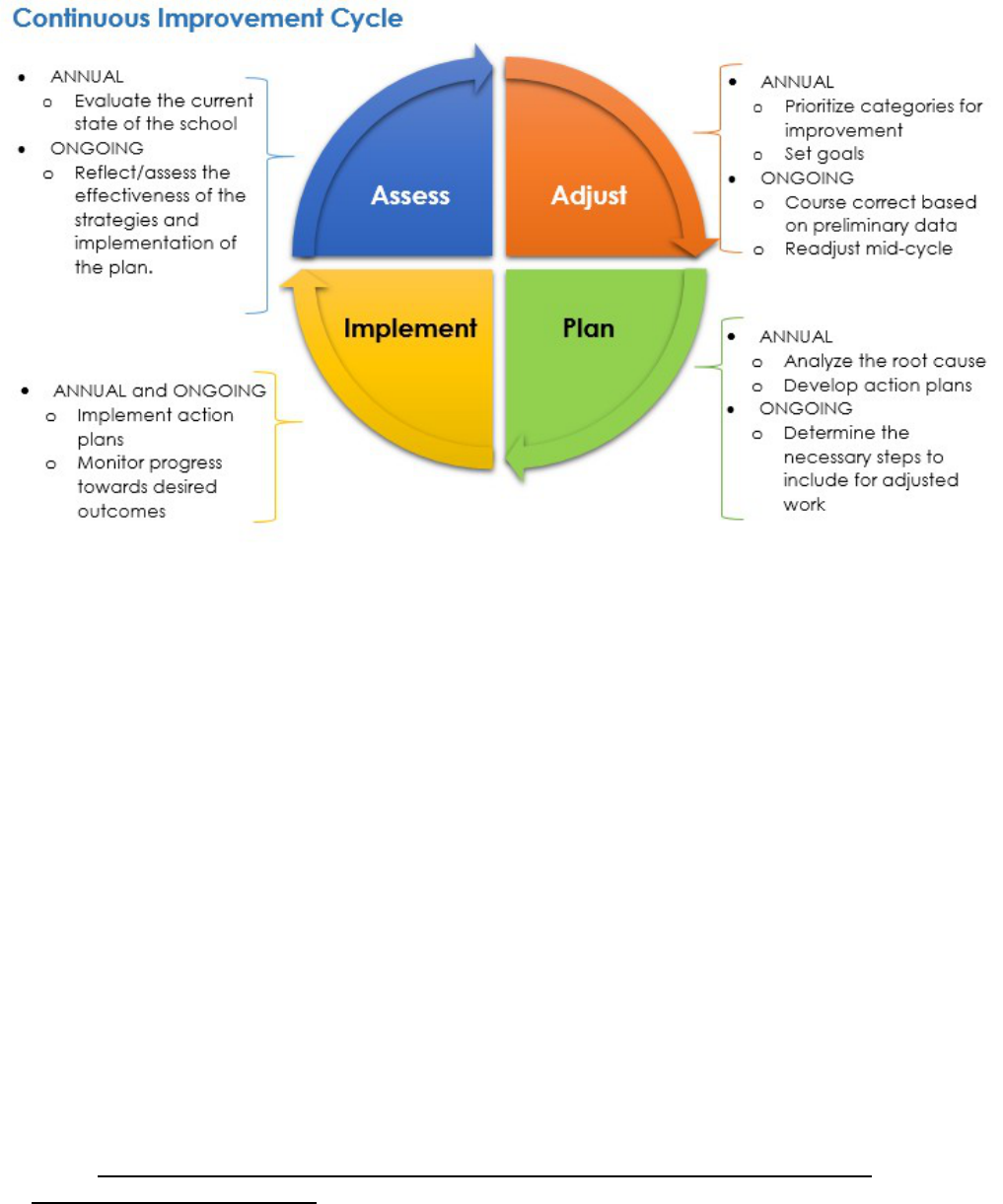
99
OVERVIEW
The Illinois School Code requires all schools to develop a plan, called the School
Improvement Plan, to improve the quality of education provided by the school. The
plan must include:
•
Results of state tests;
•
Measureable goals;
•
Analysis of school performance;
•
Professional development activities.
The Chicago Public Schools improvement planning process is the Continuous
Improvement Work Plan or "CIWP." The CIWP has three purposes:
•
The blueprint for the improvement of the school and the education of the
students;
•
An action plan that guides the work of all stakeholders in the school community;
•
An accountability tool for the Local School Council, the school community, the
school district and the Illinois State Board of Education.
While only schools that are not in Intensive Support or Provisional Support need
LSC approval for the CIWP, it is required that all schools present the CIWP to the
community, and it is strongly encouraged that all schools get approval of the CIWP
from the LSC.
100
Planning the CIWP should:
•
Focus on the strengths and needs of the school.
•
Include parent/community ideas.
•
Establish 3-5 Strategies.
•
Provide opportunities for members of the school community to have a say in the
educational programs of the school.
Preparing the CIWP:
•
The principal is responsible for developing the CIWP and convening a CIWP team
in consultation with the LSC, all categories of school staff, and parents and community
residents
•
The CIWP is the basis for making the school’s budget.
•
The CIWP must include:
•
Measurable goals
•
Analysis of school performance
The CIWP planning process should:
•
Make use of the varied expertise and experiences of members of the school
community in establishing the CIWP Planning Team;
•
Result in the establishment of realistic goals that will drive the continuous
improvement cycle of the schools;
•
Provide opportunities for members of the school community to have a say in the
educational programs of the school;
•
Focus the school community on the unique strengths and needs of the school
(through reflection on the School Excellence Framework);
•
Result in the planning of strong action plans that are likely to lead to significant
progress at the school;
•
Create a climate in which the school community agrees on what needs to be done,
and works together to accomplish it;
•
Include an internal review progress to ensure the school is making progress towards
its goals.
Approving the CIWP:
•
The LSC must present the proposed CIWP to the parents and community
before it is approved through public meetings on the plan for implementation.
•
The LSC must approve the CIWP (for schools not in Intensive Support or
Provisional Support).
Using the CIWP to Support Progress:
•
The principal is responsible for implementation of the CIWP.
•
The LSC is responsible for monitoring the plan. The LSC should check on the
status of the action plans on a continual basis.
•
The principal and LSC can use the CIWP action planning website
https://ciwp.cps.edu to keep track of progress.
•
The principal can propose changes to the CIWP. Changes can be made to action
plans and the school’s budget adjusted if needed to support the changes.
•
During implementation, the CIWP team can make changes to strategies. To do
so, they submit an amendment for approval by the LSC/Network Chief.

101
KEY TERMS
This listing includes important terms used in this section.
Term
Definition
CIWP
Continuous Improvement Work Plan, the school
improvement planning tool and process for CPS. The
school’s principal organizes a team to make the CIWP.
https://cps.ciwp.edu
School Excellence
Framework (SEF)
The School Excellence Framework (SEF) is a school self-
evaluation tool used to help the CIWP team identify the
District priorities that most closely align to the school’s
needs.
School Quality
Rating Policy
(SQRP)
The School Quality Rating Policy (SQRP) is the
Board of Education’s policy for evaluating school
performance. Each school’s rating is posted on the
CPS website. To find a school’s rating, go to
https://cps.edu/findaschool
Goals
Outcomes that the school sets for its work. The goals are
based on an analysis of the school’s current status, growth,
and the school’s need for improvement. The CIWP should
include 3-5 goals.
Strategy
A plan or method that will accomplish major changes in the
school in terms of how students, teachers, or administration
work. The strategy is the first part of a school’s theory of
action, which is then implemented through action steps.
The CIWP plan includes strategies to accomplish each goal.
Once implemented each CIWP Strategy should result in
goals being achieved and progress sustained. The school
makes an Action Plan, including milestones and start/end
dates, for each Strategy.
Action Step
Specific steps that a school will take to accomplish a strategy.
Theory of Action
A statement explaining the work that a school does, and
how its effects will be shown. It is stated as follows:
“If we do [our strategy], then we will see [changes in behaviors
of teachers, students, or administration], which will result in
[measurable improvement]”.

102
ASSESSMENT TERMS
Term
Definition
MTSS:
Multi - Tiered
Systems of
Support
Multi-Tiered System of Supports (MTSS) is a newer Framework adopted by
many districts (including CPS). It is similar to RTI but varies in that it 1)
addresses academic as well as social, emotional and behavioral
development of children, 2) focuses on meeting the needs of EVERY
student, with a focus on providing rigorous Tier 1 instruction to all students
and 3) requires schools to go through a careful problem-solving process
where both student and instructional factors are analyzing before
determining next steps.
CCSS:
Common Core
State Standards
To ensure all students are ready for success after high school, the Common
Core State Standards establishes clear, consistent guidelines for what every
student should know and be able to do in Math and English Language Arts
from kindergarten through 12th grade. Experts and teachers from across the
country prepared the standards, which are designed to ensure students are
prepared for today’s entry-level careers, freshman-level college courses,
and workforce training programs.
NWEA:
Northwest
Evaluation
Association
The Northwest Evaluation Association produces several assessments that
are currently used by CPS includes the MPG and MAP. NWEA assessments
are adaptive, meaning they adjust the level of the test to how students
perform, providing a precise measure of student learning that is independent
of grade level. CPS uses two NWEA assessments:
NWEA MPG: An Early Reading and Math skills assessment
NWEA MAP: Measure of Academic Progress – a reading and math
assessment for grades 2-8
RIT Scale:
Rasch Interval
Scale
The NWEA’s RIT Scale is a curriculum scale that uses individual item
difficulty values to estimate student achievement. Use of the scale allows for
the comparison of students’ academic performance relative to:
1) National achievement and growth norms
2) State standards, including the Common Core State Standards (CCSS)
SAT
The SAT Suite of Assessments is an integrated assessment system
made up of the PSAT 8/9, PSAT/NMSQT & PSAT 10, and SAT. The
tests measure the same skills and knowledge in ways that make
sense for different grade levels, so it’s easier for students, parents,
and educators to monitor student progress. CPS high schools are
required to administer the PSAT 8/9 to freshman, PSAT 10 to
sophomores, and SAT with writing to juniors in the spring of SY16-
17. The SAT with writing is required by ISBE.
Schools may optionally administer the PSAT 8/9 to freshman and the
PSAT/NMSQT to sophomores and juniors in the fall. Juniors taking
the PSAT/NMSQT can qualify for National Merit and other
scholarship opportunities.
103
ROLES AND RESPONSIBILITIES OF THE LSC and
PPLC
FOR THE CIWP
Both the LSC and the School’s Professional Personnel Leadership Committee
(PPLC) have important responsibilities in the CIWP process.
The Role of the PPLC
•
The role of the PPLC “is to develop and formally present recommendations to
the principal and the local school council on all matters of educational program,
including but not limited to curriculum, school improvement plan development
and implementation, and school budgeting.”
•
Principals can involve the PPLC by appointing PPLC members to the CIWP
team and/or by creating opportunities for the PPLC to provide recommendations
to the CIWP planning process.
The Role of Traditional & Appointed LSCs
Both Traditional and Appointed LSCs should participate actively in the preparation of
the CIWP, although the principal is responsible for the planning process and presents
the final plan to the LSC.
Responsibilities of Traditional and Appointed LSCs:
•
Approve the CIWP and any amendments to the CIWP if the school is not
in Intensive Support or Provisional Support;
•
Monitor the implementation of the CIWP and the Budget;
•
Hold a public meeting to present the proposed CIWP and Budget to the school
community (the meeting must include an opportunity for public input and
comment)
•
Hold two well-publicized public meetings annually to report on progress and
problems with implementing the CIWP.
LSC Approval of the CIWP
For schools in Intensive Support, the Network Chief maintains final approving
authority over the CIWP and Budget. For schools in Provisional Support, the Network
Chief has final approving authority over the CIWP while the LSC maintains authority
over the Budget. For all schools in Good Standing, the LSC maintains final approving
authority over both the Budget and the CIWP and any revisions to the Budget or
CIWP recommended by the Network Chief should be resubmitted by the school to
the LSC for final approval.
The principal is responsible for developing the CIWP with input from a diverse group
of stakeholders from the school. Parent and teacher participation is required. The
principal should serve as the chairperson of the CIWP Team, appointing other team
members from the school and community, which can include members from the LSC,
PAC, and all categories of school staff, including the PPLC.
104
The LSC must present the proposed CIWP to parents and the school community
before it is approved. Once the LSC approves the CIWP, the principal is responsible
for implementing the plan and the LSC is responsible for monitoring its
implementation.
The LSC must convene two (2) meetings during the school year to report to the school
community on the school's progress and problems with the implementation of the
CIWP.
Organizing the PLAN:
P
RIORITIES, GOALS, STRATEGIES, AND ACTIONS
This section explains the planning of the CIWP. You can use the information in this
section to analyze your school’s CIWP and to plan the next one.
Analyzing your school’s current CIWP is a good way to start the school year. It also
is the first step to revising the CIWP or planning a new one. The school’s principal
provides a copy of the CIWP to the LSC at the beginning of the school year. The
LSC uses it to keep track of progress and to monitor implementation of activities.
This section explains the parts of the CIWP and can be used to analyze the plans
your school has made and to prepare for planning a new CIWP or making changes
in the current CIWP.
When you read the CIWP you see:
•
The goals the school set for progress;
•
The strategies the school chose to make that progress;
•
The actions the school planned based on those strategies;
•
The kinds of information the school uses to measure progress.
CPS Priorities and School Plans
For the 2018 – 2020 CIWP, schools were to choose 3-5 school priorities out of
the 17 categories in the CPS School Excellence Framework. The following
chart lists and defines each category. The LSC will find the priorities in the
current CIWP listed in the chart.

105
School Excellence Framework Categories
LSCs can use this chart to learn more about goals in their current CIWP and to help the
CIWP team identify goals for the next CIWP.
Leadership &
Collective
Responsibility
Leadership & Collective Responsibility is characterized by an unwavering
commitment to fulfilling a shared vision of success. There is a clear focus
and high expectations for staff and students motivating the entire school
community to continue striving for success for every student.
Instructional
Leadership Team
The ILT is characterized by having a consistent structure for teacher
leadership that is focused on creating and implementing their theories of
action that improve teaching and learning. ILT meetings are a productive
forum to identify challenges, collect and review evidence, exchange ideas,
and propose and implement solutions to challenges to school improvement.
Professional
Learning
Professional Learning includes sufficient time, support, and ‘safe practice’
space to internalize new knowledge to change practice and beliefs. Adults
persevere in collaboration with their colleagues to innovate and improve
implementation of new practices.
Aligned Resources
Resources (e.g. time, budget, staff, and community resources) are aligned
to school priorities. Improving achievement guides resource allocation.
Making the most of student time and staffing is a priority. The school
organizes resources school-wide through schedules and staffing plans that
target additional time and individual attention to those students who need it
most and to highest priority subject areas.
Curriculum
The curriculum – what students should know and be able to do - makes
standards come alive for students. All students have access to an
academically rigorous curriculum that inspires students to think and
contribute high quality work to authentic audiences beyond the classroom.
The curriculum fully integrates academic and social emotional learning
opportunities for all students, including diverse learners, English learners,
and advanced learners. The school regularly examines the curriculum to
check alignment to standards and opportunities for all students to meet
those standards.
Instructional
Materials
Materials to present learning content and what the learner uses to
demonstrate are characterized by variability and flexibility. Materials are
identified and adapted to increase access to learning for all students.
Materials include multimedia and embedded, just-in-time supports; varied
tools and supports; alternative pathways; and
varied levels of support and challenge.
Rigorous Student
Tasks
The school regularly examines student work - what students are being
asked to do on in their classrooms - across grades or courses in all content
areas.
Examining the texts students use and tasks students do is a way to tell how
the curriculum represents the standards and prepares for college and career
readiness. (adapted from The Education Trust – Equity in Motion Series)

106
Transitions, College &
Career Access &
Persistence
The school creates pathways to success built on a vision in which all
students leave secondary school with a clear plan for their initial
postsecondary destination, whether in apprenticeship training, work, or
college. All students have equal access to college preparatory
curriculum. The school is characterized by structures for developing
early postsecondary awareness and the knowledge and skills that lay
the foundation for the academic rigor and social development
necessary for college and career success. Students are equipped with
the confidence in their ability to implement and adapt their plan
throughout their lives as they and the world around them change. This
vision sees students as the architects of their own lives.
Instruction
The teachers have finely honed instructional skills. They can shift from
one approach to another as the situation demands by carefully monitoring
the effect of their teaching on student learning. They seamlessly
incorporate ideas and concepts from other parts of the curriculum into
their explanations and activities. Their questions probe student thinking
and serve to extend understanding. They promote the emergence of self-
directed learners.
Balanced Assessment
and Grading
A balanced assessment system effectively measures the depth and
breadth of student learning and monitors student progress towards
college and career readiness. It also produces actionable data to
inform planning for instruction, academic supports, and resource
allocation. To meet these goals, a balanced assessment system
must include multiple measures and be responsive to the needs of
all students, including diverse learners and English learners.
Multi-Tiered System of
Supports
The school fully implements a system of academic and social emotional
(SEL) supports for all students. Every day, in all classrooms, all teachers
provide: Universal instruction in the core curriculum - academic & SEL
(Tier 1) to all students; additional targeted academic and SEL supports
(Tier 2) where needed; and deep and intense supports (Tier 3) based on
individual and small group needs. The school also monitors On Track
data (grades/GPA and attendance (ES), and course credits (HS)) to
provide interventions/supports for students at risk for failure and/or
truancy.
Culture for Learning
A culture for learning is characterized by a school atmosphere that
reflects the educational importance of the work undertaken by both
students and staff. It describes the norms that govern the interactions
among individuals about the mindsets (e.g. ability/confidence to grow with
effort), academic behaviors (e.g. attending classes, completing
assignments), the learning strategies and skills, the value of
perseverance despite challenges and obstacles, and the general tone of
the school. The classroom is characterized by high cognitive energy, by a
sense that what is happening there is important, and that it is essential to
get it right. There are high expectations for all students. The classroom is
a place where teachers and students value learning and hard work, and
students take visible delight in accomplishing their work. Staff believe they
can make a difference, that their hard work is the fundamental cause of
student achievement, and are invested in student outcomes.

107
Relational Trust
The school is characterized by high levels of relational trust -- the “glue”
or the essential element that coordinates and supports the processes
essential to effective school improvement --between all school
participants. Interactions, both between the teacher and students and
among students, are highly respectful, reflecting genuine warmth and
caring. Students contribute to high levels of civility. Interactions are
sensitive to students as individuals, appropriate to the ages and
development of individual students, and to the context of the class.
The net result of interactions is academic and personal connections
among students and adults.
Student Voice,
Engagement, & Civic
Life
Students are interested and engaged in learning, invested in their school,
and contributing to their community. The school provides early and
ongoing exposure to a wide range of extracurricular activities and rigorous
courses and programming.
Safety & Order
The school is characterized by high levels of safety and order. Students
feel physically and emotionally safe from harm, and adults work to
actively maintain a safe, orderly school environment.
Restorative Approaches
to Discipline
The school is characterized by having and implementing policies and
procedures that emphasize proactive, instructive, and restorative
approaches minimizing punitive consequences. Discipline practices
primarily focus on shaping behavior as opposed to punishing behavior.
The school only uses out- of-school suspension as a last resort and
utilizes a systems-change approach to bring about a more restorative
culture. The school is also characterized by strong and consistent school
and classroom climates. The school reinforces positive behaviors and
responds to misbehaviors in calm, respectful, and thoughtful ways,
teaching students important social and emotional skills that enable them
to get along with others, make responsible decisions, and focus on
learning. When misbehavior occurs, the school seeks to understand the
underlying reasons (root cause) in order to design a response that
effectively changes student behavior using a menu of instructive,
corrective and restorative responses.
Parent Partnership
The school develops strong parent partnerships characterized by
involving parents in the instructional program, messaging expectations,
fostering a better connection between the school and home, and inspiring
participation and high levels of collaboration with families. The school
provides opportunities for families to volunteer, build its parent
community, and support the school's operations through activities
including but not limited to participation on parent councils (e.g. PACs,
BACs and PLNs). There are high levels of communication between
schools and families is mutual and two-way. Families have a way to voice
concerns and schools address and respond to input.

108
DEVELOPING A NEW CIWP
Each school takes the following steps to organize the CIWP:
•
Identify a CIWP team that consists of 6 – 15 committed stakeholders to act as
the steering committee for the entire CIWP planning process. For all schools,
parent and teacher participation is required in the development of the plan.
The principal should serve as the chairperson of the CIWP Team, appointing
other team members from the school and community, which should include
members from the PPLC, ILT and/or LSC and PAC.
•
Complete/update the school's self-evaluation within the School
Excellence Framework using any available scorecard, performance,
and/or survey data.
•
Set Goals for each of the next three school years, including School Quality
Rating Policy (SQRP) and State metrics.
For information on the SQRP, go to http://www.cps.edu/SQRP.
Making the Plan
•
The principal establishes the CIWP Team, chairs the team meetings
and oversees the work.
•
The CIWP team develops the plan collaboratively.
•
The plan includes 3-5 strategies focused on the school’s selected Areas
of Focus (Priority Areas).
•
An Action Plan with check-points (action steps) is developed for each strategy.
•
The CIWP Team completes the Fund Compliance and Parent and
Family Compact/Involvement Policy (if required).
•
The CIWP Principal obtains LSC and Network approval of the Budget and
CIWP, as necessary. While the budget approval is a separate activity, the
budget supports the strategies planned in the CIWP.
Approving the Plan
•
The LSC and the Network must approve the plan (only Network approval
is required for schools in Provisional Support or Intensive Support).
Role of the LSC
•
Conduct a well-publicized meeting to present the proposed plan to the school
community at which the public is allowed to comment on the plan.
•
Hold two more well-publicized public meetings annually to report on
progress and problems with implementing the CIWP.
•
Vote to approve or request changes to the CIWP.
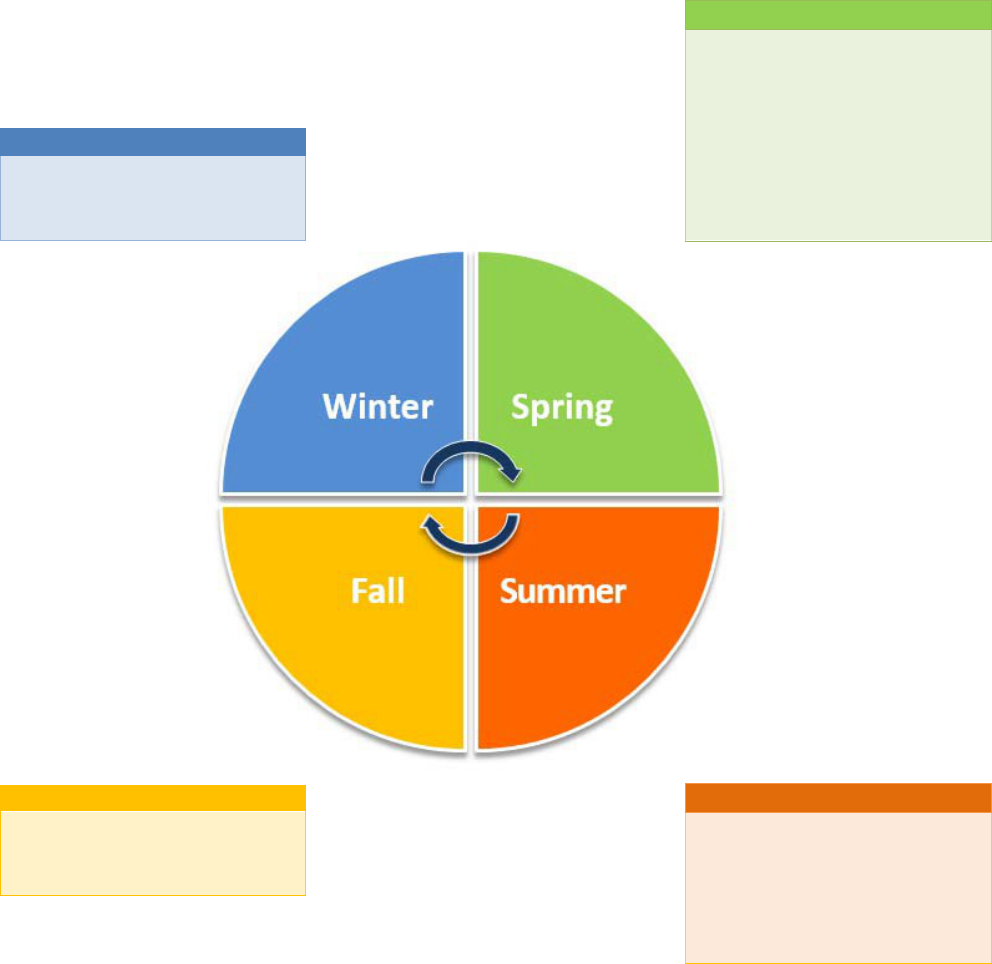
109
PLANNING YOUR SCHOOL’S CIWP
Every two years, your school prepares a new CIWP. Then during the time
period of that plan, the LSC monitors it.
Sample Schedule to Develop the CIWP – Year 1 of Cycle
Winter
•
Continue tracking progress of
current CIWP through the
end of the year, making minor
adjustments as necessary. .
Spring
•
Early Second Semester:
Establish CIWP team;
complete School Excellence
Framework
•
Mid-Second semester: Set
goals and priorities; Develop
Action Plan
•
Budget Release: Develop
budget, finalize CIWP, budget
and full school day plan.
Fall
•
Discuss new data in ILD;
review CIWP and budget
and amend as needed
Summer
•
June: Finalize staffing
•
July/August: Board Approval
of CIWP and Budgets, as
necessary
•
July: Start implementing CIWP
•
August: Develop PD plan
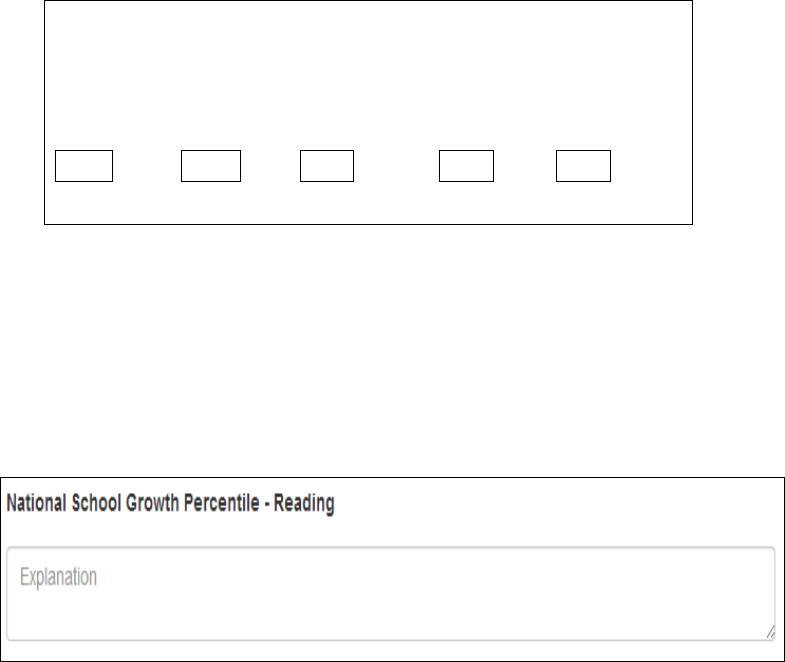
110
During Year 1 of the new CIWP, the school implements the plan. During Year 1
and 2 of implementation, the school can make adjustments. Then the school
CIWP team prepares the next plan.
Goals
Schools analyze data to set goals for improvement. The metrics that are included in
the CIWP vary based on the type of school. This is because the data that is used to
measure performance is influenced by the school being served—for example,
elementary versus high school.
Schools also have the opportunity to set and create goal fields in the CIWP for any
other metrics they would like to monitor during the continuous improvement cycle.
These could be metrics related to specific programs in the school, but are added at
the school’s discretion.
1.
For each required metric below, the school must provide both a numeric goal
for the next three years, as well as an explanation answering why that
particular goal was selected. This may be based on historical performance or
on anticipated strategies developed around performance in that metric. For
each required metric below, the school’s 2019 and 2020 SQRP data is
populated, and the school must provide a goal for the next three academic
years in the designated boxes.
2018- 2019- 2020- 2021- 2022-
2019 2020 2021 2022 2023
Actual Actual Goal Goal Goal
2.
Then, each school must provide an explanation to answer how they
determined that goal for the academic year. This explanation must provide a
basis for the goal that includes your analysis of the past data.
111
School Performance Goals
Planning the CIWP begins with an analysis of the current SQRP—an
annual report on the school’s academic status. The second part of this
section includes an explanation of the SQRP.
The SQRP is a report based on the previous year’s academic
achievement, attendance, and surveys. It is best to analyze the previous
two years’ SQRP reports to see any changes. The principal also will
provide current school data to help identify the school’s priorities.
To find your school’s SQRP reports, go to
https://cps.edu/findaschool
Goals
CPS provides each school with information about the school’s status in a goal-setting
tool. The tool lists the historical data available for each required goal a school sets.
The Goal Setting Tool has been designed around the School Quality Rating Policy.
Schools will set goals around designated SQRP-related metrics, but then also have
the opportunity to create and show progress on any other metrics of their own
choosing, specific to the school.
Responding to Problems
The CIWP planning includes identifying problems and the root causes of
those problems. LSC members on the CIWP team should participate in the
planning and can recommend ways to respond to the problems. Those
responses may be school-wide strategies to include in the CIWP or changes
in current school programs so that the problems can be addressed
immediately, not waiting for the CIWP.
The School Excellence Framework
An important resource to include in the planning is the School Excellence Framework.
The School Excellence Framework (SEF) is a useful guide to analyze your school at
any time. It includes 4 dimensions with 17 categories, and the school should analyze its
performance in terms of each category. For each category, there are examples of ways
an effective school works. Each school evaluates how well it works in terms of each
part and those examples. The framework gives schools working models for how to
improve. The following diagram shows the parts of the SEF. The chart in the previous
section of this guide includes explanations of each of the categories.

112
School Excellence Framework
This diagram shows the categories of the SEF.
SEF Score Scale
The following ratings are used to tell how consistently the SEF categories are in place
at the school.
1 = NONE of FEW of the practices are evident.
2 = FEW of the practices are CONSISTENTLY evident and/or for FEW students and
staff.
3 = MOST of the high impact practices are CONSISTENTLY evident for SOME or
ALL students and/or staff. The principal is generally the sole diver of practices for
school improvement.
4 = NEARLY ALL practices are CONSISTENTLY evident for ALL students and/or
staff. There is evidence students, teachers, and community members are co-driving
practices with the principal.

113
Example SEF Criteria
This example shows how a school can organize work to improve in a category of the School
Effectiveness Framework.
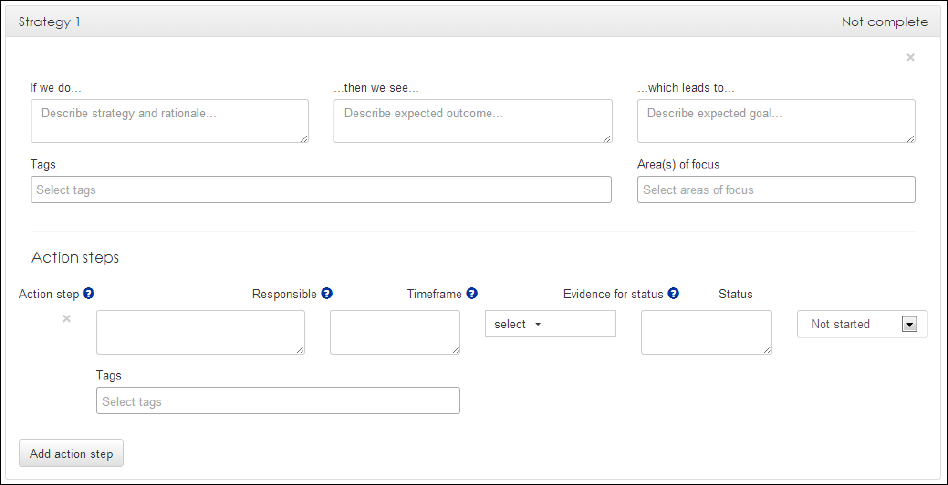
114
Strategies
Once the goals are set that should result in SQRP Levels that are acceptable to the
school, the management strategies and curriculum decisions that will enable the
goals to be met can be planned. A strategy is a specific initiative that, once
implemented, will achieve transformative change in the way a school operates
and/or on student, teacher, or school administration behavior. Schools must create
strategies that address each of their ‘Areas of Focus’ identified from the SEF. Pre-
designated ‘Areas of Focus’ will automatically populate at the top of the Strategies
page.
Schools will create strategies aligned with a school-level theory of action. Each
strategy must be formatted in the tool according to the theory of action template:
“If we do [our strategy], then we will see [designated behavioral changes],
which leads to [metric improvement]”.
Every school must fill out each of the boxes provided on the strategies page for
every strategy they create. An explanation of each box is provided in the table on
the next page.
Use the School Excellence Framework to identify strategies.
Schools begin planning by looking at the way their school works. The School
Excellence Framework is built into the CIWP. It includes examples of effective ways
that successful schools work. Schools can analyze their own work in comparison
with the examples in the School Excellence Framework.
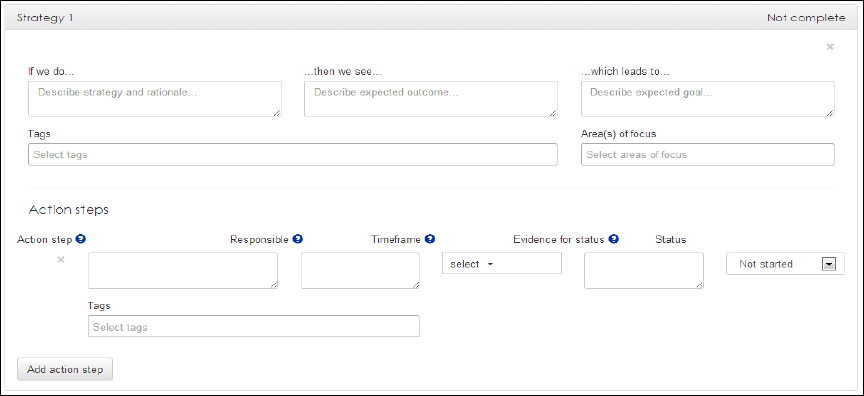
115
SETTING PRIORITIES
After the CIWP team reviews the school’s status in terms of the School Excellence
Framework and student achievement and attendance data, they select the priorities
for the plan. A school can select 3-5 of the categories from the SEF as their priority
areas (also called Areas of Focus). These 3-5 categories then become the basis for
the school’s strategies for improvement.
STRATEGIES
The CIWP team will develop strategies to drive improvement in 3-5 priority areas.
Using high-impact practices and the guidance of the SEF document, these strategies
will lead to improvement in student learning. They can include changes in teaching or
administration as well as student performance.
THE ACTION PLAN
The CIWP team makes an action plan for each strategy. The Action Plan is a set of
steps the school will take to accomplish the strategy. The Action Plan includes the
action steps, who is responsible, and the start and end dates.
Example Strategy: Build teachers’ capacity to deliver Common Core aligned literacy
instruction supported by high quality texts.
Example Actions:
•
Conduct professional development on standards-based instruction emphasizing
ability to read increasingly complex texts.
•
Organize peer teams to adapt model Common Core literacy lessons for use by
grade levels.
•
Teachers construct “bank” of literacy activities based on standardized assessments.
For each strategy identified, the team develops an action plan. They create
milestones—actions that need to take place, schedules, and ways to monitor
the actions. The action plan is the basis for monitoring implementation. The
LSC monitors the CIWP to make sure that the plan is moving ahead.
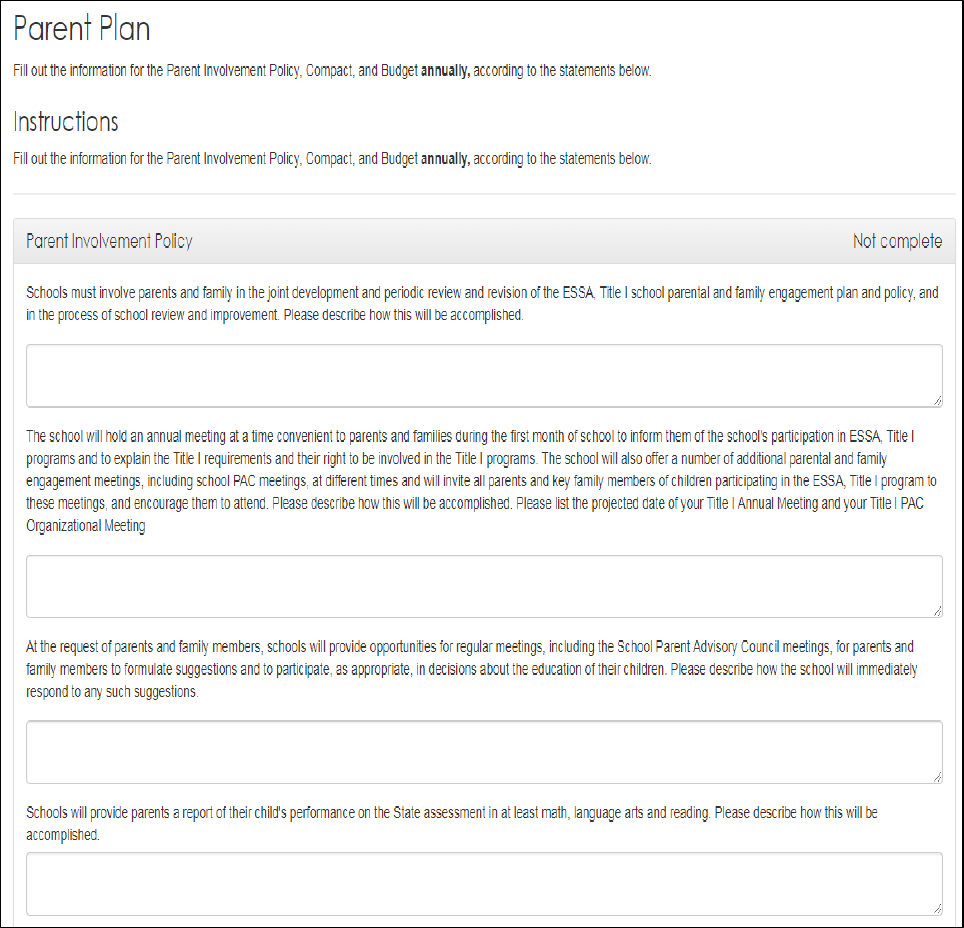
116
Parent and Family Plan
Parents and families are essential to every school’s progress. While only Title I
schools complete the Parent and Family Engagement Policy and School-Parent
Compact, they are useful to all schools. In the parent and family plan, schools explain
how parents and families will be involved in their children’s education and will
participate in the school’s progress.
117
Budgeting for Progress
The school’s budget must be organized to support the implementation of the CIWP
and the ongoing operations of the school. The school must provide funding as
needed for the actions in the plan. The budget includes funds needed for the
activities to accomplish the 3-5 strategies and all other operational costs. The budget
resources section of this guide includes three documents the LSC can use to
monitor appropriate use of funds.
In addition to the general budgeting, each Title I school completes the Fund
Compliance worksheet. In this page, Title I schools explain how they will use the
activities identified in the CIWP to improve academic achievement.
SUPPLEMENTAL GENERAL STATE AID (SA)
____My school receives SA funds
By checking the above line, the school is verifying that the attendance center complies with the statemen t
regarding the use of SGSA funds:
1.
The attendance center allocation is correctly based on the number of students eligible to receive free and reduced lunch and breakfast.
2.
The attendance center has an approved plan, developed in consultation with teachers, administrators, and other appropriate personnel,
and parents of the students attending the attendance center.
3.
The attendance center’s plan is approved by the LSC and CPS.
4.
SGSA funded activities fall within the allowable program categories: early childhood education, reduced class size, enrichment
programs,
remedial assistance, attendance improvement, and other educationally beneficial expenditures which supplement the regular
programs as
determined by the Illinois state board of education.
5.
SGSA Funds supplement and do not supplant non-categorical and other categorical funds allocated to the attendance center.
6.
SGSA funds are supporting only those activities specified in the school's approved plan/amendment.
7.
SGSA funds are not used for capital expenditures. 8. SGSA funds are not used for any political or lobbying activities by the attendance center.
ESSA Program
ESSA Schoolwide Program
(Not available to schools receiving Title 1/SW funds for the first time)
• The school annually reviews the schoolwide plan/program. The schoolwide program plan is available to
CPS, parents, and the public,
and the information in the plan is in an understandable and uniform format,
and to the extent practicable in a language the parents can understand.
•
ESSA Targeted Assistant Program Title I funded staff participate in the school’s general professional
development and school planning activities. Title I Funded staff assume limited duties that are assigned
to similar personnel incl
uding duties beyond the classroom, or that do not benefit Title I students, as long
as the amount of time spent on such duties is the same proportion of the total work time with respect to
similar staff.
• Non-title school that does not receive any Title funds.

118
CIWP Approval
Approval Instructions: After completing the Budget and aligning to the CIWP, all schools should
present the budget and CIWP first to their local School Council (LSC), followed by the Network
Chief for approval. A school’s current SY18-19 Accountability Status will determine whether the
LSC or the Network Chief has final approving authority, meaning all changes must be approved
by this entity prior to submission (outlined below).
SY 18-19 School
Accountability Status
Document
Needing Approval
Local School Council*
Network Chief
Good Standing
Budget and CIWP
Review with Final
Approving Authority
Review and Approval
Provisional Support
CIWP
__________________
Budget
Review and Approval
(highly recommended)
__________________
Review with Final
Approving Authority
Review with Final
Approving Authority
__________________
Review and Approval
Intensive Support
Budget and CIWP
Review and Approval
(highly recommended)
Final Approving
Authority
*For schools with an ALSC or an LSC without a quorum, the ALSC or LSC only maintain
advisory support over the Budget and CIWP but no approval authority.

119
USING THE CIWP TO MONITOR AND SUPPORT
SCHOOL PROGRESS
Every two years, your school prepares a new CIWP. After the CIWP is approved,
then the LSC monitors its implementation.
The CIWP tool is an interactive CPS website which should be updated frequently
and used to monitor progress. LSCs and Principals should establish regular routine
for checking in to discuss progress and ways the LSC can support the school in
meeting the goals of the plan.
MONITORING WITH THE ACTION PLAN
The LSC has an important role in monitoring the action plan. The LSC should take
the following steps to monitor and support its implementation.
•
Ask the Principal to establish a monitoring calendar: Review updates to
the CIWP Action Plans to monitor progress.
•
Review the status and comment field, then prepare supplemental questions
for the principal to better understand how successful the school has been at
implementing various components of the action plan.
•
Determine how the LSC, parents and community can help support the school
in reaching its goals.
The Action Plan includes the specific milestones that need to be met in order for the
strategy to be implemented effectively. The Action Plan is divided into two parts:
Action Plan and Monitoring. The LSC should monitor the action plan on an ongoing
basis. The principal should update the status of the action plans once each
quarter on the CPS website at ciwp.cps.edu.
Monitoring
“Status” box
Monitoring
“Evidence” box

120
COMPONENTS OF THE CIWP ACTION PLAN TEMPLATE
This template includes status as the last row. It should be updated as work proceeds.
Section
Description
Examples/Drop Down
List
Tags
The goal of the tags is to associate
each individual strategy with one or
more broader ideas to give schools
the flexibility to address individual
needs and communicate a broader
range of strategic plans, specific to
their data-driven inquiry cycle.
Schools can tag each strategy, as
well as individual action steps
within each strategy. Multiple tags
can be assigned to each strategy
or action step.
Select one or more tags from the
categories listed below:
o
MTSS
o
Content Areas:
Literacy/Reading, Math, Science,
Social Studies, Libraries, PE, Arts
o
Core Instruction
o
Technology
o
Computer Science
o
Dual Language
o
Diverse Learners
o
English Learners
o
Specialized Academic Programs
--CTE, DC/DE, Magnet, Gifted, AP, IB, STEM
o
Assessment
o
Curriculum Design
o
Professional Learning
o
Instructional Coaching
o
Attendance
o
College Access and Persistence
o
Intervention
o
Behavior and Safety
o
Climate and Culture OR SEL
o
Personalized Learning
o
Student Health and Wellness
Area/s
of
Focus
Based on the Areas of Focus selected
on the Priorities page, this box is
provided so the school can select one
or more areas of focus being addressed
by that strategy.
The list will depend on the 3-5 areas
of focus selected by the school
from the SEF priorities.
Responsible
Party
The responsible party is the person or
group of people (i.e. ILT) that will be
responsible for ensuring the milestone is
met.
This is a text box.
Include individual names, titles or groups.
Timeframe
The Timeframe column has a drop
down list to indicate when the action
step should be started and completed
by.
Select the appropriate calendar dates.
If assigning months or weeks, select the
first/last day of the month or week when
you
would like to complete the strategy.
Comments
on Status
This area provides a space to track
additional notes pertinent to
implementation and/or monitoring of
the action steps. It MUST be completed
when indicating the Status.
This is a text box.
Status
The Status column contains a drop
down to update the status of the
milestone.
•
Not Started
•
Completed
•
Postponed
•
Cancelled
•
On-track
•
Behind

121
Monitoring the CIWP
The CIWP follows a continuous improvement cycle, where goals, strategies and
milestones are monitored regularly and adjusted as needed. The principal should
provide the LSC with the CIWP and provide updates on the progress to complete the
actions and meet the milestones. This chart is an example of a format the LSC can use
to keep track of CIWP progress at each monthly meeting. The principal can provide an
update on all the CIWP goals or focus on one or two goals at the meeting.
Month
CIWP Progress
Next Steps
122
REVISING THE CIWP
Adjusting Action Steps
Action steps that are included in the CIWP may need to be changed, rescheduled or
removed and replaced because the principal and Instructional Leadership Team
(ILT) decide that the other action steps will be more effective. Minor changes in the
CIWP can be made without approval of the LSC or notifying the Network, but it is
helpful to keep the LSC and the Network informed of changes, particularly since they
need to be monitored.
If there is a change in the action steps planned for the CIWP, the budget may need
to be adjusted. However, all changes must be within the requirements for each
budget source and consistent with the Strategy.
Changing Strategies
If changes need to be made that are more significant than changing action steps,
schools must submit an amendment to the CIWP. The school can change a strategy if
needed because the current strategy is not effective at achieving the goal. The school
can change a strategy at any time, but the changes in strategy or other major parts of
the CIWP need to be approved by the LSC and Network.
Connection to the SQRP
The SQRP is a report on the school’s status. The school receives the SQRP on the
previous year’s status in autumn. The principal and ILT may identify needs to adjust
the CIWP based on the report.

123
2. The School Quality Rating Policy (SQRP)
INTRODUCTION
The SQRP (School Quality Rating Policy) is an annual rating of each school’s progress
during the previous school year. The school’s rating relates directly to the CIWP—the
implementation of the CIWP should result in increases on the measures of the SQRP.
The LSC will consider the SQRP ratings as they identify priorities for the CIWP and then
may adjust the CIWP based on the school’s progress that the SQRP reports.
The SQRP is a combination of different measures. The basis for rating an elementary
school is different from the basis for a high school but both emphasize academic
achievement and student attendance. The LSC should analyze the SQRP for the most
recent school year and for the preceding years so they can trace the school’s progress.
This section is a concise explanation of the SQRP. The source of the information in this
section is the SQRP Handbook.
The School Quality Rating Policy is the Board of Education’s policy for evaluating
school performance. Through this policy, each school receives a School Quality Rating
and an Accountability Status every year. Among other things, the SQRP helps to
communicate to school stakeholders the academic success of individual schools and
the district as a whole; provides a framework for school goal-setting; and guides the
Board’s decision-making processes around school support and intervention.
All schools receive a rating, including neighborhood schools, magnet schools, charter
schools, selective enrollment schools and option schools.
What indicators are included in the SQRP? Because different schools serve different
populations of students, the SQRP uses different indicators for each type of school.
For more information on the SQRP, go to http://www.cps.edu/sqrp.
HOW THE SQRP WORKS
The SQRP is based on a weighted point system. Schools earn between 1 and 5 points
for each indicator, which are then weighted and added together to compute an overall
weighted score that is also between 1 and 5 points. It is with this overall weighted
score that the school’s School Quality Rating and Accountability Status are
determined. This first section is an overview of the main elements of the SQRP.
Points For each indicator in the SQRP, schools can earn between 1 and 5 points
for reaching progressive benchmarks of performance. More information on the
indicators and point values used in the SQRP is on page 6 of the SQRP handbook.
Weighting Each indicator has a specific weight in the SQRP. Weights may be different
based on the number and type of indicators that are available to a particular school,
but the sum of the weights for the school will always be 100%.
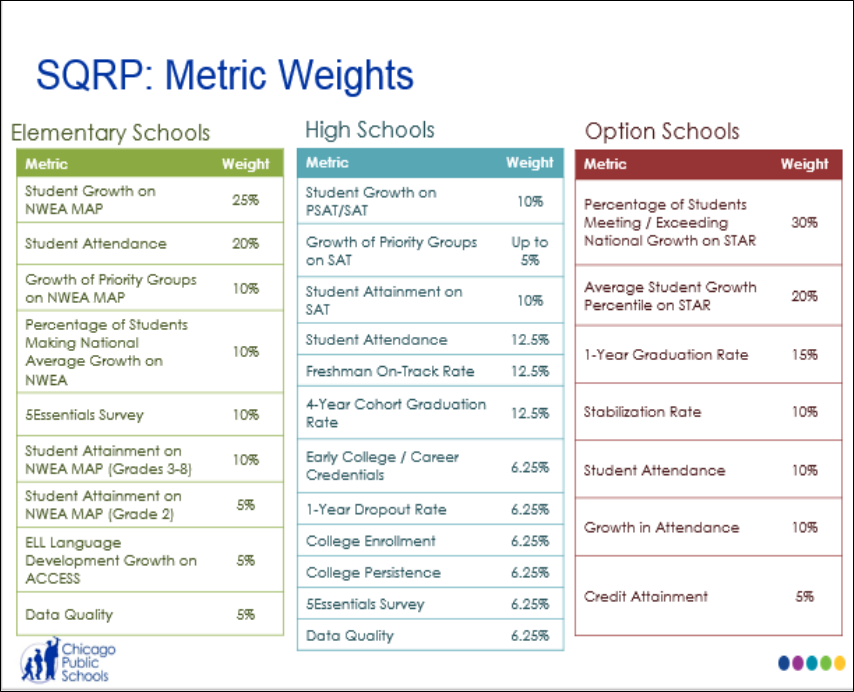
124
Weighted Score The points received for each indicator are multiplied by their
weight and then added together. The resulting weighted score will be between 1
and 5. Indicators with larger weights will play a bigger role in determining the
school’s overall weighted score.
School Quality Rating Based on the overall weighted score, schools are assigned
a rating of Level 1+ (4 – 5 points), Level 1 (3.5 – 3.9 points), Level 2+ (3 – 3.4
points), Level 2 (2 – 2.9 points), or Level 3 (1 – 1.9 points). Schools can also
achieve a Level 1+ rating by being in the 90th percentile or higher nationally on the
attainment indicator set out in the policy.
Accountability Status
The School Quality Rating is used to determine the school’s Accountability Status.
In general, schools receiving a Level 1+, Level 1 or Level 2+ rating are in Good
Standing status, schools receiving a Level 2 rating are in Provisional Support status,
and schools receiving a Level 3 rating are in Intensive Support status. For more
information on the assignment of accountability status, see the SQRP handbook.
This chart shows how a school’s rating is calculated.

125
How are ratings assigned?
• Schools earn between 1 – 5 points for each metric.
• Points are weighted and added together. The school’s overall score is also between 1 – 5.
• Based on the overall score (or minimum attainment percentile – see below), the school
receives a School Quality Rating and Accountability Status.
Overall
Score
OR
NWEA Minimum
Attainment
Percentile
PSAT/SAT
Minimum
Attainment
Percentage
School
Quality
Rating
Accountability
Status
4.0 or
more
90th
80%
Level 1+
Good Standing
Between
3.5 and
3.9
70th
60%
Level 1
Good Standing
Between
3.0 and
3.4
50th
40%
Level 2+
Good Standing
Between
2.0 and
2.9
40th
20%
Level 2
Provisional
Support
Less than
2.0
--
--
Level 3
Intensive Support

126
What does a school’s status mean?
Good Standing
Levels 1+, 1 & 2+
Provisional Support
Level 2
Intensive Support
Level 3
These schools are
meeting or exceeding
the minimum
performance
expectations for CPS
schools.
While these schools are
still bound by federal
and state law and CPS
policies, they have
some autonomy around
school improvement
planning and budgets.
LSCs approve CIWPs in
these schools.
These schools are in need of
targeted support to keep them
moving in the right direction. The
CEO may require the following:
• Drafting a new CIWP
• Directing the implementation
of the CIWP
• Providing additional training for
the LSC
• Mediating disputes or other
obstacles to improvement
If the CEO determines the
problems are not able to be
remediated by the above
methods, the CEO may place the
school in Intensive Support.
These schools are in need of
intensive support to quickly
improve the quality of
education for students. In
addition to the types of support
provided under “Provisional
Support”, the following actions
may be taken*:
• Replacing the principal
• School turnaround
• Ordering new LSC elections
• Closure
*These actions are allowable
under Illinois School Code, but
will not necessarily happen in all
“Intensive Support” schools. A
hearing and a Board vote are
required for these actions.
Note: A school’s accountability status may differ from the above criteria based on CEO
discretion and Action History (8.3). Consult the SQRP Handbook for more information.

127
Responses to General Questions about the SQRP
What process was used to develop the SQRP?
Chicago Public Schools spent over a year collaborating with a wide range of internal
and external stakeholders to formulate the SQRP. These stakeholders included
content experts in CPS, principal, teacher and parent focus groups, networks chiefs,
charter organizations, researchers, and other leaders in the education field. The
metrics ultimately chosen took into account as much input from this diverse group of
stakeholders as possible, and were also designed to align with the district’s current
School Effectiveness Framework.
How does the SQRP support planning?
The SQRP includes a holistic set of metrics that taken together provide a definition of
school quality that includes, but also goes beyond, academic growth as a measure of
success. The SQRP includes measures of academic growth, school culture and
climate, and preparation for college and career success. Many of the metrics used to
measure school performance are also being used to evaluate district-level success.
Examples of these include 3rd-8th grade students’ academic growth versus national
norms; 9th-11th grade student’s academic growth versus national norms; average
daily attendance; college enrollment and persistence; and data from the My Voice My
School survey. The SQRP places additional emphasis on closing the achievement gap
for all priority groups (i.e., English Language Learners, students with diverse learning
needs, African-American students and Hispanic students).
What is the difference between intensive support and probation? What is the
difference between intensive support and provisional support?
The terms “probation” and “intensive support” are interchangeable, but CPS has
listened to feedback from stakeholders that the term “probation” is overly negative and
not useful in describing what the status means. Therefore, schools that meet the
requirements of probation will receive the “Intensive Support” designation on its
reports. Similarly, “Remediation” and “Provisional Support” are interchangeable terms,
with “Provisional Support” being the term that will be used in reports.
My school received a Level 2 rating last year but is still on probation. What do I need
to do to get off of probation?
Your school would need to attain a rating of Level 1+, 1, 2+, or 2 to come off probation
(also identified as “Intensive Support”). If your school receives a Level 2+ or higher, it
will be in “Good Standing” status. If it receives a Level 2, it will be in Remediation (also
identified as “Provisional Support”). There are still some accountability requirements
for schools in Remediation, but it is not Probation status. For a full decision tree that
describes how a school’s accountability status is determined, see the SQRP
Handbook http://www.cps.edu/sqrp.
128
My students are high achieving. Won’t that make it harder on them to get the growth
my school needs to score well on the SQRP?
No. Each school’s growth comparison is based on schools nationally with the same
pretest average (the school’s “national average comparison score”). Thus, growth as
defined in the SQRP is an apples-to-apples comparison wherein schools are
compared to the average growth of other schools that started at the same place.
What kind of SQRP-related materials are available for school communities to help
with planning and communication?
The Department of School Quality Measurement posts SQRP-related materials to
either www.cps.edu/SQRP (for all school stakeholders) or the CPS Knowledge Center
https://sites.google.com/a/cps.edu/kc/resource-allocation/school-quality-rating-policy
(for school staff). The following materials are either currently available or forthcoming:
•
SQRP webinar (including introductory version with overview);
•
SQRP Handbook (including introductory materials for all school stakeholders);
•
SQRP Overview Videos (both English and Spanish);
•
Calculators
•
Model-specific overall SQRP results calculators;
•
Growth calculators (based on national norms) for NWEA, EPAS
and ACCESS;
•
PowerPoint slides for both school staff and other school stakeholders
(including Spanish-language slides).
Responses to Questions about Specific SQRP Metrics
What is the difference between percentage of students meeting national average
growth and my school’s growth percentile?
One of these measures is a percent of students meeting a growth threshold, while
the other is a national percentile rank of the school. The percentage of students
meeting national average growth is based on the growth of individual students.
Based on each student’s pretest score, there is a national average posttest score
(i.e., the average posttest score for students with the same pretest score nationally).
The number of students in a school who make average growth, divided by the total
number of students tested, determines the percentage of students meeting national
average growth. In this measure, a student counts as a zero (0) or one (1) in the
numerator, and one (1) in the denominator.
A school’s growth percentile is a school’s national growth ranking. A percentile is the
percent of schools that had lower average growth nationally than your school, with 1
being the lowest percentile and 99 being the highest. This percentile is based on the
difference between the average posttest score and average pretest score in the
school, as compared to national average growth for schools with the same pretest
score. A school growing at the same pace as a national average school will get a 50th
percentile score. Whether the school’s score is higher or lower than the national
average and by how much determines the growth percentile.

129
Both of these measures are important – and thus are both in the SQRP. The growth
percentile looks at the average growth of the school and ranks it nationally. The more
growth the school shows, the higher the percentile. The percent of student meeting
national average growth looks at whether this growth is happening across the school or
just for some students. A school does better on this metric by increasing the number of
students showing growth.
What is the difference between the students who are included in my school’s
growth cohort, attainment cohort and participation rate?
A school’s participation rate is determined by taking the number students who take a
test and dividing it by the number of students attending the schools during the testing
window. The Department of School Quality Measurement has developed guidance for
schools to understand how participation rates will be calculated. The document, titled
“SQRP Participation Rates,” is on the SQRP page of the Knowledge Center.
A school’s attainment cohort is made up of all the students who actually take the test.
Thus, the list of students in the attainment cohort will be different than the list of
students in the denominator of the participation rate if a school is not able to test all its
students. Further, the attainment cohort is based on the spring test only. It does not
look at whether the students had a pretest score from the prior year.
A school’s growth cohort is made up of all the students who take the test and also
took the test the year before. Thus, the list of students included in the growth cohort
will possibly be different again from either of the metrics above, as many schools will
have some students who did not take the test the year before (e.g., students who
transferred from another district).
What grade does a student have to earn in an early college course in order for it
to count toward my school’s early college metric?
The metric measures whether a student has earned a credit in an early college
course. So whatever grade is required to earn credit for the course is the grade
required for the student to count positively towards a school’s early college metric. For
most dual enrollment courses, the minimum grade to earn credit is a C.
How do I know whether my school’s students are taking approved early college credits
or career credentials?
The Department of School Quality Measurement has collaborated with the
Department of Early College and Career Education to develop and publish a list of
approved early college credits and career credentials. These can be found in
Appendix C in the SQRP Handbook http://www.cps.edu/sqrp.
The Department of Early College and Career Education can also be contacted

130
What is the response rate minimum for 5Essentials results to be included in the
SQRP calculation? Is it the same minimum for teachers, students and parents?
A school must have a 50% response rate from both students and teachers for all five
Essentials to be included in the school’s SQRP calculation. If a school has a 50%
response rate from one group but not the other, then only that group’s responses will
be included in the calculation. Parent surveys are not included in the SQRP. However,
parent survey responses are included on the school progress reports, and the school
must have a 30% response rate to receive parent survey results.
Questions about SQRP Calculations
Some of my school’s students showed really large increases or decreases in their
scores this year. Is the Department of School Quality Measurement going to adjust
these outliers so they don’t have too big an effect on my school’s overall scores?
Yes. In some schools, especially those with small student populations, student growth
outliers like this can have a large impact on overall school averages. In order to
control for this, the Department of School Quality Measurement will cap decreases
and increases in scores at the 1st and 99th growth percentiles, respectively.
Are my school’s Diverse Learners compared to other Diverse Learners nationally
when calculating that priority group’s metrics?
No, they are compared to national average growth of a school that had the same
pretest performance as your diverse learners. The best way to think of Diverse
Learners (or other priority groups included in the SQRP) is as a “school within a school”
for accountability purposes. Namely, the priority group growth comparisons are
calculated the same way as school-wide growth comparisons (i.e., using a “national
average comparison score”). Each priority group’s average pretest is calculated and
then compared for growth purposes against the national schools with the same pretest.
While demographic factors are not directly controlled for, the students against which
your priority groups are being compared do have similar pretest achievement levels.
How are college enrollment and persistence calculated? Which students count in
that calculation?
College enrollment is a measure of what percentage of a school’s graduates enroll in
college the year after graduating. Thus, the denominator for this metric is the number
of last year’s graduating students and the numerator if the number of those graduates
enrolled in college either the Fall or Spring of the following year.
College persistence is a measure of how many of a school’s students stay in college
after having enrolled. So the denominator is the number of students enrolled in
college the previous year (which is the numerator of the college enrollment
calculation) and the numerator is the number of those students still enrolled in college.
More information on these metrics can be found in the SQRP Handbook on cps.edu.
Where do I get more information?
Visit http://www.cps.edu/sqrp, email [email protected] or call 733-553- 4444. Principals
can also access SQRP information and materials on the Knowledge Center at
https://sites.google.com/a/cps.edu/kc/resource- allocation/school-quality-rating-policy.
132
Introduction
As a Local School Council member, you play a critical role in developing, approving,
and monitoring your school budget. You will be making decisions on how millions of
dollars are spent each year. This guide is designed to help you make the best possible
decisions on how your school’s money is spent so that dollars are used to support
educational improvement and student achievement.
This guide is designed to enable you to:
•
Have a solid understanding of your roles & responsibilities as a LSC member
in regards to the school budget.
•
Understand the funding sources of your budget and how funds are allocated
and be comfortable with reviewing budget and other financial reports.
•
Be familiar with how to monitor and approve changes to the budget on an
ongoing basis and understand how internal accounts work and are
monitored.
Contents
School Budget Basics p. 133
Sources and Restrictions on School Funds p. 134
Explanation of Fund Categories p. 135
Bilingual Education Funds p. 139
Student-Based Budgeting p. 142
The LSC’s Role in the Budget p. 144
Preparing the Next School Year’s Budget p. 145
Working Collaboratively to Support School Progress p. 147
The LSC’s Responsibility to Monitor the Budget p. 148
Additional Resources
Key Terms p. 151
Key Budget Guidance p. 152
Allowable and Non-Allowable Costs
Title I p. 156
Title II p. 160
Title III p. 164
Budget Inquiry Report p. 168
Segment Lookup Tool p. 170
Position Report p. 171
Fundraising Guidelines p. 172
Each item in the Contents is hyper-linked to the page listed for that topic.
Click on the title and you will get directly to that page.
133
SCHOOL BUDGET BASICS
Major Funding Sources
The budget is prepared each year and covers twelve months, which is referred to as
the fiscal year. For CPS, the fiscal year is July 1 to June 30.
The money in school budgets, like the money for all of CPS, comes from three
major revenue sources:
•
City of Chicago property taxes and other local sources
•
Funding from the State of Illinois
•
Funding from the federal government (e.g. Title I, Title III)
Funds are allocated to schools based on different methods, which are often defined
by the source of the funds. These allocation methods are described in the sections
that follow. Most funds are restricted—limited to a certain kind of use—and that is
determined by the source of the funds.
For tracking purposes, each source of funds has its own fund number and many also
have a grant number, which provides for even more detailed tracking. Some grant
numbers change each fiscal year because we receive different grants from the
federal or state government. This might be confusing if you look for the same grant
number each year. We have tried in this document to highlight for you when the grant
number for the same funding may change from year to year.
Some funds “carry over”—which means that the school will still be able to use those
funds the next school year if they are not completely used by the end of the fiscal year.
The following chart is a summary that lists the source of funds, the fund number, a
brief description, restrictions, and whether funds roll over. Later sections go into more
detail.

134
Sources and Restrictions on School Funds
Fund
Fund
Number
Description
Restrictions on how funds are
used
Do funds
roll over to
next year?
Student Based
Budgeting
(SBB)
115
(see notes
below)
Funds allocated for the core
instructional
program for K-12 general education and
diverse learner
instructional programs
outside of ODLSS cluster classrooms. All
schools receive 1 principal, 1 counselor, and
1
clerk, and a per-pupil amount to be
used
for teaching positions, additional
administrative staff, and non-personnel
items.
These are general funds and
can be
used for any purpose.
However, they
are intended
for
the core instructional program
at your school.
No
Diverse
Learners
114, 220
Schools receive separate funding to serve
the needs of diverse learners in cluster
classrooms. Each school is allocated a
number of special education teachers and
paraprofessionals, based
on the number of
cluster classrooms.
Positions must be used to serve
diverse
learners.
Fund 114 is used for diverse
learner
spending from local
and state sources,
and fund
220 is for spending from
federal sources. This
distinction has little impact on
schools.
No
Supplemental
Aid
115
Supplemental dollars allocated to your
school based upon poverty counts. Schools
receive a per-pupil amount for
each student
whose family meets income requirements
under federal nutrition programs. This is
true even though all students now receive
free
breakfast and lunch
Supplemental Aid funds can be
used for
instructional or non-
instructional purposes.
Unspent
FY18
funds will
roll
over to
FY19,
but rollover
will not
continue
after
FY19.
Title I
332
Supplemental discretionary dollars from the
federal government that are
also
distributed based on your school’s poverty
levels. The formula is more
complicated
than Supplemental Aid, and not all schools
qualify for Title I.
Title I funds must be used to
supplement your school’s
instructional program. They
cannot be used for non-
instructional purposes, and they
cannot
be used to fulfill any
district
requirement.
No
Early Childhood
Usually
362
(see
notes)
Schools receive separate funding for
their
preschool students. Pre-K
students are
not counted in the SBB
per-pupil
calculations. The Office of Early
Childhood Education allocated
teachers
and aides to schools for
preschool
classrooms.
Positions must be
used
to serve
preschool
students.
No
Bilingual
115 (state)
356
(federal)
Funds for schools with 20 or more English
Language Learners of the same language
background for a Transitional Bilingual
Education (TBE) Program. Schools with
19
or fewer ELLs of the same language
background must provide a Transitional
Program of Instruction (TPI).
TBE and TPI services might be
provided by the classroom or
content teacher who holds the
appropriate endorsement, or by
a teacher who pushes in and
co-teaches for part of the day.
No

135
Explanation of the Fund Categories
Student Based Budgeting (Fund 115): Most schools receive their funds for general
education and diverse learner core instruction through Student Based Budgeting.
Three positions, principal, counselor and clerk, are called “Foundation Positions,” and
each school receives one of each position. These positions are found in fund 115,
Grant 000000. Schools also receive a per-pupil allocation in Fund 115, Grant
000575, which are used for teaching positions, additional administrative staff, and non-
personnel.
As a short-hand, we often combine the fund and grant together in a single number,
such as 115-000000 or 115-000575. Grant numbers are used in this instance to
separate the funding for tracking purposes.
Please note that specialty and options schools do not receive SBB funds. Instead,
these schools receive an allocation of teacher positions and non-personnel dollars
through a different formula. The following pages explain more about these school
budgets. Options schools serve students who need a new pathway toward high school
graduation. Examples include Association House—El Cuarto Ano and the Austin
Career Education Center. Specialty schools primarily serve students with significant
diverse learning needs. Examples include early childhood centers such as Vick School
and high schools such as Vaughn.
Diverse Learners (Fund 114/Fund 220): Schools receive separate funding to
serve the needs of diverse learners in cluster classrooms. This funding is given as
position allocations. The Office of Diverse Learner Supports and Services (ODLSS)
determines the number of teachers and paraprofessionals that each school will
receive, based on the number of cluster programs at a school. Diverse learner
cluster classroom teachers and aides are found in school budgets in either Fund 114
or Fund 220.
Fund 114 is used for diverse learner spending that comes from local and state
sources, and Fund 220 is used for diverse learner spending that comes from federal
sources. While this is important for the budget office, it makes little difference for
schools. What is important to know is that teacher and aide positions in either Fund
114 or 220 are given to your school to serve the needs of diverse learners in cluster
classrooms.
Supplemental Aid (Fund 115): Supplemental Aid (SA) refers to supplemental
dollars that schools receive for each student who qualifies under federal nutrition
program criteria. SA funds must be used to supplement the instructional program.
Funds are distributed in fund 115, grant 000576
136
NCLB TITLE I: DOS AND DON'TS FOR THE USE OF FUNDS
Dos:
NCLB Title I: All expenditures are supplemental and must be used for instructional
purposes only to improve academic achievement. Schools operating a Targeted
Assistance Program must use these funds only to serve the identified lowest
performing students.
•
Salaries (above required positions) – Teacher, Substitute for Title I funded teachers
and teachers attending staff development activities, Teacher Assistant, Tutor,
Instructional Computer Assistant, Tech Coordinator, School Community
Representative, Guidance Counselor, Security for instructional
programs only
•
Benefits - Health, Pension, FICA, and other related benefits
•
Purchased Services - Admission fees and bus service for field trips tied to curriculum,
conference registration fees/travel for teachers, education consultants, contracts for
repair and maintenance of equipment purchased with NCLB Title I funds
•
Supplies and Materials - Consumable supplies, books to supplement not replace
Basal/Primary textbooks, workbooks, audio/video, software, periodicals
•
Equipment and Furniture - Computers, workstations, audio/video equipment
Per Stevens Amendment, when issuing statements, press releases, requests for
proposals, bid solicitations and other documents describing projects or programs
funded in whole or in part with Federal money, all grantees receiving Federal funds,
including but not limited to State and local governments, shall clearly state the Stevens
amendment: “Funds for this activity were funded by NCLB Title I.”
Don'ts:
NCLB Title I: Funds cannot supplant, or take the place of locally funded expenditures
that support the basic instructional program at the school and cannot be used for non-
instructional purposes or capital expenses:
•
Salaries – Salaries for required positions, Substitute for non 332 funded teachers
unless a teacher is attending staff development activities, School Assistant, Clerk,
Assistant Principal, Business Manager or Operations Manager or relat
ed
administrative salaries
•
Purchased Services - Contracts for non-instructional services or repair and
maintenance of equipment not purchased with NCLB Title I funds, transportation to
extra-curricular activities (competitions/performances)
•
Supplies and Materials - Basal/Primary textbooks or replacements, non-instructional
items for security, office use, or to assist in administering programs, athletics/band
u
niforms
•
Equipment and Furniture – Items for office use, or to assist in administering
programs; replacement of equipment or furniture purchased with local funds,
extracurricular athletic/band equipment

137
Early Childhood (Fund 362): Schools may receive separate funding for early
childhood. Pre-K students are not counted in the per-pupil calculation for Student
Based Budgeting, and schools are not expected to use their SBB dollars for pre-K
classrooms. The Office of Early Childhood education allocates teachers and aides to
schools for pre-K classrooms. Early Childhood positions can be found in a number of
different places in your budget. Most often, you will find these positions in Fund 362,
but in some cases, positions are funded in Fund 115, Grant 000006. If your school
has a tuition-based pre-K program, early childhood positions will be found in Fund 117,
which is dedicated solely to tuition-based programs. While the funding source makes
little difference to the school, it is important to know the different funds and grants
where you may find early childhood positions.
Fund-Grant Number
Type of Early Childhood Funding
115-000006
Preschool funding from local funds
332-430208 (FY19)
Title I funds used for some Child Parent Centers. The grant value is
different
from your Title I discretionary funds.
117-000000
Preschool funding for tuition-based programs
362-various grant
numbers
that may
change each year
Preschool funding from grants
Special Programs: Your school may receive additional dollars or positions because of
special programs. Examples of these are magnet schools, International Baccalaureate (IB)
programs, selective enrollment schools, JROTC programs, and Career and Technical
Education, or CTE. Many of these programs are funded in Fund 115, but in various grant
values. Some of the programs are in other funds and have grant numbers that change each
year, as the federal grant award changes. This helps with tracking but you may not see the
same grant number each year.
This chart identifies the most common programs and the fund-grant number associated with
each:
Fund-Grant Number
Special Program
115-000018
JROTC
115-006068
Critical Language Initiative
115-008001
Regional Gifted Centers
115-008002
Regional Gifted Centers – ELL
115-008003
Academic Centers
115-008004
International Gifted Programs
115-008005
International Baccalaureate (IB) Programs
115-008006
Magnet Cluster Programs
115-008007
Magnet Schools
115-008008
Classical Schools
115-008009
Montessori Programs
115-008010
Selective Enrollment High Schools
369-various grant numbers
that change each year
Career and Technical Education

138
Local Revenue (Fund 124): In addition to the above, a source of funding for some
schools is local fundraising. Many LSCs have led efforts to supplement their school
budgets by soliciting donations, gifts, and grants. Some schools get additional
revenue from vending machines or property rentals. These funds may be found in
Fund 124, which is used for school-raised funds.
Operations Positions: Central office allocates positions to schools for operations and
maintenance, security, lunchroom, and transportation. Sometimes you will find these
positions in your budget. In some cases, the positions are budgeted centrally, even
though the staff members work at your school. In either case, these are positions that
are provided to your school. You are not expected to use SBB dollars for these
positions, although some schools use their SBB or SA funds to budget for additional
security guards. Engineers, custodians, and bus aides are now budgeted centrally,
although these positions were found in school budgets in the past.
Fund-Grant Number
Operations Positions
115-376708
Bus monitors
210-000000
Security guards
312-000000
Lunchroom workers
Options and Specialty School Funding
The district-run options schools and district-run specialty schools do not receive SBB
funds. Instead, these schools receive positions and supplemental dollars through a
different formula based on the special circumstances of the school. If your school is an
options or specialty school, you will find your core instruction funding in one of the
following funding sources:
Fund-Grant Number
Type of Core Instruction Funding
115-000086
Positions allocated to district options schools
115-000088
Flexible dollars allocated to district options schools
115-000089
Positions allocated to specialty schools
115-000090
Flexible dollars allocated to specialty schools

139
BILINGUAL EDUCATION FUNDS
Program Description
Bilingual Education Programs serving English Language Learners (ELs) in Illinois
school districts are mandated by state law and are governed by Article 14C of the
Illinois School Code and the 23
rd
Illinois Administrative Code Part 228.
The district identifies students who come from non-English language backgrounds and
determines whether the student is an English Language Learner (ELL). Schools with 20
or more English Language Learners of the same language background must establish
and maintain a Transitional Bilingual Education (TBE) Program. TBE program
components include instruction in language arts and core content subjects in the
students’ home language and English as a second language (ESL) instruction. Native
language instruction must be provided by a teacher who holds a bilingual endorsement
and ESL instruction must be provided by at teacher who holds an ESL endorsement.
Schools with 19 or fewer ELLs of the same language background must provide a
Transitional Program of Instruction (TPI). In TPI, students must receive ESL instruction
from an ESL endorsed teacher and receive content support and accommodations as
needed. Depending on the size of the program, TBE and TPI services might be
provided by the classroom or content teacher who holds the appropriate endorsement,
or by another teacher who pushes in and co-teaches for part of the day.
Bilingual Advisory Committee (BAC)
Pursuant to the Chicago School Reform Act, every school implementing a state
mandated Transitional Bilingual Education (TBE) or Transitional Program of Instruction
(TPI) program is required to constitute a Bilingual Advisory Committee (BAC). The BAC
is recognized as a standing committee of the Local School Council (LSC) and serves to
identify and address academic concerns related to the school’s bilingual education
programs in the Continuous Improvement Work Plan (CIWP) and budget
allocations. The BAC Chair and a majority of its members must include parents of
students enrolled in the school’s bilingual education program. The BAC meets at least
four times per school year, and hosts additional training meetings to develop leadership
and advocacy skills of parents/legal guardians of ELLs.
State and Federal EL Funding Eligibility Requirements
The Transitional Bilingual Education programs and/or the Transitional Programs of
Instruction are funded based on the number of English Language Learners enrolled in a
school. The number of ELLs is taken from the current-year, month of January school
data. A school having one or more English Language Learners must provide bilingual
education services (TBE or TPI, as appropriate).
The district uses the state and federal allocations to provide district schools with
supplemental positions and funding for specific activities that are allowed through the
grant and that support bilingual education services in our schools.

140
State EL Funding
• Schools with at least 20 active ELs in grades K and above, receive a 0.5
supplemental teaching position. The position is staffed with an EL-endorsed
teacher who supports the principal ensuring EL services and instruction is
provided in compliance with the Illinois 23 Administrative Code Part 228. The
best strategy for using this position is to staff the ELPT or an EL resource
teacher, so that the teacher can provide the required components of services to
students across the school who are not able to receive all the required
components of EL services from their classroom/core content teacher.
Federal EL Funding
Some schools might be eligible for additional non-teaching supplemental positions for
EL staff:
• EL Coach: 0.5 EL Coach positions allocated to schools with at least 250 active
EL students. These positions are prohibited to be used as classroom teaching
positions. Individuals staffed as EL Coaches must hold a bilingual and/or ESL
endorsement. EL Coaches are required to participate in OLCE-sponsored
training around teacher coaching, and engage in an OLCE Coaching Cycle with
two teachers during the school year. Other EL Coach responsibilities involve
designing and delivering PD related to ELs, EL curriculum planning, supporting
planning of general program teachers without EL endorsements, and offering
supplemental outreach activities for parents of ELs.
• Dual Language Coordinator: 0.5 Dual Language coordinator positions allocated
to schools that have been approved to implement or to plan to implement a Dual
Language program in their schools. These positions are prohibited to be used as
classroom teaching positions. Each DLE Program is provided a 0.5 DLC position
whose responsibilities include program planning and providing DLE Program
professional development at the school. The DLC is part of the Dual Language
Leadership Team (DLLT) whose responsibilities include overseeing DLE
Program logistics and ultimately ensuring structures are in place to meet program
goals and sustainability.

141
Title III federal funds are also given to schools to be used for:
• ELPT (EL Program Teacher) Stipends: The ELPT supports the principal in
addressing all Bilingual Mandates, and establishing an EL Program that meets
the needs of all ELs in the school, irrespective of that number. The ELPT
receives a stipend for any additional time dedicated to fulfilling responsibilities
associated with this role. The stipend is only given to non-salaried staff.
Principals nominate ELPTs to OLCE. For SY2018-19, the nomination process
will occur in August/September. Specific information is forthcoming. The stipend
is given to the person identified as the ELPT by the principal through that
process. The stipend amount is disbursed in two payments (end of Semester I
and end of Semester II).
• EL After School Tutoring (grades 3-12): Eligible schools have at least 100 ELs
in grades 3-12. Schools eligible for EL After School Tutoring do not automatically
receive funds. Funds become available during Quarter 2 of SY18-19, only after
schools complete and submit an EL After School Tutoring application to OLCE
and are approved to receive funds. The application includes information about
informational webinars, required reporting, and specific timelines. Funds are
earmarked for 3 Bilingual-and/or ESL-endorsed teachers to provide ELs weekly
after school tutoring sessions for two hours. Tutoring program runs from about
the end of November/early December through April. The program goal is to
provide bilingual and ESL content support so ELs successful in accessing
academic content. OLCE supports the program implementation through City
Span.
How Can the Money be Used?
As described above, State and Federal-funded bilingual education funds are allocated
to schools in the form of supplemental teacher positions or funds for specific
activities. In addition, schools with at least 20 active ELs receive an allocation ($500)
to be used by the Bilingual Advisory Committee. BACs decide how monies are spent.
Some approved expenditures include:
• refreshments for monthly BAC meetings and workshops,
• parent transportation (if more than 1.5 miles) to school BAC meetings or
collaborative Academic Network BAC meetings,
• childcare while participating in BAC activities
• fees and related expenses for parents attending conferences and workshops
Contact Information: Additional information is available from the Office of Language
and Cultural Education, (773) 553-1930.

142
STUDENT-BASED BUDGETING
Under Student Based Budgeting, schools receive a per-pupil amount for every student
enrolled, weighted by grade level and LRE level for Students with Diverse Learning
Needs. The per-pupil funds core instruction staff, educational support personnel,
supplies and additional instructional programs. Principals and LSCs will work together
to use these dollars in ways to increase academic achievement and improve student
outcomes.
How the district calculates Student-Based Budgeting allocations
(Note: this methodology applies to all district schools except specialty and options
schools, who are resourced differently due to the specialized needs of the students they
serve.)
1. Calculate Enrollment
Beginning in FY19, SBB funding will be based on 20
th
day enrollment of the previous
year. Your SBB funding will be adjusted at the beginning of the school year based on
your actual enrollment on the 10th day IF enrollment has increased from the previous
year; no downward adjustment will be made for decreasing enrollment.
The Office of Management and Budget coordinates an appeals process prior to the
rollout of school budgets for schools that believe their enrollment will be increasing in
the following year. A school on an upward enrollment trend can, through this process,
receive funds in advance for enrollment growth expected in the fall.
Once the appeals process is completed and any advances are communicated to
schools, the enrollment figures are finalized and used to determine the amount of SBB
funding that the school will receive during the budget process for the next school year.
2. Establish a Per-Pupil Amount
The FY19 base per-pupil amount of SBB funding ($4,390) reflects a 2.5% increase
over the FY18 base, reflecting the year-to-year increase in labor costs and other
expenses.
Grade weights help provide additional resources where additional instructional may be
needed. K-3 students are weighted slightly higher than the 4-8 grade students to
reflect the greater resources needed. High schools are weighted significantly higher
because the costs are higher; largely driven by the fact that high school teachers have
two prep periods per day, rather than one.

143
Using these grade weights the amount per pupil is set.
Grade Level
SBB Weights
Kindergarten
Per-pupil amount x 1.07
Grades 1-3
Per-pupil amount x 1.07
Grades 4-8
Per-pupil base rate
Grades 9-12
Per-pupil amount x 1.24
3. Account for Students with Diverse Learning Needs
The allocation of per-pupil dollars for students with diverse learning needs reflects
the amount of time the students spend in a Gen Ed setting (including ancillary
support). Weightings are based on the LRE status of diverse learners. Other
resources are provided based on students’ individual needs determined through IEP
process. These resources are in addition to SBB funds and are described
elsewhere.
SBB FOR ELEMENTARY SCHOOLS:
•
LRE 1 students: 100% of the per-pupil amount
•
LRE 2 students: 100% of the per-pupil amount
•
LRE 3 students: 40% of the per-pupil amount
SBB FOR HIGH SCHOOLS:
•
LRE 1 students: 100% of the per-pupil amount
•
LRE 2 students: 70% of the per-pupil amount
•
LRE 3 students: 40% of the per-pupil amount
4. Determine Each School’s Per-Pupil Allocation
The amount each school receives is the enrollment by grade and LRE status
multiplied by the weighted per pupil amount.
5. Provide Foundation Positions for Each School
Each school will receive a Principal, Counselor, and Clerk that will not have to be paid
out of the per-pupil funds. Each school is obligated to have 1 Principal under state law,
and each school is required to have 1 Counselor and 1 Clerk per the CTU contract.
6. Accommodate Schools with High-Cost Staff
If a school’s staff cost in total is higher than the district’s average, the school will
receive funds to cover the additional amount. This Teacher Salary Budget Adjustment
will be included in each school’s budget based on the current year’s staff.

144
THE LSC’S ROLE IN THE BUDGET
State statute authorizes LSCs to be responsible for approving the expenditure plan
(budget) prepared by the principal with respect to all funds allocated and distributed to
the attendance center by the Board AND to approve receipts and expenditures for all
internal accounts of the attendance center, and to approve all fund-raising activities by
non-school organizations.
The LSC has responsibility for:
•
Providing input in the development of the budget and for approving ALL funds
in the budget.
•
Ensuring that the budget supports the School Improvement Plan; otherwise
known as CIWP.
•
Presenting the proposed budget to the community.
•
Requesting revisions to the budget.
•
Providing LSC approval before a principal can enter into contracts for $25,000
or less for professional services or $10,000 or less for purchases requiring a
formal bid.
•
Approving transfers of funds.
•
Monitoring the internal accounts activity, which we will cover in detail later.
The Principal has responsibility for:
•
Developing a budget to support the CIWP with input from the LSC and others.
•
Entering into contracts with LSC approval.
•
Providing LSC’s with audits and reviews of the programs and operations
of the school.
•
Obtaining input from LSC and final approval from the Network Chief if
school is on probation.
For schools on probation, the Network Chief has responsibility for:
•
Providing input in the development of the budget to make sure it supports the
School Improvement Plan.
•
Requesting revisions to the budget & approve transfer of funds.
•
Requesting the principal close or open positions.
•
Approving and monitoring internal accounts.
•
Approving large expenditures and all fundraising activities by non-school groups.
145
PREPARING THE NEXT SCHOOL YEAR’S BUDGET
Budget Timeline
This is a general timeline for the budget process. The actual calendar dates may
change year to year. The timeline on this page gives you an overview of the structure
of the process; not specific dates as to when each step will occur. Specific dates and
deadlines will be announced each year when the budget is released to schools.
The process starts with the preparation of the School Improvement Plan, the CIWP
(Continuous Improvement Work Plan). The budget is designed to support the activities
that the CIWP includes. The CIWP is a two-year plan. During year 1 of the
implementation of the plan, the budget may be adjusted if there are changes in the
CIWP. The second year for the CIWP also can be adjusted. See the guidance on the
preparation and implementation of the CIWP for information about that process. The
budget for year 2 is confirmed during year 1 of the plan’s implementation. The following
schedule lists the actions to prepare the budget for each year.
November – April: Develop or confirm the CIWP for the next year.
March - June:
• Schools receive proposed dollar amounts for the next fiscal year.
•
Budget developed to support CIWP.
•
LSC presents CIWP and Budget to school community.
•
LSC approves CIWP and Budget.
•
Budget formally submitted by Principal. The Principal must now certify
whether LSC has approved budget when submitting.
June-August: Board approves Total CPS Budget.
By law, the LSC must conduct two meetings where the budget is discussed and the
public is invited to ask questions. One of these meetings can be held during the
budget approval process to discuss budget proposals. The second can be held at the
end of the school year to discuss results. The meeting should include the Instructional
Leadership Team and should describe the school’s mission, major goals, programs,
accomplishments, and the use of funds to pursue goals. The public is then invited to
ask questions and make comments.
146
Steps to Prepare the Budget for the Next School Year
The budget is developed after the Continuous Improvement Work Plan (CIWP) to
enable the school to carry out that plan.
Step 1: Develop or confirm (if you are in the first year of the CIWP) your Continuous
Improvement Work Plan. Illinois state law requires each CPS school to develop a
school improvement plan every two years. This plan establishes:
•
A school’s mission;
•
Strategic priorities for the next two years;
•
Specific actions that the school will take to accomplish its goals.
The principal works with the LSC and other stakeholders to develop a school
improvement plan that describes how the school will improve academic achievement.
The LSC votes to approve the school improvement plan. See Part 3 of the LSC guide
for more information about the preparation of the CIWP.
Step 2: The principal prepares a budget based on the CIWP and presents the LSC with
that proposed budget.
Note: The uses of school funds provided by the federal government under Title I
of the Elementary and Secondary Education Act/Every Student Succeeds Act
have to be voted on by the school’s Parent Advisory Council (PAC) before being
submitted to the LSC for approval.
Step 3: The LSC discusses with the Principal whether the expenditures in the budget
will allow the school to carry out the school improvement plan effectively and
efficiently. The LSC can recommend changes in the budget.
Step 4: The LSC must present the budget to the community for
comment.
Step 5: The LSC votes to approve the budget. A budget must be approved by the
majority of serving members.
Special Cases
•
LSCs of Schools on probation: The LSC participates in a discussion of a
presentation to the stakeholders of the proposed budget that supports the priorities
of the CIWP. The LSC takes an advisory vote, with the final budget approval by
the Network Chief.
•
LSCs of Schools not on probation but no quorum: Board Rule 6-31 indicates that
if the active membership of an LSC has fallen below the quorum requirement (7
members) for taking action, the CEO or designee shall exercise the powers of the
LSC to approve the budget and to transfer funds.
147
WORKING COLLABORATIVELY TO SUPPORT
SCHOOL PROGRESS
Recommendations for a Collaborative and Effective Budget Approval Process
We are all aware that the district has limited funds and there are great measures taken
to ensure that funding of schools is equitable and fair. We also know that when money
is involved in a discussion, the conversation can easily become heated and debated.
This section is dedicated to providing helpful reminders and tips so that budget
approval discussions can be effective and collaborative.
Important Understandings
• Student enrollment is a key component that drives the budget! Student
enrollment will determine SBB allocations, and therefore most of the money
available to budget.
• Student enrollment and staff salaries and benefits (determined by
contracts) are not under the control of the LSC.
• The LSC has authority for the allocation of resources provided to the school but
not the amount provided to the school.
• Many funds come with restrictions. LSCs should have a strong knowledge of
the school and staff and understand the limitations of resource allocations.
• Keep in mind that the allocation of resources is an exercise in trade-offs and this
may not be easy. Different people can see the trade-offs differently.
Recommendations to Work in Partnership with Your Principal During the Budget
Planning Process
• Focus your energies around school priorities and solving problems. Partner with
your principal to generate creative solutions to challenges. By providing effective
feedback and offering solutions, you build a strong school and an even stronger
community.
• Take time to review and study the information and budget materials given to
you in advance of the meetings.
• Make notes on questions to ask and ask a lot of questions. If you are not clear
about something, chances are high that many other LSC members are not clear
either. If possible, ask as many questions as possible before a meeting
• Be patient! Your principal may not be able to answer all your questions
immediately, but will get back to you as soon as possible.
• Be mindful that many expenditures happen according to a set pattern. For
example, salary costs are calculated in advance and paid out by the central office
at steady rate throughout the year. What you want to focus on is unanticipated, or
new, expenditures throughout the year.
The CIWP should be the driver in every decision you make in regard to the budget!
148
THE LSC’S RESPONSIBILITY TO MONITOR THE BUDGET
The LSC monitors the budget, internal accounts and implementation of CIWP. Here
is important information about this role.
Budget Changes: The LSC is involved in ongoing monitoring of the budget and is
required to approve any changes in the way funds are used (budget transfers). If the
school wants to spend funds in ways not specified in the budget, the principal must
obtain approval from the LSC. If there are major changes ($5,000 or more) in the
budget, their effect on the school improvement plan (CIWP) must be assessed before
they are approved.
•
Budget transfers must be approved by at least seven (7) members in
elementary schools and eight (8) members in high schools.
•
Changes in the use of Title I parent involvement funds have to be voted on
by the school’s Parent Advisory Council (PAC) before being submitted to the
LSC for approval.
•
Budget transfers can only take place within the same fund and grant.
•
Requisitions over $5,000 require Network Chief or Central Office approval.
Expenses over $10,000 for biddable purchases and over $25,000 for non-
biddable purchases require both LSC and central office approval. Purchases
over $75,000 have to be approved by the LSC and the Board of Education.
Internal Accounts: In addition to your school budget, all schools have Internal
Accounts. The school’s Internal Account is a management system designed to handle
the cash that schools get from students, parents, and the community. The sources of
this cash include student fees, fund-raising activities, vending machines, special
events, class ring sales, and gifts, grants, or donations. These accounts can add up to
a substantial amount of money. Internal accounts money must be used to directly or
indirectly benefit the students.
LSCs have the authority to:
•
Approve all Internal Account receipts and expenditures.
•
Approve all internal account expenditures over $1,000 at elementary schools
and $2,500 at high schools for all CPS attendance centers prior to the
expenditure by an affirmative vote of a majority of serving LSC members.
•
On a monthly basis, review the schools internal accounts report and bank
statement activity.
•
Approve all fundraising activities by non-school organizations using school
facilities.
•
Request and review an audit of the school’s internal accounts from Office of
Audit Services at 773-553-2803.

149
Principals should give the LSC a copy of the Internal Accounts Trial Balance Summary
and a copy of the school’s monthly bank reconciliation. The school’s Budget
Committee may want to take on this responsibility and report to the LSC.
Making a purchase from Internal Accounts requires the same care and
accountability as purchases from the budget. The latest Internal Accounts Manual
is on the website at:
https://clerks.cps.edu/Finance/Manuals/IAMS_Reference_Manual.pdf.
Fundraisers: LSCs must also approve fundraisers by non-school groups. Non-
school groups must submit a CPS Fundraising Accounting Proposal Form. After the
fundraiser, the non-school group is required to submit a Local School Fundraising
Accounting Report in order to account for how much was raised. Guidelines for
fundraising are included in the Resources section. All funds raised on behalf of
students or the school by registered external organizations or school/parent
organizations must be turned over to the school at the conclusion of the fundraising
activity and deposited into school internal accounts.
150
Additional Resources
Key Terms p. 151
Key Budget Guidance p. 152
Allowable and Non-Allowable Costs
Title I p. 156
Title II p. 160
Title III p. 164
Budget Inquiry Report p. 168
Segment Lookup Tool p. 170
Position Report p. 171
Fundraising Guidelines p. 172

151
KEY TERMS
Term
Explanation
Account
The account is used to specify what money will be spent on, such as salaries,
equipment, or a service. Accounts have an Account Number or code for
tracking purposes. Like types of expenditures have similar Account Numbers.
Budget Transfer
A change in the planned use of funds that require movement of funds from one
budget category to another to cover the spending need. There are
requirements for approval of budget transfers based on the amount of funds.
Continuous Work
Improvement Plan
(CIWP)
The school improvement plan that identifies the strategies and actions that
schools will take to improve student learning progress. The budget of a school
should support the CIWP.
Diverse Learners
Students with special needs.
Fiscal Year
The 12 months of a budget. The CPS fiscal year is July 1 until June 30.
Fund
A category of budgeted money—the category is based on the source of the
dollars and purpose. Funds and Grants work together to provide even more
detail on the source of funds.
Fund Number
A number used to identify the Fund.
Grant
Used in conjunction with Funds, Grants provide more detail on the source of
funds. Grant numbers provide for tracking. Grant numbers may change each
year even for the same category of funds to be able to distinguish and properly
track the revenue and the spending.
Internal Accounts
Cash accounts the school maintains for miscellaneous transactions and
purchases from funds raised by the school.
Parent Advisory
Council (PAC)
The PAC must approve allocations and changes of Title I funds before they are
presented to the LSC for approval.
Program
Identifiers used to reflect the type of spending, such as instruction.
Restricted Fund
Limited to a certain kind of use
Rollover Funds
Some funds that are not used during a fiscal year will be available in the next
fiscal year after they “roll over.”
Student Based
Budget (SBB)
Funds allocated on a per pupil basis for K-12 core instruction.
Supplemental Aid
(SA)
Additional funds a school receives based on number of students whose family
meets income criteria under the federal nutrition program. This is true even
though all students receive free breakfast and lunch now.
Title I, II, and III
Title I, II, and III of the Elementary and Secondary Education/Every Student
Succeeds Act (ESEA/ESSA). For convenience, hereinafter “Title I,” “Title II,”
and “Title III” throughout this Guide.
These are categories of federal funds with specific purposes for their use that
are available to some schools.

152
STUDENT-BASED BUDGE
TING
Questions
Answers
Where do Student Based
Budgeting dollars show up on
the budget?
Student Based Budgeting dollars show up in Fund 115 Grant 000575. Your
SBB allocation is set up as a “fund cap” in the budgeting system, which
means that they system will not allow you to spend more than the allocated
amount.
How do we start building the
budget?
The best way to start is to use the school’s updated Continuous
Improvement Work Plan (CIWP) and its identified strategic priorities as the
basis for budgeting efforts. The Network Chief will work with you to ensure
that your budget helps achieve your CIWP goals and priorities.
When will enrollment numbers be
adjusted?
In accordance with State statute, we will maintain a 20th day policy for teacher
layoffs due to enrollment, but will provide schools the opportunity
to make
their own budget adjustments. On the 10
th
day of school, schools
will receive an
enrollment update and corresponding budget update for an increase in
enrollment, and
will have 4-5 days to revise their budget and submit any
position closings in
order for CPS to meet its 20
th
day statutory obligations.
What about weights for middle
schools located at a
high school?
Some district and charter schools that have middle grades located with high
school grades have historically received a higher weighting for their middle
grade students. Those middle school students will receive the High School
grade
weight of 1.24 this year.
KE
Y BUDGET GUIDANCE

153
ADMINISTRATIVE POSITIONS
Questions
Answers
What is the minimum
administrative staff a school must
have?
State law requires each school to have a principal. The CTU contract
requires all schools to have a clerk and for elementary schools to have a
counselor. Please see the chart below to see recommended administrative
staffing ratios.
What if we need more than one
clerk?
You may use your Student Based Budget funds to pay for additional clerks.
Please see the chart below to see recommended administrative staffing
ratios.
What if we need more than
one counselor?
You may use your Student Based Budget funding. Please see the chart
below to see recommended administrative staffing ratios.
What about our Assistant Principal?
You may use your Student Based Budget funding. Please see the chart below
to see recommended administrative staffing ratios.
Are there any other types of
administrative positions we can
hire if our school has unique
needs?
Schools can and have created new administrative positions that allow them to
meet their CIWP most effectively. Talk with your Principal and Network Chief
about options and strategies to best meet your goals.
What services and roles are
schools required to provide and
play respectively — beyond a
principal, counselor and clerk —
that would dictate further
staffing requirements?
High schools must offer programs that will allow students to graduate on
time. Elementary schools must offer programs that will enable students to
graduate prepared to handle a rigorous high school curriculum.
Are there services that are
required that can be delivered by
outside providers? (e.g., after
school providers, library, art &
music after school, etc.)
Instructional and enrichment services can be delivered by outside
providers if they are appropriately credentialed and licensed under
ESSA.

154
TEACHING POSITIONS, OTHER EXPENDITURES, AND BUDGET PROCESS
Questions
Answers
What class size should we use to
staff my school?
Follow the Board’s class-size policy when determining class-size.
What about Art, Music, and
PE teachers? And Librarians?
With Student Based Budgeting, you have the flexibility to design the
school you need.
Are there any licensing
flexibilities? Can a HS teacher
teach 9th and 8th grade classes,
for example?
Grades 6-8 require Middle Grades endorsement in appropriate subject
areas. To the extent that a Type 09 licensed teacher has those
endorsements, s/he can be assigned to teach 8th grade in the subject area
endorsed. Other specific situations require consultation with Talent Office's
Employee Solutions. You can consult with the School Support Center with
any questions.
Will the budgeted cost for a
position include benefits?
Yes, the budgeted cost you use for all staff will be the total cost for that
staff, including benefits.
What about Step and Lane
increases over the course of a
year?
The cost you budget with will include all anticipated step increases for the
following year. However, it will not be able to capture unanticipated lane
increases for individual teachers. Work with your staff to understand their
efforts that would lead to any lane increases, and hold resources in your
contingency budget to account for the increases that may happen in the
middle of a budget year.
What about teachers that go
on Maternity/
Paternity/FMLA?
Schools will not have to pay for Maternity/Paternity/FMLA leave out of
their budgets. Funding for Temporarily Assigned Teachers covering for
teachers on paid leave will be paid centrally.
How do we budget for
substitutes?
Funding for substitute teachers has been included in the SBB funding each
school receives. The funding should be budgeted to account for substitute
needs for the entire year, as there will be no additional funds allocated.
What are SBB funds supposed to
cover beyond administrative and
teaching positions?
Beyond teachers and administration, Student Based Budgeting must
cover all anticipated expenditures for Educational Support Personnel,
instructional materials, assessments, other instructional programs, and
professional learning.
Who has to approve our budget?
Schools on probation: the LSC’s vote is advisory; Network Chief
approves your entire budget.
Schools not on probation: you approve the entire budget, as well as
the
network chief.
Schools not on probation, but no quorum: Board Rules, section 6-31
indicates that if for whatever reason an LSC is unable to satisfy the
quorum
requirement for taking action, the Network Chief approves your
entire
budget.

155
Questions
Answers
Can we share resources with other
similar schools in order to add new
initiatives, accomplish keys goals, or
simply ensure we can make their
budget work
Schools have the ability to share resources with similar schools under the
coordination of their Network Chief. Many schools want to add a new
music program, or language program, but cannot afford it on their own.
In this case, schools should meet with their Network Chief to help identify
other schools that may have a similar need for a 0.5 FTE / 0.5 FTE split.
The Network Chief will supervise and manage this process with
principals to ensure resource sharing is done effectively, efficiently,
and can be managed appropriately.
Can we remove or raise the cap off
the number of hours a part-
time/seasonal (miscellaneous)
employee can work?
The limitations on Part-Time/Seasonal Employees are statutory and
are not changing.
Can we remove or raise the cap on
using retirees?
The limitations on retirees are statutory and we cannot change it.

156
ALLOWABLE AND NON-ALLOWABLE COSTS
Title I
Allowable and Non-Allowable Checklist – FY19
The purpose of this document is to provide assistance to schools in determining eligible costs
that help identify, create and structure opportunities to strengthen education, drive school
reform, and improve academic achievement of at-risk students using Title I funds (Fund 332).
For additional information or clarification, please contact The Office of Grant
Funded Programs at (773) 553-1990.
Expenditure
Type
Description
Allowable
Not
Allowable
Administration
Lobbying activities to influence funding levels or the
awarding of contracts
X
Administration
Administration/School Office Support
X
Administration
Non-instructional computer assistant, administrative
school assistant, clerk, business manager, or
operations manager
X
Administration
Contracts for non-instructional, non-school climate,
or non school reform services
X
Administration
Supplies, materials, and equipment for
administration use (5% of allocation)
X
Capital
Improvements
Capital projects (repair/maintenance of building,
structural improvements, permanent fixtures to
buildings)
X
Capital
Improvements
Building Supplies/Repairs/Modifications
X
Capital
Improvements
Paint for structures for building/capital improvement
X
Capital
Improvements
Wiring of any kind (for internet service, telephone
lines, etc.)
X
Equipment
Contracts for repair and maintenance for equipment
purchased with Title I funds
X
Equipment
Necessary and reasonable supplemental classroom
furniture and equipment (computers, workstations,
other classroom equipment) that supplements the
provision of equipment paid by the district. **NOTE:
Only a limited amount of equipment is allowable
under the district Title I application. Not open to all
equipment and must be tied to Title I allowable
activities.
X
Equipment
Contracts for repair and maintenance for equipment
NOT purchased with Title I funds
X
Extra-curricular
Sports/Band
X
Extra-curricular
Transportation services to extracurricular activities
for competitions, performances, or sports
X
Extra-curricular
Supplies, materials, and equipment for athletics
X
Extra-curricular
Band uniforms
X
Extra-curricular
Athletics/Athletic Awards/Yearbooks
X
Extra-curricular
Security or Engineer - Only allowable if working for
allowable program; no other activities can be charged to OT,
and if other activities exist, must split cost across programs
X

157
Title I Allowable and Non-Allowable Checklist – FY19 Continued
Expenditure
Type
Description
Allowable
Not
Allowable
Field trips
Admission fees and bus service for field trips tied
directly to classroom curriculum, program
curriculum, and/or concrete skills (not recreational
or solely culminating activities)
X
Field trips
College Readiness tours (local travel)
X
Field trips
Non-local student travel: Only if it can be
demonstrated that: 1) the skills and activities the
students would be learning and doing are unique to
that particular space and could not be replicated on-
site or at a closer location; 2) costs are necessary
and reasonable; 3) trip activities and objectives tie
directly to classroom or program curriculum
X
Field trips
Field Trips- amusement or water parks.
X
Food
Food for parent activities – Only allowable if the
event is related to NCLB Title I Parent Involvement,
if the training or activity runs over a normal meal
time, and cost is reasonable (no more than $5 per
person).
X
Food
Food for student activities - should be coordinated
through Nutrition Services if possible. Otherwise,
allowable for programs in excess of four hours and
over a meal time. Approval from a Network Chief or
Department Head before event is required. Should
be reasonable cost ($5 per person.)
x
Instruction
Formative and interim assessments
X
Instruction
Supplies and materials that supplement instructional
program (workbooks, audio/video, software,
periodicals)
X
Instruction
Instructional materials (Additional or supplemental
textbooks, not adopted textbooks)
X
Instruction
Licenses for software or curriculum used by school
(Plato or Upward Bound membership are examples
of allowable expenditures)
X
Instruction
Tutoring
X
Instruction
Salaries and Benefits: Literacy coach or curriculum
specialist, additional core curriculum or grade level
teachers, classroom paraprofessionals (but not
administrative paraprofessionals)
X
Instruction
Student Stipends
X
Other
Per-diem – follow district guidelines
X
Other
Alcoholic beverages
X
Other
Banquets/Award
Programs/
Carnivals/Luncheons/Brunches/Parties/Pi
cnics
X
Other
Bereavement or congratulatory cards, flowers or
gifts
X
Other
Decorations/flowers
X
Other
Employee incentive or recognition gifts
X
Other
Fund Raiser Support - No food, door prizes,
equipment or other materials for fundraisers
X
Other
Gift Certificates/Gift Cards
X
Other
Graduation activities/materials
X

158
Title I Allowable and Non-Allowable Checklist – FY19 Continued
Expenditure
Type
Description
Allowable
Not
Allowable
Other
Incentives or rewards for students or parents
X
Other
Non-classroom furniture
X
Other
Raffles/door prizes
X
Other
Theater Systems/Auditorium Installations
X
Other
Uniforms - Staff or student
X
Other
Water Coolers/Water Systems
X
Other
Appliances (stoves, refrigerators, microwaves, etc.)
X
Parent
Involvement
Advertising – Brochures informing parents of school
achievement, rules, regulations, etc. are allowable.
X
Parent
Involvement
Mailings – Informational to parents
X
Parent
Involvement
Parent training or educational services
X
Parent
Involvement
Parent Stipends (unless working part-time providing
a non-administrative service. Local 143B Union
regulations may apply)
X
Parent
Involvement
Parent Recognition Luncheon
X
Parent
Involvement
Parent-Student Dinner/Parent-Staff Dinners
X
Professional
Development
Conference registration fees for PD for
administrators and school staff
that is tied to
instructional program, school climate and school
reform
X
Professional
Development
Education consultants
X
Professional
Development
Professional Development – instructional best
practice/pedagogy, coaching/mentoring, school
climate, and school reform
X
Professional
Development
Substitute Teachers to release core academic
program staff for PD activities
X
Professional
Development
Off-site retreats/PD: Only allowable if it can be
demonstrated that, 1) the skills and activities the
students would be learning and doing are unique to
that particular space and could not be replicated on-
site or at a closer location, and 2) costs are
necessary and reasonable and follow applicable
CPS policy and procedures. The per person/per day
cost cannon exceed $125; CPS The retreat budget,
agenda and travel approval must be submitted 4
weeks prior to scheduled retreat.
X
Professional
Development
Off-site retreats/PD hosted: Overnight hotel
accommodations for multiple-day retreats
X
Staff travel
Staff travel reimbursements – employees are
reimbursed for these costs based on CPS board
policy for travel allowances.
X
Staff travel
Lodging and per-diem - Follow district guidelines.
No hotels for conferences or trainings held within 50
miles one way of Chicago Public Schools.
X
Staff travel
No costs for tours or souvenirs offered by
conference event will be reimbursed.
X
Student
supplies
Homeless Student supplies (including emergency
clothing)
X

159
Title I Allowable and Non-Allowable Checklist – FY19 Continued
Expenditure
Type
Description
Allowable
Not
Allowable
Student
supplies
Supplemental instructional supplies, such as small
calculators, notebooks, supplemental texts and
novels that students could use for academic
purposes, provided they are of reasonable cost
X
Student
supplies
Student Incentives - No cash or gifts of any kind,
including: Six Flags Great America Admission pass,
YMCA pass, amusement/water park admissions, gift
cards, laptops, iPods
X
Student
supplies
T-shirts/book bags/baseball caps, athletic uniforms,
letter sweaters or other school “spirit” apparel with
school or district logos.
X
Student
transportation
Transportation associated with eligible programming
X
Student
transportation
Transportation to and from school for students in
temporary living situations ONLY
X

160
Title II
Allowable and Non Allowable Checklist – FY19
The purpose of this document is to provide assistance to schools in determining
eligible costs that help identify, create and structure opportunities to strengthen
education, drive school reform, and improve the academic achievement of at-risk
students using Title II funds (Fund 353).
For additional information or clarification, please contact The Office of Grant
Funded Programs at (773) 553-1990.
Expenditure
Type
Description
Allowable
Not
Allowable
Administration
Lobbying activities to influence funding levels or
the awarding of contracts
X
Administration
Administration/School Office Support
X
Administration
Non-instructional computer assistant,
administrative school assistant, clerk, business
manager, or operations manager
X
Administration
Contracts for non-instructional, non-school
climate, or non-school reform services
X
Administration
Supplies, materials, and equipment for
administration use
X
Capital
Improvements
Capital projects (repair/maintenance of building,
structural improvements, permanent fixtures to
buildings)
X
Capital
Improvements
Building Supplies/Repairs/Modifications
X
Capital
Improvements
Paint for structures for building/capital
improvement
X
Capital
Improvements
Wiring of any kind (for internet service, telephone
lines, etc.)
X
Equipment
Contracts for repair and maintenance for
equipment purchased with Title II funds
X
Equipment
Necessary and reasonable supplemental
professional development equipment (computers,
workstations, projectors) that supplements the
provision of equipment paid by the district.
**NOTE: Only a limited amount of equipment is
allowable under the district Title II application. Not
open to all equipment and must be tied to Title II
allowable activities.
X
Equipment
Contracts for repair and maintenance for
equipment NOT purchased with Title II funds
X
Extra-curricular
Sports/Band
X
Extra-curricular
Transportation services to extracurricular activities
for competitions, performances, or sports
X
Extra-curricular
Supplies, materials, and equipment for athletics
X
Extra-curricular
Band uniforms
X

161
Title II Allowable and Non-Allowable Checklist – FY19 Continued
Expenditure
Type
Description
Allowable
Not
Allowable
Extra-curricular
Athletics/Athletic Awards/Yearbooks
X
Extra-curricular
Security or Engineer - Only allowable if working
for allowable program; no other activities can be
charged to OT, and if other activities exist, must
split cost across programs
X
Field trips
Admission fees and bus service for field trips tied
directly to classroom curriculum, program
curriculum, and/or concrete skills (not recreational
or solely culminating activities)
X
Field trips
College Readiness tours (local travel)
X
Field trips
Non-local student travel: Only if it can be
demonstrated that: 1
) the skills and activities the
students would be learning and doing are unique
to that
particular space and could not be
replicated on-site or
at a closer location; 2) costs
are necessary and
reasonable; 3) trip activities
and objectives tie directly to
classroom or program
curriculum
X
Field trips
Field Trips- amusement or water parks.
X
Food
Food for parent activities.
X
Food
Food for student activities.
X
Instruction
Formative and interim assessments
X
Instruction
Supplies and materials that supplement
instructional program (workbooks, audio/video,
software, periodicals)
X
Instruction
Instructional materials (Additional or supplemental
textbooks, not adopted textbooks)
X
Instruction
Licenses for software or curriculum used by
school (Plato or Upward Bound membership are
examples of allowable expenditures)
X
Instruction
Tutoring
X
Instruction
Salaries and Benefits: Additional core curriculum
or grade level teachers to reduce class size
X
Instruction
Salaries and Benefits: Classroom
paraprofessionals and instructional substitutes
X
Instruction
Student Stipends
X
Other
Per-diem – follow district guidelines
X
Other
Alcohol beverages
X
Other
Banquets/Award
Programs/Carnivals/Luncheons/Brunches/Parties/
Picnics
X
Other
Bereavement or congratulatory cards, flowers or
gifts
X
Other
Decorations/flowers
X
Other
Employee incentive or recognition gifts
X
Other
Fund Raiser Support - No food, door prizes,
equipment or other materials for fundraisers
X
Other
Gift Certificates/Gift Cards
X
Other
Graduation activities/materials
X
Other
Incentives or rewards for students or parents
X
Other
Non-classroom furniture
X
Other
Raffles/door prizes
X
Other
Theater Systems/Auditorium Installations
X

162
Title II Allowable and Non-Allowable Checklist – FY19 Continued
Expenditure
Type
Description
Allowable
Not
Allowable
Other
Uniforms - Staff or student
X
Other
Water Coolers/Water Systems
X
Other
Appliances (stoves, refrigerators, microwaves,
etc.)
X
Parent
Involvement
Advertising – Brochures informing parents of
school achievement, rules, regulations, etc. are
allowable.
X
Parent
Involvement
Mailings – Informational to parents
X
Parent
Involvement
Parent training or educational services
X
Parent
Involvement
Parent Stipends (unless working part-time
providing a non-administrative service. Local
143B Union regulations may apply)
X
Parent
Involvement
Parent Recognition Luncheon
X
Parent
Involvement
Parent-Student Dinner/Parent-Staff Dinners
X
Professional
Development
Conference registration fees for PD for
administrators and school staff that is tied to
instructional program, school climate and school
reform
X
Professional
Development
Education consultants
X
Professional
Development
Professional Development – instructional best
practice/pedagogy, coaching/mentoring, school
climate, and school reform
X
Professional
Development
Substitute Teachers to release core academic
program staff for PD activities
X
Professional
Development
Salaries and Benefits: Literacy coach or
curriculum specialist to provide coaching and
supports to teachers
X
Professional
Development
Off-site retreats/PD: Only allowable if it can be
demonstrated that, 1
) the skills and activities the
students would be learning and doing are unique
to
that particular space and could not be
replicated on-
site or at a closer location, and 2)
costs are necessary
and reasonable and follow
applicable CPS policy and
procedures. The per
person/per day cost cannon
exceed $125; CPS
The retreat budget, agenda and
travel approval
must be submitted 4 weeks prior to
scheduled
retreat.
X
Professional
Development
Off-site retreats/PD hosted: Overnight hotel
accommodations for multiple-day retreats
X
Staff travel
Staff travel reimbursements – employees are
reimbursed for these costs based on CPS board
policy for travel allowances.
X
Staff travel
Lodging and per-diem - Follow district guidelines.
No hotels for conferences or trainings held within
50 miles one way of Chicago Public Schools.
X
Staff travel
No costs for tours or souvenirs offered by
conference event will be reimbursed.
X
Student supplies
Homeless Student supplies (including emergency
clothing)
X

163
Title II Allowable and Non-Allowable Checklist – FY19 Continued
Expenditure
Type
Description
Allowable
Not
Allowable
Student supplies
Supplemental instructional supplies, such as small
calculators, notebooks, supplemental texts and
novels that students could use for academic
purposes, provided they are of reasonable cost
X
Student supplies
Student Incentives - No cash or gifts of any kind,
including: Six Flags Great America Admission
pass, YMCA pass, amusement/water park
admissions, gift cards, laptops, iPods
X
Student supplies
T-shirts/book bags/baseball caps, athletic
uniforms, letter sweaters or other school “spirit”
apparel with school or district logos.
X
Student
transportation
Transportation associated with eligible
programming
X
Student
transportation
Transportation to and from school for Students in
Temporary Living Situations
X

164
Title III
Allowable and Non Allowable Checklist - FY19
The purpose of this document is to provide assistance to schools in determining
eligible costs to increase the English proficiency of ELs by providing high quality
language instructional education programs based on scientifically based research
demonstrating the effectiveness of the program in increasing English proficiency and
academic achievement in core subjects.
For additional information or clarification, please contact The Office of
Language and Cultural Education at (773) 553-1930
Expenditure Type
Description
Allowable
Not
Allowable
Administration
Lobbying activities to influence funding levels or
the awarding of contracts
X
Administration
Non-instructional salaries, including fringes, for
social work activities for improvement of EL
student's attendance at school and
performance of school social work activities
dealing with problems of ELs
X
Administration
Salaries, including fringes, and stipends for
supplemental activities related to counseling
with EL students and their parents (i.e.
personal and social development of EL
students, counseling services, appraisal
services, and placement services)
X
Administration
Salaries and stipends for EL teachers / staff to
asses the native language proficiency of EL
students, to administer other assessments
related to instruction
X
Administration
Bus Driver and Transportation Aides, salaries
and fringes for summer schools and/or before
and after school programs for EL students.
X
Administration
Salaries and fringes for Recruiter for Bilingual /
ESL teachers (NO SUPPLANTING)
X
Administration
Salary and fringes for data analyst, database
maintenance salary for EL students (NO
SUPPLANTING)
X
Administration
Salaries, supplies, materials, and equipment
for administration use can NOT exceed 2% of
allocation (function code 2300 ONLY) for
current year allocation, NOT INCLUDING
CARRYOVERS
X
Capital Improvements
Capital projects (repair/maintenance of
building, structural improvements, permanent
fixtures to buildings)
X
Capital Improvements
Building Supplies/Repairs/Modifications
X
Capital Improvements
Paint for structures for building/capital
improvement
X
Capital Improvements
Wiring of any kind (for internet service,
telephone lines, etc.)
X
Equipment
Contracts for repair and maintenance for
equipment purchased with Title III funds
X

165
Title III Allowable and Non-Allowable Checklist – FY19 Continued
Expenditure Type
Description
Allowable
Not
Allowable
Equipment
Necessary and reasonable supplemental
classroom furniture and equipment (computers,
workstations, other classroom equipment) that
has
been preapproved by OLCE that
supplements the
provision of equipment paid
by the district. Not
open to all equipment and
must be tied to Title III
allowable activities.
X
Equipment
Contracts for repair and maintenance for
equipment NOT originally purchased with Title
III
funds
X
Equipment
Equipment for Recruiter, Parent Coordinator
X
Food
Food for parent activities – Only allowable if the
event is related to Title III Parent Involvement, if
the
training or activity runs over a normal meal
time, and
cost is reasonable (no more than $5
per person).
X
Food
Food for student activities - Should be
coordinated through Nutrition Services if
possible.
Otherwise, allowable for programs in
excess of four
hours and over a meal time. .
Necessary approval
(from a Network Chief or
Department Head) will need
to be provided
before the event. Should be
reasonable cost
($5 per person).
X
Instruction
Certified Bilingual / ESL Teachers, EL
Teacher's Aides, Substitute Teachers
X
Instruction
Supplies and materials that supplement
instructional program (workbooks, software,
equipment <$500/ unit)
X
Instruction
Instructional materials (Additional or
supplemental textbooks, not adopted
textbooks)
X
Instruction
Tutoring
X
Instruction
Salaries and Benefits: Certified Bilingual / ESL
Teachers, classroom paraprofessionals (but not
administrative paraprofessionals)
X
Instruction
Licenses for software or curriculum used by
school, equipment repair & maintenance, in-
district
travel, field trip fees, online instructional
service fees,
instructional subscriptions
X
Instruction
Equipment >$500/unit (computers, printers)
X
Other
Office supplies, paper, pens for data analyst
X
Other
Activities of any support service to EL students
that
are general in nature (e.g. translation stipends for
students)
X
Other
Donations and contributions
X
Other
Entertainment expenses
X
Other
Alcoholic beverages
X
Other
Tickets for field trips, if part of high quality
language instruction educational program
X
Other
ACCESS for ELs, W-/APT or MODEL
assessments. (These assessments are
required under state rules.)
X

166
Title III Allowable and Non-Allowable Checklist – FY19 Continued
Expenditure Type
Description
Allowable
Not
Allowable
Other
Translator for translating announcements to
parents about school activities. (These costs
associated with meeting district's responsibility
under Title VI of the Civil Rights Act of 1964.)
X
Parent Involvement
Translators for translating at Parent Meetings
X
Other
Banquets, Award
Programs, Carnivals,
Luncheons, Brunches, Parti
es,
Picnics
X
Other
Decorations/flowers
X
Other
Employee incentive or recognition gifts
X
Other
Fund Raiser Support - No food, door prizes,
equipment or other materials for fundraisers
X
Other
Gift Certificates/Gift Cards
X
Other
Graduation activities/materials
X
Other
Incentives or rewards for students or parents
X
Other
Raffles/door prizes
X
Other
Theater Systems/Auditorium Installations
X
Other
Uniforms - Staff or student
X
Other
Water Coolers/Water Systems
X
Other
Appliances (stoves, refrigerators, microwaves,
etc.)
X
Parent Involvement
Mailings – Informational to parents
X
Parent Involvement
Parent training or educational services
X
Parent Involvement
Parent Coordinator salary and fringes
X
Parent Involvement
Guest speakers for Parent night, in-district
travel (home visits), translation services
X
Parent Involvement
Parent Recognition Luncheon
X
Parent Involvement
Parent-Student Dinner/Parent-Staff Dinners
X
Professional
Development
Conference registration fees for PD for
administrators and Bilingual / ESL staff to
provide professional development and training
to schools to make sure they are in compliance
with state rules and regulations.
X
Professional
Development
External EL Education consultants, providing
professional & technical services by expert-
language and literacy consultants to build
capacity on quality teaching for EL students.
X
Professional
Development
Professional Development – EL instructional
best practice/pedagogy, coaching/mentoring,
X
Professional
Development
Salaries for Substitute Teachers to Bilingual /
ESL staff for PD activities
X
Professional
Development
Professional Development - EL supports to
build capacity on program models and
collaborate on instructional planning, analyzing
student work and teacher best practices. (i.e.
Salaries and fringes for Special Education staff)
X

167
Title III Allowable and Non-Allowable Checklist – FY19 Continued
Expenditure Type
Description
Allowable
Not
Allowable
Professional
Development
Dues for professional organizations - for
general administration
X
Staff travel
Staff travel reimbursements – employees are
reimbursed for these costs based on
CPS
board policy for travel
allowances.
X
Staff travel
Lodging and per-diem - Follow district
guidelines. No hotels for conferences or
trainings held within 50 miles one way of
Chicago Public Schools.
X
Staff travel
No costs for tours or souvenirs offered by
conference event will be reimbursed.
X
Student supplies
Student Incentives - No cash or gifts of any
kind, including: Six Flags Great America
Admission pass, YMCA pass,
amusement/water park admissions, gift cards,
laptops, iPads
X
Student supplies
T-shirts/book bags/baseball caps, athletic
uniforms, letter sweaters or other school “spirit”
apparel with school or district logos.
X
Student Transportation
Buses: Contractual bus services, bus
maintenance, bus lease for summer schools
and/or before and after school programs for EL
students. (NO PURCHASE)
X
Student Transportation
Transportation for educational field trips, if part
of high quality language instruction educational
program.
X
Student Transportation
Gas & Oil for bus
X
Student Assessments
On-line assessments services, software
licenses for student assessments
X
Student Assessments
Materials Related to EL student assessments
such as native language assessment tests.
X
Security Services
Security Services for after school program
X
Recruitment
Recruitment expenses (job fairs, conventions,
Etc.
X
Recruitment
Office supplies, paper, pens for recruiter
X
Furniture
Carpeting for school
X
Furniture
Student Chairs and desks
X
Equipment
Musical Keyboard
X
Supplies
Calculators
X
168
BUDGET INQUIRY REPORT
Budget Inquiry is a robust tool in Oracle that can provide detailed information on school
budgets. Six important details are provided.
1. Original Budget
2. Current Budget
3. Commitments
4. Obligations
5. Expenditures
6. Funds Available
This report allows each school to inquire into each budget classification. The
information can be shown in summary format or as a detailed list, as indicated below
from the selections on the menu. The detailed report shows original budget, current
budget, commitments, obligations, expenditures, and funds available. The report can
be sorted by fund, account, program or grant. A report on just one budget classification
can also be generated. More detailed information about transactions to and from this
line can be generated. The report can also show the descriptions of each of the budget
line components if so selected. A function is also in place to allow the report to be
exported to Microsoft Excel.
Principals should contact their School Support Center for detailed information on how to
generate these reports.
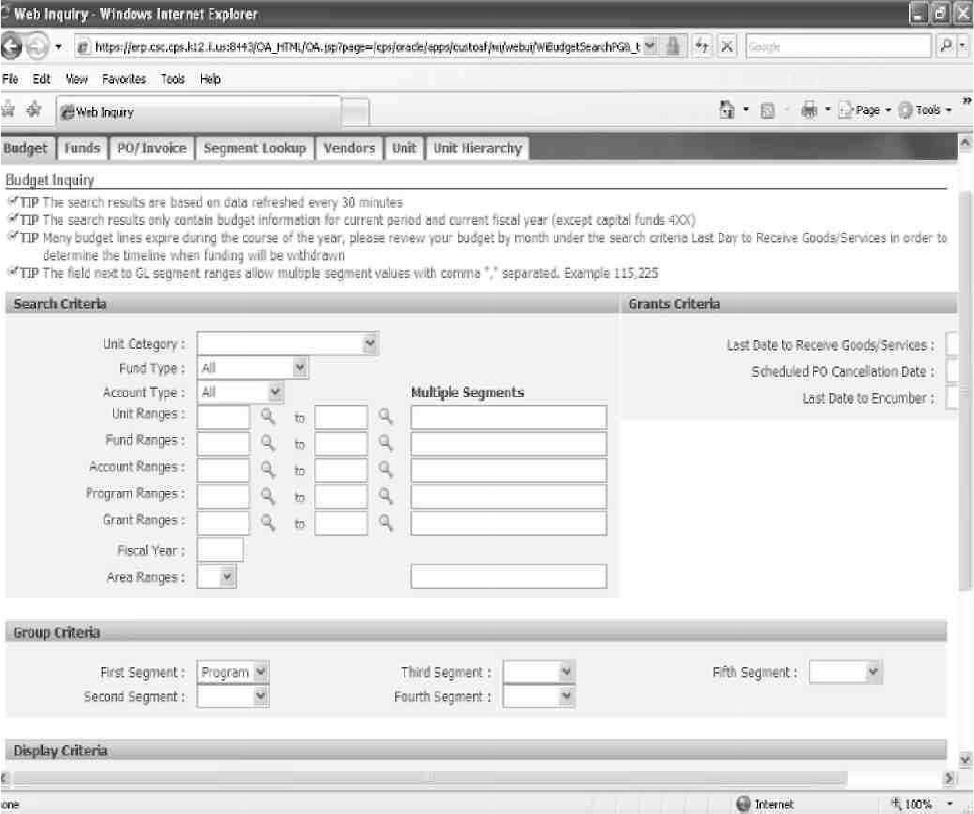
169
The screen below shows the inquiry search criteria and sorting screen.

170
SEGMENT LOOKUP TOOL
The Segment Lookup tool in Oracle provides the budget classification description listing.
It gives description for each fund, account, program and grant number used in the
system. It also provides the Oracle and Legacy numbers associated.
The report below is an example of a listing that selected for programs associated with
high schools.
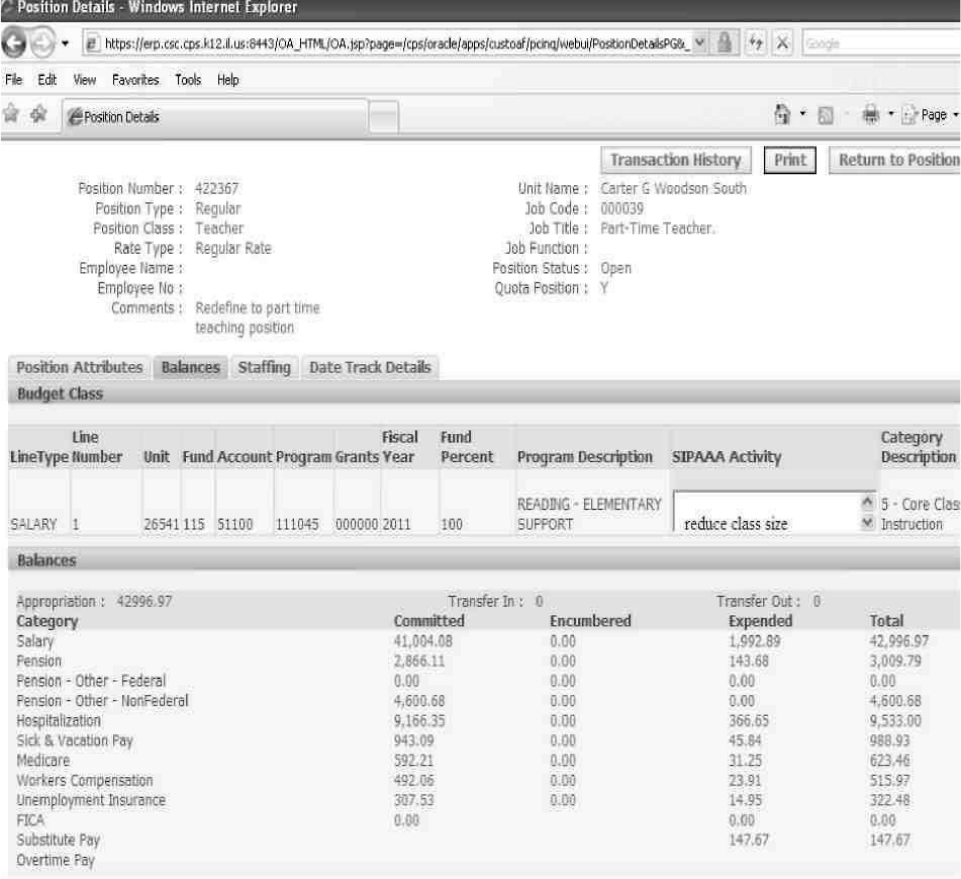
171
POSITION REPORT
Position report contains personnel information for each school. It includes a
comprehensive list of school positions. Detailed information on individual positions is
currently available. The information provided includes: name, budget classification,
committed/encumbered/expended funds against the position number, job code,
scheduled time, open/close dates, etc.
A sample report can be requested for your school. The principal should contact the
Business Service Center for more information on how to run reports and receive
detailed information.
The screen shot below shows some of the information available on an individual
position.
172
FUNDRAISING GUIDELINES
For ease of distinguishing what procedures and guidelines are applicable to
different fundraising activities, the following breakdown by section has been
provided:
Category 1: Fundraising conducted independently by the school
•
Continuous Fundraising Activities and Concession Sales
•
Photographs
•
School Book Fairs
Category 2: Fundraising for the school conducted by the school and a registered external
not-for-profit organization where all net proceeds are for the school
Category 3: Fundraising conducted by the school and a registered external not-
for- profit organization where profits are shared
Category 4: Fundraising conducted exclusively by the registered external not-
for- profit organization that benefits the school or its own
organization
Category 5: Fundraising conducted exclusively for catastrophe victims or other
designated not-for-profit organizations
Category 6: Local School Council Fundraising
173
Category 1. Fundraising Conducted Independently by the School
An entire school or formal group of students with a faculty sponsor has the option of
hosting fundraising activities for school-related events. Such fundraising activities
should benefit the student body in the same school year the funds are collected.
Basic Steps for Conducting a Fundraiser
These procedures present the basic steps that should be followed when conducting
any school fundraising activity regardless of whether this activity is independently
conducted, held jointly with another organization, or sponsored by the LSC. Later
subsections explain in greater detail how these procedures change slightly to
accommodate specific fundraising situations.
Step 1 Prepare a Local School Fundraising Accounting Proposal/Agreement
•
Prior to commencing the fundraising activity, the Local School Fundraising
Accounting Proposal/Agreement must be completed and presented to the
Principal, Network Office, and LSC, if applicable, for approval.
•
The faculty member designated as the sponsor of the fundraising event should
prepare this proposal.
•
Required copies of the Local School Fundraising Accounting
Proposal/Agreement must be maintained at the school. Another copy must be
sent to the Network Office for final approval prior to the activity.
•
It is suggested to get LSC approval since they are required to approve any
disbursement of $1000 or more for elementary schools and $2,500 for high
schools.
Step 2 Complete a School Expenditure and Requisition Order form for
purchasing sale items
•
Upon receiving approval(s) to sponsor the fundraiser, the fundraising group must
complete the appropriate School Expenditure Requisition Order. This form
should be presented to the School Treasurer regarding the items to be sold.
•
Prior to delivery, adequate physical safekeeping must be arranged for all goods
ordered.
Step 3 Obtain products for sale
•
All purchases of goods for sale must meet the guidelines for disbursements
through Internal Accounts.
•
Expenditures for purchases must be made based on a detailed receipt from the
vendor. (Please refer to Section 9 for specific payment guidelines.)
•
When possible, money for the fundraising merchandise should be collected prior
to the delivery of the goods in order to lessen the expense of unaccounted
merchandise.
Often merchandise is unaccounted for when it is purchased prior to collecting the
money for its expense.
174
Step 4 Conduct sale and deposit collections with School Treasurer
•
The record of inventory and sales for fundraising activities must be maintained on the
Concession Sales Accounting Report. (Please refer to the Appendix for a copy of the
Concession Sales Accounting Report).
•
All collections from the sale must be submitted to the School Treasurer on the day of
collection.
•
Any event that prevents the teacher/sponsor from submitting the receipts to the School
Treasurer on the day of collection must be explained in writing.
•
All collections must be receipted and recorded in a category specific to the fundraising
activity Account series 25XXX.
•
For all fundraising activities, it is mandatory that an accurate record of all funds
generated be maintained in the school’s Internal Accounts.
Step 5 Finish sale and prepare the final accounting reports
•
Within 10 school days of the last date of the fundraising activity, the School
Treasurer must submit to the Network Office a completed Local School Fundraisi
ng
Accounting Report and the Concession Sales Accounting Report. These reports
give an appropriate accounting record along with an inventory of any remaining items.
The activity sponsor completes the reports.
•
All missing inventory items must be explained in a written statement signed by the
Principal and activity sponsor and attached to the Local School Fundraisi
ng
Accounting Report.
•
All funds generated from the fundraising activity should be deposited in the appropriate
fundraising account.
•
The School Treasurer must verify the ending inventory, the sales receipt and
expenditures for the event.
•
An original copy of the Local School Fundraising Accounting Report and the
Concession Sales Accounting Report must be maintained at the school.
•
Any significant discrepancies must be reported to the Chief of Schools for review and
possible action.
•
Remember to always complete a Local School Fundraising Accounting Report and
Concession Sales Accounting Report at the completion of each fundraiser. Keep all
documentation for school records.
Step 6 Transfer profits to activity accounts
•
If proceeds from fundraising are for the sole reason of supporting personnel costs, funds
may be moved from school Internal Accounts into an Oracle Budget line within the
schools’ Fund 124 budget using the IAMS system.
•
•
To open Regular Positions, funds should be moved to the following pointer lines:
• Salary: Unit-124-51300-290001-002239
•
Benefits: Unit-124-51330-290001-002239
•
To open Bucket Positions, funds should be moved to the following pointer lines:
• Bucket Appropriation: Unit-124-51320-290001-002239
•
Medicare/FICA*:
Unit-124-51330-290001-002239
*FICA is required for all non-Board Buckets.
•
Positions should be opened using Oracle Position Control. The following
budget line should be used to open positions:
•
Unit-124-Account-Program-002239
175
Continuous Fundraising Activities and Concession Sales
•
A school may conduct its fundraising through continuous sales such as vending
machine usage or concession sales at school-related events.
•
Requirements for a continuous sale are the same as the one-time sale with
a few exceptions.
•
Because the fundraising activity is continuous, a fundraising proposal must be
submitted and approved before the beginning of the activity.
•
Schools must adhere to the basic fundraising steps in addition to the following
steps when conducting continuous fundraising activities:
Deposit all collections with the School Treasurer on a daily basis
The Concession Sales must be completed and turned into the School Treasurer at
least two times per year, preferably November and May.
Maintain a Perpetual Inventory Card
In order to maintain control over inventory for continuous sales, Perpetual
Inventory Cards are required along with the Concession Sales Accounting
Report. Perpetual inventory Cards should be updated as inventory changes.
What if discrepancies between sales and receipts occur?
All discrepancies must be documented on the accounting form. If unexplained
discrepancies occur, a report must be made to the LSC and the Network Office.
Depending on the situation, appropriate action will be taken (such as an investigation
by the Inspector General to determine if criminal activity took place that require
restitution by individuals involved or disciplinary procedures).
Fundraisers involving all school students are considered school fundraisers.
The school is completely responsible for the fundraiser and collects all funds.
However, external organizations can assist.

176
Photographs
School picture taking is an annual tradition many schools use as an opportunity to
raise funds. Typically, the school and the photographer agree on the photographer’s
costs, with the school receiving a percentage of the gross sales covered in the
contract. LSC approval is required. Schools are not required to complete a Local
School Fundraising Accounting Proposal/Agreement for school pictures.
All funds collected for school pictures must be recorded in the school’s
Internal Accounts. This requires school personnel to accompany the photographer’s
staff in collecting photography fees in order to ensure that the amount of fees
collected is recorded accurately. The school is responsible for depositing the fees
collected in the school’s Internal Accounts. The school must retain the fees
collected until the product (i.e., the school pictures) is delivered to the students
and a proper invoice is submitted.
Once the product has been received, the school retains its percentage of the sales
revenue and remits to the photographer the proper percentage of the fees collected.
The school should not submit the total amount of fees collected to the photographer
before the product is delivered. Doing so gives the school little recourse for
guaranteeing the product is delivered in full and in a timely manner.
All schools must adhere to the following guidelines when taking school pictures:
•
The school is responsible for the money collected if the photographer fails to
produce the pictures.
•
The most important thing to do when conducting a photography sale is to be
comfortable with the expenses paid to the photographer.
•
Obtaining detailed invoices from the photographer and comparing that to the
anticipated participation by the students will assist analysis.
Schools must adhere to the basic fundraising steps and the following steps
when conducting photograph fundraising activities.
Schools are encouraged to competitively bid photography services each year
to ensure competitive prices.
Obtain a minimum of three (3) written Bid/Proposals from photographers.
Award the contract and obtain a signed Local School Fundraising
Accounting Proposal/Agreement.
All contracts must be approved by the LSC. A contract may not be entered into for
more than one year. Specifically, the agreement should include the following:
•
A detailed description of the fees being charged by the photographer;
•
The percentage of sales the school will receive;
•
Wording that states the school will retain the collection of student fees in its
account until the photographer has delivered the product;
•
Expectations if product is late or does not meet reasonable standards.
177
Use a Teachers Receipt or alternative receipt provided by the photographer
to record collections from students
Deposit all collections with the Treasurer to record in the Internal Accounts
•
The school should not remit any portion of the collections to the
photographer until the pictures are delivered and a proper invoice is
submitted.
•
The school must establish a sub-account in the Internal Accounts
for the photography collections.
Pay photographer
Payment to the photographer should be made based only from a detailed
invoice provided by the photographer.
The school should handle any dispute with the photographer. If disputes
cannot be resolved, please contact the Bureau of Purchasing at 553-2280.

178
School Book Sales and Fairs
Distinguishing Fundraising from Non-Fundraising Book Sales and Fairs
Fundraising activity can be defined as a planned event where goods and or
services are offered at a price that will provide a profit. Examples of a for-profit
event and a not-for- profit event are:
•
Fundraising - Book Fair
Books are obtained and sold and the school takes a cash profit
(percentage of sales submitted to the book provider) or takes product
(all of the proceeds from sales are submitted to the book provider).
•
Non-Fundraising - Book Fair
Books are obtained and sold on a buy-one-get-one-free basis (all of
the sale proceeds are submitted to the book provider).
Opportunities for fundraising partnerships exist with many of CPS’s book
vendors. The typical arrangement relies on the vendor being able to set up a
display of their merchandise on school property where school volunteers or
staff manages sales to students and parents. Prior to commencing the
fundraising activity, the Local School Fundraising Accounting
Proposal/Agreement must be completed and approved.
It is important to remember that sales to a parent or a student are not tax
exempt. The school is tax exempt when it comes to making purchases for
official use.
However in this transaction, the taxpayer or buyer must pay the purchase
price plus sales tax, which is collected by the school and submitted to the
book vendor who in turn reports the sales and pays the Illinois Department of
Revenue. The only sales that would be exempt would be purchases for the
school library or classroom; items purchased by school employees for home
use are also not tax exempt.
As you plan for your book sales or fair, please be sure to maintain a secure
environment for the merchandise. Collections should be deposited into the
Internal Accounts. Good record keeping is a must.
179
Category 2. Fundraising for the School Conducted by the School and an
External Not-for-Profit Organization Where All Net Proceeds are for the
School
Schools have the option of hosting a fundraising activity with an external
organization. External organizations cannot sponsor continuous fundraising
activities such as the school store or other year-round sales.
The Illinois School Code mandates the school board to establish rules and
regulations governing conditions under which schools and associations may
solicit funds on behalf of the school.
Requirements for the External Organization:
•
Must be registered with the Attorney General.
•
Must submit information (the name of the organization and the name, address and
phone number of the organization’s officers) to the school that will allow the
principal to verify the registration with the Attorney General’s office.
•
Must complete, sign and submit the Local School Fundraiser Agreement/Proposal
(upon verification).
Approval of the Principal, LSC and Network Chief is required.
•
Must submit all of the proceeds to the school.
•
Checks written to the external organization should be deposited into that
organization’s account. And, a settlement of the proceeds must be accounted for
at the end of the fundraiser.
•
If the school is in charge of the fundraiser, the school must complete all
required fundraising forms.
External organizations not registered with the Attorney General may raise
funds for the school; however, the following requirements must be met:
•
Must be a Parent Teacher Organization that is controlled by teachers and parents
of children attending a particular school for which the organization is named.
•
All of the contributions must be turned over to the school.
•
All of the money less cost of raising the funds must remain at the school.
•
Total contribution less cost does not exceed $50,000.00 in any calendar year.
•
All of the forms required by a school sponsored group must be completed by the
parent and teacher group and turned in to the school.

180
Category 3. Fundraising Conducted by the School and a Registered External
Not-for-Profit Organization Where Profits are Shared
In addition to meeting all of the above requirements as a registered
external organization, the division of net proceeds must be specified in
the Fundraising Proposal/Agreement.
NOTE: Fundraising activities involving students are considered
school sponsored activities of which all funds raised belong
to the school.
External organizations cannot sponsor continuous fundraising
activities such as the school store or other year-round sales.
Category 4: Fundraising Conducted Exclusively by the Registered External
Not-for- Profit Organization that Benefits the School or Its Own Organization
External organizations can host a fundraising activity to raise funds for their
organization or for the school. These fundraising activities are underwritten and
managed/conducted by the external organization and do not involve students
at the school. Therefore, the external organization is solely responsible for the
fundraising event.
Requirements for the External Organization if the fundraiser is for the school:
•
Must be registered with the Attorney General.
•
Must submit information (the name of the organization and the name, address and
phone number of the organization’s officers) to the school that will allow the
principal to verify the registration with the Attorney General’s office.
•
Must complete, sign and submit the Local School Fundraiser
Agreement/Proposal.
•
Approval of the Principal, LSC and Network Chief is required.
•
Must submit all of the net proceeds to the school.

181
Requirements for the External Organization if the fundraiser is NOT for the
school:
The external organization is fully accountable for the funds generated, the expenses
incurred and the delivery of goods and services. No activity is recorded in the Internal
Accounts.
Per the Solicitation For Charity Act, no third party should use CPS name or logo, or
school name, colors, etc. without the written permission of the Board. In addition, no
charitable organization or professional fund raiser soliciting contributions shall use a
name, symbol, or statement so closely related to that of CPS that the use thereof
would tend to confuse or mislead the public. Therefore a disclaimer must be added to
the external organizations advertisements stating the funds are not for the direct
benefit of the school.
School approval is only required if the external organization is using school
property. Then, the Principal, LSC and Chief Network Officer must approve.
Category 5: Fundraising Conducted Exclusively for Catastrophe Victims or
Designated Not-for-Profit Organizations
•
Not-for-Profit Organizations Approved by the Board
The Payroll Deductions Campaign Resolution (98-0128-RS8) authorizes
three separate charitable solicitations during the year: the United Negro
College Fund, the Hispanic Scholarship Fund and Combined
Charities. Each of these solicitations has been assigned a separate
and distinct timeframe for its activities so that CPS employees, in
theory, are spared continual requests for charitable giving.
•
Organizations Not Approved by the Board
Schools may solicit funds for catastrophe victims and for other not-for-profit
organization after getting prior approval of the Principal, LSC and Network
Office.
182
Category 6: Local School Council Fundraising
The Policy on Local School Council Fundraising (97-0226-PO2) states that,
“…within certain boundaries, Local School Councils (LSC’s) have the authority to
raise funds at the school which they serve…” for LSC incidental operating and
legitimate educational-related expenses.
All financial activities related to LSC fundraising must be recorded in the
school’s Internal Accounts.
Fundraising for Educational Activities
The LSC can raise funds to purchase school uniforms, band uniforms, band
equipment and items serving other educational purposes for students.
All fundraising activities that are ongoing in nature, such as vending machines and
school supplies cannot be administered by the LSC.
Fundraising for Operating Expenses
•
The value of the fundraising profits generated for LSC operating expenses
shall not exceed a cumulative total of $1,500 per school per fiscal year if the
school population is under 1,000 students. Nor shall it exceed a cumulative
total of $3,000 per school if the school population is 1,000 students or more.
Any excess profits should be transferred to the General Fund.
•
Fundraising funds remaining at the end of the year will rollover to the next
school year. LSCs cannot operate at a deficit. LSC funds may not exceed
above listed amounts.
Note: LSC fundraising budget for fiscal year is reduced by the dollar amount of the
rollover funds.
The LSC is permitted to raise funds for its own operating expenses.
Permissible operating expenses may include:
•
Advertisements for Principal vacancies
•
Stationery and general office supplies
•
Copying/reproduction services and postage
•
Reasonable expenditures for transportation to LSC/school meetings or
workshops
•
Reasonable expenditures for refreshments at meetings
•
Reasonable expenditures for registration fees for workshops, seminars, and
conferences attended by LSC members
183
Impermissible Operating Expenses for which the LSC cannot raise funds for
include:
•
Costs associated with seminars, workshops and conferences other than
registration fees
•
Meals and travel expenses beyond the reasonable expenditures for
transportation to LSC/school meetings or workshop
•
LSC campaign-related expenditures
•
Stipends to LSC members for services rendered
•
Any payments made in violation of the CPS Code of Ethics
Guidelines for Conducting LSC Fundraising Activities
The following procedures must be followed by LSCs when fundraising for
educational activities and incidental operating expenses--The LSC must follow
the same procedures as the school listed in Category1: Fundraising
Conducted Independently by the School.
Sale of School Books
If a sale of books takes place, the school must make sure the books are no longer being
used by CPS schools. The proceeds must be posted in account #21220 Loss/Damaged
to Instructional Materials. These funds can only be used to purchase instructional
materials.
School Raffles
Prior to holding any school raffle, the school must complete an application and
purchase a license from the City of Chicago. A separate application and license is
required for each
raffle. For additional information, please call Department of
Business Affairs & Consumer Protection at 312-744-6249.
Ticket Sales
The School Treasurer is responsible for maintaining physical control of all tickets.
T
his responsibility can be delegated to an administrator as long as the duties are not
assigned to individuals or departments that utilize the tickets. It is a good practice to
have different people collecting the money, selling the tickets, and reconciling the
account. Remember that the primary purpose of tickets is to control admission. All
tickets purchased from an outside firm or printed by the school must be delivered to the
School Treasurer. Tickets for all functions must be pre-numbered.
All tickets and cash receipts received from ticket sales must be accounted for by
using the Ticket Accounting Report. (Please refer to the Appendix for a copy of the
Ticket Accounting Report.)
In addition to following the basic fundraising steps, the following procedures
must be completed when conducting ticket sales for an entertainment/athletic
event.
184
Prepare for ticket sale
Obtain the tickets from the designated ticket custodian. Each group of tickets is
provided to the teacher/sponsor in a numbered sequence. Keep a log that lists each
group of tickets. Teachers must sign the log when they receive their tickets.
Conduct ticket sales
The teacher/sponsor(s) is responsible for maintaining records on how much money is
collected for the event. This can be done by using pre-numbered tickets:
Example: 100 tickets were issued; but 90 tickets were sold at an event.
Each
ticket cost $1.00; therefore, $90.00 must be submitted to the School
Treasurer along with the 10 tickets that were not sold.
In the event of discrepancies or revenue shortfalls, the teacher/sponsor is held
accountable.
Prepare Ticket Accounting Report
•
The teacher/sponsor prepares the Ticket Accounting Report for each activity.
•
The report and any unsold tickets must be delivered to the School Treasurer
immediately after the event. Prepare a statement explaining lost and
unaccounted for tickets. Keep a copy for your records.
The School Treasurer is responsible for verifying the information contained on the
Ticket Accounting Report, reviewing it with the Principal and securing his/her
signature for approval. Any discrepancies/shortages must be clarified and/or
explained in writing and attached to the report prior to its approval. The School
Treasurer must retain on file the original copy of the Ticket Accounting Report as well as
a copy of the Local School Fundraising Accounting Proposal/Agreement with the unsold
tickets. A duplicate copy can be returned to the teacher/sponsor
.
186
Introduction
Chicago is the only major city in the United States in which parent-majority Local
School Councils (LSCs) evaluate their principal’s performance to lay the ground
work for improving their school.
In important ways, Chicago’s LSCs function like the school boards that oversee most
U.S. school districts outside of the nation’s large cities. These school boards usually
choose a superintendent of schools for a limited-year contract and then may choose to
rehire or not to rehire their superintendent. Similarly, because of the 1988 Chicago
School Reform Act passed by the Illinois General Assembly, Chicago’s LSCs choose
principals for four-year contracts and then evaluate their performance during the
contract term.
Contents
The Unique Role of LSCs in Principal Evaluation p. 187
Some Key Considerations for Effective Evaluation p. 188
Overview of the Principal Performance Evaluation Form and Process p. 189
Timeline for LSC Principal Evaluation p. 192
Process for Evaluating Professional Practice p. 193
Building an Effective Principal Evaluation Team p. 194
Organizing the Evaluation Process p. 195
Rating the Competencies p. 196
Determining the Final Rating p. 198
Feedback Session p. 200
Guiding Principles of Good Evaluation p. 204
End of Contract Cumulative Principal Evaluation p. 205
Resources
Appendix A. LSC Principal Evaluation Form p. 208
Appendix B. Principal Evaluation Online Tool p. 220
Appendix C. Sample Calculation for Combining Competency Scores p. 221
into a Final Principal Professional Practice Rating
Appendix D. Process for Including Optional Additional Indicators
p. 223
Appendix E. Legal Requirements for Principal Evaluation p. 224
Appendix F. Confidentiality Agreement and Code of Conduct for p. 225
Principal Evaluation
Appendix G. Principal Performance Evaluation Support Materials p. 226
Appendix H. The Cumulative Evaluation p. 228
Each item in the Contents is linked to the page listed for that topic.
Click on the title and you will get directly to that page.
187
The Unique Role of LSCs in Principal Evaluation
Hiring and evaluating your school’s principal is a unique opportunity and responsibility.
Research consistently shows that the principal’s leadership is the single most critical
force that shapes all aspects of your schools’ effectiveness.
Principals who are hired by an LSC are “contracted;” that is, they sign a four-year
contract. One of the provisions in the principal’s contract is that he/she will be
evaluated by the LSC. The contract states that “The evaluation shall be in writing in a
form prescribed by the Board of Education, which includes the following criteria:
1.
Student academic improvement
2.
Student absenteeism
3.
Instructional leadership
4.
The effective implementation of programs, policies, or strategies to
improve student academic achievement
5. School management
6. Any factors deemed relevant by the local school council…” (Section IV.A.)
Two Types of Principal Evaluations
Local School Councils must carry out two different types of evaluation of their principals:
Annual Principal Evaluation
The year-long process of annual principal evaluation is carried out during each of the
four years of the principal’s contract. Its key purposes are to monitor the principal’s
performance, to advise and assist the principal as he or she carries out key duties
during the year, and to take stock of the principal’s performance at the end of the year.
The Network Chief also conducts an annual evaluation of each principal. The LSC may
request a copy of this annual evaluation from the Network Chief. If the Network Chief
does not respond to the request, the LSC may contact the Office of LSC Relations.
End-of-Contract (Cumulative) Evaluation
The end-of-contract (cumulative) evaluation is carried out during the third to sixth
month of final year of the contract and must be completed and the principal notified of
the evaluation and the renewal/nonrenewal decision no later than 150 days before the
end of the contract. If the contract ends June 30 (as most do) then the evaluation is
carried out in the fall and winter of the principal’s final contract year. The cumulative
evaluation must be completed prior to the LSC voting on the renewal of the contract
The cumulative evaluation also helps the LSC and principal to evaluate strengths
and weaknesses of the school’s progress over three-and-a-half years, as the basis
for planning future priorities for improving the school.
The cumulative evaluation, which must be approved in an open session, will become
key evidence if you decide not to renew your principal’s contract and he or she
requests an arbitration hearing. Careful evaluation processes are essential to a
successful defense of your decision.

188
Some Key Considerations for Effective Evaluation
For both types of principal evaluation, there are common approaches and
practices for effective evaluation.
These three overlapping circles represent the basic foundations for an effective
principal evaluation.
Your LSC should base principal evaluation on
•
research about effective principals and effective principal evaluation.
•
your local school priorities for a better school and an effective principal.
•
laws and policies governing annual principal performance evaluation and the
cumulative principal evaluation. Principal evaluation is both a legal and contractual
obligation of the LSC.
Research about
effective principals and
effective principal
evaluation procedures
Laws and policies
governing Principal
Evaluation
Local School
priorities for a good
principal and a
better school
189
Overview of the Principal Performance
Evaluation Form and Process
Under the Illinois School Code, Local School Councils (LSCs) evaluate principals
every year using the Board-approved principal evaluation form. On July 22, 2015, the
Board approved the current LSC Principal Evaluation Form for use by LSCs beginning
with that school year. This Local School Council Reference Guide chapter provides
details explaining this form, evaluation criteria and timelines. Note that the LSC
Principal Evaluation Form is aligned to the multiple measures used by the CEO/
Network Chiefs to annually evaluate principals.
Under the Principal Evaluation Form the LSC will evaluate the principal in two key
categories:
1.
Professional Practice (weighted at 50% of the final rating) and
2.
Student Growth and Other Measures (weighted at 50% of the final rating).
The first component of the evaluation assesses Professional Practice and is
determined based on the LSC’s interactions with the principal throughout the school
year including observations of the principal’s work with students, staff, families and
community. The LSC will rate the principal’s professional practice on each of the
following five competencies:
•
Continuous Improvement and School Vision
•
Professional Learning Systems
•
College & Career Readiness
•
Family & Community Engagement
•
Self-Disciplined Thinking
The second component of the evaluation assesses Student Growth and Other
Measures and is determined based on the school’s student performance data provided
to the LSC by the CPS Department of School Quality Measurement. This data
includes various student growth and other measures aligned to the Board’s School
Quality Rating Policy (SQRP) including:
•
Student Growth on District Assessments
•
Attendance
•
Progress Toward Graduation
•
Early College and Career Credentials
The LSC will then combine their Professional Practice Score, the Student Growth
and other Measures Score, together with an Additional Indicators value (if additional
goals were established) to determine a Final Summative Principal Evaluation Rating.
The LSC will determine a Final Summative Principal Evaluation Rating of either
Unsatisfactory, Developing, Proficient, or Excellent based on the combined score.
Note that the final performance level rating legend used by LSCs is the same
performance levels rating legend issued by the CEO/Network Chiefs when
evaluating principals.
190
Summary of Key Aspects of the Evaluation Form
1.
The LSC Principal Evaluation Form and the CEO’s Principal Evaluation are
aligned. The principal’s performance will be rated based on the same professional
practice competencies, student growth measures and rating level legend by both
the CEO/Network Chiefs and the LSC.
2.
Online Tool – The LSC Principal Evaluation Form will be completed using the
Principal Evaluation Online Tool (PEOT). This online tool will facilitate better
communication between the LSC, the principal and the Office of LSC Relations. The
tool will also support LSCs by (a) allowing the LSC to compile and save evaluation
information throughout the year and come back to it when convenient or needed, (b)
providing timelines and reminders for completing the annual principal evaluation, and (c)
providing easy access to their prior evaluations for use in determining a cumulative rating as
a principal’s contract is ending.
3.
Principal Professional Practice Competencies - The LSC Principal Evaluation form
evaluates the principal based on 5 Competencies and 28 key behaviors. Student
Growth and Other Measures -The evaluation form ensures that academic growth
indicators and other student outcomes are important components of the LSC’s annual
evaluation of the principal. The two-phase timeline for completing the evaluation
ensures that LSCs will have student growth and other data to assess in combination
with the principal professional practice portion of the evaluation for the same time
period. Further, the student growth measures and criteria used by LSCs will align with
the same measures used by the CEO/Network Chiefs in their principal evaluation and
by the Board to evaluate school progress under School Quality Rating Policy (SQRP).
4.
The Two-Phase Timeline – Principals will receive a final evaluation rating that
includes student growth and other performance data that come from the same school
year as their principal practice review. In order for this to occur, the evaluation form
will be completed in two phases. Each spring, the LSC will finalize the principal’s
professional practice portion of the evaluation and enter it into PEOT by May 1
st
. If
changes in the evaluation are made after the feedback session, those changes will be
voted on in open session and will be entered into PEOT by May 30
th
. Each Fall, the
LSC will finish their evaluation after receiving the student growth and performance
data for the performance period under review. At that time, the LSC will combine both
components of the evaluation along with any additional indicators, and vote in an
open session to approve a final evaluation rating to the principal by November 1
st
. If a
feedback session results in changes to the evaluation those changes will be approved
in open session and the final rating will be entered into PEOT by November 30
th
.
191
Overview of the LSC Principal Evaluation Process
Step 1: During the Summer and Fall the LSCs will 1) identify a member who will be
responsible for entering information into PEOT 2) review the 5 Competencies and 28
Key Behaviors so all LSC members understand the criteria for evaluating the
principal’s professional practice and 3) identify, if desired, additional indicators that
will be included in the principal’s evaluation. By mutual agreement (agreement
between the LSC and the principal), the LSC establishes additional indicators and
records them by November 1
st
Step 2: Throughout the school year, the LSC meets with the principal to discuss the
evaluation, collects evidence of the principal’s professional practice based on reports
delivered by the principal at LSC meetings and observations at school and school
events.
Step 3: At the end of the school year (by May 1
st
), the LSC rates the principal on the
applicable 28 Key Behaviors on the LSC Principal Evaluation Form to establish a
professional practice rating. An optional feedback session may occur during the
month of May. If, on the basis of the Feedback Session, there is a revision in the
Final Principal Professional Practice Scores and Ratings, these are recorded in PEOT
by May 30
th
. The LSC must vote in an open session on the evaluation scores and
ratings before the information is entered into the PEOT.
Step 4: Over the summer, the CPS Department of School Quality Measurement
tabulates the Student Growth and Other Measures data based on the
performance/testing results from the school’s assessments and other measures and
creates a report of this data for the LSC. LSCs will be notified when this report is
available in PEOT to view in the Fall. Note, that for LSC convenience, PEOT will
automatically score the school’s data for each measurement based on the school’s
performance as well as tabulate the combined score of all Student Growth and Other
Measures.
Step 5: After the Student Growth and Other Measures data and reports are released,
LSCs will review this data and the automated scoring in order to complete their annual
evaluation of the principal. The LSC should consider both the Student Growth data
and results together with their already completed Professional Practice rating plus any
additional indicators. The LSC will then arrive at a decision on the Final Summative
Principal Evaluation Rating, enter it into PEOT and share it with the principal by
November 1
st
. The LSC may conduct an optional Feedback Session once a rating is
generated. The LSC may vote to revise their rating on the basis of the Feedback
Session. If the rating is revised, it must be voted on in an open session and if
approved, entered into PEOT by November 30t
h
. The final evaluation must be
approved by a majority of the serving members of the LSC.

192
Timeline for LSC Principal Evaluation
October –
November
Completed the final evaluation including the Student Growth and Other measures for the
Prior Year
• LSC reviews the Student Growth and Other measures and votes in open
session on the final evaluation to complete the evaluation from the prior school
year. Results entered into PEOT by November 1
st
• Hold optional Feedback session and revise evaluation if needed. Vote on any
revisions in open session and enter changes by November 30
th
.
October -
March
Define Performance Expectations
•
Local School Council (LSC) and principal review and discuss evaluation, including
Professional Practice results from previous year.
•
By mutual agreement, LSC establishes additional indicators (optional) and records
them by November 1
st
.
Monitor Professional Practice for the Current Year
•
LSC collects evidence of Professional Practice based on reports delivered at monthly
meetings and observations at school and
school events.
April
Determine Preliminary Professional Practice Scores
•
LSC members meet in closed session to discuss preliminary ratings for Key Behaviors.
LSC scores the principal’s performance on each Key Behavior for each competency (A–E).
This occurs before the open session vote.
•
The LSC votes in open session to approve the evaluation which must be given to the
principal by May 1
st
.
•
LSC and principal set date for optional feedback session.
May
Conduct Feedback Session
•
LSC shares preliminary ratings with the Principal in PEOT at least 48 hours before feedback
session. LSC and principal meet for feedback session on Professional Practice in a closed
session. The LSC may modify Key Behavior Scores and/or Competency Scores followi
ng
this conversation. The feedback session must take place by the end of May.
Finalize Professional Practice Scores
•
LSC votes to approve final competency scores for Professional Practice in an open
session only if the LSC has changed the approved earlier Principal Professional Practice
Scores and Ratings.
•
LSC chairperson or designee enters final competency scores into PEOT by May 30
th
.
•
LSC shares final Professional Practice scores with principal and network chief by May 30
th
.
October
Add Student Growth and Other Measures Scores Determine Final Evaluation Score
•
Department of Student Growth and Other Measurement sends Student Growth Report to LSC
(see Appendix F).
•
LSC chairperson (or designee) inputs Student Growth data into PEOT (see Appendix G).
•
LSC meets in closed session to decide the Final Summative Principal Evaluation Rating by
combining the Principal Professional Practice Score (completed in the Spring) together with
the Student Growth and Other Measures Score and the principal’s performance on any
additional indicators. The LSC votes in open session on the final evaluation.
•
LSC chairperson or designee enters the Final Summative Principal Evaluation Rating and any
comments into PEOT by November 1st
•
LSC chairperson shares final evaluation rating with Principal by November 1st . If the rating is
revised based on a Feedback Session, the final evaluation is voted on in an open session and
entered into PEOT and submitted to the Principal and CEO by November 30th .

193
Process for Evaluating Professional Practice
The LSC will annually evaluate the principal’s professional practice by assessing the
same five competencies that the Network Chief uses to evaluate the principal. The
principal’s score in this area totals 50% of the principal’s overall evaluation rating. This
table lists the five professional practice competencies you will evaluate along with the
corresponding weight they are given in the Professional Practices Evaluation Score.
Competency
Weighted Percentage of Overall
Evaluation Score
Competency A: Continuous Improvement
and School Vision
25%
Competency B: Powerful Learning
Systems
25%
Competency C: College & Career
Readiness
20%
Competency D: Family & Community
Engagement
20%
Competency E: Self-Disciplined Thinking
10%
The LSC will complete the following steps to evaluate the principal’s professional practice:
1.
Collect Evidence - Local School Council members will collect evidence of a
principal’s professional practice based on interactions at meetings and
observations of the principal’s work in the school and in the community. A
principal delivers reports at each LSC meeting. These reports are a crucial
opportunity for LSC members to understand the principal’s practice and to ask
questions to obtain additional information. LSCs should consider the five
competencies when planning the monthly agenda. There is more information
on collecting evidence in Appendix G.
2.
Decide Rating - The LSC shall rate the principal on each competency based
on a principal’s performance on the 28 Key Behaviors identified in the
evaluation form (Appendix A). Note: Only 26 Key Behaviors are rated for
elementary schools and 27 Key Behaviors are rated for high schools. The LSC
is charged with evaluating the principal’s fulfillment of each Key Behavior
throughout the school year and assigning a score. The scores given to each of
the Key Behaviors within a Competency are totaled for a combined score in
each Competency.
194
Benefits of Using Behavior-Based Rating Scales Include:
•
Provides a way to measure performance based on behavior.
•
Anchors performance in concrete behaviors.
•
Provides a way to discuss performance in a more objective way.
•
Enables the LSCs to calculate more precise ratings because they are evidenced
based
Building an Effective Principal Evaluation Team
For either the annual evaluation or cumulative evaluation, there are several different
ways that your LSC can organize an effective principal evaluation team. Your preferred
method will depend on the dynamics of your group and how you best reach
consensus. It is important to decide on an evaluation method at the beginning of the
school year because it will determine who will gather information throughout the year
to support the evaluation decisions. Individual members gather information and rate all
the key behaviors and competencies, and the individual ratings are compiled
ü A subcommittee of the LSC gathers information, rates all the key
behaviors and competencies and then bring the ratings back to the
entire LSC for discussion.
ü Subgroups of the LSC are assigned to competencies with which particular
members are most familiar. These subgroups gather information about their
assigned competencies, rate them, and bring them back to the entire LSC for
discussion.
ü Decide whether the LSC Chairperson or designee is responsible for entering
ratings in PEOT.
Suggested Ground Rules for Principal Evaluation Meeting
To make principal evaluation meetings as productive and efficient as possible, your LSC
can agree to a set of ground rules for proceeding effectively. For example:
•
Choose a neutral moderator (who need not be the LSC chairperson) to help the
group arrive at consensus ratings on the competencies.
•
Arrive and start meetings on time.
•
Raise your hand to be recognized when you wish to speak.
•
Ask questions with respect. Speak one at a time, and listen when someone else is
talking.
•
Agree to work through disagreements and stay with the evaluation process from
beginning to end.
•
Stay focused on the principal’s professional development as it impacts overall school
achievement.
•
Encourage participation by all. Encourage others who have not yet spoken to voice
their opinions before those who have already spoken speak again.
•
Be brief, avoid repetition.
•
Respect each other and each other’s points of view and time.
•
Use an LCD projector (if available) to project PEOT and/or print out the
LSC Principal Evaluation form in Appendix A for members to reference.
195
Organizing the Evaluation Process
•
LSC meets in open session to decide on evaluation method (e.g. gathering information and
completing the evaluation form as a council, as a subcommittee or an individual), deci
des
whether to include non-LSC members in the Principal Evaluation Team (who will be limited
to gathering the information and data the LSC will use in the evaluation process), and set
ground rules for conducting the evaluation process (including a calendar).
•
Principal provides monthly updates on activities related to the five competencies as part of
the regular principal's report. The principal and LSC discuss the principal’s progress.
•
LSC monitors the principal’s progress in the competency areas and gathers information to
clarify the evaluation ratings.
•
A member of the LSC principal evaluation team prints copies of the LSC principal evaluation
form to refer to regularly at meetings.
•
Contact your LSC Relations Facilitator to learn best LSC Principal Evaluation practices or to
address questions.
How to Plan the Evaluation Process—Monitor Progress
What are the Different Evaluation Methods?
As already discussed, the LSC should create its Principal Evaluation Team in the way
that it believes will be most effective, based on an analysis of how the LSC has worked
together most effectively in the past.
What is the Calendar of Principal Evaluation Activities?
The LSC should agree on a specific calendar for carrying out the principal evaluation
during the school year.
How Should the Principal Provide a Monthly Update?
It is recommended that the principal provide the LSC with written monthly updates to
help keep the LSC informed about his or her performance throughout the year. This
does not need to be an elaborate report, instead a simple listing of activities, under the
corresponding competencies will work well. This can be a regular part of the principal’s
report. These lists will save time for the principal because the LSC should not have as
many questions to ask during the information-gathering portion of the process.
Since many of the competencies involve how well the principal handles various
types of problems involving relationships among people in the school community (in
addition to tasks completed), LSC members should ask questions for clarification.

196
How Does the LSC go about Gathering Information to Rate the Competencies?
Make sure to review the steps listed below to ensure that you gather the necessary
information to support your evaluation decisions. Leave plenty of time to gather
information. A list of potential support materials appears in (Appendix G).
1.
Decide what information is needed.
2.
Determine who are the best people to gather the information. Members of the
LSC will know different people who will be able to help in the process.
3.
Determine the sources for the information. Evidence of principal achievement in
the Competencies can also be found through:
• Regular interactions with the principal, teachers and other staff,
administrators, students, parents, and community members.
• Documents available at the school or Network Office. Principals are obligated
to make documents available to the LSC. If the LSC has difficulty getting
documents, contact the Network or the Office of Local School Council
Relations at 773-553-1400.
• Data available about your school on the Chicago Public Schools Accountability
website https://cps.edu/performance
• Interview(s) with the principal
• School and classroom visits arranged in cooperation with the principal.
4.
Optional satisfaction surveys developed by the LSC and approved by the CPS
Law Department (call 773-553-1700) may be used. Set a deadline for gathering
the information. This will help ensure that the LSC stays on task and on time.
5.
Organize and review the information.
6.
Arrange a meeting with the principal to discuss any additional questions that the
LSC was unable to answer and give the principal a chance to provide feedback
on the information: (sometimes the principal is the best source of information,
but it is always good to get other perspectives). Plan carefully for this meeting.
One of the best ways to gather information from the principal is to ask behavioral
questions. If there are key behaviors under a specific competency that the LSC is
having a difficult time rating, ask the principal for specific examples of how his
actions demonstrate this behavior on the job. It is most effective to ask about real
examples (omitting names or details that compromise confidentiality):
• Tell me about a time when you effectively...
• What was your role?
• What were the difficulties you faced and how did you overcome them?
• What did you learn from the experience?
• Where did you apply that learning?
Although these questions may sound like an interview, remember that the focus is on
specific examples and stories that show how the principal has demonstrated skill related
to a key behavior or competency. Use all the information gathered to complete the
evaluation form.

197
How does the LSC Approach Rating the Competencies?
LSCs may go about the competency rating process in several different ways. Below is
a list of suggested methods to complete the evaluation process:
• A subcommittee of the LSC gathers information, rates all the competencies
and then brings the ratings back to the entire LSC for discussion.
• Subgroups of the LSC are assigned to competencies with which particular
members are most familiar. These subgroups gather information about their
assigned competencies, rate them, and bring them back to the entire LSC for
discussion.
• Each LSC member rates all key behaviors and competencies independently
and then brings the ratings back to the entire LSC. In a closed session, each
member should share the evidence with other members. The LSC reviews the
individual ratings as a group to reach consensus on one set of ratings. The LSC
should avoid simply averaging the ratings together because averaging will result
in a less meaningful overall rating.
• The LSC as a group discusses each competency and reaches a consensus
on a rating for each competency.
• The ratings need to be voted on during an open session. The LSC
chairperson or designee enters the approved ratings in the Principal
Evaluation Online Tool (PEOT).
Reaching consensus is important so that all members have a voice in the rating
process. Reaching consensus on competency ratings at this point in the process also
helps LSCs to easily achieve the majority vote it needs to approve the evaluation at the
end of the process.
•
Use the key behaviors to help determine the rating on the competency.
•
Make sure the rating can be supported with specific examples that describe the
competency.
•
Avoid rating the competency too high or too low just because the person being
rated is a nice person or a difficult person. Remember, everyone has areas that
can be improved and your responsibility is to improve the school’s effectiveness for
students.
•
When rating the key behaviors, notice if there are certain categories that are
rated much lower than the other(s).

198
How to Determine a Final Combined Professional Practice Score and Rating
1.
The LSC will discuss and determine scores for each of the 28 Key Behaviors.
The LSC will assign a numerical value to each Key Behavior using a 1-4 scale
where 1=Strongly Disagree, 2=Disagree, 3=Agree and 4=Strongly Agree (See
Appendix B). Note that any discussions related to evaluating the principal’s
performance should occur in a closed session meeting in accordance with the
Open Meetings Act.
2.
Once consensus is reached and a vote is taken in an open session, the LSC
chairperson or designee will enter the scores for each Key Behavior in PEOT
and post them by May 1
st
. If changes to ratings occur after an optional
feedback session, post the revised ratings by May 30
th
.
3.
PEOT will automatically tabulate the combined score and performance level
for each competency by adding together the scores entered for each Key
Behavior and dividing by the total number of Key Behaviors listed for that
Competency (See Appendix B).
4.
PEOT will also automatically apply the weights enumerated for each
competency to calculate the final overall Professional Practice score and
rating (See Appendix B).
Ratings are based on the following
range of scores. Rating designations
are applied to each competency as
well as to the combined average
score to determine the principal’s
professional practice rating. Score
Performance
Rating
3.5–4
Excellent
2.5–3.4
Proficient
1.5–2.4
Developing
1-1.4
Unsatisfactory
199
Working Toward Consensus
You can expect that there will be conflicts resulting from differences of opinion and
points of view. Do not quit or back down when things get difficult. Stay in there and
work out the disagreements. The evaluation will be much better as a result. To help
resolve differences of opinions and points-of-view, remember that all assessments
need to be based on observation of principal behavior. The key behaviors are an
important reference point.
If the discussion of the competencies get time consuming and tense, keep these points
in mind:
•
Evaluation should be fair and based on behavior demonstrated by the
principal, not on opinions.
•
Valuable feedback is constructive and very important for the principal to
improve the school and his/her skills.
•
Try to keep the discussion on track.
•
It is important for the LSC to reach consensus on ratings for each
of the five competencies.
After the evaluation is approved by the LSC, a copy of the evaluation must be
provided to the principal by May 1
st
. The principal can then complete a self-
evaluation. The LSC can, but is not required to, revise the evaluation based on an
optional feedback session. An important way to ensure the evaluation is fair is to
conduct a feedback session with principal. The feedback session affords the principal
an opportunity to respond to the evaluation and request revisions in the ratings.
Thereafter, either the LSC or principal may request a feedback session, particularly if
there are differences between the LSC’s evaluation and the principal’s self-evaluation.
After, 1) the LSC reaches consensus on evaluation ratings and completes the
evaluation form and 2) the principal completes his/her self-evaluation, they should
exchange their evaluations in preparation for the feedback session. The exchange
should happen in advance of the feedback session to allow both the principal and
LSC time to review and plan. Comparing the two evaluations provides information
for discussion points during the feedback session.
If the LSC revises the evaluation, it must vote to approve the revision in an open
session.

200
Feedback Session
Prepare for the Feedback Session
The purpose of the feedback session is to discuss the principal professional practice
score/rating and to define expectations for the following school year. After the
feedback session, the LSC will finalize and submit the final principal professional
practice score and rating in PEOT.
During each step of the feedback process, it is important to keep in mind the
principles of constructive feedback.
For LSC Members
The LSC shares the ratings with the Principal in the Principal Evaluation Online Tool
(PEOT) at least 48 hours before the feedback session. The LSC should meet before
the feedback session to decide which members would like to discuss the ratings with
the principal. Having a copy of the principal’s self-evaluation and comparing it with the
LSC evaluation may provide additional information that will be valuable to the LSC. Pay
special attention to:
•
Competencies rated very differently by the principal and the LSC
•
Any competency rated significantly lower than other competencies
•
Factors that the LSC feels were not covered in the evaluation
The LSC should come to the feedback session prepared to:
• Explain their ratings and give examples, in case the principal has questions.
• Give constructive, helpful feedback to the principal on his/her overall
performance this year. For instance, what did they think the principal did
especially well? What areas need improvement next year?
Preparing examples for any competencies that are rated differently by the principal and
LSC in advance of the meeting will make the conversation easier.
In addition to comparing the evaluations, the LSC should decide on 3 to 5 most
important points to discuss with the principal regarding the evaluation. This will help
focus the discussion and prevent it from becoming emotional or heated. It is also
helpful to designate one or two people who will provide the feedback to the principal
during the meeting. The LSC should also come to the feedback session prepared to
discuss priority goals that they would like to see the principal focus on during the next
school year.
The key to a productive
feedback session is good
preparation by both the
LSC and the principal

201
For the Principal
The principal should print a copy of the LSC evaluation of the Preliminary Principal
Professional Practice Score/Rating from the PEOT and use the points listed in the
previous section to compare the two evaluations in preparation for the feedback
session. In addition, the principal should bring questions about any of the LSC’s ratings
and copies of progress reports and any other materials that might be helpful in the
discussion. The principal should also come to the feedback session with some
suggested priority goals of his or her own for the next school year.
Conduct the Feedback Session
While the LSC’S evaluation is the definitive one, the principal may provide additional
information that is valuable to the LSC during the feedback session. The LSC and
principal should discuss the format they would like to use for the discussion, but
outlined below are some recommended guidelines.
Three Key Steps of the Feedback Session
• The LSC and principal discuss each of the competency ratings that contained a
discrepancy between the two evaluations. Both the LSC and principal should be
prepared to give examples to support their ratings.
• The LSC presents the three to five important points that it has prepared.
• The Principal responds.
Principal and LSC meet in closed session to discuss the evaluation within 30 days
of exchanging evaluation forms.
Reminder
The Feedback Session
It is a closed LSC meeting between the
principal and LSC members only, unless
the principal and LSC agree to include
non-LSC members.
If agreed to, it must occur within 30 days
of the LSC submitting its preliminary
principal professional practice score
and/or the final summative score to the
principal.
202
Guidelines for Giving and Receiving Constructive Feedback
If completed, the feedback session can be the most beneficial and most challenging part
of the evaluation process. Done well, it facilitates communication, learning, and
improvement. Done poorly, it can create misunderstanding and resentment.
For LSC Members
Here are some guidelines for giving constructive feedback:
• Be well prepared before the feedback session. Be sure that you have
behavioral examples to support any low ratings you may have. Review the
principal’s self-evaluation and identify areas where your ratings are far apart. Be
prepared to discuss those points.
• Start with positives. Talk about what has worked well during the year and the
principal’s strengths. Focus on behavior, not attitude or feelings.
• When discussing weak areas or areas for improvement, again, focus on
behavior, not attitude or feelings. Identify the behavior and the effect or
consequences of that behavior on the school. Stay as objective as possible.
How would strengthening a behavior help the school? Provide suggestions for
improvement, such as professional development training for school leaders or
finding a mentor.
• Practice giving feedback to your LSC before your meeting with the principal,
and give each other feedback. Give the principal the opportunity to
respond.
• Avoid: blame, anger, and judgments of the person. Be objective about
strengthening the behavior.
• Follow the golden rule, provide feedback to others as you would have
them provide feedback to you!
For Principals
Receiving feedback will make a big difference in how the feedback session
goes. It is challenging to stay objective and not get defensive, particularly
when weaknesses or development areas are being pointed out. Here are
some guidelines for receiving constructive feedback:
Listen to the feedback and reflect back what you have heard. This lets the LSC
know you have heard what they have to say.
Acknowledge what was true about the feedback. Even if you disagree with
the LSC rating on a particular competency, there is always some degree of
truth in the feedback.
If you disagree with a rating or with some piece of feedback, state your own
point-of- view and briefly share information that the LSC may not have had to
clarify your point of view. Focus most of your comments on your own behavior
during the school year.
Create a partnership with your LSC in developing improvement plans for the
upcoming year. The best way to create a positive end of year feedback session is by
having a strong partnership throughout the year.

203
When these steps are completed, the LSC will share the completed form with the
principal and the CEO’s designee by November30
th
using the PEOT.
Reminder
Set a date to approve the final evaluation. The
LSC must take a public vote to approve the
final evaluation before it can enter the final
rating in the PEOT and share it with the
principal and the CEO’s designee
by November 30
th
.
204
Some Guiding Principles for Good Evaluation
•
A good evaluation is fair.
•
A good evaluation supports the principal’s performance. It determines
areas for improvement and provides the LSC with a forum to provide
valuable feedback. This feedback helps the principal focus and plan for
improvement.
•
A good evaluation improves communication between the principal and
LSC. This evaluation process provides an opportunity for sharing
information and discussing principal responsibilities in a clear and well-
defined way.
•
A good evaluation is objective. Do not base your evaluation on personal
characteristics of the principal or any special treatment you receive.
•
A good evaluation is a year-round activity that regularly assesses the
principal’s progress, not a sudden “gotcha” or letter of praise.
Evaluation is not
•
based only on test scores.
•
based on isolated incidents.
•
based on personality conflicts.
•
focused entirely on the negative.
Evaluation Requires the Principal’s On-going Collaboration
Because evaluation is a year-round activity, it requires the on-going cooperation of
your principal to make regular progress reports and to supply data and other
information to the LSC. Your principal should provide monthly updates on progress
concerning the five principal evaluation competencies.
In addition to state law, key provisions of Section II of the “Uniform Principal’s
Performance Contract reinforce your principal’s obligation to collaborate with the
LSC in providing information to the LSC in a timely fashion with respect to CIWP
development, (ii-c), expenditure plan development (ii-f), and internal audits (ii-h).
Further, your principal should provide monthly updates on progress with respect to
the five competencies that are the current focus of LSC’s annual and end-of-contract
principal evaluation, the key priorities of the School Continuous Improvement Work
Plan and the status of the budget.
The principal shall perform faithfully his or her duties and obligations as a member of
the Local School Council at the Attendance Center.
•
The principal shall endeavor to establish clear lines of communication
regarding school goals, accomplishment, practices, and policies with the
Local School Council, parents, and teachers and unless prohibited by law or
Rule of the Board of Education, shall provide to the Local School Council
information necessary for the Local School Council to perform the duties
under the Illinois School Code.
205
Evaluation Starts Early and Sticks to a Calendar
Evaluation cannot be a last-minute process. Start early. Set a calendar and stick to it.
Evaluation Follows a set of Ground Rules
Sample ground rules were highlighted earlier in this chapter.
Evaluation is Aided by High Quality Training and Assistance
The training you complete as a new LSC member should be supplemented by further
high quality training and assistance when you are actually carrying out the principal’s
annual or end- of-contract evaluation.
Evaluation is Facilitated by Filling all LSC Vacancies
An LSC with no vacancies can provide a broader range of perspectives and more
human resources to carry out LSC evaluation responsibilities. Further, an LSC with
vacancies runs the risk of not having a sufficient number of members present to take
crucial votes as the evaluation proceeds.
Completing an Effective End of Contract Cumulative Principal Evaluation
The LSC must complete and approve the end-of-contract cumulative evaluation
before the LSC makes a renewal decision. This evaluation must focus on the same
criteria that are spelled out in the Illinois School Code for both the annual and
cumulative principal evaluation.
While many principles and practices for conducting an effective annual principal
evaluation also apply to the end-of-contract cumulative principal evaluation, there
are some important differences that distinguish the end-of-contract evaluation:
•
The end-of-contract cumulative evaluation covers the roughly three-and-a-
half years between the time the principal began his or her present contract
and time of the evaluation.
•
The end-of-contract evaluation must be completed before the LSC makes a
decision about whether or not to renew the principal’s contract. The decision to
renew or not renew the current principal’s contract must be made in time to
notify the current principal in writing by February 1, for principals whose
contracts expire on June 30. For contracts with other expiration dates, the
principal must be notified about the renewal/nonrenewal decision in writing 150
days before the end of his or her contract.
•
The LSC must complete and approve the end-of-contract cumulative
evaluation; and the evaluation process may take several months. Further, if
the principal’s contract is not renewed, this decision may be subject to
challenge through arbitration. One of the key justifications that an LSC can
offer to support a non-renewal decision is a thorough end- of-contract principal
evaluation.
206
Below, are recommendations for conducting a high-quality, end-of-contract cumulative
evaluation. Steps required by law, CPS policy, or the Uniform Principal’s Performance
Contract contain a “must”. These recommendations and requirements are presented in
the format of a suggested calendar for LSC action. (This calendar assumes that the
principal’s contract expires on June 30th. If a principal’s contract expires on another date,
you can develop a calendar for LSC action based on the fact that the principal must be
notified in writing on whether a new contract will be offered or not 150 days before the
end of his or her contract).
Because of many important similarities between a thorough end-of-contract
evaluation and a thorough annual evaluation, we often refer the reader back to
relevant steps in the description of an effective annual evaluation process, in
explaining how to carry out the end-of-contract evaluation.
The calendar of evets listed below is based on contracts ending June 30
th
. In
parenthesis are the month(s) of
the last year of the contract ifthe contract does not eng
June 30
th
.
September-October (third to fourth month)
•
LSC reviews the principal evaluation criteria and evaluation form for the end-
of contract cumulative evaluation, reviews addenda that the LSC added to the
principal’s contract, and discusses this information with the principal. Refer to
Step 1 of the annual evaluation process for more details. The LSC should
request the following information from the principal:
✓ The School Continuous Improvement Work Plan and school budget for the
last three years.
✓ The Network Chief evaluation report (if available) for each year.
✓ The LSC’s evaluations for the last three years.
✓ Documentation of at least twenty (20) hours per year of professional
development in accordance with his or her administrator’s recertification
plan, which may include but is not limited to attendance at education
workshops, university conferences or other professional seminars and
LSC training.
•
LSC decides how they will structure their principal evaluation. Although the
LSC may choose to carry out their evaluation in several ways (non-LSC
members may assist in developing and disseminating the evaluation.
However, they should neither review the
responses, nor participate in substantive debate or discussions regarding the
principal’s performance or evaluation.)
•
LSC endorses a code of conduct for the process (including
confidentiality, non- discrimination, and compliance with the Open
Meetings Act).
207
•
LSC develops and begins to carry out a calendar of activities for completing
the evaluation, which includes a strategy for gathering several different types
of information for completing the evaluation from various stakeholders in the
school.
•
LSC members participate in training to learn more about how to carry out an
effective end-of-contract evaluation. The LSC may also receive on-going
assistance throughout the entire process.
•
LSC fills any vacancies, so that they are not hindered in taking action while
completing the evaluation.
November (fifth month)
•
LSC completes the data-gathering process to prepare the principal’s end-of-
contract cumulative evaluation.
December (sixth month)
•
LSC must complete the required ratings in the Principal Performance
Evaluation form, with respect to the principal’s performance during the
contract to date (in closed session).
•
LSC must vote to approve the evaluation in open session.
•
LSC must deliver a copy of the evaluation to the principal.
January (seventh month)
•
LSC must vote in open session on a motion to offer the current principal a new
four-year contract. If the motion to offer a new four-year contract fails, the LSC
may vote to begin principal selection. Note, these items must be on the agenda
for a vote to take place on them.
•
The LSC shall, if requested by the principal, provide reasons for its decision
not to renew in writing. This statement of reasons will be important if the
principal requests arbitration. These reasons must be provided at least 128
days before the expiration of the contract.
•
February 1
st
is the deadline for the LSC to deliver notification in writing
regarding the renewal or non-renewal of his or her contract for contracts that
expire on June 30
th
(or the deadline is 150 days before the contract expires,
if the contract has another expiration date)

208
Appendix A: LSC Principal Evaluation Form
LSC Evaluation of the Principal
Principal Name:
School Name:
Rating Period:
Principal Professional Practice
Enter a number for each of the Key Behaviors below using the following scale: 1 = Strongly Disagree; 2 = Disagree; 3 = Agree; 4 = Strongly Agree.
Competency A: Champions Teacher and Staff Excellence Through a Focus on Continuous Improvement to Develop and Achieve
the Vision of High Expectations for All Students
Key Behavior
Score (1-4)
Standard A1: Develops, implements, and monitors the outcomes of the Continuous Improvement Work Plan (CIWP) and school-wide student
achievement data results to improve student achievement
1
Identifies a diverse CIWP team (6-15 members including parents, teachers, school staff, and community
leaders including LSC or PAC members) and involves them in the CIWP planning process
2
Provides timely updates on progress toward CIWP benchmarks to LSC

209
Standard A2: Creates a continuous improvement cycle that uses multiple forms of data and student work samples to support individual, team, and
school-wide improvement goals, identify and address areas of improvement, and celebrate success
3
Delegates responsibility and empowers teams in the work of the school; and clearly communicates
expectations and timelines (examples of teams can include ILT, Grade-Level Teams, Professional Problems
Committee, etc.)
Standard A3: Collaborates with staff to allocate personnel, time, material, and adult learning resources appropriately to achieve the CIWP targets
4
Maximizes existing school and district resources in order to support the achievement of CIWP priorities
5
Provides LSC with budget and internal accounts reports on a regular basis
Standard A4: Creates a safe and orderly environment
6
Creates a safe and orderly environment (e.g., train staff on School Safety Plan, ensure orderly and timely start
to school day, ensure orderly transitions between classes or during dismissal)
After you have assessed each Key Behavior, add the points and divide the total by 6 to get the Competency Score.
Competency A Score: Rounded to the nearest tenth (Between 1.0 and 4.0) ____________
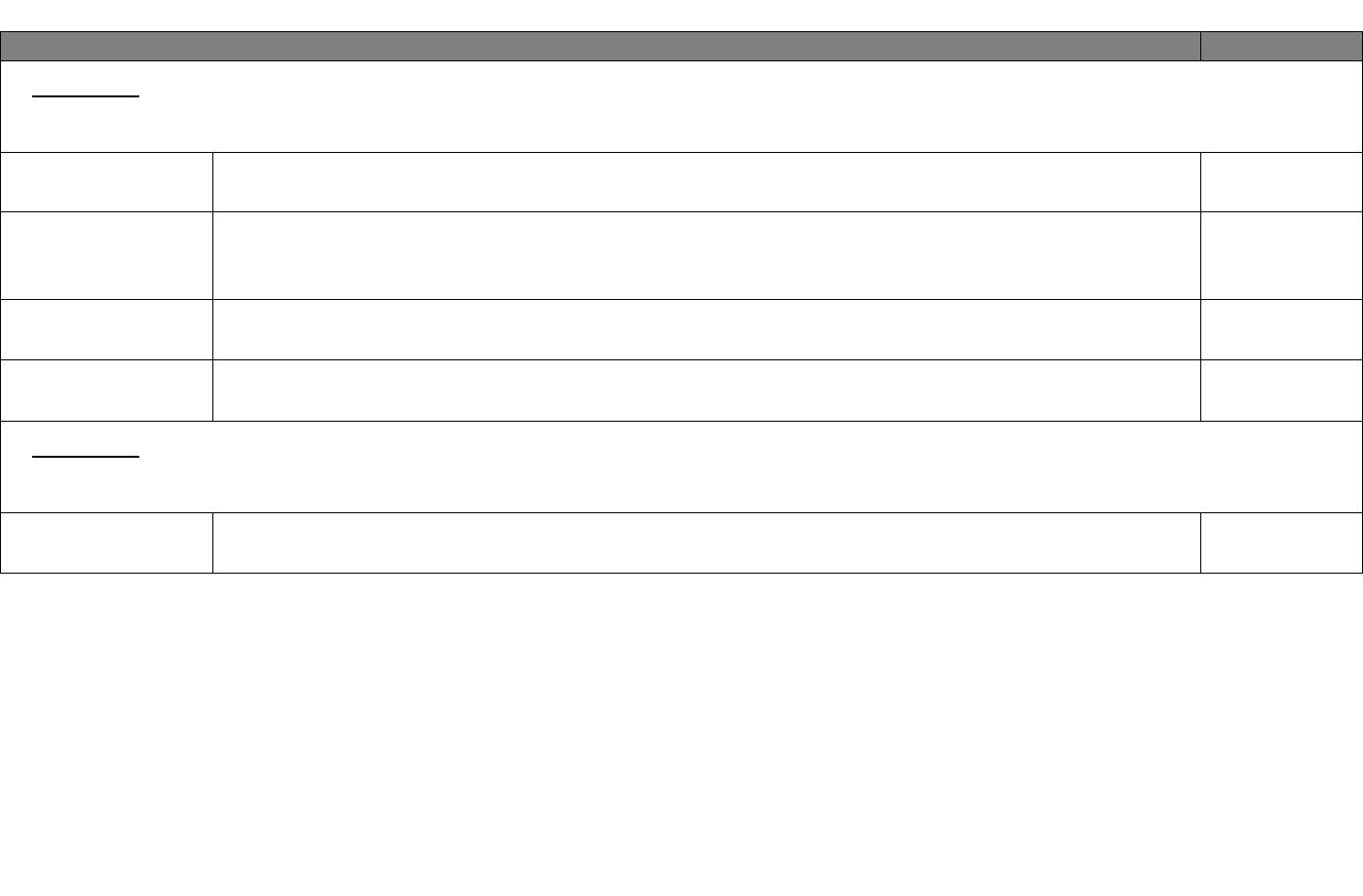
210
Competency B: Creates Powerful Professional Learning Systems to Guaranteee Learning for All Students
Key Behavior
Score (1-4)
Standard B1: Works with and engages staff in the development and continuous refinement of a shared vision for effective teaching and learning by
implementing a standards-based curriculum relevant to student needs and interests, research-based effective practice, academic rigor, and high
expectations for student performance in every classroom
1
Ensures curricular plans are driven by Common Core State Standards (CCSS) and implemented consistently
2
Coordinates curriculum planning between educators within and across grade levels, including educators
serving English language learners and students with disabilities to ensure alignment and consistency
3
Ensures that English language learners and students with disabilities have access to quality instruction
delivered by qualified teachers and are having learning needs met
4
Provides professional development, instructional coaching, and other resources to support teachers
implementing curriculum aligned to Common Core State Standards
Standard B2: Evaluates the effectiveness of teaching and holds individual teachers accountable for meeting their goals by conducting frequent formal
and informal observations in order to provide timely written feedback on instruction, preparation, and classroom environment as a part of REACH
Students
5
Regularly observes teaching practice and provides timely and constructive feedback about instruction,
preparation, and classroom environment grounded in CPS Framework for Teaching
After you have assessed each Key Behavior, add the points and divide the total by 5 to get the Competency Score.
Competency B Score: Rounded to the nearest tenth (Between 1.0 and 4.0) ____________
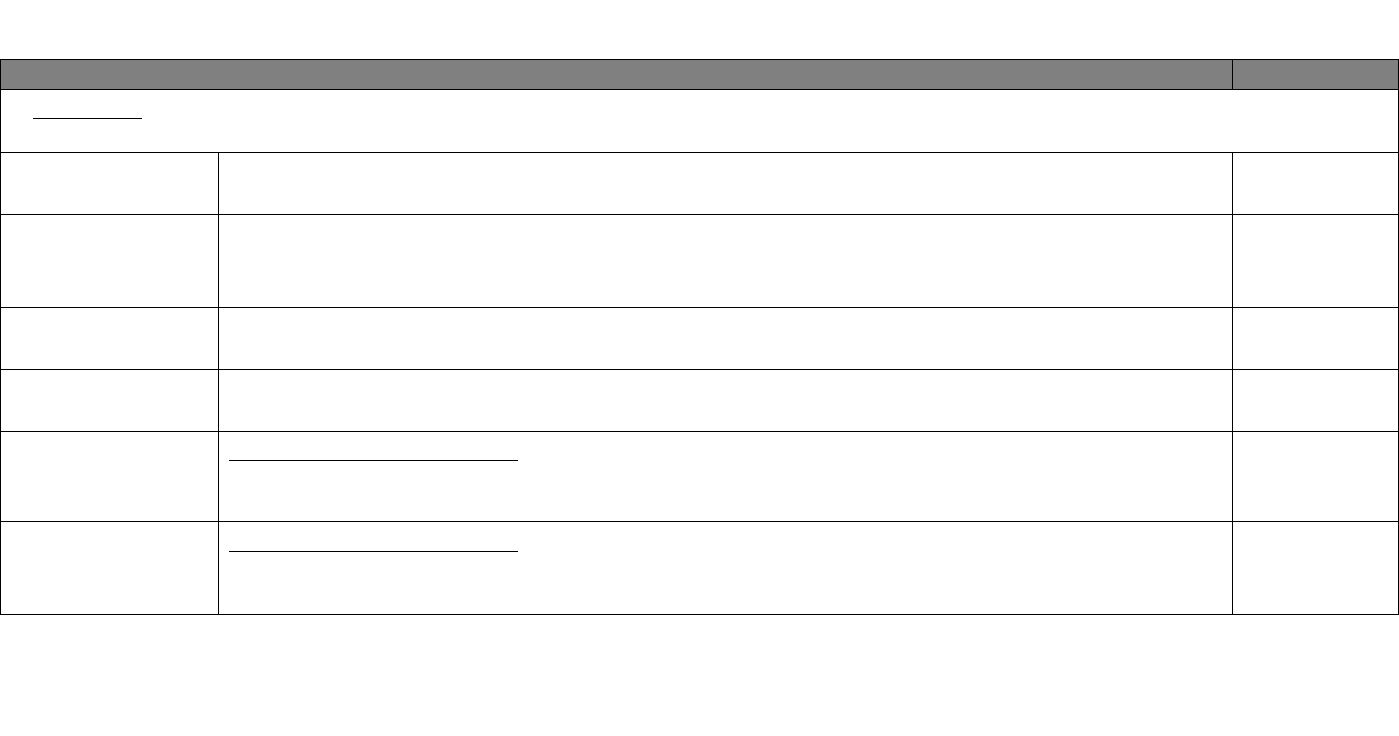
211
Competency C: Builds a Culture Focused on College and Career Readiness
Key Behavior
Score (1-4)
Standard C1: Leads a school culture and environment that successfully develops the full range of students' learning capacities, creative, social-
emotional, behavioral, and physical
1
Exposes all students to college and career experiences that are linked to students' aspirations (e.g., college
visits, job shadowing, internships, Career Day, etc.)
2
Works with staff to define and implement a process requiring students to create both short and long term
academic and social-emotional goals (e.g., student portfolios, progress tracking, goal sheets, surveys, etc.)
3
Reviews and monitors Student Code of Conduct to ensure a supportive discipline model, emphasizing
corrective and restorative responses before moving to out-of-school suspensions (as appropriate)
4
Ensures all students have equitable access to rigorous and enriching curriculum beyond basic literacy and
numeracy (e.g., science, arts, etc)
5
For High School Principals Only: Enables students to earn Early College and Career Credentials (e.g., Advanced
Placement, International Baccalaureate, Dual Credit, Dual Enrollment, and/or Career and Technical
Certification)
6
For High School Principals Only: Provides support for college enrollment and attendance (e.g., FAFSA
completion, college match counseling, college applications, and counseling in the summer following
graduation)
After you have assessed each Key Behavior, add the points and divide the total by 4 (ES) or 6 (HS or K-12) to get the Competency Score.
Competency C Score: Rounded to the nearest tenth (Between 1.0 and 4.0) ____________
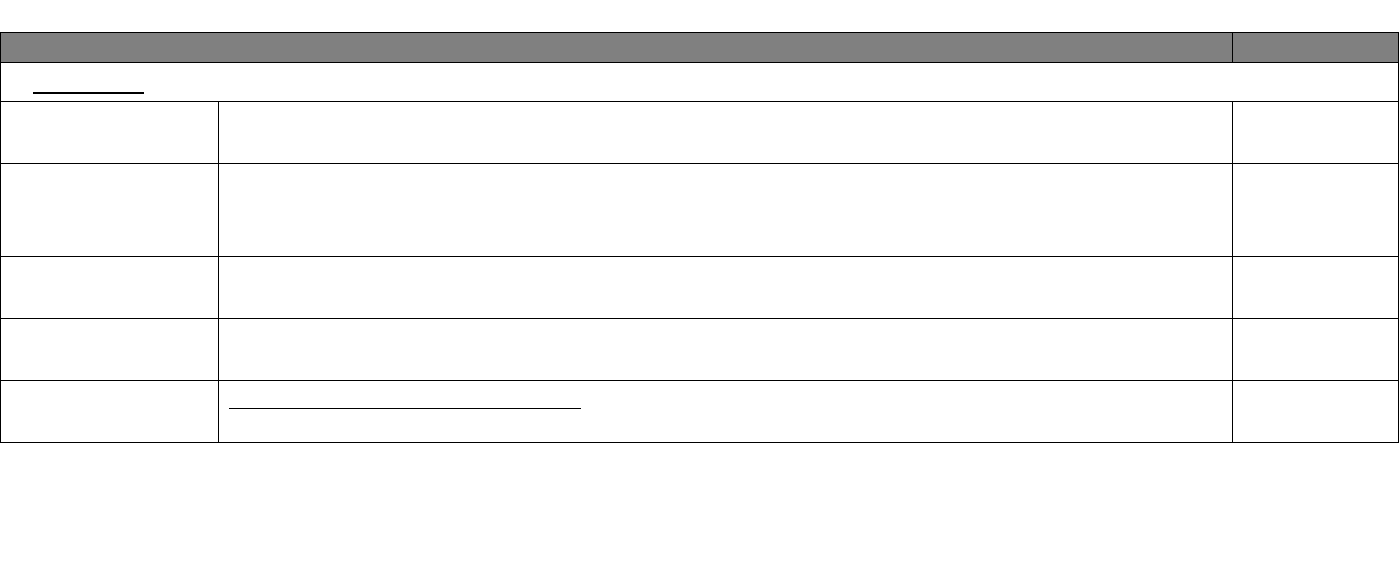
212
Competency D: Empowers and Motivates Families and the Community to Become Engaged
Key Behavior
Score (1-4)
Standard D1: Proactively engages families and communities in supporting their child's learning and the school's learning goals
1
Engages families in supporting their child's learning and the CIWP priorities (e.g., State of the School Address,
PTA, PTO, PAC, BAC, parent-teacher conferences, etc.)
2
Fosters home-school connections, with communications and events focused on student progress toward
academic and social-emotional expectations (e.g., principal newsletter, open house, report card pick-up,
literacy night, Career Day, teacher-parent phone calls, etc.)
3
Responds to concerns of families in a professional and timely manner, providing resources to address concerns
4
Engages LSC, parents, and community members in school governance, problem-solving, and decision-making
to ensure student success (e.g., dealing with issues of academic performance, discipline, attendance, etc.)
5
For Elementary School Principals Only: Develops and implements a comprehensive plan for families and
children to successfully transition to kindergarten
After you have assessed each Key Behavior, add the points and divide the total by 4 (HS or ES with no Kindergarten) or 5 (ES)
to get the Competency Score.
Competency D Score: Rounded to the nearest tenth (Between 1.0 and 4.0) ____________
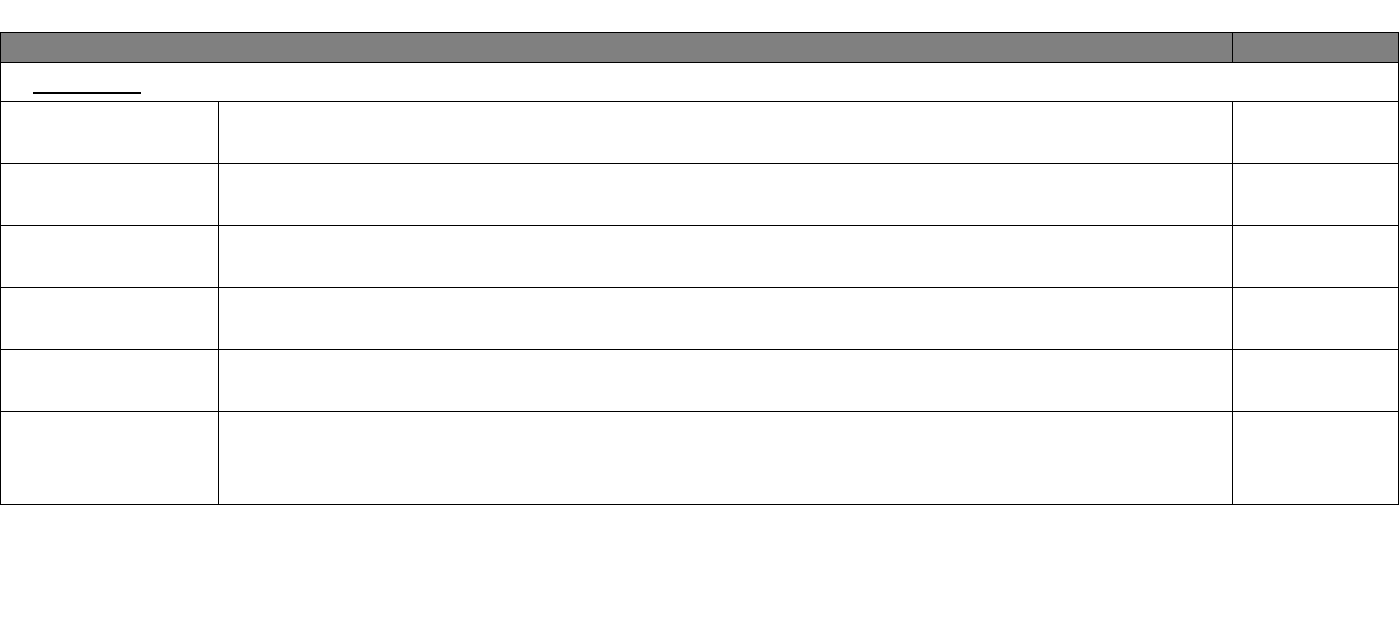
213
Competency E: Relentlessly Pursues Self-Disciplined Thinking and Action
Key Behavior
Score (1-4)
Standard E1: Creates and supports a climate that values, accepts and understands diversity in culture and point of view
1
Builds collaboration, understanding, and respect between different stakeholder groups (students, staff,
parents, LSC, community)(e.g., partnerships to access community resources)
2
Effectively responds and resolves concerns and issues of students, staff, parents, LSC, and community
members
3
Uses ongoing written and oral communication to effectively communicate with different stakeholders about
school curriculum, activities, student achievement, and safety
4
Motivates and inspires staff to contribute to success of school
5
Maintains honesty, integrity, and professionalism in carrying out leadership responsibilities
6
Fosters a school environment that embraces diversity and cultural differences (e.g., Diversity Professional
Development, Community Service, Unity Month, Black History Month, National Hispanic Heritage Month,
Women's History Month, etc.)
After you have assessed each Key Behavior, add the points and divide the total by 6 to get the Competency Score.
Competency E Score: Rounded to the nearest tenth (Between 1.0 and 4.0) ____________
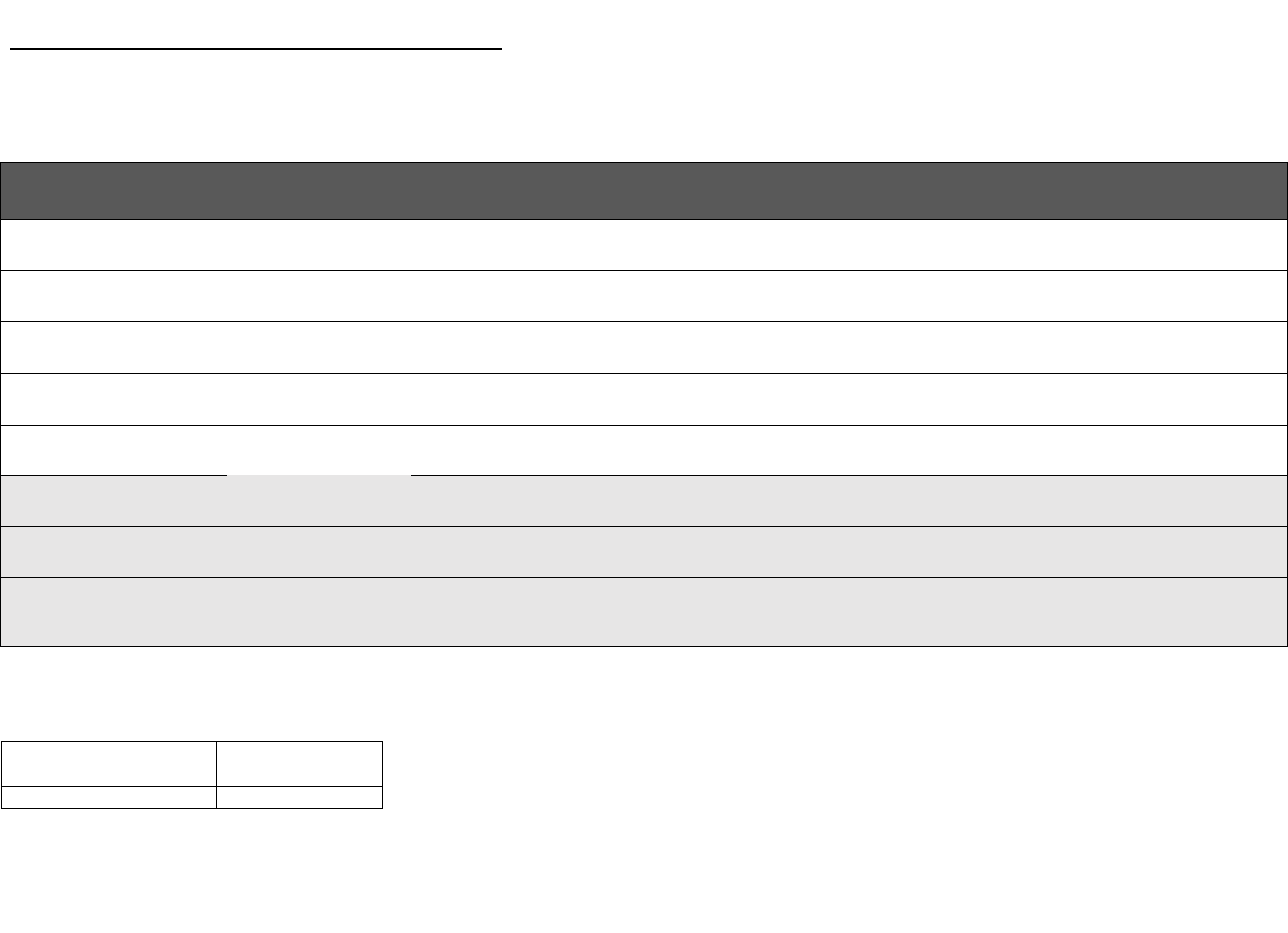
214
Principal Professional Practice Summary
Complete the table below by entering the Competency Scores from pages 1 and 2 into the Competency Score column.
These Competency Scores are then multiplied by the Weights listed below to calculate a Weighted Score.
The Weighted Scores are then added together to determine the Principal's Professional Practice Score.
This section of the Principal Performance Evaluation must be completed and voted on by the LSC by June 30th.
Competency
Description
Competency
Score
Weight (%)
Weighted
Score
Competency A
Continuous Improvement and School Vision
0.25
Competency B
Professional Learning Systems
0.25
Competency C
College & Career Readiness
0.20
Competency D
Family & Community Engagement
0.20
Competency E
Self-Disciplined Thinking
0.10
Preliminary Principal Professional Practice
Score
Preliminary Principal Professional Practice Rating Level (See Rating Key)
Final Principal Professional Practice Score
Final Principal Professional Practice Rating Level (See Rating Key)
Date the LSC Voted to Approve the Principal Provessional Practice Score and Rating Level: _______________________
LSC Chair Signature: ___________________________________
Number of Votes
Yes Votes
No Votes
Abstained from Vote

215
Comments
If the Final Principal Professional Practice Evaluation Rating is different from the Preliminary Principal Professional Practice Rating above, please provide
an explanation below.
Principal Responses:

216
Student Growth and Other Measures
The Student Growth and Other Measures score is calculated by the CPS Office of Accountability based on the scoring found in the Board's School Quality
Rating Policy (SQRP) for those SQRP metrics specified by the CEO. The same SQRP metrics and scoring used for the CEO's Principal Evaluation will be used
for the LSC's Principal Evaluation. The SQRP metrics specified by the CEO and related scoring are itemized on the Student Growth and Other Measures
report provided to LSCs by the CPS Office of Accountability in the Fall. Please enter the Score and Rating Level from the CPS Student Growth and Other
Measures report below.
Indicator
Description
Score (1-4)
Student Growth and Other Measures
Score from SQRP metrics specified by the CEO and itemized in the Student Growth
and Other Measures Report for LSCs
Student Growth and Other Measures Rating Level (See Rating Key)
Preliminary Summative Rating
Complete the table below by entering the Principal Professional Practice Score and the Student Growth and Other Measures Score into the column
labeled Score. Then multiply each Score by .50 to determine a Weighted Score. These Weighted Scores are then added together to determine the
Preliminary Summative Rating. If for any reason a SQRP report is not issued to a school for a particular school year, the final rating shall be determined
based on the Principal Professional Practice Score only, which shall include any Additional Indicators. This Preliminary Summative rating is subject to final
review and determination by the LSC. In the event the LSC awards a Final Summative Rating that is different from the Preliminary Summative Rating, the
LSC shall include an explanation on page 5.
Component
Score
Weight
Weighted
Score
Principal Practice
0.50
Student Growth and Other Measures
0.50
Preliminary Summative Rating Score
Preliminary Summative Rating Level

217
Additional Indicators (Optional)
The Additional Indicators section is optional. The LSC and principal may decide to include Additional Evaluation Indicators to the principal's annual
performance evaluation. All Additional Indicators must be agreed upon by the LSC and principal and recorded by November 1st or such later date as
specified by the CEO. If more than two Additional Indicators are specified, please attach additional pages. For each indicator included below, write a
description of the indicator. Please use these indicators to inform the Final Summative Principal Evaluation Rating.
Indicator
Description
Indicator 1 (optional)
Indicator 2 (optional)
Rating Key
Rating
Min. Score
Max. Score
Excellent
3.5
4
Proficient
2.5
3.4
Developing
1.5
2.4
Unsatisfactory
1
1.4

218
Final Summative Principal Evaluation Rating
The LSC shall determine the Principal's Final Summative Evaluation Rating after considering all scores in the Preliminary Summative Rating section of this
form along with the additional indicators and other factors deemed relevant. Please check the box below to record the Final Summative Rating issued to
the Principal. If the Final Summative Rating is different from the Preliminary Summative Rating, the LSC shall indicate the reasons and rationale for the
differences in the Comments section provided below.
Rating
Final Summative Principal Evaluation Rating
Excellent
Proficient
Developing
Unsatisfactory
Date the LSC voted to approve the Final Summative Principal Evaluation Rating Level: ______________
Number of Votes
Yes Votes
No Votes
Abstained from Vote

219
Comments
LSC additional Principal Evaluation comments below.
If the Final Summative Principal Evaluation Rating is different from the Preliminary Summative Rating on page 3,
please provide an explanation below as well.
Principal Responses:
Signatures
LSC Chair Name (print)
Date
Signature
Principal Name (print)
Date
Signature

220
Appendix B: Principal Evaluation Online Tool (PEOT)
The example below illustrates how the online tool will tabulate the LSC’s individual scores.
Directions: The LSC will assign a numerical value to each Key Behavior using a 1-4 scale where
1=Strongly Disagree, 2=Disagree, 3=Agree and 4=Strongly Agree.
Key Behavior
Strongly
Disagree
1
Disagree
2
Agree
3
Strongly
Agree
4
N/A
Standard E1: Creates and supports a climate that values, accepts and
understands diversity in culture and point of view
1
Builds collaboration, understanding, and respect
between different stakeholder groups (e.g. students,
staff, parents, LSC, and community) (e.g., partnerships
to access community resources)
3
2
Effectively responds and resolves concerns and issues
of students, staff, parents, LSC, and community
members
2
3
Uses ongoing written and oral communication to
effectively communicate with different stakeholders
about school curriculum, activities, student
achievement and safety
3
4
Motivates and inspires staff to contribute to success of
school
2
5
Maintains honesty, integrity and professionalism in
carrying out leadership responsibilities
3
6
Fosters a school environment that embraces diversity
and cultural differences (e.g., Diversity Professional
Development, Community Service, Unity Month, Black
History Month, National Hispanic Heritage Month,
Women’s History Month, etc.)
2
This step will be completed by PEOT:
TOTAL POINTS
15
COMPETENCY SCORE
2.5
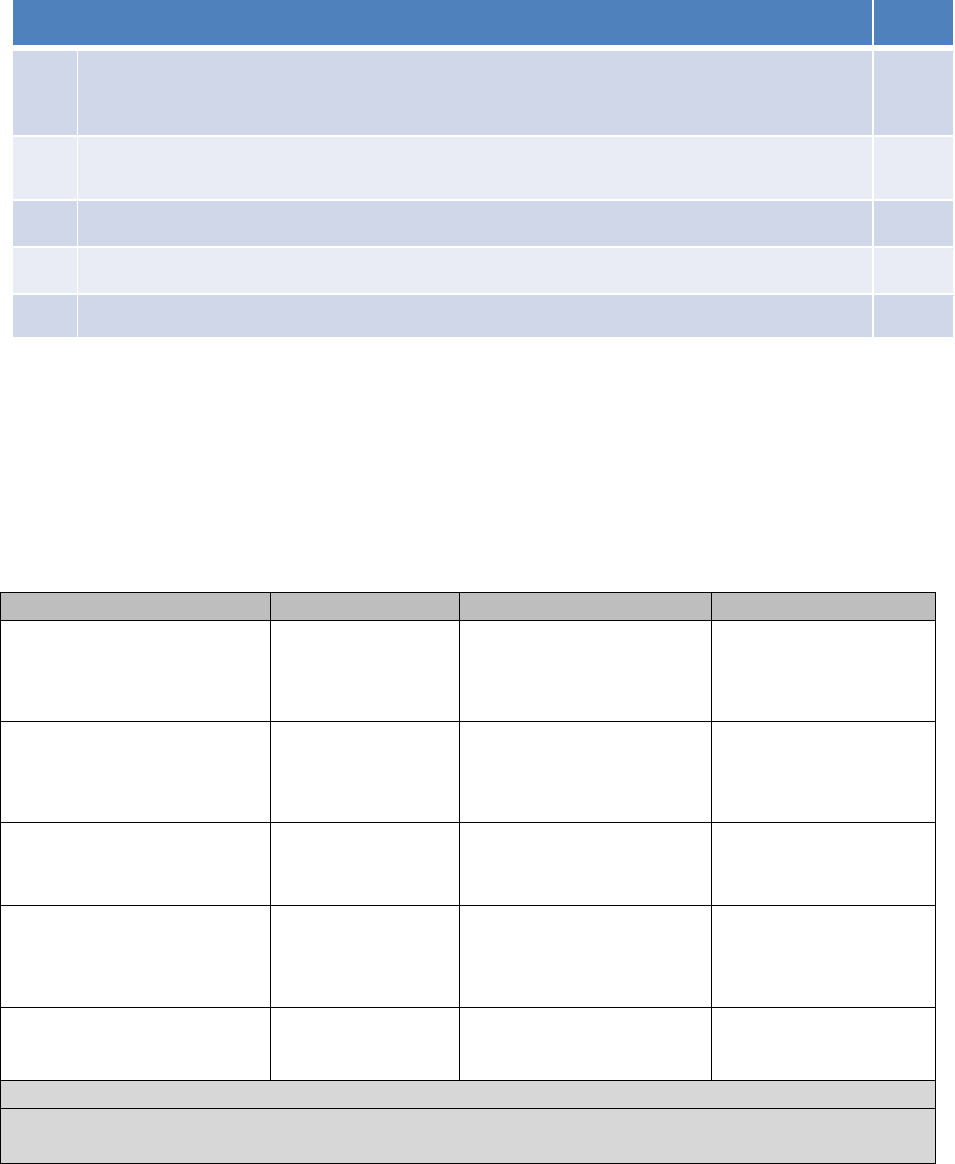
221
Appendix C: Sample Calculation for Combining Competency Scores
into a Final Principal Professional Practice Rating
When calculating the final overall Principal Professional Practice Rating, each of the 5
competencies are assigned its own weight. Competency A and B carry the most weight.
Competencies
Weight
A
Champions teacher and staff excellence through a focus on continuous improvement to
develop and achieve the vision of high expectations for all students
25%
B
Creates powerful professional learning systems that guarantee learning for all students
25%
C
Builds culture focused on college and career readiness for all students
20%
D
Empowers and motivates families and the community to become engaged
20%
E
Relentlessly pursues self-disciplined thinking and action
10%
In the example below, a performance level is identified for each competency based
on the scores recorded for the Key Behaviors. The performance level is multiplied by
the weight and then the weighted points are totaled to determine the overall Principal
Professional Practice
Score. The Principal Professional Practice Score is then converted into a “Proficient”
rating according to the Summative Rating Key on the next page.
Competency
Performance Level
Weight
Points
Competency A –
Champions teacher and staff
excellence through continuous
improvement
3
25%
.75
Competency B –
Creates powerful professional
learning systems that guarantee
learning for students
3
25%
.75
Competency C –
Builds a culture focused on college
and career readiness
3
20%
.60
Competency D –
Empowers and motivates families
and the community to become
engaged
4
20%
.80
Competency E -
Relentlessly pursues self-
disciplined thinking and action
3
10%
.30
Principal Practice Total Points 3.2
Overall Principal Practice Rating Proficient
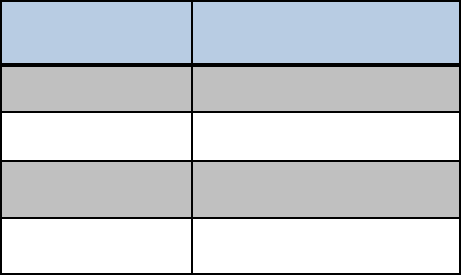
222
Rating
Principal Practice Rating
3.50-4.0
Excellent
2.50-3.49
Proficient
1.50-2.49
Developing
1.0 – 1.49
Unsatisfactory
223
Appendix D: Process for Including Optional Additional Indicators
In some cases, LSCs may want to identify areas of focus for the principal that are not
included in either the Professional Practice or Student Growth and Other Measures
sections. Additional Indicators are appropriate when a LSC feels that there are goals
unique to the school that are important for the principal to prioritize.
If additional indicators are developed, they must be mutually agreed upon (agreement
between the LSC and the Principal) no later than November 1st or such later date as
specified by the CEO. Please use these indicators to inform the Final Summative
Principal Evaluation Rating.
224
Appendix E: Legal Requirements for Principal Evaluation
For the annual evaluation, the LSC must meet with the principal at least once as it
gathers information for the evaluation, as required by the Uniform Principal’s Performance
Contract.
• The LSC’s evaluation of the principal must be approved by an affirmative
vote of the majority of the serving members of the LSC in an open session.
• The ratings and contents remain confidential unless the principal wishes to
release them to the public.
• High school student LSC representatives may voice their opinions and
participate in the evaluation process but not vote on the approval of the
evaluation or be counted to achieve quorum at any meeting addressing principal
evaluation.
• The LSC and its committees must comply with the requirements of the Open
Meetings Act during the evaluation process.
• Within 30 days after the principal’s receipt of the LSC’s annual evaluation, the
LSC and principal may meet to discuss the evaluation (in a feedback session).
• The LSC may, but is not required to, adjust the evaluation ratings on the
basis of the feedback session.
• The LSC must send a copy of its final annual evaluation to the principal and the
Network Chief.
When in the Principal Performance Evaluation Process are Closed (Executive)
Sessions Appropriate?
As stated above, the LSC and its committees must comply with the requirements of the
Open Meetings Act during the evaluation process. However, when the LSC or its
committees are discussing confidential personnel information, the LSC should meet in a
closed or “executive”
session of the LSC. Some examples of occasions when executive sessions are
appropriate include:
• Evaluation committee meetings when a Principal Evaluation Committee is
discussing evaluation ratings or the LSC is discussing or making decisions
about the evaluation ratings.
• LSC meetings when members wish to discuss the content of the evaluation
before voting to approve the ratings or to prepare for the feedback session; and
the feedback session.
• Meetings to discuss confidential input from members of the school community.

225
Appendix F: Confidentiality Agreement and Code of Conduct for
Principal Evaluation
There are some key specifics your Principal Evaluation Team must abide by when
they are involved in the evaluation process, which are incorporated into the
agreement below.
You may want to have each of the individuals who will be involved in your principal
evaluation process sign this agreement, which incorporates these requirements. Your
LSC Chairperson should collect the signed agreements during your first LSC meeting
regarding principal evaluation. In addition, members should also monitor each other to
ensure that all members are adhering to the following conditions.
•
I agree that I will not make any evaluation decisions on the basis of a person’s
race, color, ethnicity, national origin, religion, age, sex, marital status, parental
status, mental or physical disability (unrelated to job performance), finances, or
sexual orientation. Furthermore, I will not ask any questions or make any
comments during the evaluation that pertain to these topics.
•
I agree to adhere to the requirements of the Open Meetings Act.
•
I agree that I will conduct the principal evaluation process and make a retention
decision based on the best interests of the school as determined by the
standards stated in the Illinois School Code.
•
Furthermore, I agree to keep all discussion, documentation, and information
related to the principal evaluation process completely confidential.
Name:
Date:
Agreement based on materials developed by Designs for Change and PENCUL.

226
Appendix G: Principal Performance Evaluation Support Materials
This list of support materials is provided to assist LSCs as they look for evidence of work in the
5 competencies. This list contains examples and suggestions. It is not all inclusive. The exact
types of supporting materials will vary from school to school. LSCs should consider both the
quantity and quality of these materials and the activities and programs they reflect.
Competency A: Continuous Improvement and School Vision
Standard A1: Develops, implements, and monitors the outcomes of the CIWP
•
List of CIWP team
•
Team meeting sign-in sheets and/or minutes from meetings
Standard A2: Creates a continuous improvement cycle
•
Minutes from grade-level team meetings
•
Written vision and/or mission statement
•
Principal’s monthly reports to the LSC
•
Sample of student data analysis with goals identified
Standard A3: Collaborates with staff on budget and to achieve CIWP targets
•
List of CIWP meetings and attendance rosters
•
List of budget meetings and attendance rosters
Standard A4: Creates a safe and orderly environment
•
Safety and security plan is on file
•
Facilities, safety and security reports
Competency B: Professional Learning Systems
Standard B1: Works with and engages staff in professional development
•
Staff development agendas, attendance rosters and
workshop evaluations
•
List of completed staff development activities (conferences,
workshops, etc)
•
List of state-required and other in-services/conferences attended by
the principal
•
List of principal’s professional memberships
•
List of principal’s mentoring activities
Standard B2: Teacher Evaluation
•
Record of teacher goals
•
Calendar of pre-conference, observations, and post-
conference meetings
•
Copies of teacher lesson plans

227
Competency C: College & Career Readiness
Standard C1: Develops the full range of students’ learning capacities, creative, social-
emotional, behavioral, and physical
•
Technology plan
•
List of innovative supplemental programs
•
Lists of student clubs/ school activities and samples of
minutes from meetings, as appropriate
•
Lists and descriptions of student recognition or award programs
•
Sample student learning contracts
•
Discipline reports
Competency D: Family & Community Engagement
Standard D1: Engages families and communities in supporting students
and school
•
List of parent activities/volunteer opportunities/meetings and
names of participants
•
Parent surveys and corresponding summaries of responses
•
Newsletters, bulletins or flyers sent to parents
•
Number of parents who attended report card pick-up days
•
Lists and descriptions of community partnerships
•
List of community use of school
•
Community surveys and corresponding summaries of responses
•
Visitor sign-in book
•
Copies of letters and flyers sent home with students
•
Bulletins and emails to staff
Competency E: Self-Disciplined Thinking
Standard E1: Creates and supports an accepting and understanding
educational community
•
Professional learning activities to support diverse student needs
•
Intra-school conversations for students to explore culture and
diversity
•
Partnerships with schools that may have different populations
•
Building staff development plan
•
Utilization of arts and culture as a tool for
understanding and communicating with students and
communities
•
Professional learning conversations to develop staff capacity to
initiate conversation about culture and diversity
228
Appendix H: The Cumulative Evaluation
A cumulative evaluation is conducted at the beginning of the fourth year of a
principal’s contract. The same evaluation form that is used for annual evaluations is
used for the cumulative evaluation, except that the LSC takes into account the
principal’s performance during the previous three years, rather than just assessing
one year’s performance. In most cases, LSCs review the evaluation forms (if they are
available) from the previous three years as the primary basis for the cumulative
evaluation.
The rating scale is: “Excellent,” “Proficient,” “Developing,” or “Unsatisfactory.”
Please consult with your LSC Facilitator if you need assistance.
230
Introduction
In 1988, the Illinois General Assembly passed the “Chicago School Reform Act” which
delegates the school principal selection authority to the school community’s elected
Local School Council. Therefore, Principal Selection is one of the most important
responsibilities of a Local School Council (LSC).
Principals are key to the success of all schools. Their role is complex and must be
carried out effectively to ensure student success. The District understands the critical
role of the principal to ensure all students reach their highest potential. The role of the
LSC in the selection process is vital to ensure there is a high quality principal in every
District school. The Chicago Public School District appreciates the time and dedication
of LSC members to select a quality candidate who is the best fit for the school as the
“contract principal”.
The Office of LSC Relations, Department of Principal Quality and the Chiefs of
Schools are key resources to assist LSCs in the selection process. This section
provides information necessary for the selection process.
Contents
Guidelines for Principal Selection p. 231
Steps to Select a Principal p. 232
Legal Responsibilities and Definitions p. 243
Resources
Forms and Information Sheets p. 248
Tip Sheets—Practical Advice for the Process p. 271
Each item in the Contents is linked to the page listed for that topic.
Click on the title and you will get directly to that page.
231
GUIDELINES FOR PRINCIPAL SELECTION
This section outlines both the required and highly recommended steps in the principal
selection process and is designed as a guide for the LSC. Each step of the process
provides the Council with information that will offer a framework for selection.
Principal Selection Sequence
1. Organize the Selection Process
2. Prepare and Post Principal Position Advertisement
3. Review Resumes and Identify Candidates to Advance to Interviews
4. Conduct Candidate and Conduct Reference Checks
5. Hold Principal Candidate Forum
6. Select Finalists and Award Contract
LSC Responsibilities for Principal Selection
To select a new contract principal:
•
Complete Principal Selection training with OLSCR..
•
Work closely with the Chief of Schools to understand the current school and
student performance, review the CIWP and identify the skills and qualifications
needed of the best candidate to lead the school.
•
Create a principal position advertisement to be posted on the CPS website,
following approval from the Chief of Schools.
•
Create the principal selection process timeline, including steps and activities
including but not limited to review the submitted candidate materials, candidate
interviews, candidate school site visits, candidate forum, and reference checks.
•
Approve any desired contract addenda and obtain Law Department’s approval.
•
Achieve consensus of seven or more LSC members to vote in favor of the
contract principal.

232
STEPS TO SELECT A PRINCIPAL
The LSC must select a new principal if:
•
The current principal’s contract is not renewed
•
The current contract principal leaves the position based on retirement,
resignation, transfer, or other reason
•
The principal is on extended leave and has exhausted the Family Medical
Leave Act job-protected timeframe
If the LSC does not begin or complete the process of selecting a new contract principal,
the CEO will appoint an acting and/or interim principal for the school until the LSC
selects a new contract principal. The LSC must award a contract within 90 days of the
former contract Principal’s departure and seven (7) votes are needed for approval.
Prequisite: Training
Confirm that all members of the Local School Council have completed Training Module 6,
Selection of a Principal, before beginning the process. That training is required to be
completed within six (6) months of the first year of membership in the LSC. Go to
https://cps.edu/lsc for information about that Training Module or contact the Office of
Local School Council Relations at 773-553-1400.
The Sequence to Select a Principal
Step 1. Organize the Selection Process
The discussion of the process for principal selection must be conducted
during an open session of the LSC meeting or LSC committee meeting
(including approving the candidates who will be moving on in the process).
The use of closed sessions in the principal selection process is available
only for review and discussion of individual candidate
’
s qualifications and
interviews.
A. Define the Structure of the Selection Process:
•
Create a timeline for completing the selection process.
•
Choose a Principal Selection Committee of LSC members and possible non-
LSC members.
•
Develop the steps and activities of the Selection Process (including conduct
interviews, phone screens, school visits, candidate forums, etc.)
•
Identify LSC members roles in the selection process.
•
Follow the Code of Conduct: The intent of the Code of Conduct Agreement is to
ensure confidentiality and professionalism throughout the selection process. Each
LSC committee member completes and signs the Code of Conduct Agreement
(Form 1 in the Resources Section).

233
B. Selecting Participants for the Selection Committee
The LSC determines who will be on the selection committee. There are several
options:
•
All of the LSC members
•
Subset of the LSC members
•
Some LSC Members and non-LSC school community stakeholders (for example
parents, community, school staff, etc.)
•
Non-LSC Member Participants (Non-LSC members serve in an advisory capacity
and provide recommendations to the LSC. Non-LSC members may vote on any
Principal Selection Committee decision.)
The LSC must vote in open session to approve non-LSC Members as part of the
Principal Selection Committee. (While the LSC may establish a Selection Committee
which may include non-LSC members, we refer to the “LSC” as carrying out all selection
activities and procedures in this section).
Step 2. Prepare and Post Principal Position Advertisement (Required)
A. Assess Needs of the School
Conduct a comprehensive school and student performance assessment to identify
the necessary skills and qualifications that the principal should possess to achieve
school and student goals. Review school and student performance assessment
results and identify experience, skills and qualifications necessary for a principal
candidate to best meet the needs of the students and school community.
Meet with Network Chief to review the school performance data and discuss the
strengths and needs of the school. This meeting is a public meeting that has been
properly posted. The Network Chief is an excellent resource to assist in understanding
school performance data and student learning needs.
Utilize the “School Needs Questionnaire” (Form 2 in the Resources Section) and
“School Strengths” (Form 3 in the Resources Section) to identify school strengths and
needs. This information is important for the position advertisement and interview
questions.
B. Draft advertisement including a list of required and preferred criteria of candidate
experience, education, and other qualifications that are essential to student success and
the school’s progress.
C. Identify the documents the candidate must submit, usually just a resume and cover
letter. The cover letter is an opportunity for candidates to express their intent and
explain how their experiences, knowledge and attributes qualify them for the position.
D. Vote to approve the position advertisement. Note: this vote is required.

234
Process to Post the Position Advertisement
1. Email position advertisement to Chief of Schools, LSC Facilitator, and
[email protected] for approval and posting on the CPS website. Note: Chief of
Schools approval and 10-day posting on CPS website are required.
2. Email approved ad to Department of Principal Quality, [email protected]
using the template in the link CPSPrincipalE-Bulletin.
The LSC may decide to advertise the position on additional sites. The LSC must pay for
any additional advertisement costs. There are several different sources the LSC can
use to find candidates for the principal’s position. Targeted education sites can be
helpful to promote the opportunity and expand the applicant pool. Sites to consider for
additional posting include:
•
Educational Magazines (Education Week)
•
Professional and Educational Websites
Note: The deadline listed in the CPSPrincipalE-Bulletin controls the end date of the
application period. It is advisable to make sure that ads in other publications will be
published at least several weeks prior to the deadline in the CPSPrincipalE-Bulletin.
Step 3. Review Resumes and Identify Candidates to Advance to
Interviews
Process to Review Resumes and Identify Candidates
A) The Department of Principal Quality will email to the LSC Chair the complete list of
eligible candidates and materials submitted by the candidates approximately two days
after the advertisement closes. After the LSC receives the list of eligible candidates and
materials submitted by candidates from the Department of Principal Quality, the LSC
conducts a review of the submitted materials. It is recommended that the resume
review is conducted in a closed session.
B) Resume review is required and includes analysis of application and resume
compared to the position criteria detailed in the advertisement. Recommended
Sorting categories include:
•
Meets Meets all required and preferred skills, qualification and experience
detailed in the advertisement and will advance to interview step;
•
Requires Further Review Meets all required skills, qualification and experience
detailed in the advertisement and requires further review by LSC to advance to
interview step;
•
Does not Meet Does not meet the required skills, qualification and experience
detailed in the advertisement and will not advance to interview step.

235
C) Additional Research: It is recommended that the LSC conduct additional research, if
applicable, on the candidate’s current school and position, including position title
confirmation, review student performance data of applicant’s current school with
emphasis on student growth using the School Quality Rating Policy (SQRP) and School
Report Card which can be found on the CPS website under “Find A School”/School
Report which is at this link:
https://cps.edu/findaschool.
D) Identify candidates to advance to interviews based on resume, cover letter review
and additional research if conducted. In closed session, discuss the candidates and
select three (3) to five (5) candidates to recommend to the LSC for advancement to
interviews.
E) In open session, LSC votes on which candidates will be interviewed.
Note: Resume review is required. Seven votes in favor of one candidate are required
to award a contract. However, it is strongly recommended that a Principal contract not
be awarded based solely upon resume review.
Step 4: Conduct Candidate Interviews and Conduct Reference Checks
Process for Conducting Interviews
LSCs should follow the agreed upon interview and selection activity structure.
Following are key steps for interview and selection activities.
A) Identify committee members who will participate in interviews. Choose at least four
to six people to ask the interview questions during the first round of interviews. The
interviewers should be objective and non-biased when asking questions and writing
notes.
In deciding who should be part of the first interview team, think about whether or not
there is anyone who has had previous interviewing experience, and who has the
available time to participate in all the interviews. All interviewers should participate in all
interviews to ensure consistent assessment of candidates. Remember to follow the
established operating agreements to help make the best decision.
236
Prepare objective, non-biased interview questions based on the criteria outlined in the
position advertisement and school needs. Questions should be formatted in the
behavioral interview style in order to have candidates articulate their experiences and
accomplishments versus sharing what the candidate might do in the future. “Best
Practices for Successful Interviews” (Form 6 in the Resources Section).
If the structure includes multiple rounds of interviews and site visits, the interview
questions should be tailored to the activity. The initial interview typically focuses on
learning about the candidate’s experiences, gaining information about the candidates’
leadership presence and style, as well as, communication skills analyzing how the
candidate talks about their work and engages with the LSC members.
If there is a panel of interviewers, one committee member should serve as moderator
and timekeeper of the panel interviews. Determine who will ask questions. For
example, one person could ask all the questions and others observe or multiple
interviewers can ask questions.
Phone screens are an efficient step for the initial interview screen of candidates.
B) Do not ask discriminatory or illegal questions (Form 7 in the Resources
Section). Illegal and discriminatory questions can lead to legal challenge of selection
process.
C) Define the rating criteria to objectively assess each candidate from the interview.
An interview note sheet and rubric should be developed to ensure consistent rating
and analysis of candidates by each interviewer.
D) Schedule interview days and times according to the selection process
timeline. One committee member should be the point of contact for the
candidates. This person should send the interview invitation, interview
confirmation and all follow-up communications with the candidates.
E) Conduct initial interviews – phone screen or in-person. All candidates must be asked
the same questions. Interviews must be the same length of time for each candidate.
Prepare candidate materials for each interviewer including candidate resume and cover
letter, interview questions and interview notes and rubric sheets.
Remember that the LSC is gathering information about the candidate, but the candidate
is also gathering information about the LSC and the school. Prepare materials for
candidates, such as school paper, local news articles on the school, information about
interesting school programs.
During interviews, engage the candidate and be objective, consistent and do not pre-
judge candidates.

237
Following are tips for the interview:
•
Introduce - Begin the interview with each interviewer introducing
themselves and their relationship to the school and LSC. After the
introductions, let the candidate do most of the talking while the
interviewers listen.
•
Inform - Provide an overview of the selection and interview process.
•
Educate - Tell the candidate about your school and school community.
•
Rapport - Establish a rapport with the candidate. When candidates feel
relaxed and comfortable in an interview, they often reveal more about
themselves. The more information the interviewers learn about the
candidates, the better the decisions will be.
•
Engage - Involve students in the process. For example, have students
welcome candidates to interviews and lead candidate on tour of school.
How candidates engage with students can be very informative of the
candidates’ leadership and communication style
At in-person interviews, have each candidate complete the “Reference Authorization
Form” (Form 9 in the Resources Section)
The purpose of the post Interview process is to debrief each interview and
determine which candidates:
•
Advance to next round of interviews or selection activity
•
Need further review before advancing to next round of interviews or
selection activity
•
Do not advance in the selection process
In closed session, interviewers should individually compile notes and ratings. After
individual interviewer notes and ratings are complete, the LSC discusses the
candidates and the information that has been gathered about them to narrow the
candidate pool to one (1) to three (3) finalists.
In open session, LSC votes to select one (1) to three (3) finalist candidates for next
round of interviews or selection activity.
F) Notify applicants who do not advance to initial interview should be notified by phone
or email by the LSC Chair. The notification should state appreciation for interest in
position and that the individual is not being considered for the principal position with the
school at this time. This notification should be sent within three (3) to five (5) business
days of the decision/ recommendation.

238
Notify applicants who are selected to advance to interviews should be notified by phone
or email by the LSC Chair of their advancement and the next steps in the selection
process.
G) Conduct second round of interviews if needed (optional). In addition to
steps established for initial interviews, the LSC should employ the following
steps for the second round of interviews:
•
Preparation of questions
•
Structure of interview and which committee members will ask questions
•
Post interview debrief discussion
•
Determine which candidates to advance to next step in process
H) Conduct Reference Checks (Recommended)
Use the Tip Sheet on “Conducting Reference Checks” and utilize the “Competency-
Based Form for Reference Checks” (Form 10 in the Resources Section). Decide who
will conduct the reference checks. This should be done when meeting to select the
candidates to invite for second interviews. Conduct reference checks during the same
time period that the second round of interviews are taking place. Members of the
committee who are not participating in the interview can do the reference checking.
•
Utilize the “Competency-Based Form for Reference Checks” (Form 10 in the
Resources Section)
•
Prepare list of questions to ask references.
•
Assign reference checks.
•
Preview reference check procedures.
•
Check references of candidates.
•
Get references from three (3) sources:
•
Contact the references the candidate provided.
•
Contact an LSC member or members at the candidate’s former school to get
references.
•
Contact one or more individuals at the candidate’s school not named by the
candidate. The names of such individuals may be obtained from the candidate's
references.
•
Prepare reports on reference checks.
I)Conduct School Site Visits (optional)
Use the Information Sheet on “School Visit to Your Candidates’ School” and worksheet
for “School Visit at Your School” (Form and Information Sheets 11 and 12 in the

239
Resources Section). Be observant and pay attention to how well the candidate
communicates and relates to staff, students and parents.
When planning a visit to the candidate’s current school, clear two or three possible visit
days with the principal but do not disclose the exact date of the visit. When inviting the
candidate to visit the LSC's school, involve some students to assist in conducting the
tours.
a) Visit to Finalist Schools:
•
Prepare site visit checklist based on CPS Performance Standards and
school’s criteria for principal.
•
Utilize the “Worksheet for School Visit to the Candidate’s School” (Form 11 in the
Resources Section).
•
Preview site visit procedures.
•
Complete site visit.
•
Prepare report on site visit.
b) Visit to LSC’s School:
•
Utilize the “Worksheet for School Visit at Your School” (Form 12 In
Resources).
•
Prepare site visit checklist based on CPS Performance Standards and
school’s criteria for principal.
Step 5: Hold Candidate Forum for School Community (optional)
Utilize the “Scheduling Form for Community Forum” (Form 13 in the Resources Section)
and the Information on “Conducting Community Forum” (Tip Sheet 9) found in the Tip
Sheets to schedule and conduct the forum.
A) Prepare for Community Forum
The LSC presents the finalists in a structured public forum and allows those interested to
ask questions of candidates. The LSC Chair should confirm the schedule with LSC
members and candidates.
•
Preview procedures for forum
•
Announce the Forum
•
Conduct the Forum
Step 6: Select Finalists and Award Contract (Required)
A) Select two (2) to three (3) finalists
•
Review documents and reports
•
Adjust plan if candidates do not meet criteria
•
Vote in open session to select finalists Note: this vote is required.

240
Note: While the Open Meetings Act allows the LSC to discuss, consider, and come to a tentative
agreement, the action to hire a candidate must be made in an open meeting. These discussions
must include a public recital of the nature of the matter being considered and other information
that will inform the public of the business being conducted. The finalists must be identified by
name during this meeting.
B) Addenda to Contract (optional)
In closed session, the LSC discusses any possible addenda to be added to the
principal contract. In open session, the LSC discusses and votes on addenda to add to
the principal contract. The LSC sends the draft addenda to the Law Department. If the
Law Department changes the addenda the LSC needs to vote in open session on the
revised addenda. The LSC informs the candidates of the contract addenda.
B) Conduct Final Vote
LSC discusses final candidates in closed session and makes a final selection in open
session. Note: This vote in an open session of the LSC meeting is required.
In a closed session:
•
Discuss the candidates' traits as observed during the interviews, school visits
and community forum.
•
Review all the information gathered about each candidate to assist in making
the final selections.
•
Take a straw poll on the candidates, ranking them in order from 1 to 3, with 1
being the top candidate.
•
Discuss what addenda to the contract, if any, would be appropriate, either for
all candidates or for particular candidates.
In an open session:
Approve the final recommendations on the matters discussed in closed session of the
LSC. In open session make a motion to award to the principal selected a four-year
principal contract (read any addenda to the contract) into the motion. Obtain a second
to the motion and open discussion of the motion. Call the question and vote on the
motion. The motion requires at least seven (7) yes votes for a new principal contract
and a majority of the serving LSC members if this is a contract renewal.
C) Complete five (5) original Uniform Principal Performance Contract forms, making
sure all spaces are completed and vote tally is recorded accurately, and all LSC
members voting affirmatively sign the Certification of Principal Selection By LSC form.
D) Obtain signatures of the LSC Chairperson, LSC Secretary and the new Principal on
the five (5) original copies.

241
E) Provide an original signed contract to: 1. Principal, 2. LSC Record Keeper, 3)
Department of Principal Quality, 4) Office of LSC Relations and 5) Network Office. The
individual delivering the contracts should receive a receipt from the Office of LSC
Relations, the Department of Principal Quality and the Network Office. See Principal
Position Ebulletin for details about contract delivery.
F) Review of Contract
•
Department of Principal Quality manages the review of the signed contract by
the Board of Education’s Law Department.
•
If the Law Department identifies issues with the contract, the Office of LSC
Relations works with the LSC Chairperson and Principal to correct issues and
submit a revised contract to the Department of Principal Quality.
G) Presentation of Contract to the Board of Education
•
Once the principal contract has been reviewed by key District departments, the
contract Board Report is presented to the Board of Education to accept and file.
The Board does not approve contacts. The Board’s role is to accept and file.
If the LSC does not reach consensus to award a contract, the LSC completes the
following process:
•
If LSC cannot select a new contract principal with seven (7) votes, the LSC shall
submit a list of three (3) candidates in order of preference to the Department of
Principal Quality to submit to the CEO.
•
The CEO may then select one (1) of the candidates to be offered the
contract.
•
If the CEO declines to select a candidate as contract principal, the LSC may vote
in open session to offer a contract to the candidate of their choice, including a
contract with any addenda approved by the Law Department.
•
Thereafter, the LSC submits five (5) original contracts to the appropriate
Board Departments for acknowledgment.
If the LSC does not submit the list or the CEO declines to select a recommended
candidate, the LSC may begin the principal search process over in lieu of selecting one
of the previously considered candidates as the principal. If the LSC fails to submit three
candidates in order of preference to the CEO or the CEO declines to select a
recommended candidate as the principal, the CEO will appoint an interim principal for
the school until the LSC awards a contract.

242
If the LSC selects a candidate with seven (7) votes, execute the following:
•
The LSC Chairperson, LSC Secretary and the candidate selected sign five (5)
original contracts as well as any approved addendum to the contract.
•
Determine who will send the certification form and the signed contracts
(including approved addenda) to CPS.
Make sure that CPS receives documentation of the selection on or before the
stated deadline.

243
LEGAL RESPONSIBILITIES AND DEFINITIONS
LSC without Authority to Award Principal Contract
If a school is on probation, the LSC does not always lose their authority to
select and award a principal contract. If the Chicago Board of Education (the
Board) has removed a school’s contract principal after making a determination
pursuant to Illinois School Code 34-8.3, the LSC does not have the authority to
award a principal contract. The LSC’s authority will be reinstated after the
school is off probation pursuant to District Policy. To find out more information
about a school’s performance, consult the CPS website or the Network office.
Qualified Candidates
•
Candidates must have satisfied the Board’s current CPS Principal
Eligibility Policy (Board Policy 14-0723-PO1) requirements in order to be
awarded a four-year principal contract.
•
The Principal Talent Office manages the CPS principal eligibility
process. If a candidate has satisfied requirements of the CPS
Principal Eligibility Policy, the person is deemed Eligible and added to
the list of eligible candidates. Only candidates who have met the
eligibility requirements can apply for a principal position and be
awarded a contract.
Legal Requirements for the Selection of a New Contract Principal
If a LSC has voted not to renew the contract of its current principal, the
Illinois School Code 105 ILCS 5/34-2.3 provides that the LSC “shall” select a
new contract principal no later than 45 days before the current principal’s
contract expires (May 15 if it expires on June 30.)
If a vacancy in the contract principal’s position arises due to death,
resignation, or other reasons, the Illinois School Code requires that the
LSC “shall” select a new contract principal no later than 90 days after the
vacancy arises.
The Code also requires that seven (7) members must vote “yes” to select a
new principal, regardless of the number of LSC vacancies. Like all formal
votes of the LSC, the vote to offer a four-year contract must be taken in an
open meeting.
244
The current principal and student members of high school LSCs cannot
participate in the vote. The LSC is accountable to maintain membership
quorum required to conduct votes including voting to award a principal
contract.
If a teacher LSC member decides to become a candidate for the principalship,
he/she must abstain from voting on the renewal of the current principal’s
contract and must resign from the LSC prior to the start of the principal
selection process. Otherwise, the teacher shall be ineligible to apply for the
principalship.
The Illinois School Code (105 ILCS 5/34-2.3-1.C.ii) further provides that if the
LSC fails to select a new principal no later than 45 days before the current
principal’s contract expires or within 90 days of the date a vacancy in the
position arises, it “shall” submit a list of three candidates for the position in
order of preference to the CEO.
After receiving the list, the CEO has thirty (30) days to select one of the
candidates as the school’s new contract principal for the next four years. If the
LSC fails to select a new contract principal and fails to send the list of
candidates to the CEO or the CEO does not select one of the candidates as
the new contract principal, the CEO shall appoint a principal for the school on
an interim basis to serve from year to year or until the LSC selects a new
contract principal with seven “yes” votes.

245
The Uniform Principal’s Performance Contract
The Uniform Principal’s Performance Contract was adopted by the Board of
Education in June 2014, Board Report 14-0625-EX12 and is effective for all
contracts signed after June 25, 2014.
In addition to this standard contract, the LSC may negotiate additional criteria
with the selected principal candidate, to be added to the contract. The Illinois
School Code permits the LSC and principal to add “additional criteria”, the
addenda, to the principal’s contract of a rehired or new contract principal, but
only when the contract is negotiated. Proposed addenda must be consistent
with other provisions of the Uniform Principal’s Performance Contract, cannot
be discriminatory and be aligned to provisions of state law concerning the
authority and responsibility of the principal.
Proposed addenda must be approved by the CPS Law Department.
Addenda may focus on a key practice or initiative that the LSC wants the
principal to follow or complete during the contract.
Here are two examples of contract addenda:
•
The principal agrees to develop a comprehensive computer technology
program that engages fourth to eighth graders in activities designed (1) to
develop student competence in the use of computers as research tools and
(2) to perform demanding academic tasks, such as the preparation of
research papers, using computers. The program proposal must be
developed within the first year of the contract and presented to the LSC
review and approval and implementation no later than the second year of the
contract.
•
The principal agrees to develop a comprehensive discipline program
reflecting input from all stakeholders and specifically addressing classroom
management, school discipline in all areas of the school and its grounds,
related education for all staff, and the reduction of suspensions. The plan
must state clear roles and responsibilities of the assistant principal, staff,
students, parents, and other pertinent parties. The program proposal must
be developed within the first year of the contract and be presented to the
LSC for review and approval and implementation no later than the second
year of the contract.
If the LSC decides to renew the incumbent contract principal, the principal
receives a new contract and addenda may be added to the standard
contract.
246
Alternative and Small Schools
Pursuant to 105 ILCS 5/34.2.4(b), schools designated as alternative or small
schools have governing bodies appointed by the Board. These appointed
bodies (Appointed LSCs and Boards of Governors [ALSCs and BOGs])
recommend up to 3 candidates to the Chief Executive Officer to select a
candidate as their school’s contract principal. The appointed bodies do not
award principal contracts. For further details please contact the Office of LSC
Relations or the Board’s Law Department.
Types of Principals
Contract
Selected or retained in four-year terms. The contract principal may displace
the incumbent assistant principals and hire new assistant principals.
Interim
Appointed to fill the position if the LSC does not have the authority to award a
principal contract, the contract principal is out of the school for an extended
period, or the LSC does not come to consensus to award a contract. The
interim principal may displace and hire assistant principals.
Acting
Assigned to cover the principal position for up to 100 school days, which can
be renewed at the discretion of the Chief Executive Officer. The acting
principal cannot displace incumbent assistant principals.
Administrator in Charge (Retired Principal)
Assigned retired principal to cover a principal position on a temporary basis
who serves at the discretion of the Chief Executive Officer. An administrator in
charge is not a member of the LSC and therefore, does not count for quorum
and is not permitted to vote on or influence LSC business.
247
Resources
Forms and Information Sheets p. 248
Tip Sheets – Practical Advice for the Process p. 271
248
FORMS AND INFORMATION SHEETS
Form 1--REQUIRED
Code of Conduct and Confidentiality Agreement p. 249
Form 2
School Needs Questionnaire p. 250
Form 3
School Strengths p. 251
Form 4
Worksheet for Resume Screen p. 252
Form 5
Resume Screening Guide p. 253
Form 6
Best Practices for Successful Interviews p. 254
Form 7
Illegal and Discriminatory Questions p. 257
Form 8
Interview Competency Assessment Form p. 259
Form 9
Authorization for Reference Check p. 261
Form 10
Competency-Based Reference Form for Reference Check p. 262
Form 11
Worksheet for School Visit to the Candidate’s School p. 264
Form 12
Worksheet for School Visit at Your School p. 265
Form 13
Scheduling Form for Community Forum p. 267
Form 14
Certification of Principal Selection by Local School Council p. 268
Form 15
Certification of Principal Selection by ALSC p. 269
Form 16
Certification by LSC to Submit a List of Principal Candidates to the CEO p. 270
249

250
Form 1
Code of Conduct and Confidentiality Agreement
I agree that I will not make any selection decisions on the basis of a person’s race,
color, ethnicity, national origin, religion, age, sex, marital status, parental status,
mental or physical disability (unrelated to job performance), finances, or sexual
orientation. Furthermore, I will not ask any questions or make any comments
during the evaluation that pertain to these topics.
I agree to adhere to the requirements of the Open Meetings Act.
I agree that I will conduct the principal evaluation process and make a selection
decision based on the best interests of the school as determined by the standards
stated in the Illinois School Code.
I agree that I will not conduct this principal evaluation process or make a retention
decision based on personal issues not related to standards stated in the Illinois
School Code.
Furthermore, I agree to keep all discussion, documentation, and information
related to the principal selection process completely confidential.
Name: Date:
Agreement based on materials developed by Designs for Change and PENCUL
251
Form 2
School Needs Questionnaire
1.
What are the school’s biggest challenges, or needs?
2.
How do you think a principal can best help us overcome those challenges or needs?
3.
What are our school’s greatest strengths or success?
4.
Is there anything else you can think of that will help us to find the best possible
principal for our school?

252
Form 3
School Strengths
The purpose of this worksheet is to identify selling points you can use to help candidates
become excited about the opportunity to be your school’s principal. You can use the
responses people gave on the School Needs Questionnaire/Survey and/or conduct a
brainstorming session to create your list of school strengths.
Some great things about our school are:

253
Form 4
Resume Review
Using the “Worksheet for Resume Review” (Form 5), have all members of the LSC or
a subgroup of the LSC review all of the resumes and cover letters submitted and
discuss them to help ensure consistency.
A) Review the Candidates’ Resumes and Cover Letters
Look for the established key characteristics in the resumes and cover letters
to identify 3 to 5 candidates to interview. Below are some steps to assist the
LSC in making decisions based on these written materials.
•
Avoid bias and discrimination in the screening process.
•
Refine, as necessary, the “Worksheet for Resume Screen (Form 5),” so that the
revised form lists the “Top Priority Principal Competencies” that are specific
criteria for the LSC principal selection search.
•
Rate each candidate (looking at both the resume and accompanying cover
letter) on the indicated scale on the form from 1 to 4, with “1” representing “no
evidence that the candidate possesses this skill” and “4” representing “strong
evidence that the candidate possesses this skill.”
•
Tally the points for the chosen set of skills that the candidate was given. Since
all skills may not be equally important to the school’s needs, this total should
not be used as an absolute guide. Nevertheless, the total score gives some
indication as to whether there is a good match between the school’s needed
skills and the candidate’s skill.
•
Review resumes and cover letters for errors in spelling, grammar, job history
and performance data that could provide additional information on the candidate
to be used in consideration of advancement in process.
•
Select candidates to interview, require further review before advancing to
interview and not advancing to interview. Indicate category at bottom of form.
B) Categorize the Candidates
•
Once each member of the group has read the applications individually, divide
them into three (3) groups – Meets; Requires Further Review; Does Not Meet
based upon enthusiasm about interviewing the person.
•
Identify applicants for which the decision to interview is unanimous or nearly
unanimous.
•
Decide on others to be interviewed, with the group reaching consensus
through discussion.
Discussions about a specific candidate’s qualifications should take place in a closed
meeting but any candidate selections for interview must be voted on in an open
meeting.

254
Form 5
Worksheet for Resume Screen
Complete this form as you review the resumes of potential
candidates. Your Name:
Candidate Name:
Chicago Leadership Collaborative (CLC) Graduate: Yes No. Date:
Top priority principal skills
1 2 3 4
Points:
1 2 3 4
1 2 3 4
1 2 3 4
1 2 3 4
1 2 3 4
1 2 3 4
1 2 3 4 Quality of Candidate Letter
1 2 3 4 Quality of Candidate Writing
1=low to 4= high
Total Score =
Categorize the candidate in one of the following three groups by writing a letter on the
line below:
•
A Meets Meets all required and preferred skills, qualification and experience detailed in the
advertisement and will advance to interview step;
•
B Requires Further Review Meets most required skills, qualification and experience detailed in
the advertisement and requires further review by LSC to advance to interview step;
•
C Does not Meet Does not meet the required skills, qualification and experience detailed in the
advertisement and will not advance to interview step.
Candidate Rating:
255
Form 6
Successful Interview Best Practices
ü To help the applicant focus, begin by saying something like the following:
“We have reviewed your resume, and we are familiar with the major steps in
your career. Could you discuss the major competencies we seek and give
examples of how you have demonstrated them?”
•
Does the applicant focus on providing a comprehensive response to this
question, or does he or she simply summarize a set of experiences in his
or her career?
•
Politely press the candidate for specific examples of real events from his or
her experience. Turn the need into a question that begins with a phrase
like: “tell me about a time when...,” or “Give me an example of...” or
“Describe a situation where you...”
ü Ask follow-up / probing questions to get more detail about the candidate’s
experience.
•
For example: “What was the context that told you there was a problem?”
“What was your role in resolving it?” “On what resources did you rely?”
“What was the result of your efforts?” “What were the difficulties you faced?”
“What did you learn?” “What, if anything, would you do differently if given the
chance?”
ü Repeat this same process of selecting and developing questions and follow- up
questions for all the key skills that the LSC has identified.
ü Another useful area to explore is to ask: “What are some of the things you would
like to know about our school that would allow you to be an effective leader
here?” The interviewer can pursue this line of questioning by providing some data
and/or by citing some specific real problems the LSC is trying to solve.
ü Spend most of the interview time listening to what the candidates have to say.
ü End the interview by asking whether there are questions that the applicant would
like to ask about the school that he or she hadn’t had a chance to discuss.
ü Ask each candidate to sign the “Authorization for Reference Check" (Form 8) to
ensure that the LSC has the candidate’s permission to interview individuals
familiar with his or her past experience.
ü Also see Form 7 (illegal and discriminatory questions).

256
Successful Interview Best Practices (continued)
After the Interview
Assess the School’s top priority principal skills for each candidate directly after each
interview while the information the candidate shared is still fresh. Build in 5 to 10
minutes to discuss initial impressions.
Utilizing the “Interview Competency Assessment Form” (Form 8 in the Resources
Section) or one created by the LSC provides the interviewers with a place to score
candidates on the competencies, technical skills and specific experiences the LSC has
chosen as selection criteria. In addition, it provides a place to write observations about
the candidate’s strengths and weaknesses, any concerns about the candidate and
recommendation for whether or not the candidate should be invited back for another
round of interviews.
Discuss the Results:
Hold a closed meeting to discuss the results of the interviews. Keep the following
questions in mind throughout the discussion.
•
Does the candidate meet the needs and requirements the LSC
has established? (Be prepared to discuss specific evidence.)
•
If yes, what are the candidate’s strengths and weaknesses?
Process for discussing the interview results and selecting candidates for the
next round of interviews:
•
Each interviewer should review his/her interview notes (from Interview
Worksheets if used) in order to reacquaint themselves with the
candidates’ qualifications.
•
Each interviewer should determine which candidates are not worth
pursuing before the discussion begins.
•
Each interviewer should bring all notes, including their Interview
Competency Assessment Forms and Interview Worksheets, to this meeting
so that they can cite specific stories or examples given by candidates if
necessary.
During the meeting to select candidates for the next round of interviews,
keep these hints in mind:
•
Review the summary of survey data (including school strengths, issues,
problems and needs) as a reminder of what the LSC has identified as
the school’s priorities and the leadership skills needed in the new
principal before the candidate interviews began.
•
Have everyone briefly share their opinions about how the interviews
went. Solicit comments on how using the competency-based interview
questions felt and in general what “worked well” and what “needed
improvement.”
257
Successful Interview Best Practices (continued)
•
Determine which candidates received the highest ratings. Usually, time
can be saved by eliminating the lowest rated candidates and only
concentrating on discussing the highest rated individuals. Utilize the
technique employed for initially screening the candidates’ resumes.
o
A = Candidates that meet the needs of the school and the LSC is
definitely interested in pursuing.
o
B = Candidates that meet many requirements but the LSC is
uncertain about.
o
C = Candidates that do not meet the needs of the school and therefore
the LSC is not interested in pursuing
Discuss “A” candidates first, then the “B” candidates, and if necessary, move on to the
“C” candidates.
•
Discuss the positive attributes with regard to these candidates.
Interviewers who gave the candidates a particularly high score in certain
areas should explain why they did so by sharing some of the examples
of specific answers the candidates gave during the interviews.
•
Discuss the negative attributes with regard to these candidates.
Interviewers who gave a candidate a particularly low score in certain
areas should explain why they did so, based on what the candidate said
or how she/he behaved during the interview.
•
Discuss any factors that might have affected the scores given.
•
Discuss and record any concerns, questions, or issues about each of
the candidates so that these things can be addressed in the next round
of interviews.
•
Determine which candidates to invite back for the next round of interviews.
•
Remember: All votes related to candidate selection must be taken at an
open meeting. Is it not necessary, however, to refer to candidates by
name until the final decision Rather, the candidates may be referred to by
a number.
ü Notify Candidates of Next Steps
Decide who will call and send letters to inform the candidates who have not
been selected for a future round of interviews and who will be invited for another
interview. After each round of interviews, inform every candidate whether or not
they will be invited back for the next round. Inform them by telephone or by mail
within 3-5 days of the LSC’s decision.
258
Form 7
Illegal and Discriminatory Questions
Engaging the candidate and gleaning important information regarding skill and fit is
instrumental in identifying the successful candidate. In this process it is easy to unintentionally
ask a question or have a discussion that may seem harmless but opens the LSC to a
discrimination suit/action.
Remember to plan ahead and think carefully about the questions to be asked. Also, keep in
mind that sometimes it is the indirect question may actually be the hot button.
Whether in a casual conversation with the candidate or during the actual interview the LSC
should not discuss the following topics or ask the listed questions.
Age
•
How old are you?
•
When did you graduate?
•
How many years do you plan on working?
•
How long have you been working?
Ethnicity & Place of Birth
•
That is an interesting name, where does it originate from?
•
What is your native language?
•
Where were you born?
•
What kind of accent is that?
Religion & Politics
•
Do you go to church?
•
Do you celebrate a <<insert>> holiday? What holidays do you observe?
•
What political party do you support?
Marital Status, Children & Lifestyle Choices
•
Are you married or have a partner?
•
Do you have children? How old are they?
•
Do you plan to start a family? Are you pregnant?
•
Are you gay?
•
What organizations or groups are you engaged with?
•
What does your spouse or partner do for a living?
•
With whom do you live?
•
Do you own a car?
•
Do you have outstanding debt?
•
Do you have any tattoos or piercings?
259
Form 7
Illegal and Discriminatory Questions (Continued)
Health
•
Do you smoke?
•
Do you have a disability?
•
Do you drink socially?
•
How many days have you taken off from previous positions?
•
“What’s wrong with your leg”
•
When was the last time you used illegal drugs?
Military Service
•
Are you a part of the National Guard?
•
What type of discharge did you receive from the Military?
•
Did you experience any combat?
Criminal Records
•
Have you ever been arrested?
Occasionally, a candidate may inadvertently volunteer information in these areas. Should this
occur do not pursue it further and politely steer the conversation back to a neutral subject.
Asking the same questions of each candidate also helps to eliminate the risk of entering into a
conversation where taboo information is disclosed and keeps all applicants on an even playing
field.

260
Form 8
Interview Competency Assessment Form Page 1
PRINCIPAL
Your School:
Interviewer: _______________________________
Candidate’s Name:
Chicago Leadership Collaborative (CLC) Graduate: Yes No.
Date:
Stage of process just completed: 1
st
round interviews 2
nd
round
interviews Technical Skills and Specific Experience:
Please rate the following skills according to this scale:
0 = None 2 = Minimal 4 = Moderate 6 = Good 8 = Excellent 10 = Exceptional
:
:
:
:
:
Behavioral Competencies
Please rate the following competencies using the competency scales:
1. Educational/Curriculum Leadership
2. Administrative Skills
3. Community Awareness/Involvement
4. Visionary Leadership/Change Management
5. Prioritizing, Planning, and Organizing
6. Communication Skills
7. Influencing/Motivating
8. Interpersonal Sensitivity
9. Results Orientation

261
Interview Competency Assessment Form (Continued)
SUMMARY
Candidate Strengths
Candidate Weaknesses
Key Concerns
Recommendations
Recommend to continue interviewing
Recommend not to continue interviewing

262
FORM 9
Authorization for Reference Check
This form is to be signed by candidates during the first interview.
I hereby authorize (name of your school) to investigate, discuss and
verify my educational and employment background, including but not limited to
information regarding my character, general reputation, and professional characteristics.
Candidate's signature Date

263
FORM 10
Competency-Based Reference Form for Reference
Check
Use this form in contacting the references of your active candidates. You will be
conducting the reference checks for those candidates you have chosen to invite back for
a second interview.
Reference Name: Candidate’s Name: _________
Chicago Leadership Collaborative (CLC) Graduate: Yes No.
Completed by: Date:
Phone number of reference:
Nature and length of the relationship:
What are [Candidate’s Name]’s strengths?
What are [Candidate’s Name]’s weaknesses?
One of our most important school needs is , so we are
looking
for someone who has a strong competency in .
How well would [Candidate’s Name] help us meet this need, and in what ways?
264
Competency-Based Reference Form, continued
What difficulties would [Candidate’s Name] have in helping us meet this need?
Would you hire [Candidate’s Name] if you were in our position? Yes No If no, why?
If you were going to give us advice about how to work well with [Candidate’s Name],
what would it be?
[Ask about any concerns, issues or questions that arose during the interview process
here.]
Do you have any additional comments about [Candidate’s Name]?

265
FORM 11
Worksheet for School Visit to the Candidate’s School
This worksheet is to be filled out by the individuals who visit the candidate’s school.
Your name: Date of Visit:
Candidate’s Name: _________________
Chicago Leadership Collaborative (CLC) Graduate: Yes No.
Name of School: _________ ________
What observations did you make about the ways in which the candidate interacted
with other members of the school—administrators, teachers, and students?
How did the other members of the school seem to react to him/her?
In what ways did the candidate conduct him/herself that you particularly liked?
How did the candidate conduct him/herself differently than you would have liked?
Are there any concerns or questions you had that were addressed during the visit? If so,
what were they, and how were they addressed?

266
FORM 12
Worksheet for School Visit at Your School
This worksheet is to be filled out by the individual who escorts the candidate on the
school visit at your school. The worksheet contains two sections: the first section
should include the escort’s impressions of the candidate and how he/she conducted
themselves throughout the visit; the second section should contain the general
impressions of those people who met the candidate during the visit.
Your Name: Date of Visit:
Candidate’s Name:
Chicago Leadership Collaborative (CLC) Graduate: Yes No.
For the escort:
In what ways did the candidate conduct him/herself well? (For example, the way that
he/she interacted with the children, the initiative he/she took in introducing
themselves to the staff)
How did the candidate conduct him/herself differently than you would have liked?
Do you have any concerns that arose from the school visit about the candidate and
his/her ability to be an excellent principal for your school?

267
Worksheet for School Visit at Your School, continued
For those who met the candidate during the visit:
Name: Role (teacher, student, etc.):
Comments:
Name: Role (teacher, student, etc.):
Comments:
Name: Role (teacher, student, etc.):
Comments:
Name: Role (teacher, student, etc.):
Comments:
Name: Role (teacher, student, etc.):
Comments:
Name: Role (teacher, student, etc.):
Comments:

268
FORM 13
Scheduling Form for Community Forum
The following worksheet is to be used when you call the finalist candidates to
schedule the community forum. You should write in the dates and times your LSC is
available to host the community forum before you call the candidates. Then, present
those options to each of the candidates to see when they are available. Finally, once
you have matched everyone’s schedules, write in the final date, time and location of
the forum at the bottom of the page.
Your name: Date:
To be completed before you call the candidates:
Dates and times LSC is available to host the community forum:
To be completed with
Names of Candidates
CLC Graduate: Y N
Y N
Y N
Dates & times from the above list that each candidate is available for the forum:
Final date and of forum: Location of forum:

269
FORM 14 Certification of Principal Selection by Local School Council

270
FORM 15
Certification of Principal Selection by ALSC

271
FORM 16
Certification by LSC to Submit a List of Principal Candidates to the CEO
272
Tip Sheets – Practical Advice for the Process
Tip Sheet 1
What are Operating Agreements and How Do We Create Them? p. 272
Tip Sheet 2
How to Read and Analyze a Resume p. 273
Tip Sheet 3
Organizing Your Selection for Each Round of Interviews p. 274
Tip Sheet 4
Analyzing the First Round of Interviews and Selecting Candidates
For the Next Round p. 276
Tip Sheet 5
Conducting Successful Competency-Based Interviews p. 278
Tip Sheet 6
Conducting Successful Reference Checks p. 282
Tip Sheet 7
Conducting a Visit to Your Candidates’ Current School p. 284
Tip Sheet 8
Conducting a Visit to Your School p. 285
Tip Sheet 9
Conducting a Community Forum p. 286
Tip Sheet 10
Negotiating Additions to the Contract p. 287
273
TIP SHEET 1.
What Are Operating Agreements And How Do We Create Them?
Definition and purpose of operating agreements:
Operating agreements are standards that a group establishes for itself
Some of the reasons a group should create operating agreements are:
•
to foster accountability among members of the group;
•
to ensure that its meetings and processes run as efficiently and effectively as
possible.
Examples of operating agreements are:
•
Be on time for meetings.
•
Do not interrupt others while they are speaking.
•
Tell the truth.
•
Treat others with respect.
How to establish operating agreements
Think of operating agreements that you consider to be important in having a highly
functional group. If you have trouble coming up with ideas:
•
Remember a time when you were part of a group process that was frustrating to
you. Why were you frustrated? What were the problems within the group?
•
Remember a time when you were part of a group that functioned very well
together? Why was the group so successful?
o
Share your ideas with other members of the group.
o
Appoint someone to record everyone’s ideas.
o
Brainstorm with the group about any other operating agreements that have not yet been
mentioned.
•
After you finish brainstorming, review the list you have created to make certain
that everyone agrees that each of the ideas listed is important and should become
formal operating agreements for the group.
•
Appoint someone to write the final list and distribute it to all the members of
the group at the next meeting.
•
Having this list should remind each of you of the conditions and standards you
have agreed to follow throughout the selection process.
o
Agree that the group will be governed by these agreements.
o
Agree that the agreements will be in operation at all meetings and will be enforced by
the President or his/her designee.
274
TIP SHEET 2.
How to Read and Analyze A Resume
Purpose of screening resume:
Most likely, your LSC will receive many resumes from candidates interested in your
principal position. You will have to use those resumes as a tool for narrowing your pool
of candidates. You need to be able to read and analyze a resume and identify whether
or not a candidate meets the minimum requirements.
Tips for analyzing a resume:
•
Notice the grammar and spelling on the candidate’s cover letter and resume.
•
Notice whether or not the person’s career path seems to demonstrate a track
record of advancement and successful leadership.
•
Notice if the person is a Chicago Leadership Collaborative (CLC) graduate.
•
Notice the length of time he or she has spent at all of his/her jobs.
o
How many jobs has he had compared to the total number of years he has worked?
o
At how many jobs has she remained for less than 3 years? Why were those jobs so
brief?
o
Notice the job titles.
o
Do the titles indicate advancement?
•
Pay attention to the detail of the position descriptions.
o
Do the duties they describe seem to fit the duties of your opportunity?
o
Do their accomplishments indicate that they are superior performers?
o
Do the descriptions of their responsibilities match the level and seniority of their
positions?
o
Can you see, feel, and understand what they did on the job from day to day?
•
Notice their educational background.
o
Are their degrees listed?
o
What is the quality of the schools they have attended?
o
Compare the dates of their degrees with their career history.
o
Do they list their certifications?
•
Notice the date that they began their most recent job.
o
Is it recent? If yes, then this triggers a lot of questions:
o
Why are they interested in leaving their current position so quickly?
o
Does this indicate a problem in terms of their decision-making process?
o
Did they exercise poor judgment in making their last move?
•
Is the candidate still employed? If not, is there any indication why?
275
TIP SHEET 3.
Organizing Your Selection for Each Round of Interviews
Now that you have begun screening candidates, it is time to get your selection
committee organized for the interviewing process. The following is a step-by-step
process for how to successfully organize your committee for each round of interviews.
•
Decide which committee members will be conducting interviews.
•
Block out times that those committee members are available to interview
candidates.
o
Keep in mind that, committee members could use a Saturday to do all of
the interviews for one round in one day.
•
Decide who will call the candidates to schedule interviews.
•
Decide how your committee would like to conduct the interviews: individual
interviews or panels.
o
If you are conducting panel interviews, make certain that roles are assigned
to members. There should be at least one member of the panel who is
responsible for each of the following tasks:
§ Facilitating introductions between the candidate and the rest of the panel
§ Asking the technical skill and competency-based interview questions
§ Taking notes on the candidate’s responses
§ Keeping time to ensure that all of the information is covered within the
appropriate amount of time
§ Closing the interview, letting the candidate know when he/she should
hear from the LSC, and thanking the candidate for his/her time
•
Be sure that you have all of the interview materials you will need for each
candidate you will be meeting:
o
The candidate’s resume;
o
The Worksheet for Resume Screen (if you have particular issues or
questions about the resume that you would like to address);
o
Interview Competency Assessment Form;
o
Reference Authorization Form.
•
Make certain you know and have marked on the Interview Competency
Assessment Forms which Technical Skills and Specific Experience and which
Principal Competencies you are responsible for assessing for each candidate.
•
Make certain you know which interview questions you are supposed to ask each
candidate. Remember that all candidates should be asked the same questions.
•
Make certain that you have received enough training and have a good
understanding of how to conduct a competency-based interview. If you have any
questions, now is a good time to ask!
276
TIP SHEET 3 CONTINUED
Organizing Your Selection for Each Round of Interviews
•
Make certain that you understand how you will be using the scales to score each
candidate on the competencies.
•
Remember that you are gathering information about the candidate but the
candidate is also gathering information about you and your school.
•
As you conduct the interviews, remember to do each of the following tasks:
o
Ask about all of the technical skills and competencies you are responsible for
assessing;
o
Take good notes during the interview;
o
Complete the Interview Competency Assessment Form directly after the
interview is finished;
o
Hold a meeting to discuss the results of the interviews. You can learn more
about this in Tip Sheet 4: Analyzing the Results of Your Interviews and
Selecting Candidates.
•
The LSC Chair will call or mail candidates to inform them who has not been
selected for future rounds of interviews.
277
TIP SHEET 4.
Analyzing the First Round of Interviews and Selecting Candidates for
the Next Round
Now that you have conducted your interviews, it’s time to decide which candidates you
will invite back for the next round of meetings. Remember that all votes related to
candidate selection must be taken at an open meeting.
This tip sheet will provide you with some hints about how to analyze the results of your
interviews and select those candidates you would like to meet again. The information
that follows applies to each round of interviews you conduct.
Through analyzing the interview results and discussing the candidates’ qualifications,
there are two questions that each of you will want to answer for yourselves about each
candidate the committee has interviewed:
•
Does he/she meet the needs and requirements your LSC has established?
•
If yes, what are his/her strengths and weaknesses?
Keep these questions in mind as you proceed with your discussion.
Process for discussing the results of your interviews and selecting candidates for the
next round of interviews:
(i) Obtain the Interview Competency Assessment Forms and Interview
Worksheets.
(ii) Take a few minutes to review the scores given to each candidate and the
comments written about each candidate in order to review the candidates’
qualifications.
(iii) Determine which candidates should not be pursued.
(iv) Contact the candidates and let them know through appropriated
correspondence whether or not you will be continuing the interview
process with them.
During the meeting when you are selecting candidates for the next round:
(i) Everyone briefly share their opinions about how the interviews went, how
they felt using the competency-related questions and the kinds of problems
or difficulties they had.
(ii) Take a few minutes to review the compilations.
(iii) Determine which candidates received the highest ratings.
(iv) Usually you can save yourselves time by eliminating the lowest rated
candidates and only concentrating on discussing the highest rated
individuals in the group.
278
TIP SHEET 4 CONTINUED
Analyzing the First Round of Interviews and Selecting Candidates for the
Next Round
You can have the same technique that you did when you were screening the candidates’
resumes.
o
A= Meets
o
B= Requires more Research
o
C= Does Not Meet
•
Discuss the “A” candidates first, then the “B” candidates, and if necessary, move
on to the “C” candidates.
•
Discuss the positive things about these candidates.
•
Interviewers who gave the candidates particularly high scores in certain areas
should explain why they did so by sharing some of the examples the candidates
gave during the interviews.
•
Discuss the negative things about these candidates.
•
Interviewers who gave candidates particularly low scores in certain areas should
explain why they did so by sharing some of the examples the candidates gave
during the interviews.
•
Discuss any mitigating factors that might have affected the scores given.
•
Share any concerns, questions, or issues you have about each of the candidates
so that these things can be addressed in the next round of meetings.
•
Decide which candidates you would like to invite back or the next round of
interviews/meetings.
279
TIP SHEET 5.
Conducting Successful Competency-Based Interviews
There are several steps to be taken in conducting a successful competency-based
interview. The following information covers the basics you will need to remember as you
begin interviewing candidates. Try to review this tip sheet before each round of interviews
to refresh your memory about how to conduct a successful interview.
•
When candidates feel relaxed and comfortable in an
interview, they often reveal more about themselves. The
more information you have about the candidates, the better
informed your decisions will be.
•
When you take the time to establish rapport, candidates feel
more positive about you and the interview.
•
Since one of these candidates could possibly be your next
principal, you want to give them a good impression by
showing that you are interested in them and what they have
to say.
•
Put candidates at ease by making “small talk” at the
beginning of the interview.
•
Treat them with complete respect.
•
Establish frequent eye contact with them.
•
Compliment them on anything appropriate that will
encourage them to feel good about themselves in the
interview.
•
Listen and respond empathetically so that candidates feel as
though you understand their circumstances, feelings, and
actions.
•
Encourage them to ask questions at any point during the interview.
•
Avoid using body language that might indicate to candidates
that you are not interested in them or what they are saying.
•
Avoid using body language that might indicate to candidates
that you are not interested in them or what they are saying.
•
Often times interviewers get caught up in candidates’
opinions about certain issues, their wishes for what they will
do on the job, or how friendly they are. None of these thi
ngs
represent the candidates’ actual experiences or abilities,
which will be the best indicators of how they will perform as
your principal.
280
TIP SHEET 5 CONTINUED
Conducting Successful Competency-Based Interviews
Draw candidates out as much as possible to gather information you need.
•
Ask questions such as:
o
“Would you tell me about a time when...”
o
“Give me a specific example of...”
•
Ask follow-up questions that focus on the facts and details of the
examples candidates have given:
o
“What was the situation?”
o
“What did you do?”
o
“How did you feel?”
o
“What happened?”
o
“Walk me through exactly what you did next.”
o
“Why did you do that?”
o
“What were the results?”
o
“What did you learn?”
Take detailed notes on what candidates say.
These notes will be invaluable when it is time for you to rate candidates on
competencies, as well as when you discuss the candidates as a group to make
decisions about which individuals to invite back for the next round of interviews.
Write your questions down in advance of the interview so that you will be familiar
with them.
Spend most of your time listening to what the candidates have to say.
Confirm your understanding of what they say by:
•
Asking them questions
•
Summarizing what they say and asking for confirmation. For example;
•
“Let me make sure I understand. In the situation you described, first you... then
you...?”
Manage the pace of the interview so that you have enough time to cover all of the
areas that you are responsible for assessing.
Use compliments as a means of redirecting the conversation and moving on to other
topics. For example:
•
“Well it sounds like you did a great job with that. But I wanted to go back
and ask you about...”
•
Be silent when necessary. There are times when you will learn much more
by silence than by talking.
281
TIP SHEET 5 CONTINUED
Conducting Successful Competency-Based Interviews
Recognize when candidates are not answering your questions directly and dig
deeper for the facts
Why?
As you will probably experience, some candidates like to speak in generalities or tell you
their opinions and wishes instead of telling you about specific experiences they have
had. Frankly, their opinions and future plans might sound terrific, but you want to hear
about what they have actually accomplished.
How?
When candidates speak in generalities:
•
Ask them to describe exactly what their own role was in the situation
•
You want to hear about what he/she did as distinguished from what other members
of a group did.
•
If candidates use terms like “always”, “usually”, and “never”:
•
Try to steer them away from generalizing and move them back to the details of the
particular situation they are describing.
•
For both situations described above, use the question:
“Can you tell me exactly what you did in the situation you are describing?”
When candidates give opinions rather than facts:
•
Sometimes candidates will express their philosophies by saying things like, “It is my
belief that the student always comes first.”
o
When you hear statements like this, try to bring them back to specific
stories or examples.
o
Ask them to provide a specific example that will show their philosophy in
action.
•
Sometimes candidates will offer opinions as a way to demonstrate their
abilities. They might say something like, “I don’t think we handled the situation in the
best way. I think we should have...”
o
When you hear statements like this, ask them to describe a situation or
experience where they took a proactive role and acted according to
their opinions.
282
TIP SHEET 5 CONTINUED
Conducting Successful Competency-Based Interviews
Final Tips about conducting competency-based interviews:
•
Do not pre-judge candidates. Give every candidate a fair chance and listen with an
objective ear.
•
Always begin the interview by introducing yourself and your relationship to the school
and LSC. But after introductions, let the candidate do most of the talking while you
listen.
•
Be aware of how much time you will be able to spend with the candidate during the
interview so that you can manage the pace.
•
Ensure that you get complete answers. You should feel comfortable asking follow-up
questions or pressing for specific examples if something is not clear or if an answer is
incomplete.
•
Ask every candidate the same questions during the interview.
•
Do not ask questions about a person’s race, color, ethnicity, national origin, religion,
age, sex, marital status, parental status, mental or physical disability (unrelated to
job performance), finances, or sexual orientation. This is discriminatory and illegal.
•
Have handouts available for candidates, such as: the school paper, website address,
local news articles on your school and other, information about interesting school
programs and activities.
•
Thank candidates for taking the time to meet with you.
283
TIP SHEET 6.
Conducting Successful Reference Checks
References can provide meaningful insight to a candidate’s ability to perform a job
successfully. The types of candid insights you can obtain in the referencing process are
difficult to learn from a resume or from the interview process. Just as with interviewing,
gathering information from references is all about asking the right questions and
listening closely to the answers.
Process for conducting reference calls:
1. Decide who will conduct the reference calls.
2. Conduct the reference calls on all active candidates between the first and
second rounds of interviews.
3. Before you begin each of your calls, complete the top of the Competency-Based
Reference Form with the candidate and reference’s information.
4. Call the individual.
a. Tell him or her that you are calling to conduct a reference check on
(candidate’s name) and ask if s/he has about 10 to 15 minutes to
spend with you. If not, ask when a better time would be to call back.
b. If s/he is not there, leave a detailed message about why you are
calling to make certain that s/he call you back promptly.
c. If s/he doesn’t call you back within a couple of days, call again.
5. When you begin the actual reference, introduce yourself, your relationship to
the school, and, in case s/he doesn’t know already, state the position for which
(candidate’s name) is being considered.
6. Give a little introduction to the type of referencing process you are conducting.
Inform him/her that you will be asking him/her to talk about the candidate’s
strengths, weaknesses, and work style.
7. Ask the individual what his/her relationship to the candidate is-how long they
have known/worked together, in what capacity, and specific projects they have
worked on together.
8. Proceed to ask the individual all of the questions listed on the Competency-
Based Reference Form.
9. Ask about any additional concerns, issues, or questions that your selection
committee have that might have arisen during the interview process.
10. Ask the individual for any additional comments he/she might have.
11. Once the reference seems to be complete, thank the individual for his/her time.
12. As you conduct the reference, it will probably be easiest to write the information
onto the Competency-Based Reference Form. But, if you choose to take notes
on separate paper, it might be helpful to write the information into the form
after the call is completed.
284
TIP SHEET 6 CONTINUED
Conducting Successful Reference Checks
Things to remember when making reference calls:
•
There are legal issues involved in checking references, so the committee should
consider formally notifying candidates of when their reference check period will
begin. This clears up any confusion about who will be contacted and when private
information about candidates may be shared with others.
•
Don’t allow written letters to serve as references. Letters rarely shed negative light
on candidates, and in addition, phone conversations allow you to ask specific
questions, hear verbal responses, detect emotional cues, and probe for candid
opinions. This direct communication is important.
•
When you call references, inform them that any information that they share will be
confidential and discussed only among those individuals making the hiring decision.
•
Plan your phone conversation well so that you can listen to the answers rather than
think of the next question. Use the Competency-Based Reference Form to help you
plan.
•
Be friendly and courteous on the phone. If you do not have good phone manners,
consider giving this responsibility to someone else. It is a rule of thumb that people
are generally more helpful and open to those with whom they feel comfortable
speaking.
•
Don’t let the first reference you contact set the tone for all other conversations.
Regardless of how you feel about the candidate at the end of your first conversation,
you should be objective in your approach to each reference.
•
Don’t be afraid to ask difficult and probing questions because they often provide the
most information.
Common problems with checking references:
Some references do not want to talk to you about former employees because:
•
They might be following a policy that instructs them not to give any information
about former or current employees.
•
They may fear that if they talk to you, they will reveal negative things about the
candidate and damage his/her chances for getting the position. These are difficult
situations. You should try to relax, remain positive, get as much information about
the candidate as you can. If you are not able to properly conduct the reference
interview, you might consider asking the candidate for someone else to contact.
•
“Smooth Talkers” will make any candidates look like the candidate of your dreams.
Listen closely to what these people are saying and detect instances where they side
step your question. Side-stepping questions means the response to your question is
positive but does not give you the information you requested. Keep track of the
issues these people try to evade.
•
Be sure to check all the references, especially if your candidate gets mixed reviews.
If you feel one of your conversations was particularly unusual, either unusually
negative or unusually positive, use other references to uncover inconsistencies.
285
TIP SHEET 7.
Conducting a Visit to Your Candidates’ Current School
Visiting a candidate’s school and observing him or her at work is a great way to do a
first-hand reference check. It allows you to see how the candidate interacts with other
school administrators, teachers, and students. You can obtain a better understanding
of the candidate and the ways in which their experience at this school will or will not
contribute to their success as the principal of your school.
This type of school visit is optional. If you feel that you need additional information
about a candidate, then visiting the candidate’s school and observing the person at
work might be worthwhile. However, you might encounter some situations and schools
where this type of visit would be very difficult to conduct. Remember, the more
information you have to make your final selection, the better!
Process for conducting a school visit to a candidate’s current school:
Before the school visit:
•
Obtain permission from the building principal for the visit.
•
Decide who will conduct the school visit.
•
Agree on dates and times when you are all available to spend 2 to 3 hours at the
candidate’s school.
•
Call and inform the candidate that a few members of your LSC would like to visit his
or her school during a school day to observe them “on the job.”
o
Tell him or her the dates and times that you are available and ask for the
best time for him/her.
•
Assure the candidate that he or she should not schedule any special meetings or
affairs but that you are just interested in observing his/her everyday activity.
During the school visit:
•
Notice how the candidate interacts with other administrators, teachers, and students.
•
Pay attention to how people seem to react to the candidates.
•
Note any ways in which they conduct themselves that you particularly like.
•
Note any ways in which they conduct themselves that you don’t like.
•
Be aware of any questions or concerns that you have about them and try to use this
as an opportunity to either eliminate or confirm those issues.
•
Use the Worksheet for School Visit to the Candidate’s School to write your observations.
•
Although it may be difficult, try to take some notes as you make your way through
the school visit. Your observations will be much easier to remember after you leave if
you can jot down even small notes to remind yourself of what happened.
•
If it is too difficult to take notes directly onto the worksheet during the visit, then use
the questions as a guide for the kind of information you are trying to gather.
Write your notes and observations on the worksheet after the visit is over.
TIP SHEET 8.
286
Conducting a Visit to Your School
Conducting a school visit for each of the candidates at your school is a great way for you
to see how well they interface with your school administrators, teachers, and students.
It is also a good way to make the school community feel like they are involved in the
principal selection process.
This type of school visit is optional, depending on the amount of time you have and
whether the circumstances at your school allow for organizing this kind of event. If you
are able to organize and conduct school visits for each of your candidates, keep in mind
that they can include things like: visits to classrooms, a full tour of the facilities, and/or
a meeting with top administrators. You should only include those aspects of a school
visit with which you feel most comfortable.
Hints for conducting a successful visit:
•
Discuss your plans to conduct a school visit well in advance with your current
principal and your Area Instruction Officer.
•
Decide who will escort each of the candidates during school visits.
•
Schedule separate school visits for each finalist candidate and plan on the visits
lasting up to three hours.
•
Call candidates to schedule their visits to your school.
If you are including a classroom visit:
•
Allow each candidate to select the classroom he or she would like to visit before
they come.
•
Suggest to the teachers of those classrooms that they sit down with their students
and brainstorm about questions to ask the candidates ahead of time.
•
If students are reluctant to stand up and ask these questions, present a list to the
candidates and ask that they just speak to the students and answer their questions.
•
Ask the teachers to allow the candidates to ask questions as well.
If scheduling a meeting with staff or school administrators:
•
Plan in advance.
•
Ask staff and administrators to sign up for the meeting ahead of time and limit the
total number of attendees to 10 people.
•
Have the candidates start by saying a few words about themselves and their vision
for the school.
•
Allow ample time for staff and administrators to ask questions.
•
Allow the candidates to ask questions as well.
287
TIP SHEET 9.
Conducting a Community Forum
A forum is the best way for the community to get involved with the selection process.
It is also a time when you can see how well your finalists interact with parents, business
leaders, and other individuals from the community.
You should have a forum in which all of the finalists participate. The location and time
of the forum should be publicized, in accordance with the Open Meetings Act, so that
anyone who would like to attend and gather more information about the candidates
can do so. The forum should take much the same form as a town hall meeting where
individuals can ask questions of each of the candidates.
Process for organizing a community forum:
•
Schedule one forum in which all of the candidates will participate. It is a good idea to
stagger the candidates and bring them out in 15-minute intervals. This way, each
candidate can be introduced separately and has the same amount of time in front of
the audience.
•
If you have not held a school visit, plan to take the candidates on a mini-tour of the
facilities when they come for the forum.
•
Decide who will call each of the candidates to schedule the forum.
•
Try to establish several different dates and times when most of the LSC members are
available to participate in the forum. This way, you will have some flexibility in trying
to schedule the forum with the candidates.
•
Call the candidates to schedule the forum.
•
Be sure to announce the forum at least 3-5 business days before it is schedules to occur.
•
Post fliers at the school, around the community, at the location of the forum, and
send the flier home with students.
o
Be sure to put the names of your finalists on the flier, as well as the
location and time of the forum.
o
To guarantee attendance, call a few key community leaders, and request
their presence.
•
You might want to ask each of the finalists to write a one-page summary of their
background, qualifications, and their vision for the school. If your community is a
bilingual community, ask the candidate to submit the summaries in two languages.
Hand out the summaries to all who attend the forum.
The selection committee should not attempt to write these summaries. Put the burden on
the candidates to offer any personal information about themselves.
This is important because:
•
Candidates are their own best advocates in the final round.
•
Candidates must decide which personal information to disclose to the public.
•
The selection committee must remain publicly objective, so that it cannot be
blamed for writing a better summary for one candidate than another.
288
TIP SHEET 10.
Negotiating Additions to the Contract
At this point, your LSC has taken an in-depth look at your school’s problems and needs,
and has determined the kind of principal it will take to successfully lead your school. As a
result of some of the things you have discovered during this process, you might wish to
add your school’s Uniform Principal’s Contract. The following information provides you
with some examples of the kinds of contract additions you might wish to make as well as
the process you should follow in making these additions and negotiating them with
candidates.
Examples of contract additions:
•
The principal shall provide a budget performance report at each monthly LSC meeting.
•
The principal shall provide a monthly report on progress made towards meeting
the SIPAA goals.
•
The principal shall visit each classroom at least two classroom periods in each
school year.
•
The principal shall, by the first day of school, receive training to increase his or her
Spanish speaking proficiency.
Process for making additions:
•
Based on what you have determined to be your school’s problems and needs,
brainstorm and discuss contract additions that you believe are integral to the
success of your school’s principal.
•
Appoint one person to write down all of the ideas mentioned during the discussion.
•
After your brainstorming is complete, read the list you have created to determine
whether or not each of the ideas is truly important to add.
•
Submit the contract additions to the CPS Law Department for review.
•
Amend additions as necessary.
•
Remember that any formal contract additions must be voted on in an open
meeting of the LSC.
•
Present these additions to the finalist candidate(s) you have selected. Candidates
might disagree with some of the additions you have made, or might suggest that
you word them differently. Remember that finalizing your contract additions
should be a collaborative effort between you and the candidate, and approved by
the Law Department.



